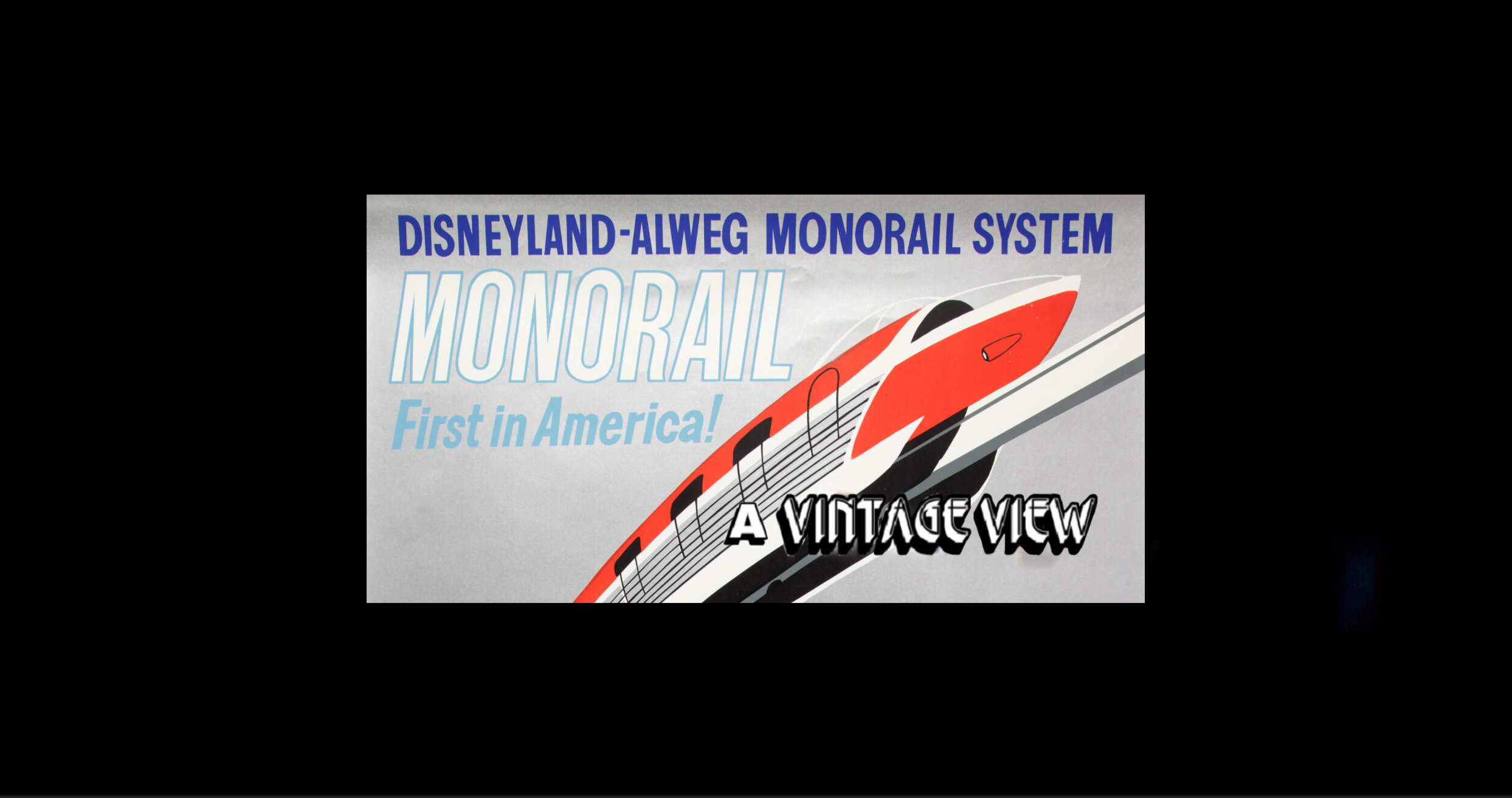MONORAIL (DISNEYLAND-ALWEG MONORAIL)

(June 14, 1959 - 1961)
“The elevated concrete beamway you see is a portion of the Disneyland-Alweg Monorail System which will be part of our tour a little later.”
-Guided Tour Script, 1962.
One can easily slip into the jargon of “ride,” but at Disneyland there are attractions. Behind every attraction is a story. Every attraction is a living experience for the guest. Disneyland ride-through attractions or adventures have officially been defined as an “individual show, ride, or exhibit designed to produce an entertaining Guest experience. Disney attractions stir the imagination, enliven the senses, and provide the participants with positive, innovative entertainment, which is the essence of the DISNEYLAND Show.” It is important to review the story of the attraction, tell the story, explain it, and create interest. This is the story of the Monorail.
“What Is a Monorail?”
The term “Monorail” defines a one track railway. In general, two distinctly different types of monorail have been built - the suspended type and the supported type.
“Early Monorail Systems”
It has been said that “the past is prologue.” It’s a fact that Monorails (with trains utilizing various methods of propulsion) had been in existence long before the conception of Disneyland, before the airplane, and even before the automobile.
The earliest Monorails (the first two) were installed in a London Naval yard in 1821, used to haul both food and bricks. Both systems relied on actual horse power for locomotion. In 1877, another monorail system linked the towns of Bradford and Gilmore in Pennsylvania. On this system ran a steam-powered locomotive transporting oil and goods, and eventually passengers. Some time later (in 1892), the first commercial Monorail linked the City of Brooklyn with Coney Island, with an electric car running atop a single rail. It was short lived, deemed a financial failure and was abandoned. The world over, “thirteen operational Monorail installations were made, of which only two were successful. The first operated in Ireland for 25 years, and was abandoned due to highway competition in 1924,” according to “Electrical Control Equipment for Disneyland Monorail Trains,” submitted January 29th through 3rd, 1961. Soon other parts of the world were benefiting from the innovation of the monorail system.
Germany’s Schwebebahn system operating at Wupperthal since 1901, was considered antiquated by 1961 due to its low speed, having the transported over one billion passengers over 59 years, with a near perfect safety record. It was this system that Walt and Lillian visited and according to “Walt Disney’s Railroad Story” by Michael Broggie: “Suspended from an overhead track, it ran smoothly on electric power. Lilly, however didn’t care for the way the monorail's cars swayed back and forth as they negotiated curves.” By 1952, a new modern system by the ALWEG corporation was being tested in Cologne, Germany. The ALWEG system was distinct in that it would straddle the beamway rather than suspend from an overhead rail (stabilized by overhead and horizontal wheels). This particular train will factor into our story in a moment.

Herbert Ryman’s c.1954-1955 suspended Monorail suggestion looked much like the Schwebebahn system operating at Wupperthal, Germany.
“The Tomorrowland Monorail”
Obviously, the fastest way to move people over the extended areas of Disneyland is with moving vehicles. A monorail would be among Walt’s plans for Disneyland from the very beginning. I am reminded of the following comment made within the pages of “Walt Disney Disneyland,” page 42, (printed by Officine Grafiche Arnoldo Mondadori - Verona; first published 1964): “To build a monorail simply as a ride is one thing; to build it in Tomorrowland as a preview of future transportation is quite another.” According to Walt’s own words published in Walt Disney Magazine (Vol. 4 ; No. 4), “A Monorail Train was one of my first dreams when I began to think about building Disneyland. It seemed to me this exciting concept of transportation would provide, in Tomorrowland, a dramatic preview of things of the future.” And so, suspended monorail trains (similar to those operating in Wuppertal, Germany since 1901) appeared in the c. 1953 - 1954 conceptual artwork of WED Enterprises, Inc. artists like Bruce Bushman, Herbert Ryman, Dale Hennesy, and Sam McKim. By October 21, 1953, one of Marvin Davis’ proposed site plans of “The World of Tomorrow” included a 10 mile-per-hour monorail ride offering a 2-minute tour of the land. Even the earliest licensed Disneyland merchandise would occasionally depict a suspended Monorail train. But despite all this planning, when Disneyland opened in July of 1955, Tomorrowland opened without without a Monorail.
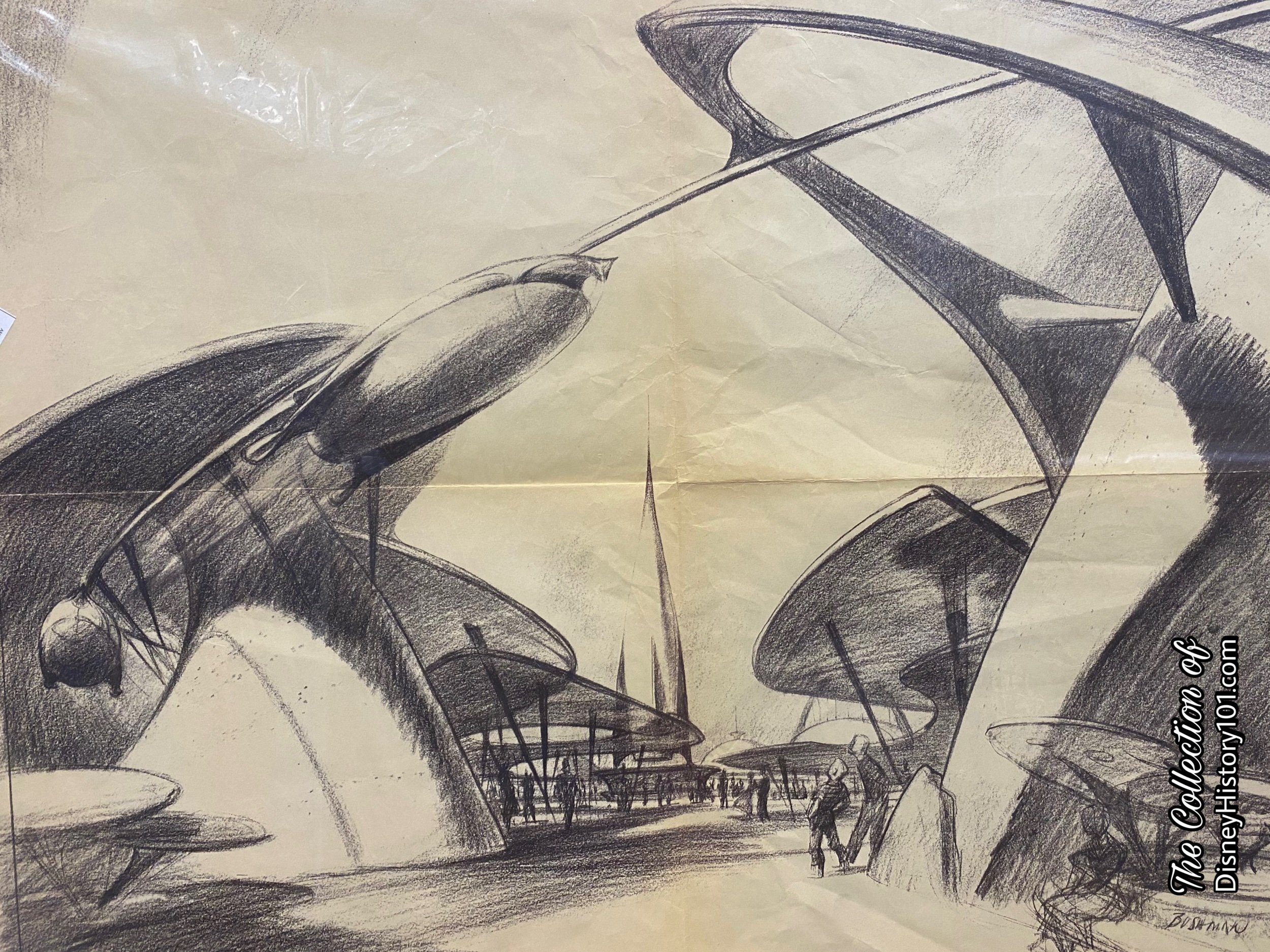
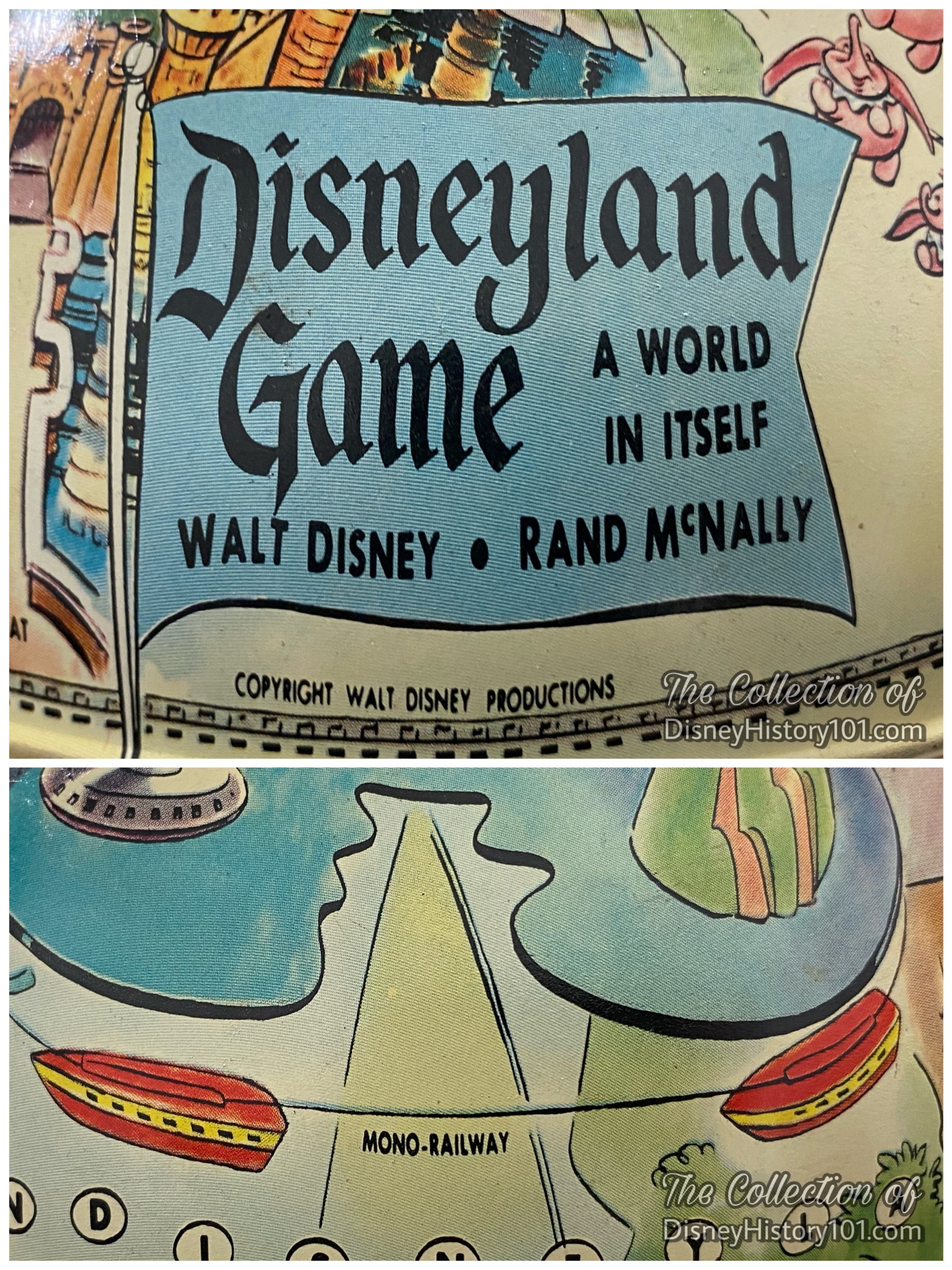
The Mono-Railway appeared on the Disneyland Game by Rand McNally.
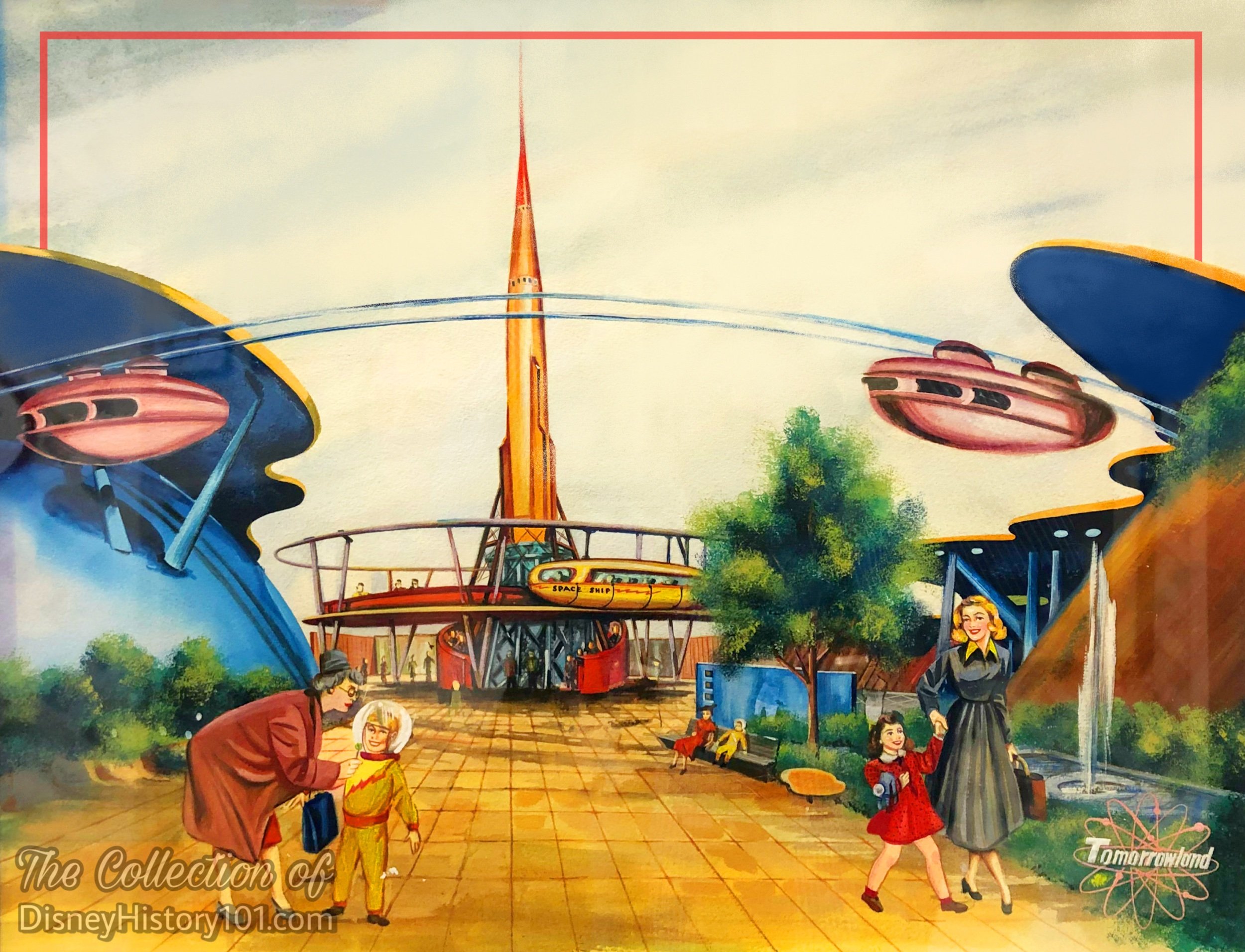
This c.1955 Jaymar Tomorrowland Puzzle Artwork features a suspended Monorail similar to those that appeared in some of Herb Ryman's c.1954 “Entrance Land of Tomorrow” suggestions.
“Research & Development”
Although Walt Disney’s staff subsequently extensively researched the idea (investigating several prospective designs), developmental planning remained practically silent as a Monorail train for four more years, until Walt Disney’s engineering staff took a trip to Europe and plans would move forward again. Yes, while visiting Europe during the summer of 1957, both Roger Broggie and Joe Fowler investigated the aforementioned Alweg Company’s mile-long Monorail train system (which had been operating on a mile-long, ungraded, prototype steel-reinforced concrete track since 1952) near Cologne, Germany. It was an advanced design of high speed type of transportation, “that appeared to offer the best prospect for economy, stability and all-around practicability, not only for Disneyland, but for municipal transportation in general,” according to the author of “Walt Disney Disneyland,” page 46 [printed by Officine Grafiche Arnoldo Mondadori - Verona; first published 1964.] “After thorough investigation, the engineers recommended this style monorail to Walt because it offered the best prospects for economy, stability, and all-around practicality, not only for Disneyland, but for municipal transportation systems in general.”
Walt was soon introduced to the ALWEG Corporation’s monorail during 1958, and his employees speedily set off to design and construct the Disneyland ALWEG Monorail. Artists like set designer Wilson “Bill” Martin (who had left 20th Century Fox, to work on Walt Disney Productions’ Disneyland project) was somewhat influential in the design of Monorail, his talents as art director applied to the attraction. Still, Bob Gurr would produce just one drawing (based on Buck Roger’s ship from the 1939 serial) which would influence the space-age look of the first fleet of ALWEG-Disneyland Monorail!
Soon, the short-lived Viewliner tracks were removed, for the installation of the Monorail path through Tomorrowland. Brochures prepared for potential Disneyland Participants promised : “looking toward the future, Disneyland continues its never ending search for the new and unusual,” according to “Disneyland, U.S.A.,” published 1958. Walt Disney’s WED Enterprises, Inc. and the Wegematic Corporation (Alweg, founded by Dr. Axel L. WEnner-Gren) would join forces during the summer of 1958, to swiftly bring something both “new and unusual” to Disneyland - an Alweg monorail system and soon-to-be first American “passenger-carrying monorail operating on a daily basis!”

The most iconic of the Tomorrowland Transportation Vehicles was rooted in designs from an earlier attraction. This acrylic and pen concept for Disneyland’s Monorail looks more like Disneyland’s shortest-lived attraction - The Viewliner Train of Tomorrow! That miniature electric “Aerotrain” would temporarily weave over the waterways of Tomorrowland. Perhaps that is why Appraisers representing Bank of America described the attraction to include a tour of both Fantasyland and Tomorrowland.
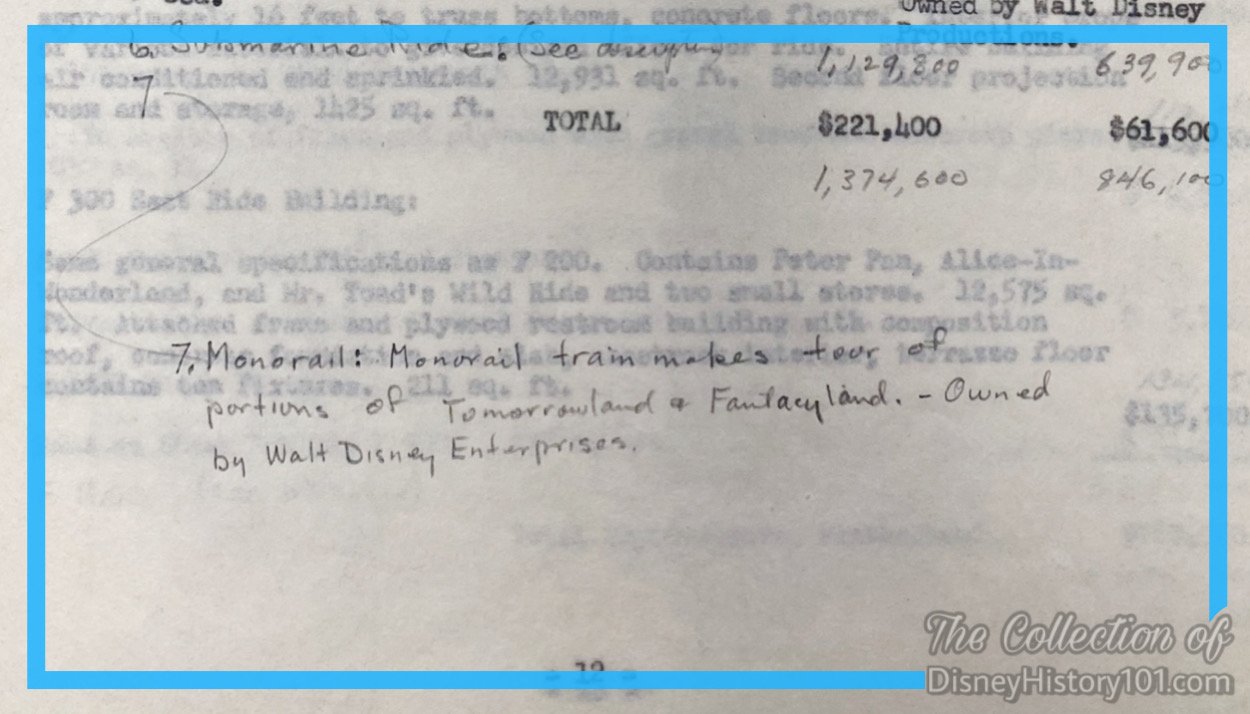
A hand-written note makes mention of the potential route of the Disneyland Monorail trains.
The track concept (pictured below, with rails over the Motor Boat Lagoon) would no doubt influence one of the most iconic of the Tomorrowland Transportation Vehicles - the Monorail “train of the future!”
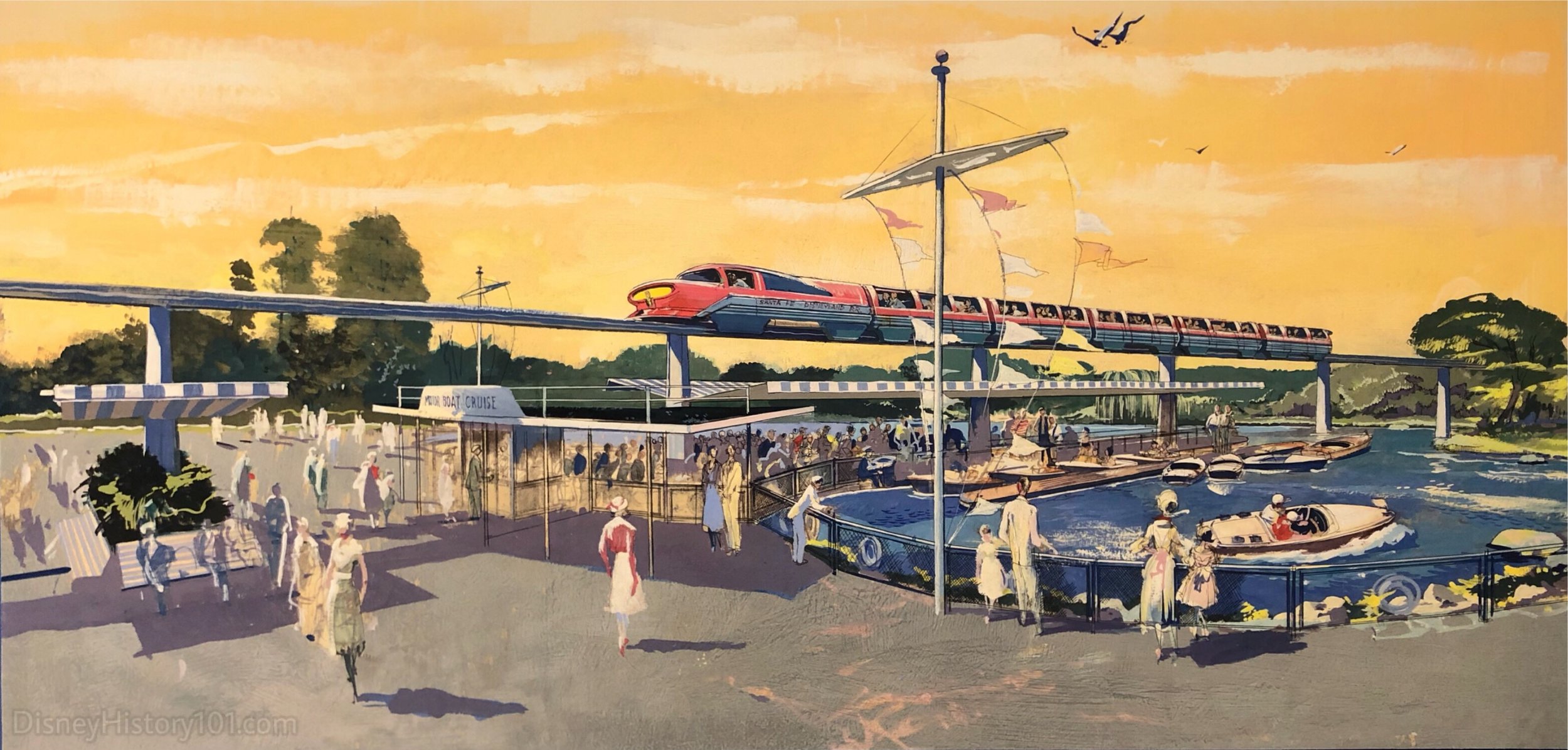
Herb Ryman's "Monorail" (or "Elevated Viewliner"), originally suggested in acrylic and pen, c. 1958 ; From the collection of Walt Disney Imagineering
“ALWEG (AL wheg)”
“Disneyland and Alweg (named after its originator, Dr. Axel L. WEnner-Gren) joined together in the summer of 1958 to develop the basic system into a working prototype for operational use at Disneyland. As a result, the monorail at Disneyland is an Alweg system.“
By that time, the aforementioned appraisers from Bank of America made note of the Monorail Trains, owned by Walt Disney Enterprises. The trains were being designed by both WED Enterprises, Inc. and the Wegematic Corporation (Alweg). Disneyland’s two sleek, three-car, 82-passenger Monorail Mark I trains were initially and specifically designed by Bob Gurr and both master planned and built by numerous engineers of WED Enterprises, Inc. The Westinghouse Electric Company manufactured the standard power and drive equipment utilized in other rapid transit operations.
While the train concept designs were being developed at WED Enterprises, Inc., what has been described as an “internal conflict” had arisen. Roger Broggie’s account of this has been preserved in “Walt Disney’s Railroad Story” by Michael Broggie: “‘It was between engineering people who wanted [the monorail's tracks] to go in a straight line forever with no grades, and the art directors who wanted to draw tight turning radii and plot an interesting ride that climbed maximum grades in order to thrill the guests,’ he recalled. So, Roger worked out a delicate balance between the factions; the end result was weighted more in the direction of the ‘show’ layout. After all, this appealed more to Walt--who reserved final approval over all elements of the Park.”
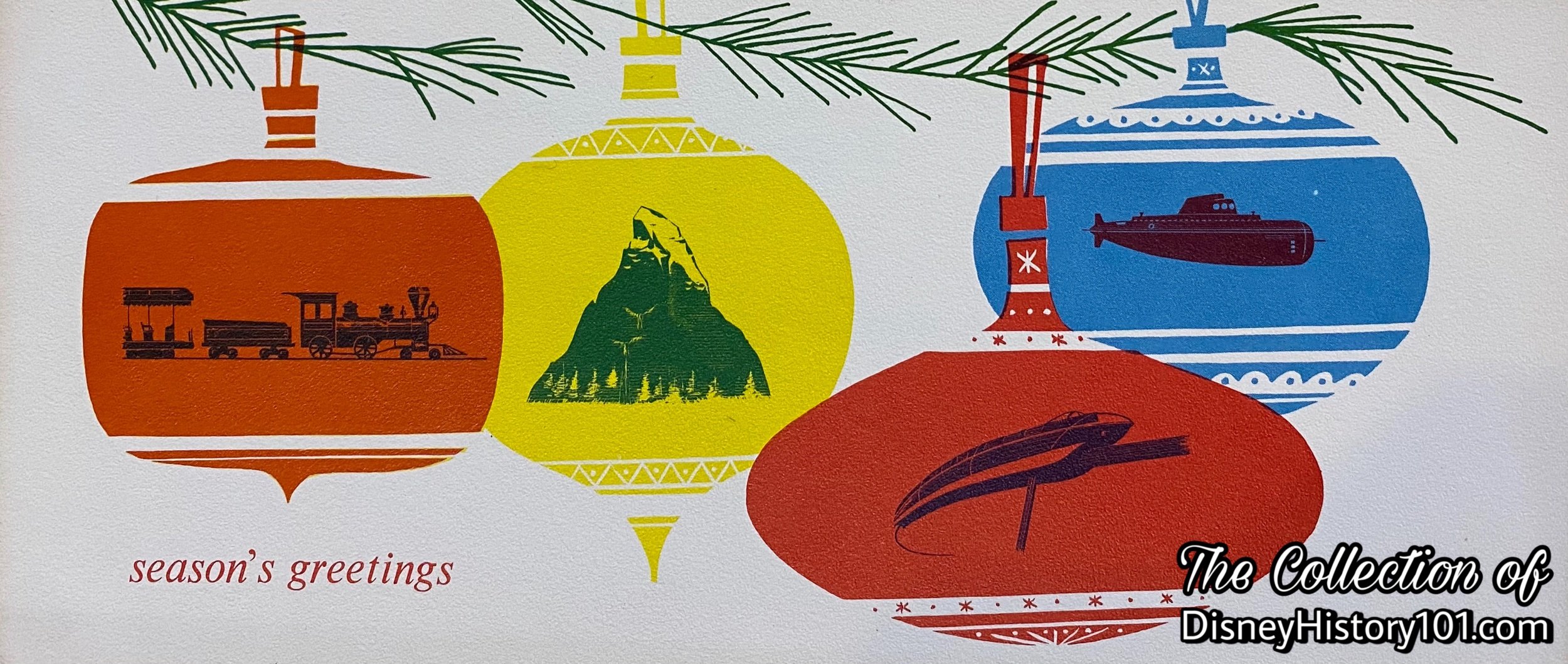
A WED Enterprises, Inc. Winter 1958 Greeting Card.
It was now October/November of 1958 and Walt wanted the Monorail ready and operational by the summer of 1959. This meant that there was less than a year to finish the project. According to “Walt Disney’s Railroad Story” by Michael Broggie (page 297): “In late November, Roger and WED designer Bob Gurr flew back to Cologne, where they met with Alweg's engineers. Roger proposed that Alweg build the trains in Cologne in late November, for they needed to be running at Disneyland by the following July. The representatives said this time frame was impossible; they could build the cars in Cologne, but by the time they were shipped from Germany to Los Angeles (by way of the Panama Canal), they'd never make the schedule. Roger then suggested that the Alweg representatives visit Disneyland. He later recalled, ‘During their visit they saw the Viewliner trainsets that we had built and said, ‘If you can do that type of work then you can also build monorail cars in California.’’ Alweg agreed to provide prints and consultants; the company also agreed to send advisors to show Joe Fowler's construction crew how to build and assemble the concrete beamway.” Heading toward the new year, some 1958 winter season holiday cards (manufactured around WED Enterprises, Inc.; pictured above) carried the theme of the forthcoming Disneyland adventures due to ornament Tomorrowland in 1959. By that time, according to the Disneylander, “Walt Disney personally directed the engineering talents Bill Martin, WED, Disneyland Engineering Dept., Roger Broggie, WDP, and Ernst Schroeder, Ernst Wendt and Eberhard Lemcke, of the Alweg Company, Cologne, West Germany.”
By December 5, 1958, appraisers reported on the city real estate of Disneyland related to a loan requested from Bank of America to fund the Monorail and other attractions. The appraisers found that “at present an eight acre area in Tomorrowland and Fantasyland is being completely revamped at an reported expenditure of approximately $3,700,000 exclusive of a monorail to be installed by Walt Disney Enterprises costing $750,000. To date the project is roughly 10% completed, and their value has not been included in this appraisal.”
Each of the three-car steel and aluminum trains were to be driven by two 50 horsepower direct current traction electric motors. These motors would believed to have a capacity of sufficient energy to operate a four-car train. These Monorail power units were owing to the contributions of Dave Gengenbach (previously of Tubular Aircraft Products), who would join the Disney organization in 1959, and ultimately become general manager at MAPO. Owing to this, it could be said that the specifications for the propulsion equipment were proposed by WED Enterprises, Inc.
“Monorail Train Construction”
Before long, Monorail train construction commenced on Walt Disney Studios Stage 3, where Babes in Toyland was in production.
According to “Electrical Control Equipment for Disneyland Monorail Trains” document (prepared by J.J. Stamm & L. Adams): “To reduce installation and maintenance costs, every attempt was made to keep the control simple. To eliminate the need for transition switching, starting with motors in parallel was used. Likewise, by using a control resistor with center tap the need for a battery was eliminated.” With the exception of the drive motors, the necessary equipment was distributed (mounted under the Monorail “skirt”) on the cars. This contributed toward weight balance of the Monorail trains.
The two “lightweight aluminum, plastic and stainless steel” trains had “door and access panels… fastened with Dodge trunk lid latches.” Each car had three partially enclosed passenger compartments with doors on one side. As a safety feature, these “door interlocks” were electrically operated, remaining locked while the train was in motion and only capable of opening once the train had stopped at the Monorail Station and the “propulsion power control switch” was maneuvered into the “off” position. The doors (operated by a solenoids powered by just one “contactor”) could be opened from the outside as in the case of power failure.
These trains and passenger compartments were supported by four bogies saddling the beams (each bogie holding four 32” rubber tired wheels on top of the beam, and eight 21.5” spring-loaded guide wheels running on the side). The trains weighed between 27,235 Lbs. (when empty) and 39,945 (when loaded), necessitating the 30” rubber tire wheels to operate at 100 psi of pressure, with the spring loads of pressure set at 100 lbs. Along the less-than .8 mile (or, 3,844 foot-long) track, pylons of the concrete-beam system reached heights of 34 feet along the route. Making the grades and curves at the maximum speed of 16mph (except for the 10mph speed limit around the Matterhorn), was accomplished with the help of 300-volt Westinghouse subway motors. The “Electrical Control Equipment for Disneyland Monorail Trains” document (prepared by J.J. Stamm & L. Adams) describes the traction motors as “2 type 1432-H” and “later changed to 4” (type 1432-H).
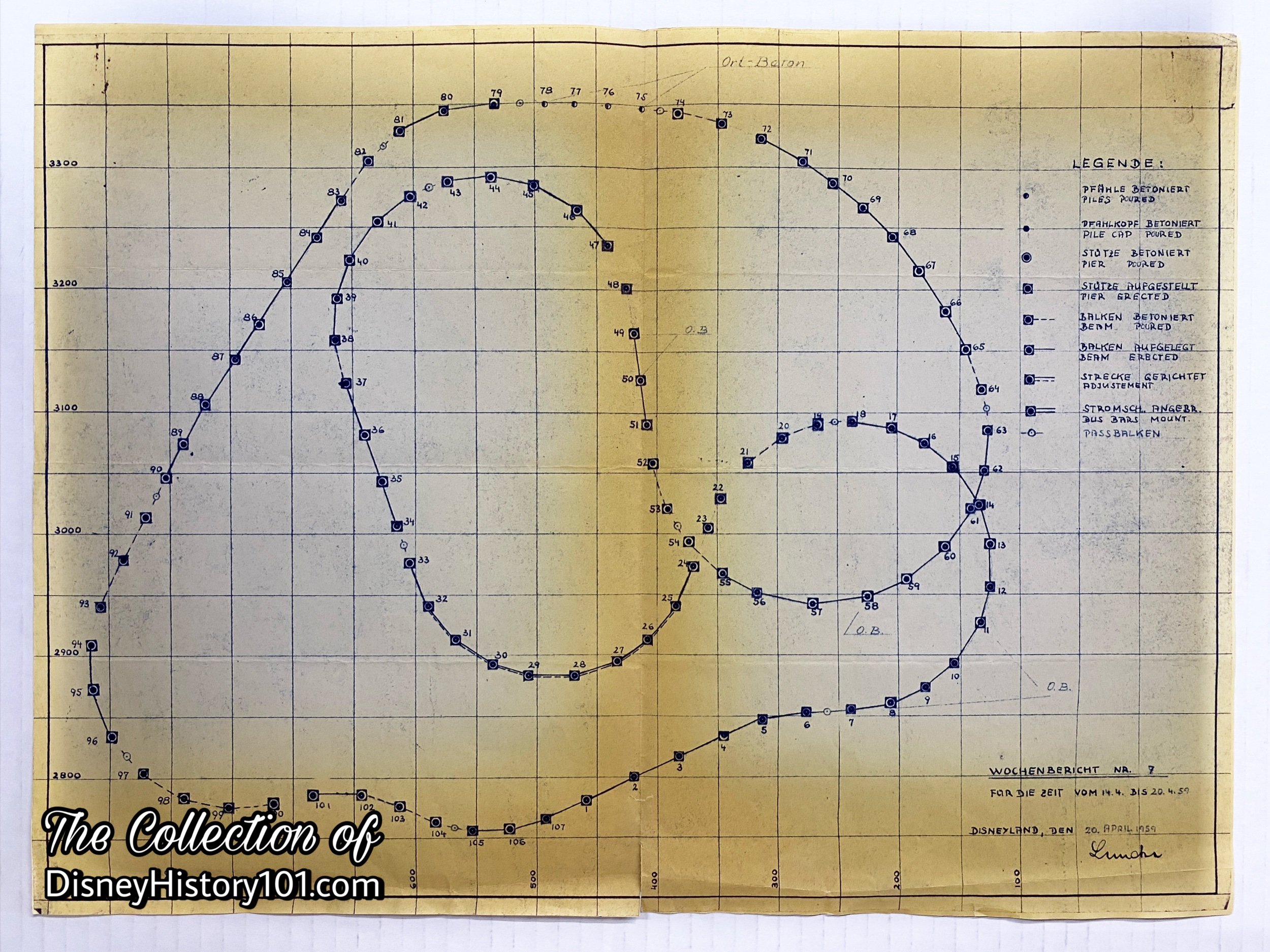
Both erected and poured Monorail Piles, Pile Caps, Piers, Beams, Bus Bar Mounts and distance adjustments detailed, April 20, 1959; received by Disneyland Construction Department, April 21, 1959.
Eventually, the original Monorail Beamway was comprised of 104 concrete beams and 104 concrete columns placed at maximum spans of 40 feet from each other. The track would be designed with minimum curvatures of a 120 foot radius, overpasses, and grades of 7%, “to demonstrate the practicality of this system under different construction and topographic conditions,” according to a ASME brochure published in 1986.
As this was October of 1958, Roger Broggie and Joe Fowler had less than a year to produce the Monorail train and Beamway (the elevated Pre-cast I-Section girders which served as track, carrying beam and guide rail).
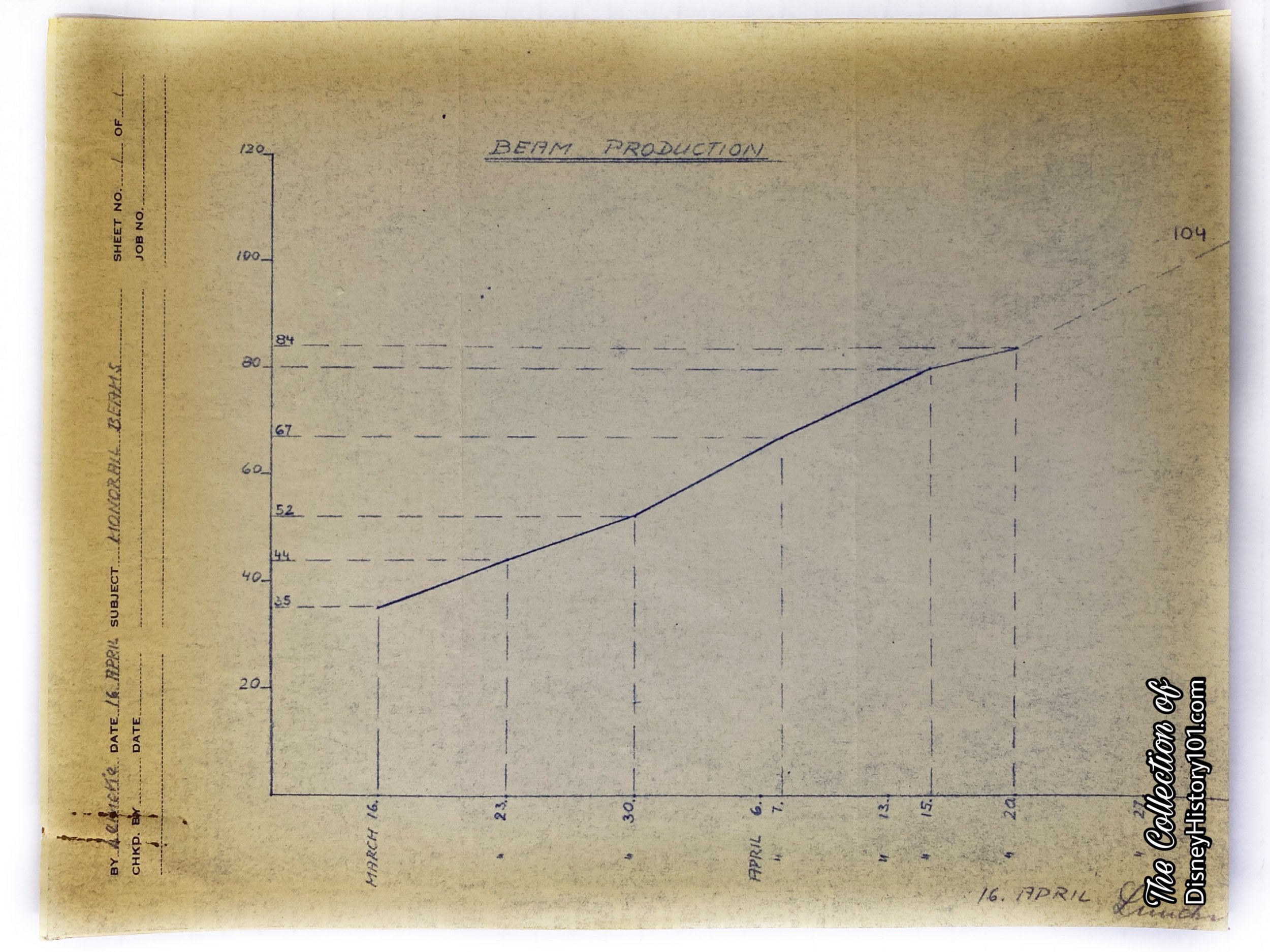
Monorail Beam Production, March 16- April 16, 1959; received by the Disneyland Construction Department April 21, 1959.
Much was involved in the design, fabrication, curing, and testing of beams and piers. A special concrete mixture was created and tested to withstand torsional stresses. According to “Walt Disney’s Railroad Story” by Michael Broggie (page 301): “The concrete mix design resulted in concrete of exceptionally good quality. Twenty-eight day compression tests indicated minimum strengths of more than 5,000 lbs. per square inch. The use of 1/2 of 1 percent of calcium chloride in conjunction with steam to cure the beams and piers made it possible to remove them from the forms 24 hours after casting. At that time, control tests indicated minimum compressive strengths of 3,000 lbs. per square inch.
Structural analysis of the beamway design was verified by means of a full scale test conducted on a curved beam 35 feet in length. Static loads were applied simulating the maximum load conditions for movement and shear. The results verified the basic assumptions and indicated a factor of safety of approximately 3-1/2.”
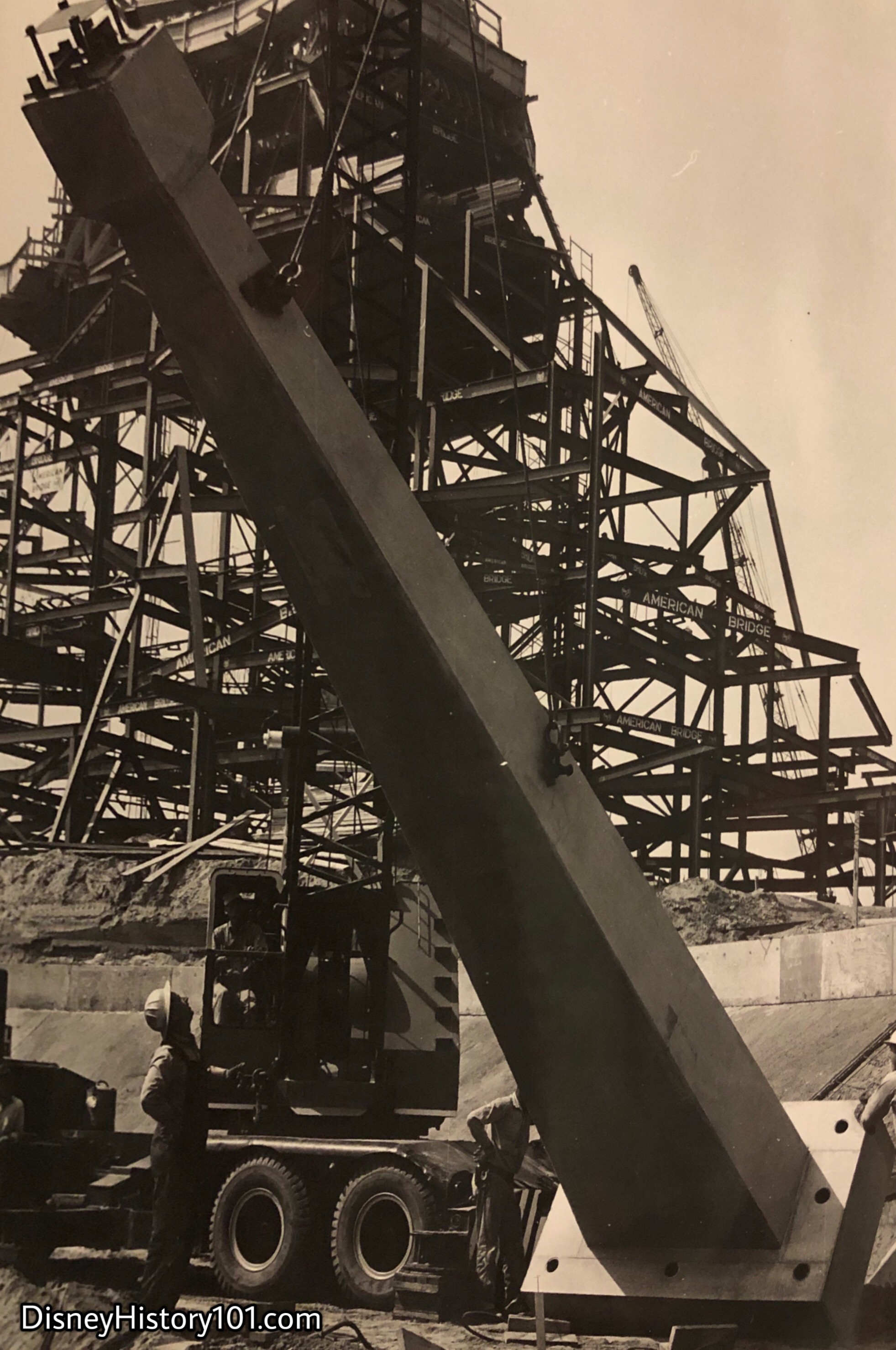
Monorail Pier Placement.
During 1959, Disneyland guests were invited to observe “the Greatest Construction Show on Earth”! The earth moving machines of the JAMES L. BARNES Construction Company had completed the digging, moving and shaping of the new lake bed. You’re looking at a historic photograph - the raising one of the first precast concrete Pylons (or Piers) in a series to run through the future site of the Submarine Lagoon.
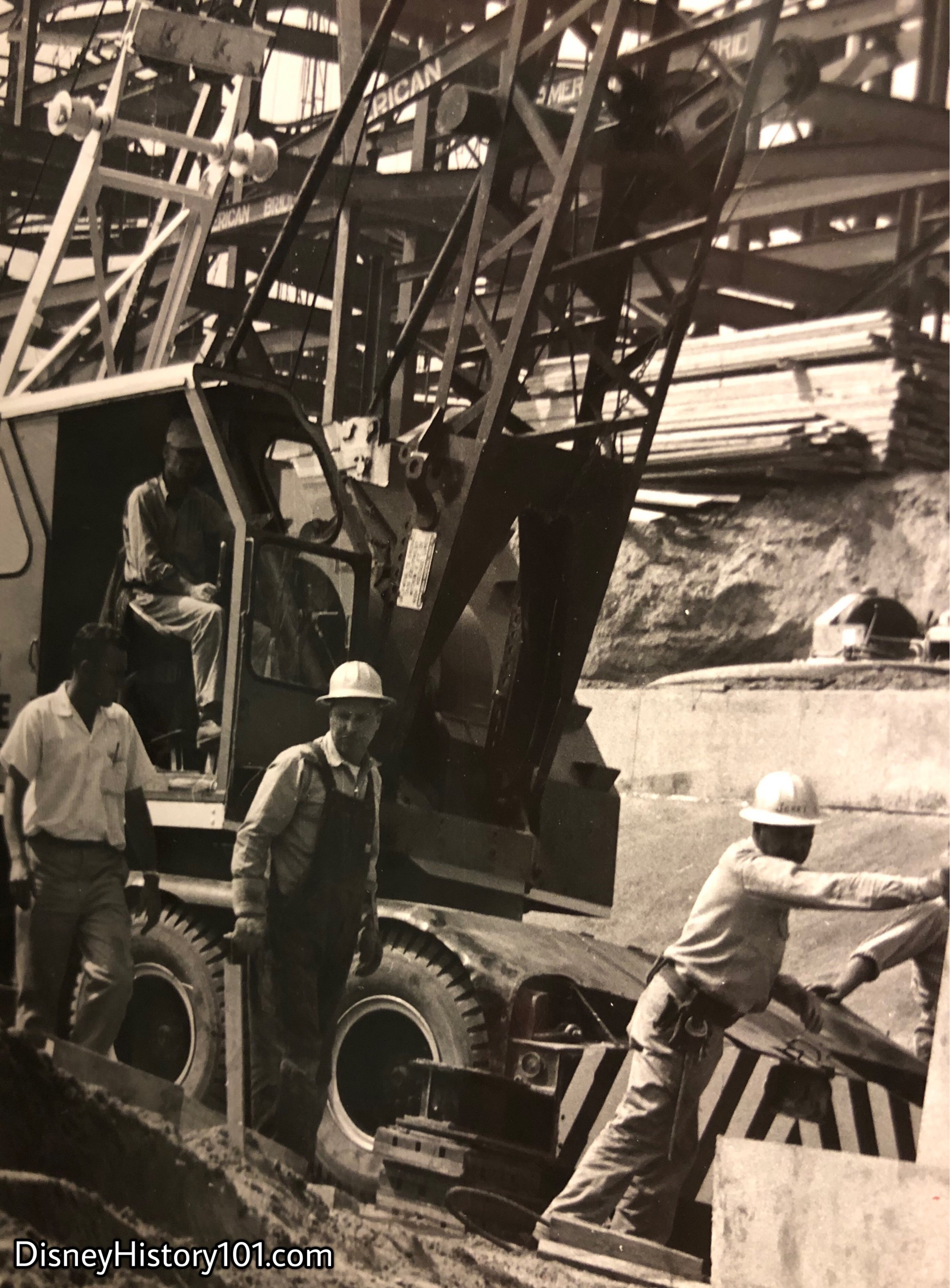
Monorail Pier placement crew.
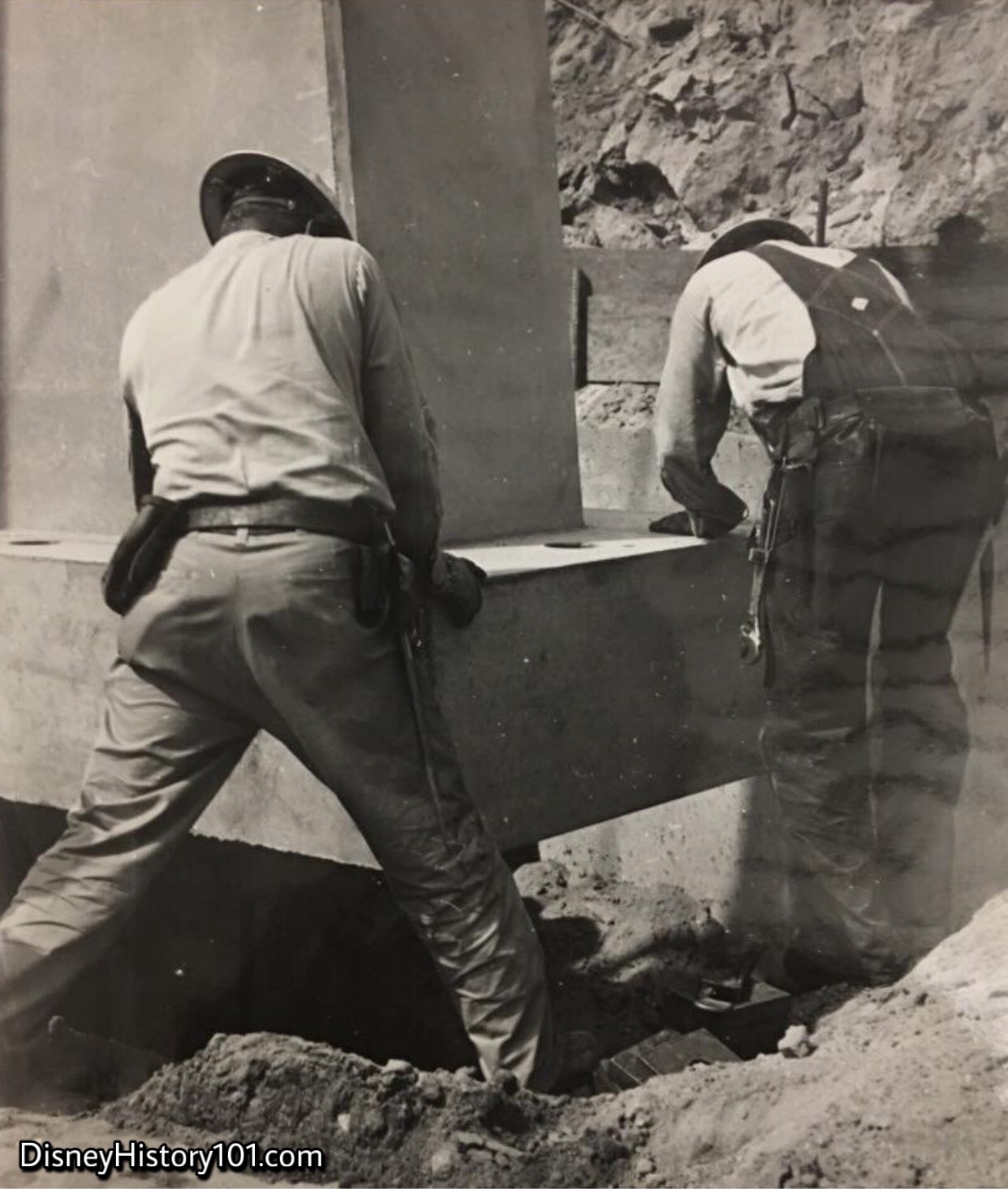
Monorail Pier Placement.
The first Monorail support for the elevated concrete highway in the sky, is meticulously placed in the ground! Piles (giant prints underneath) would be placed precisely into the ground to anchor the pier.
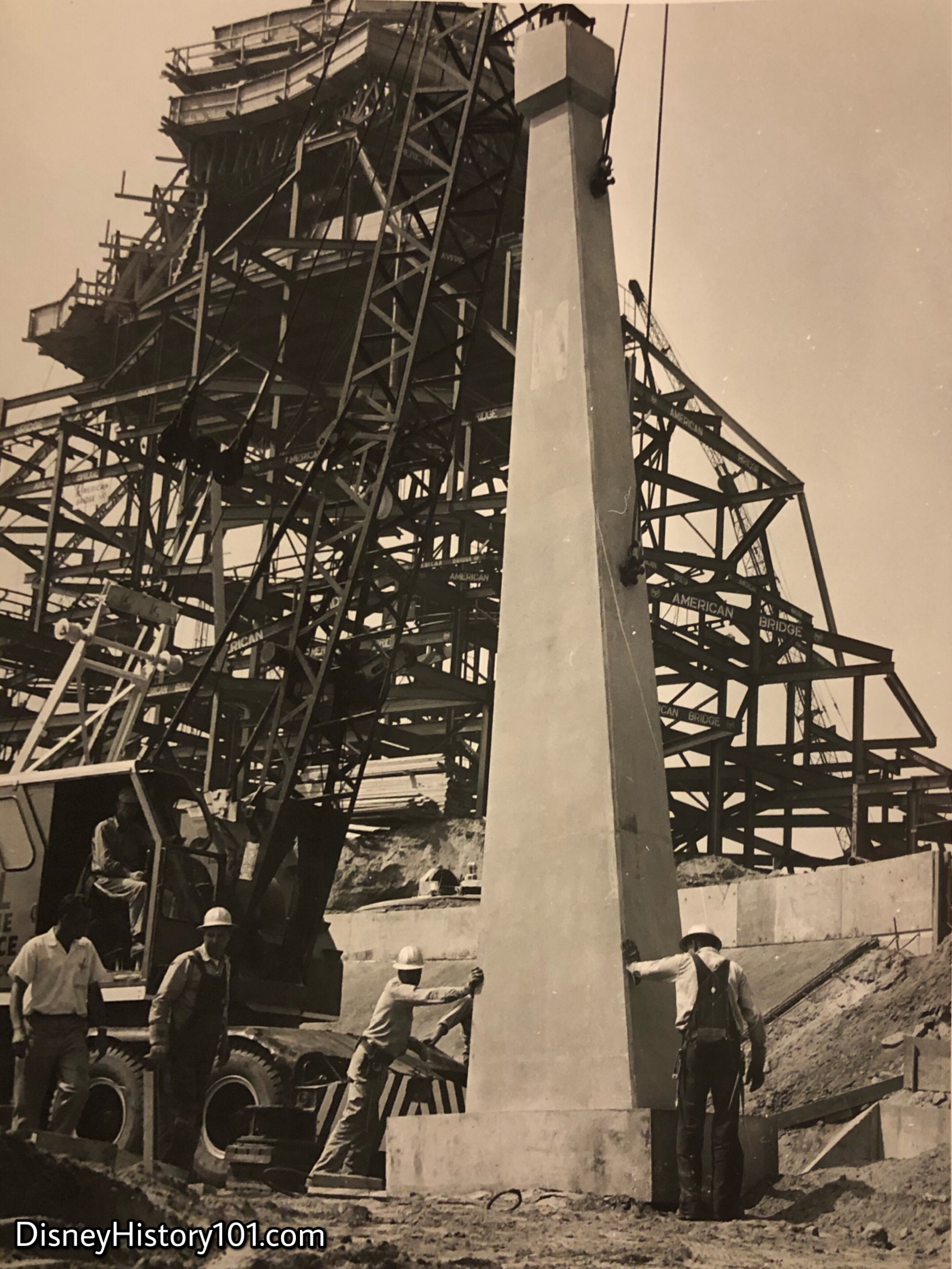
Monorail Pier Placement.
The reinforced concrete Pier (or Pylon) was placed in its exact location, and then stood upright. Once upright, the Pylons range from 14 feet to 30 feet tall.

Monorail Pier Placement.
After being carefully positioned atop large anchor bolts, the Piers were secured with anchor bolts. The pile cap (with piles) had been tucked away underground. The anchor bolt sleeves were filled with grout and leveling bolts and nuts (seen at the corners) were then placed on the anchor bolts. An expanding grout was placed in the space under the pier base. All of this would contribute to the absorption of both vertical and torsional forces put upon the piers.
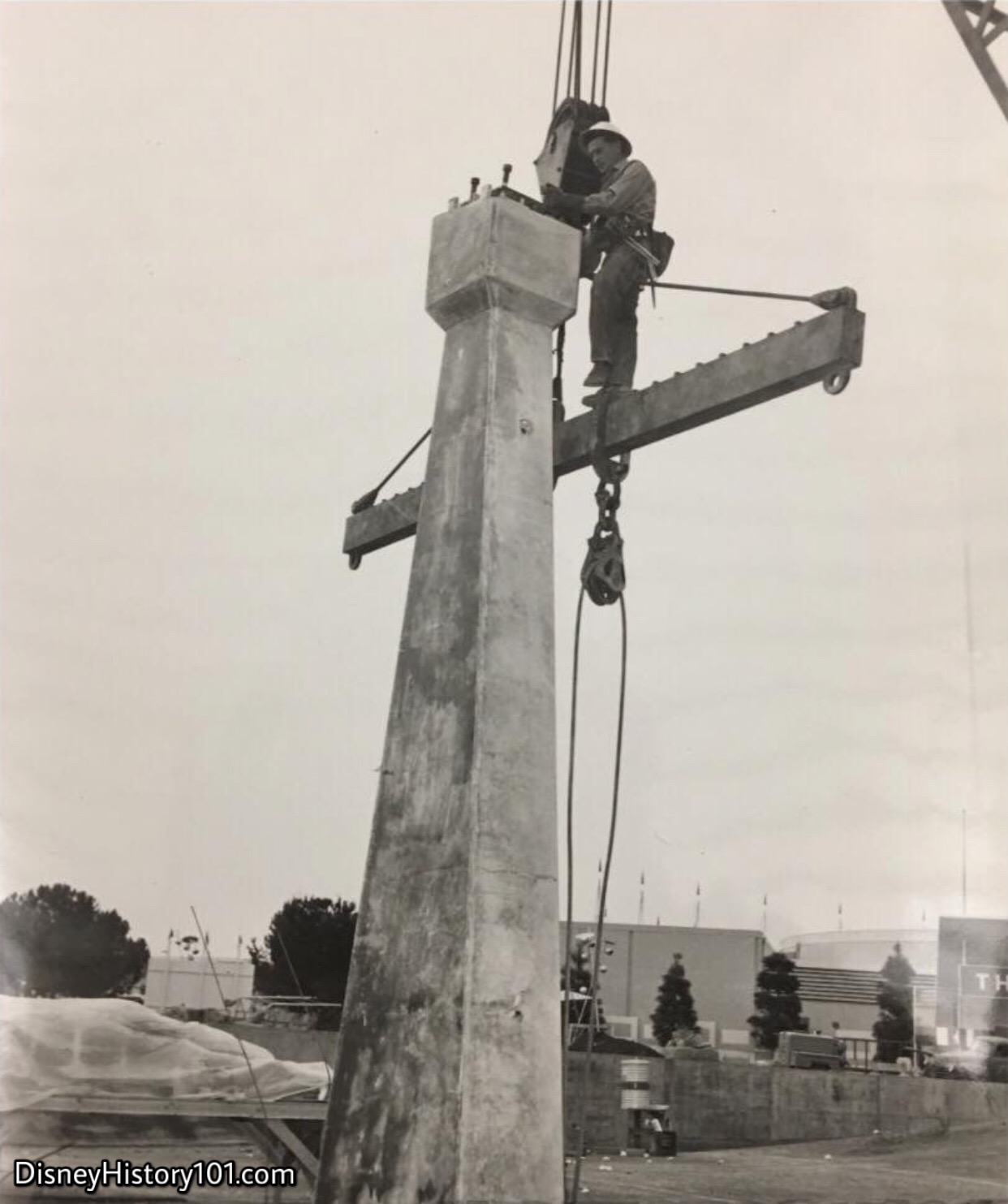
Monorail Pier Expansion Bearings and Fixed Bearings are placed.
The upright pylons will reach a height of 35 feet off the ground. From this height, we can see the tops of the Tomorrowland lights and a portion of the Yacht Bar. Here at the top of the pylon, much of the Monorail construction work was completed with “practically no [rigging] tools or rigging equipment,” according to Ermitt Baker (a 35-year Rigger in the Disneyland Facilities Division, who was employed at this time) to Disneyland LINE Magazine [October 28, 1994 ; Vol. 26, No. 42].

Monorail Pier Expansion Bearing and Fixed Bearing Placement.
The Astrojets, the Moonliner Rocket (with its adjacent Rocket to the Moon attraction), and plenty of star pines (common in Tomorrowland of the 1950s) can also be seen on the other side of the construction barrier.

Monorail Pier Placement, (March, 1959)
Construction soon began on the 8/10th mile-long straddle beam track. Do you see those pieces on the ground? They may look like solid concrete. In actuality, each concrete Beamway section contains precast I-section steel girders inside. Each “I” section girder beam of reinforced concrete measures 20 inches wide, 35 inches deep, with most beams measuring up to 40 feet long. These were the result of an innovation at the Walt Disney Studio, where “Disneyland engineers developed special steel forms for casting the curving, twisting concrete girders for the ‘highway in the sky’ over which the trains run.” [“Walt Disney Disneyland,” page 49, printed by Officine Grafiche Arnoldo Mondadori - Verona; first published 1964]
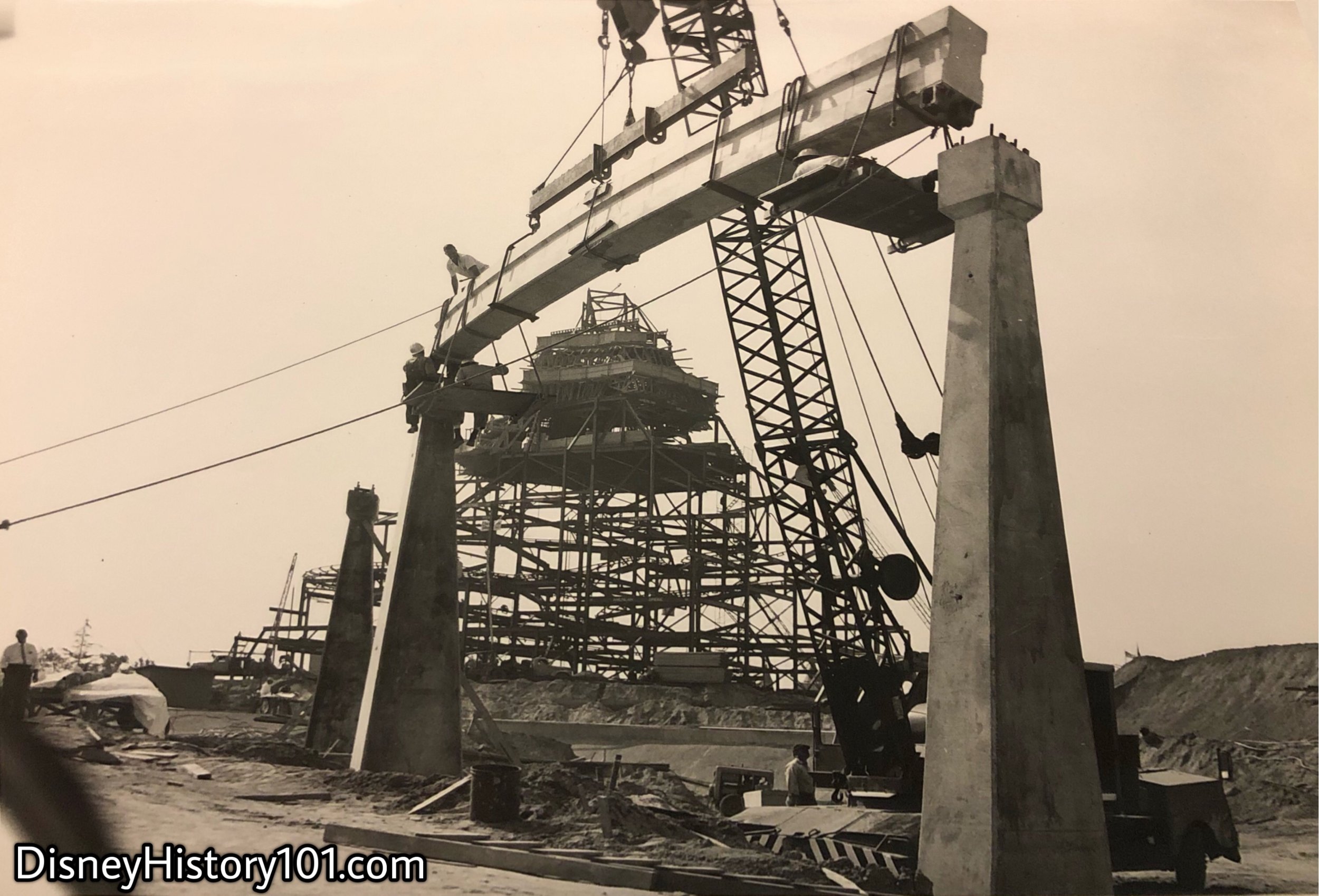
Monorail Pier Placement.
Pylons are concrete supporting posts used to hold up the beamway. Above, the first Monorail beam is set in place above two of the Pylons.

Monorail Pier Placement.
The pre-cast I-Section girders (each one ranging from 32 to 60 feet long) are raised to their positions onto the pylons. Each beam (serving the position of track, carrying beam, and guide rail) has the strength of supporting 5,000 pounds per square inch.
Stress calculations and other necessary feats of engineering were performed under the direction of John Wise & Bill Wheeler’s Wheeler & Gray Company! The Wheeler & Gray Company was previously instrumental in the construction of the Walt Disney Studio Sound Stage No. 3 (in 1952-1953), and also during Disneyland’s initial construction. After their contributions to the Monorail, they continued to be involved in many additional (and most challenging) projects for Disneyland over successive decades.

Monorail Pier Placement, (March, 1959)
There were many individuals and companies (not often mentioned) which played an instrumental role in some of Disneyland’s most-beloved attractions. In the center of the photo stands Harry Harper (of Hill Crane Service), who helped provide the crane used to hoist the beams into the air.

Monorail Pier Placement, (March, 1959)

Monorail Pier Placement, (March, 1959)

Monorail Pier Placement, (1959)
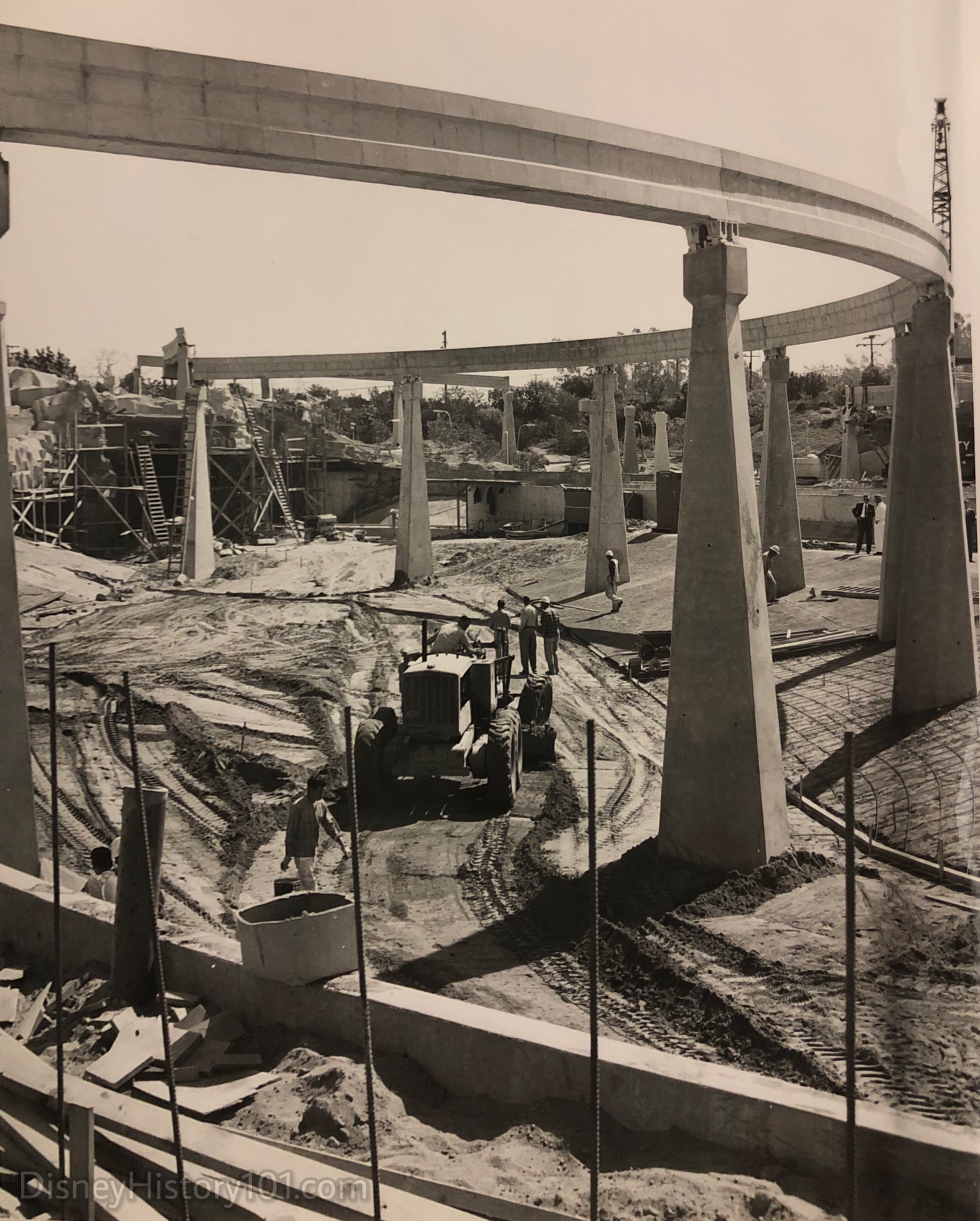
Monorail Pier Placement, (1959)
The “timeless” concrete beamway of the “Highway in the Sky” is composed of pre-cast section girders. They were cast in steel forms that can be adjusted to either produce straight beams or curving concrete girders.
Most of the beamway that you see in the Park today is the original c. 1959 beamway, though some sections have been re-routed to make way for newer attractions (i.e. the section re-routed around the installation of the Indiana Jones and the Temple of the Forbidden Eye show building, and the replacement of a small section between the Matterhorn and Tomorrowland stations).
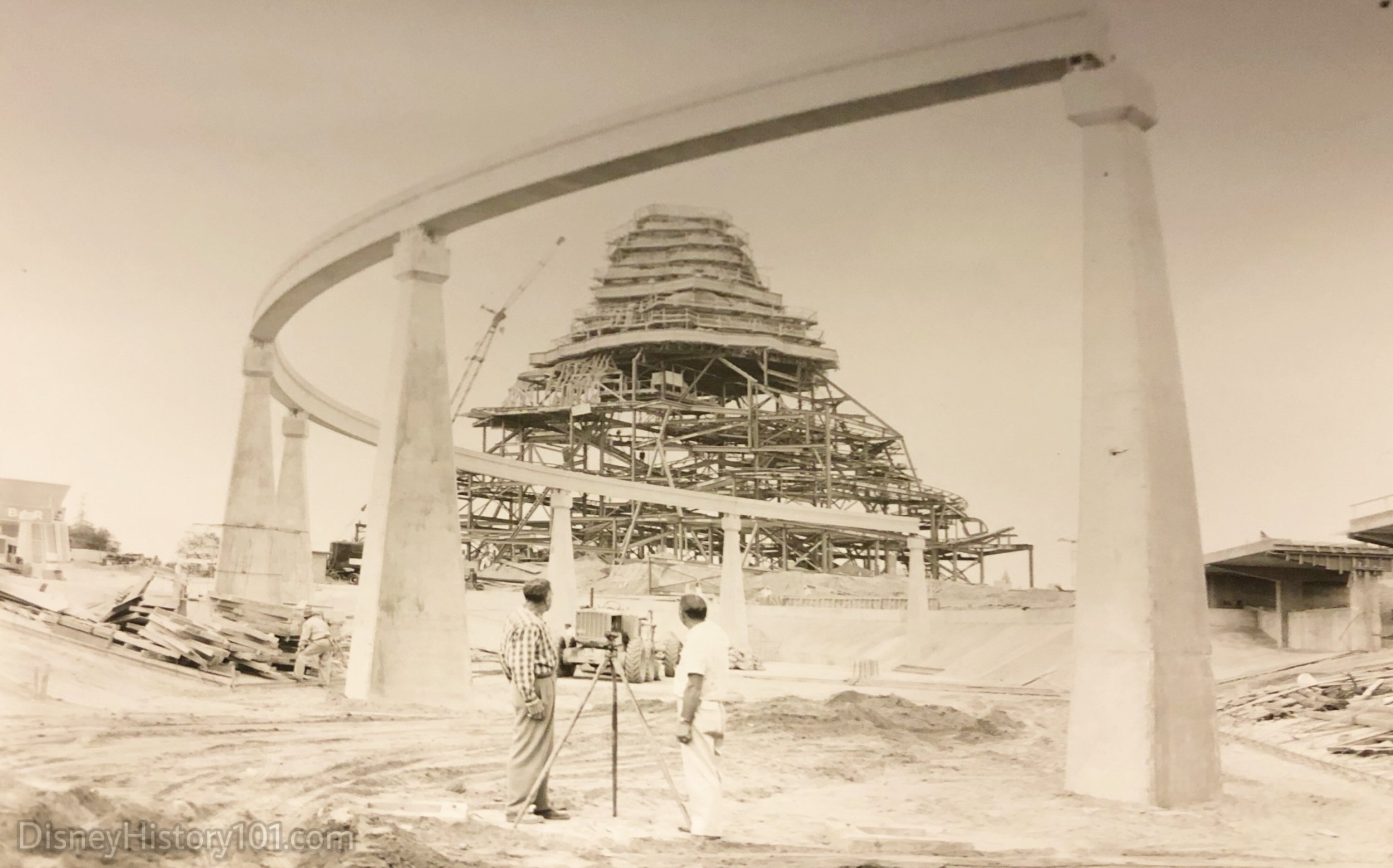
Monorail Pier Placement, (1959)
It was likely essential to complete this segment of pylons first, because the Submarine Lagoon was also under construction at this time.
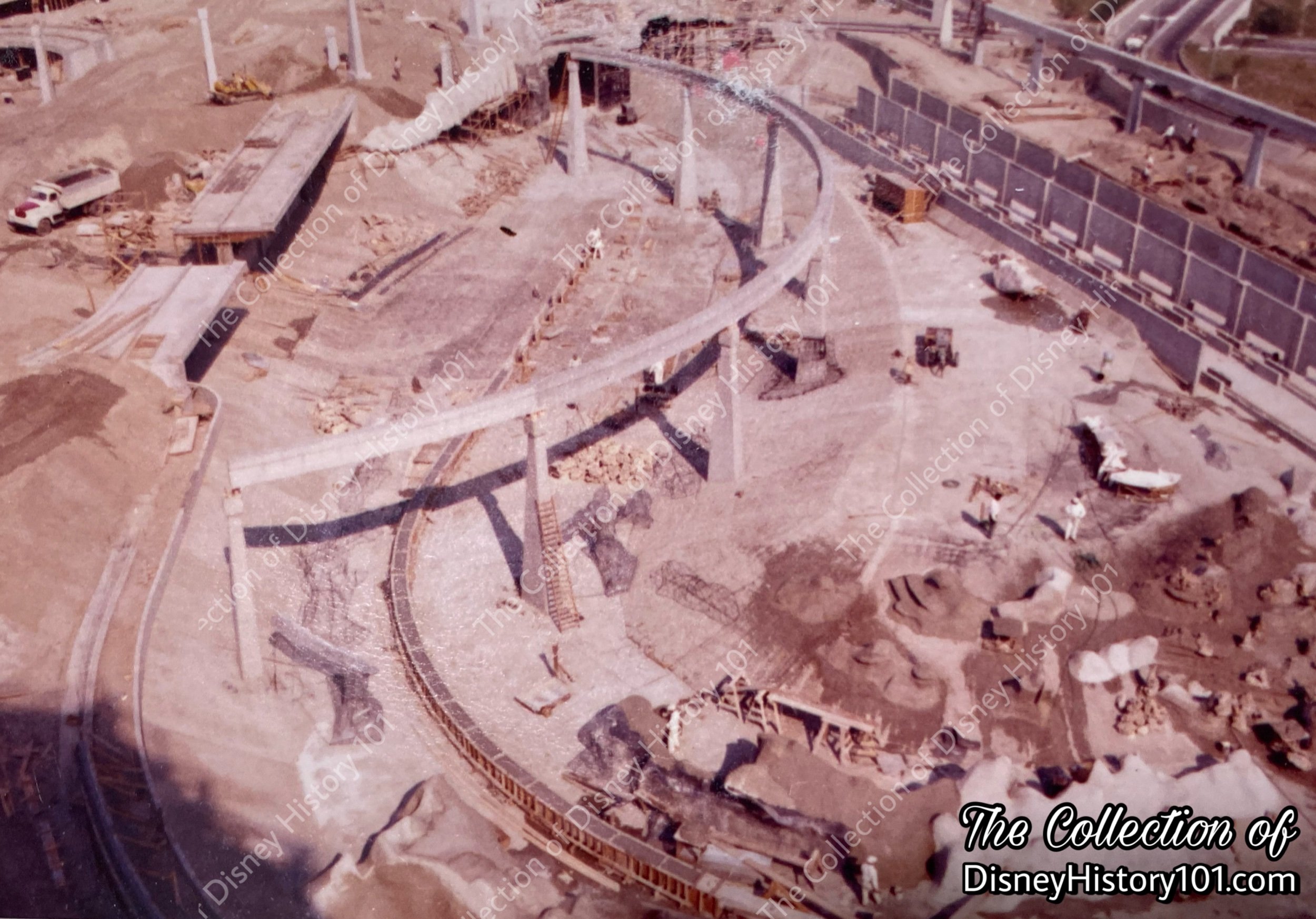
Monorail and Submarine Lagoon construction.
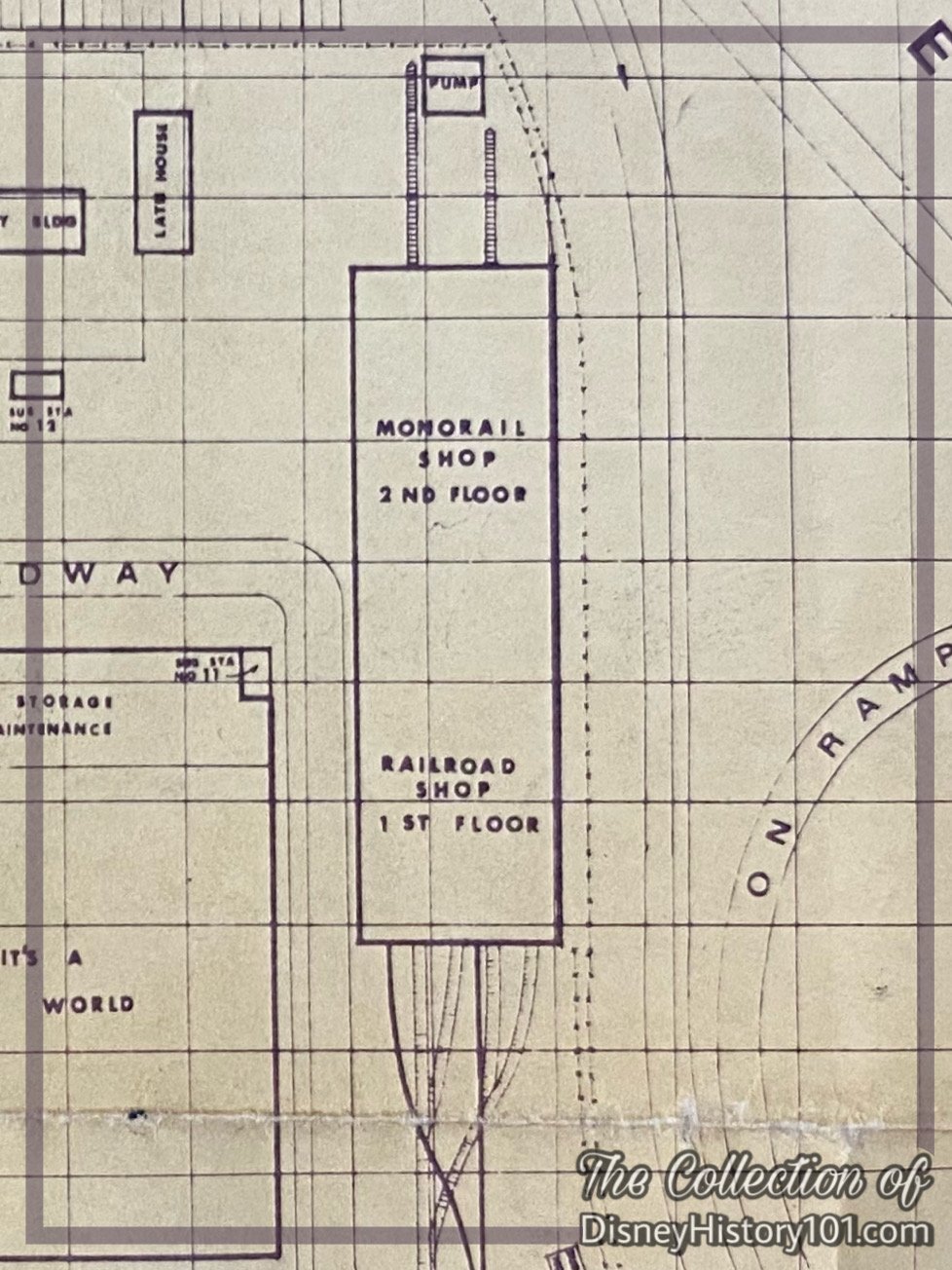
Disneyland Monorail Storage Building (or, not-so-round "Roundhouse").
“The Roundhouse”
The Monorail trains were stored in the two-story Roundhouse when not in use. The Disneyland Roundhouse was once probably the only square or oblong “Round House” in the world, and is located in the service area off West Street.
Below, a garage served the steam locomotives of the Santa Fe & Disneyland Main Line Railroad. Boilers were steamed up every morning, and after the day's run, machine shop crews would conduct their daily inspection, cleaning, lubrication, and repair of the locomotives and rolling stock. A maintenance pit provided access to the undercarriage of a train or car.
Above, the Monorail trains of the future were maintained by Retlaw Maintenance Laborers. They regularly inspected the vehicles’ pressure of 10 vertical load-carrying tires and 40 horizontal stabilizing tires. The 600 volts of DC-current fed to the four Monorail Units was also maintained by mechanics and electricians.
“RETLAW”
RETLAW operated the Disneyland train and Monorail. It was a separate organization, and a first cousin of Walt Disney Productions. The special RETLAW MAINTENANCE DEPARTMENT group would handle the maintenance for both an ultra-modern monorail and a turn-of-the century railroad train. The maintenance required special techniques and equipment. To stay ahead required new designs, new techniques, and new equipment.
Many RETLAW employees were Disneyland Cast Members who had the pleasure of supporting this element of the Backstage Disneyland show. Later, Bill Hauenstein (c.1966) was one such Disneyland Electrical Foreman, who had the pleasure of checking the Monorail beamway daily to prevent breakdowns.
Owing to Disneyland Round House operation, it was recorded that no more than 30 minutes in lost operation time on the trains since the Park opened in 1955. To maintain such an operation, Disneyland, Inc. opened Job #032-50-01 (in 1959), constructing a shed addition to the Round House in the Warehouse Service Area. The shed addition was intended for machine shop maintenance and was located along the South side of original train storage shed and to West side of original Square Roundhouse. The shed was constructed at a total cost of $3,358.62 (Disneyland Labor, $500.24; Disneyland Materials, $53.28; outside purchases, $19.27; Sub-contractor H&W Fabricating, $2,394.00; sub-contractor Guardian Fence, $283.00; with Construction OH @ 19% of $572.79).
The designs for the Monorail Roundhouse (with Monorail Shop and Railroad Shop) would influence the way that steam trains and other transportation vehicles like some 600 busses, trucks, and cars) were initially stored at Walt Disney World many years later. Today, the Monorail Roundhouse performs the same functions nestled Backstage between the Santa Ana 5 Freeway, Small World, and a Compressor Plant.

Monorail Roundhouse Construction is depicted in at least one press release photograph; ©️Walt Disney Productions.
The spur was a divergent track, having only one entry. Once the trains travelled the spur and arrived, they were lowered onto the Monorail concrete beamway by crane in front of the developing Roundhouse. The Roundhouse was a backstage building where trains were maintained when not on the main line. Trains occupy the ground floor tracks and Monorail trains are on the upper floor.
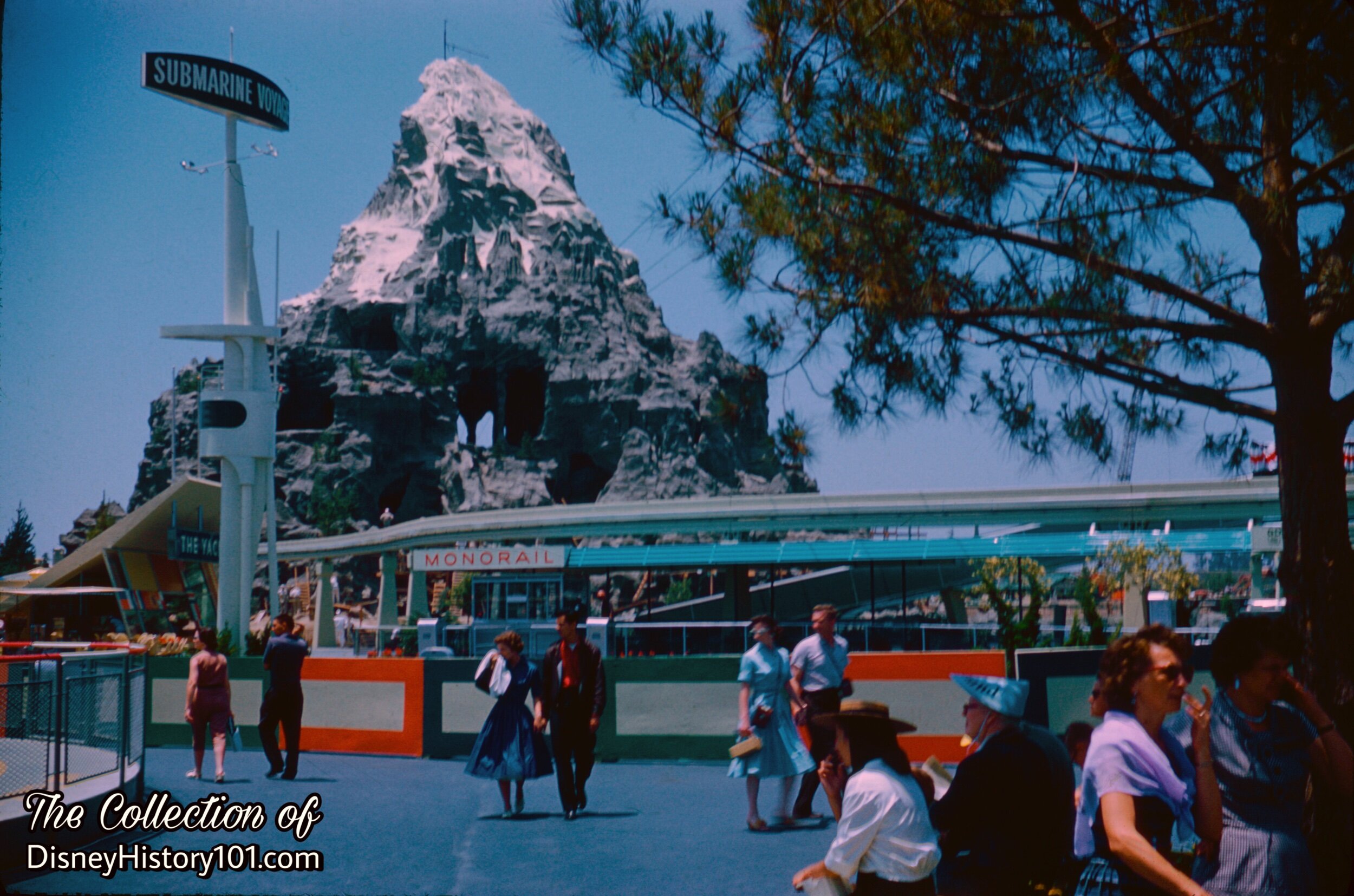
(June, 1959)
Matterhorn, Skyway, Submarine, and (most importantly) Monorail construction is nearing its end in this Vintage View from 1959. Just take a look at those crowd-control barriers and red, white, and blue bunting around the Tomorrowland Monorail Station entrance and Submarine Voyage Thru Liquid Space entrance. As to the construction time and cost, “an executive of a major transportation company was later to comment, ‘You people have built this entire system in less time, and for about the same money, that my company would allocate for a feasibility study!” [“Walt Disney Disneyland,” page 49, printed by Officine Grafiche Arnoldo Mondadori - Verona; first published 1964]
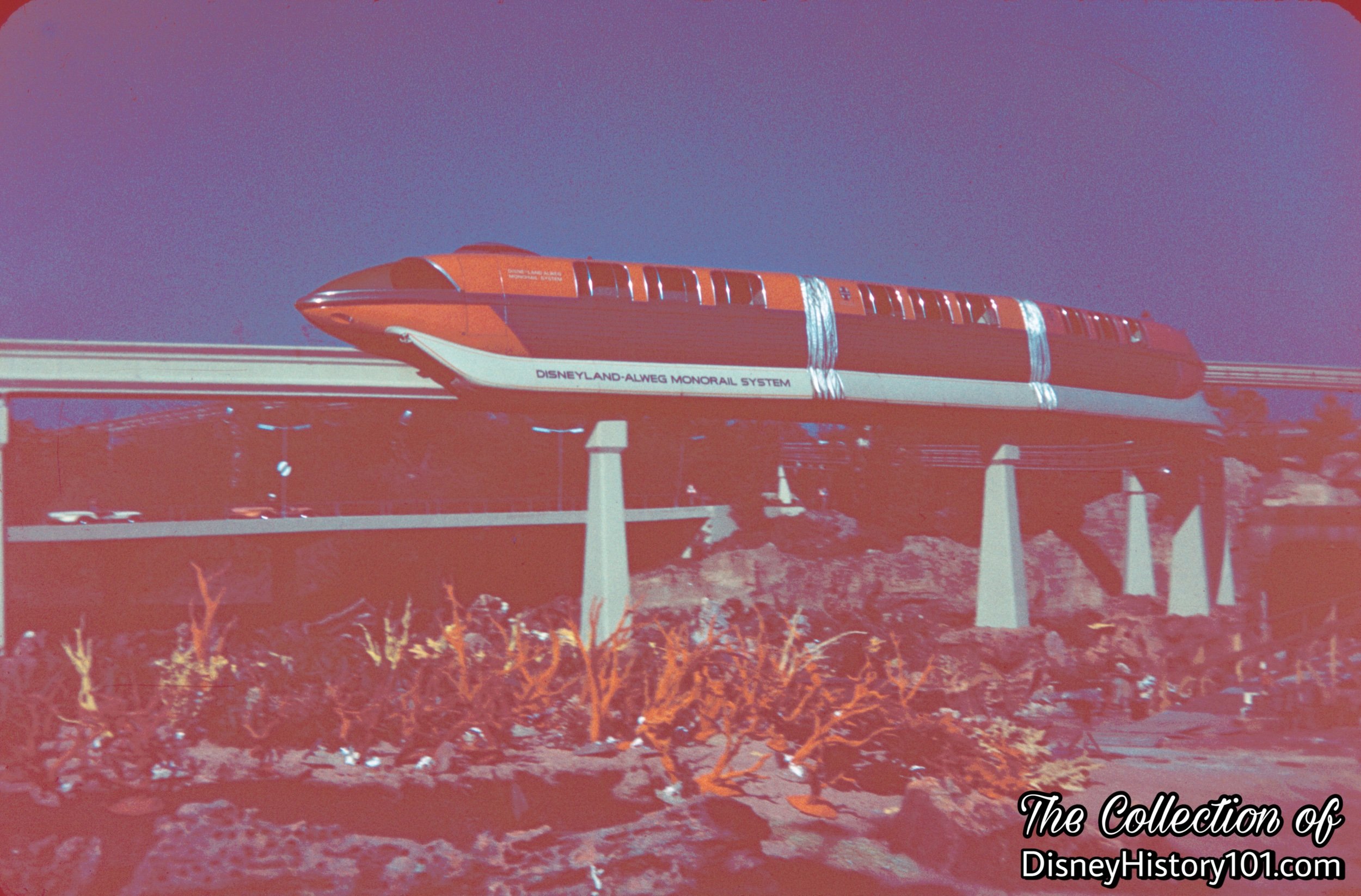
The new Santa Fe & Disneyland - ALWEG Monorail Mark I Red passes over the developing Submarine Lagoon, c.1959.
The Monorail Red was added first. Monorail Blue joined its twin Monorail Red on July 3, 1959. Soon, the Monorail trains were tested before the completion of the Submarine Lagoon.

“Gala Day at Disneyland”
As the summer of 1959 approached, six “spectacular new adventures” were heralded alongside what was called the 2nd opening of Disneyland. On June 14, 1959, the Disneyland-Alweg Monorail trains, Matterhorn Bobsleds, and Submarine Voyage fleet were dedicated at Disneyland. “The Disneyland-Alweg Monorail System was unveiled at Disneyland by Walt Disney and Vice President Richard M. Nixon, Mrs. Nixon, and their daughters Tricia and Julie also participated in the ribbon-cutting ceremonies, which were viewed by a national television audience watching the special ‘Disneyland ‘59’ TV show.”
“55er” Earl Anderson recalled: “Walt Disney took the special ceremonial scissors, that I had fashioned for him out of walnut and snipped the ribbon, But they DIDN'T WORK! Thereupon, Walt produced a pocket knife, cut the ribbon, and the new MONORAIL was officially open. was watching all this on television, as I was on vacation, and I was afraid to come back!” “55er” Al Alvarez recalled “I remember seeing the opening of the Monorail. There was a ribbon stretched across it and I was standing right there holding a pair of shears. They were a great, big pair, especially made for the ceremony. I was trying to hang onto the shears so that nothing could happen to them, but Walt's granddaughter got to playing around with them and loosened them up. Well, everything was on T.V., and when the time came to cut the ribbon, the shears were out of kilter and wouldn't work. So Walt pulled out a pocket knife and cut it himself.”
Now Disneyland Guests could circle above and around Disneyland, and “ride the new Disneyland- ALWEG Monorail System…high speed transportation of the future!” These would include the “heads of state - kings and queens, presidents and prime ministers - who visited Disneyland, as well as millions of other Disneyland VIPs from every state and nearly every nation.”
The $1,300,000 “highway in the sky” (also billed as “the nation’s first practical monorail train system”) first set off on June 14th, 1959 as a comfortable and efficient way to preview Disneyland. The Disneyland-Alweg Monorail System was the first passenger carrying monorail system in the Western hemisphere to operate daily. Appropriately, 1959 was the same progressive year that the “E” ticket debuted along with new “Big 10” and “Jumbo 15” Ticket Books which allowed larger families to “enjoy any attraction in Disneyland.”
By 1959, Joe Fowler was Vice President of Disneyland Operations Committee and Doc Lemmon of Disneyland Operations was overseeing Operators of Rides & Amusements (like the Monorail), Livestock, Parking Lot, and Ticket Sellers.
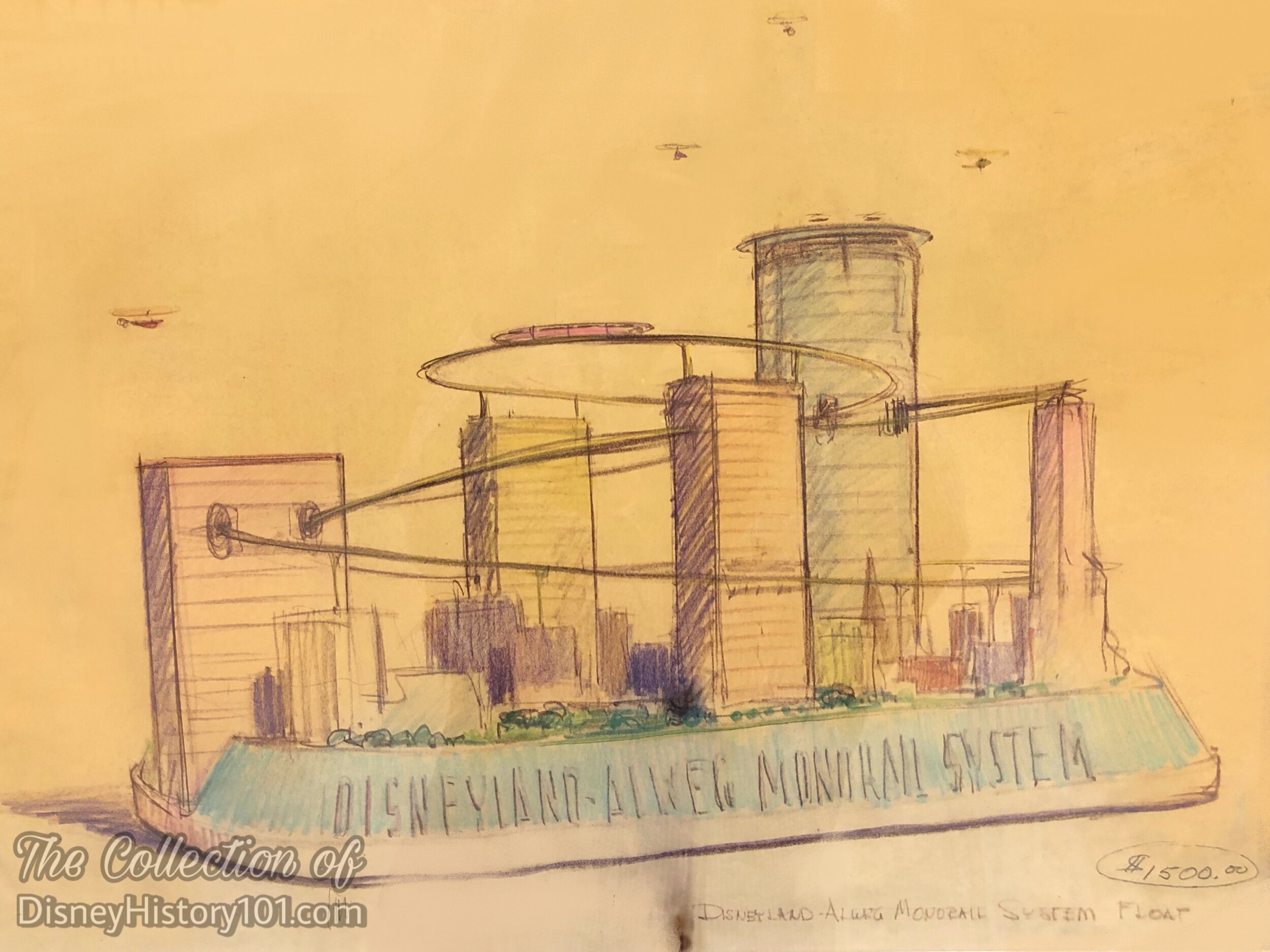
Disneyland ALWEG Monorail System Float Design, Former Richard Kraft Collection
This “Disneyland ALWEG Monorail System” Float Design was created for the parade celebrating the grand “Re-Opening of Disneyland”, in 1959. Small-scale monorail trains made their way around the miniature city-scape, atop the float as it moved down the parade route.
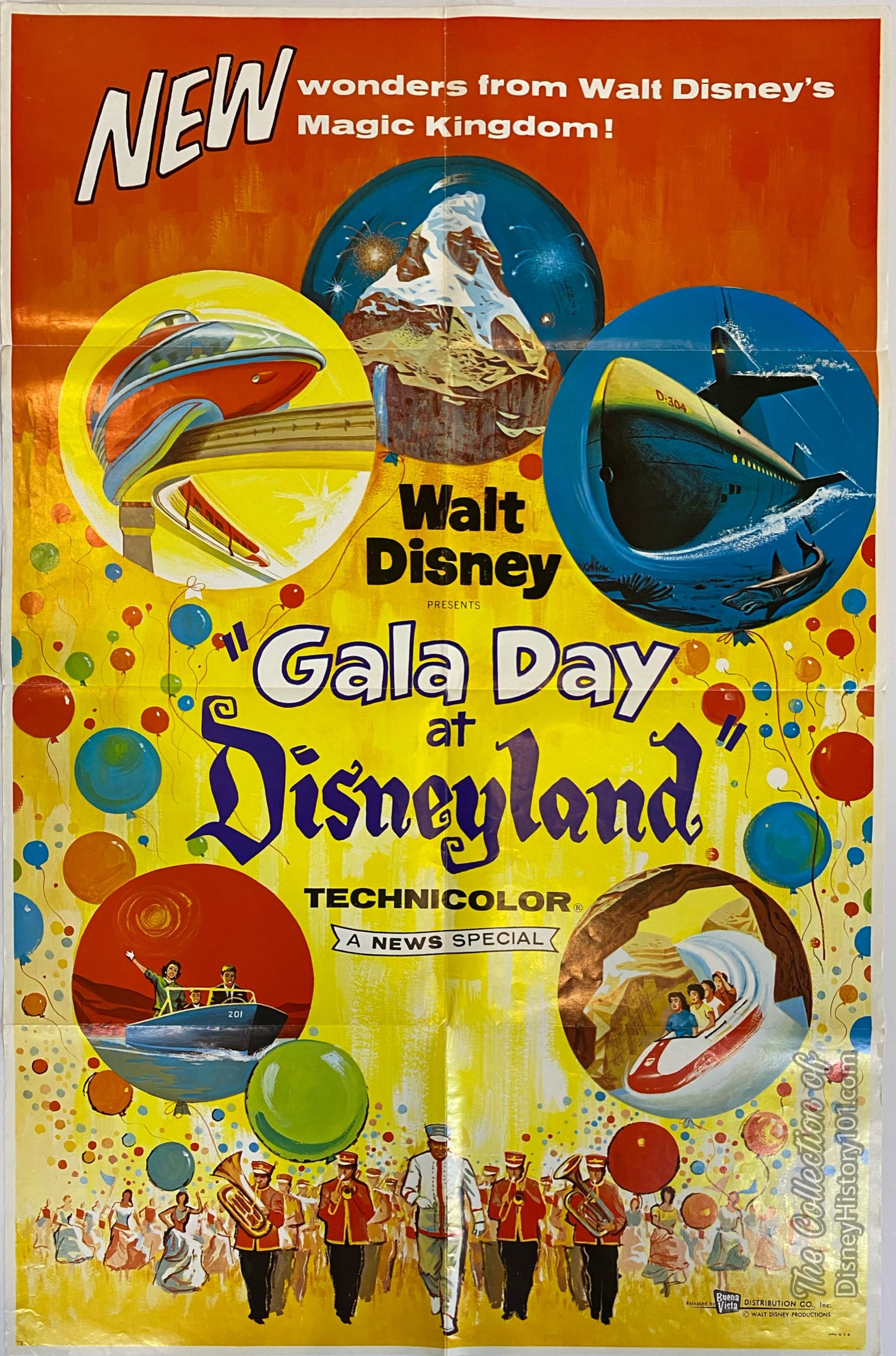
Gala Day at Disneyland Poster; 1959; All art work, posters, etc. were created by the Walt Disney Studios.
Above, is one of those full-color DeLuxe “Gala Day at Disneyland” one sheet posters by National Screen Service. “Gala Day at Disneyland” was a 25-minute Technicolor News Special released through Buena Vista Film Distribution Co., Inc. Buena Vista Distribution announced the debut of “Six Spectacular New Adventures” to movie-goers beginning June 21, 1960. This was the largest expansion of Disneyland to date and open with a major celebration and parade attended by hundreds of news media and celebrities. As part of the festivities Meredith Willson (famed writer of the hit Broadway musical The Music Man) lead a "76 Trombone" Marching Band. Among three new adventures was the Disneyland-Alweg Monorail System with its Mark I - a means of transportation in the future and “the first such vehicle to run on a regular basis in the Western Hemisphere!”
According to “50th ANNIVERSARY: The Sounds of Disneyland®”: “The Monorail became a ubiquitous Disneyland image, thanks in particular to the many film and television programs that featured the amazing, dynamic transports. From these shows came a unique style of music-appropriately dubbed ‘Monorail Music’ by its fans. For the record, not all ‘Monorail Music’ was originally written to underscore actual images of the Monorail itself-instrumental pieces such as ‘Sleigh Ride in Disneyland,’ musically representing the Matterhorn, are part of the stylistic genre as well. ‘Monorail Music’ generally exists as unpublished instrumental pieces, used variously and frequently in many forms of media as an emotional signature, a prompt to transport the viewer instantly into the world of Disneyland-where life glides along as effortlessly as the Monorail itself.”
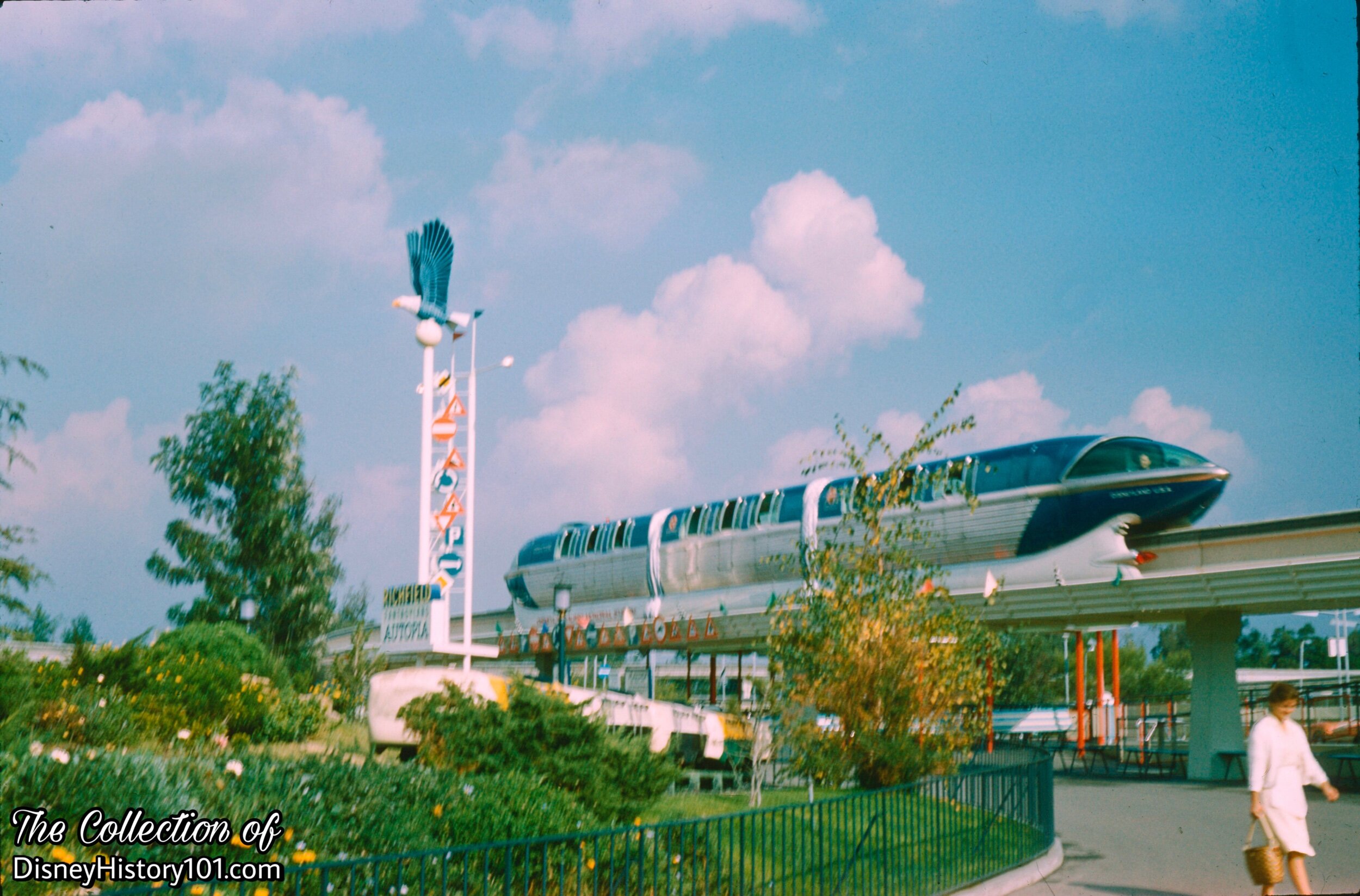
The Santa Fe & Disneyland - ALWEG Monorail Mark I Blue at Tomorrowland Station, (December 2, 1960)
One of the bullet-nosed sightseeing Monorail trains soars high over Tomorrowland, passing the Richfield Eagle marking the entrance to the Fantasyland Autopia, en route to “nowhere in particular!” To be fair, the route took passengers over woods, lakes, rivers, waterfalls, tropical lagoons, Autopia Freeways, and circled the 1/100 scale Matterhorn Mountain. By this time, the two ultra-modern trains of the Disneyland-ALWEG Monorail system (pulling just one coach and one cone) were transporting an astounding capacity of 86 Guests per train, allowing an average of 2,100 passengers per hour, and 100,000 persons a week along its 3,800 foot-long rails in Tomorrowland.
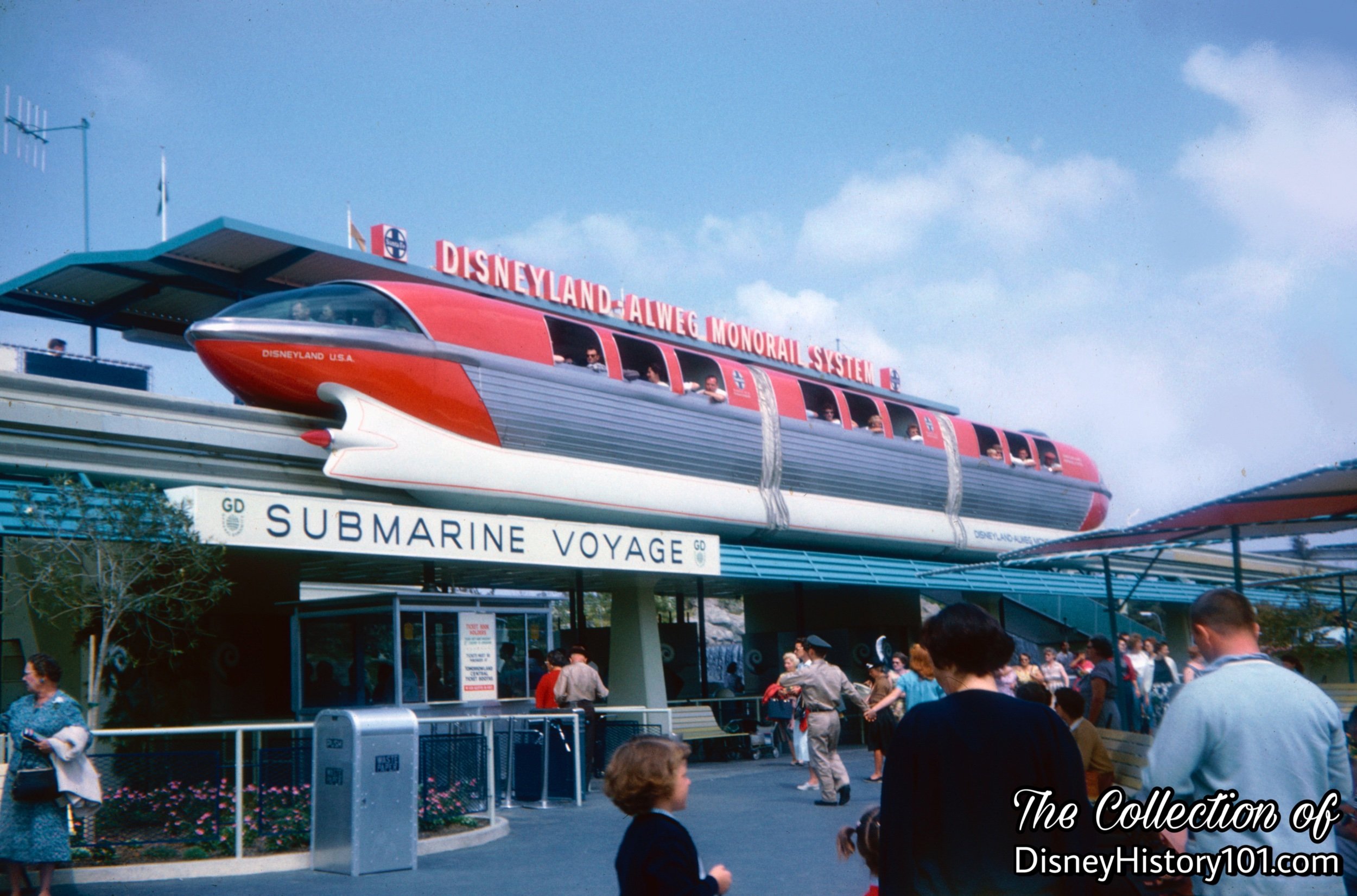
The Santa Fe & Disneyland - ALWEG Monorail Mark I Red at Tomorrowland Station.
Due to an agreement with Atchison, Topeka & Santa Fe, the ALWEG Monorail trains and coaches would carry the Santa Fe name (and not the name of another railway).
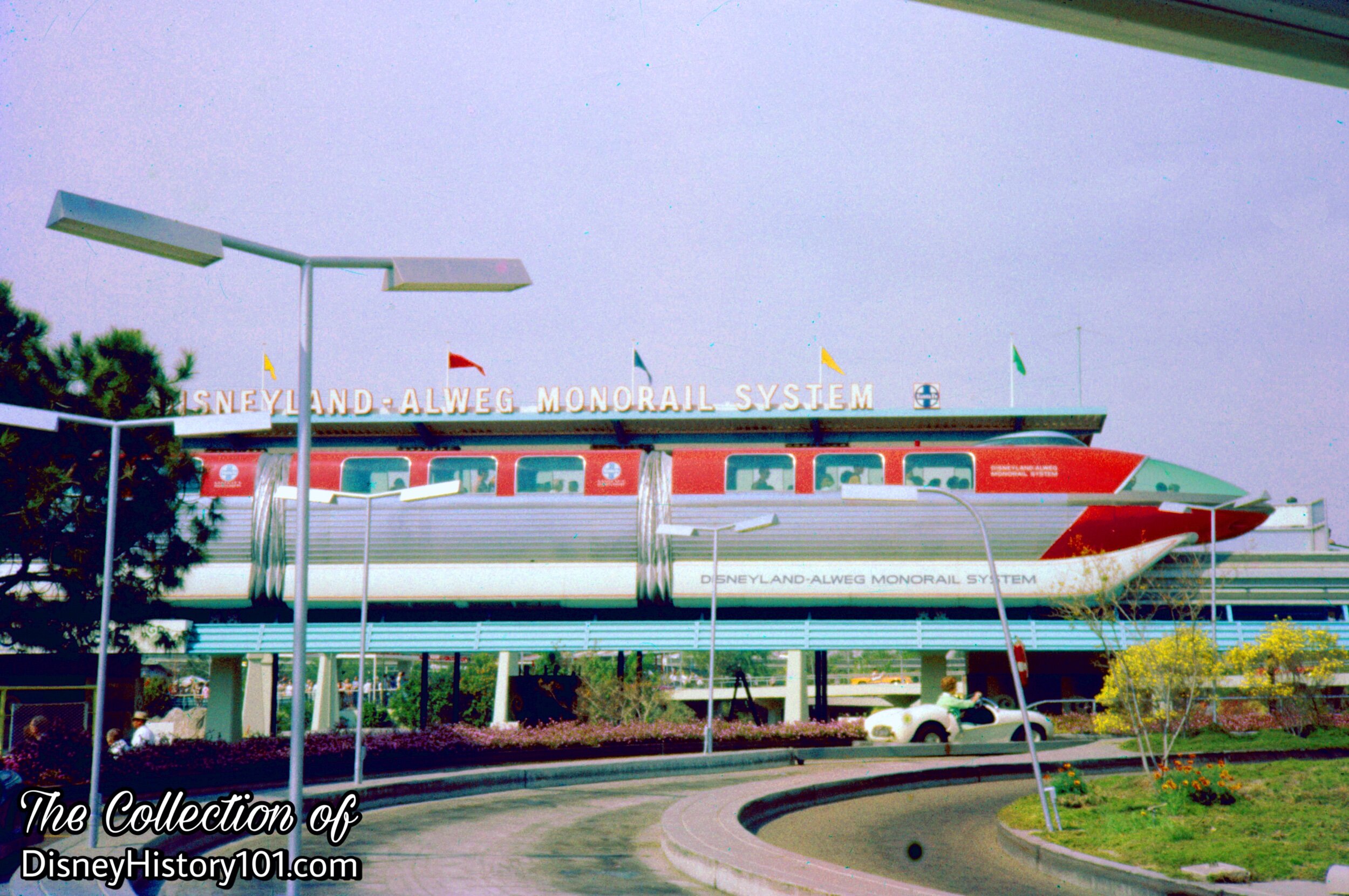
The Santa Fe & Disneyland - ALWEG Monorail Mark I Red at Tomorrowland Station.
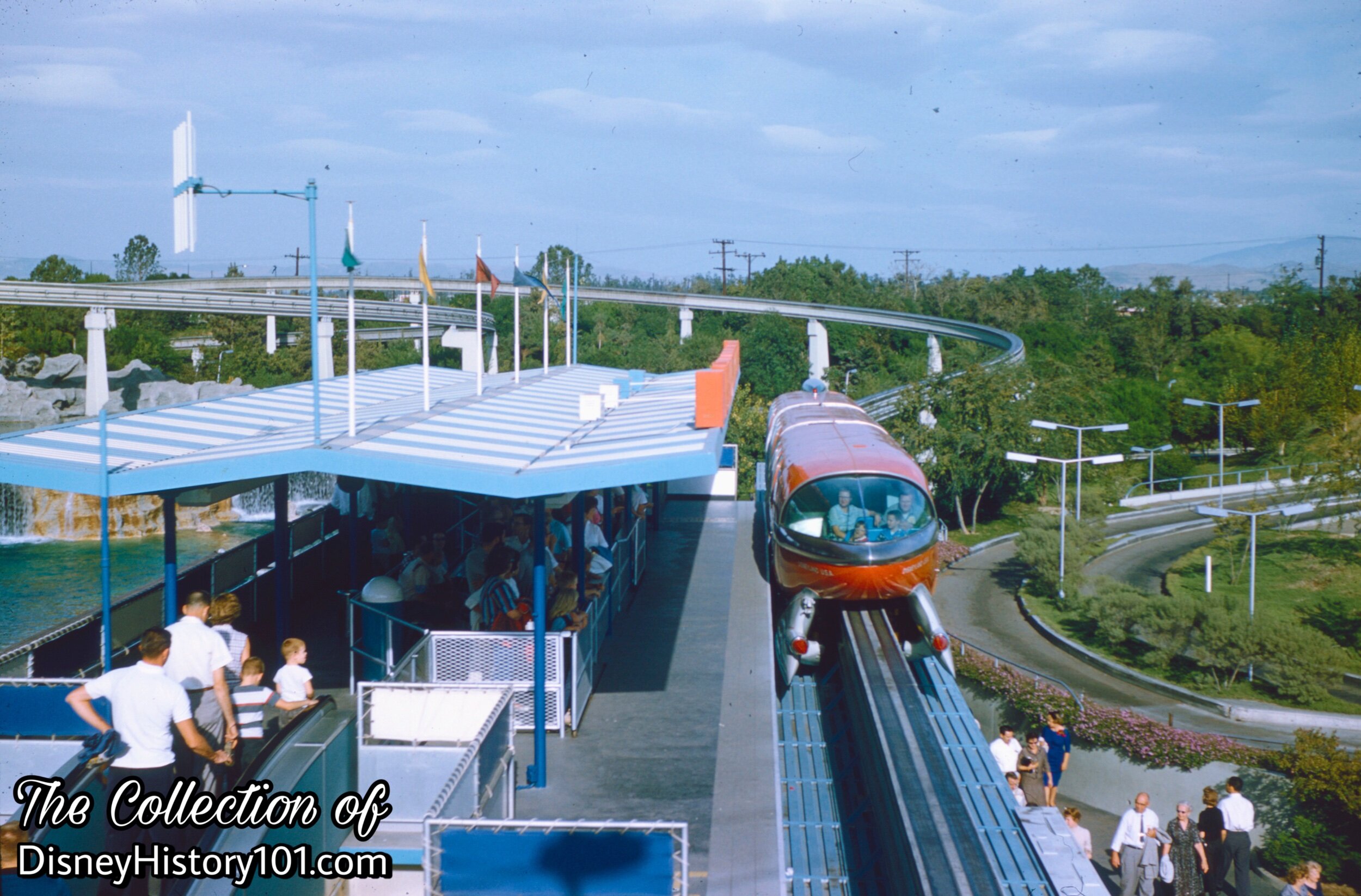
The tail cone of the Santa Fe & Disneyland - ALWEG Monorail Mark I Red at Tomorrowland Station (right) while Guests approach the Guest Control queue area (left).
Here, the Monorail train stops at the only scheduled stop along the beamway where passengers could board.
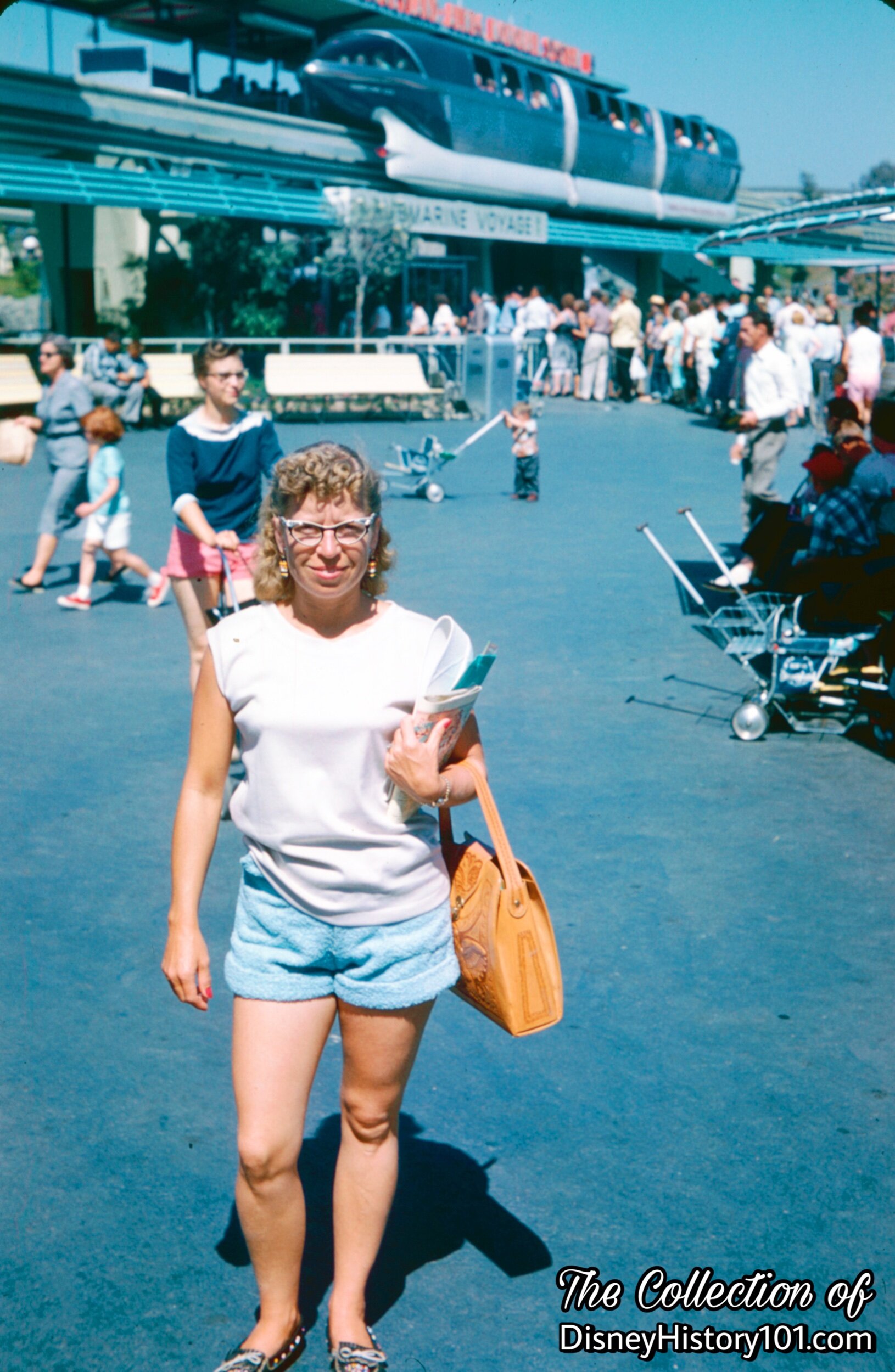
A Disneyland Guest stands near the Monorail Blue Mark I at Tomorrowland Station.
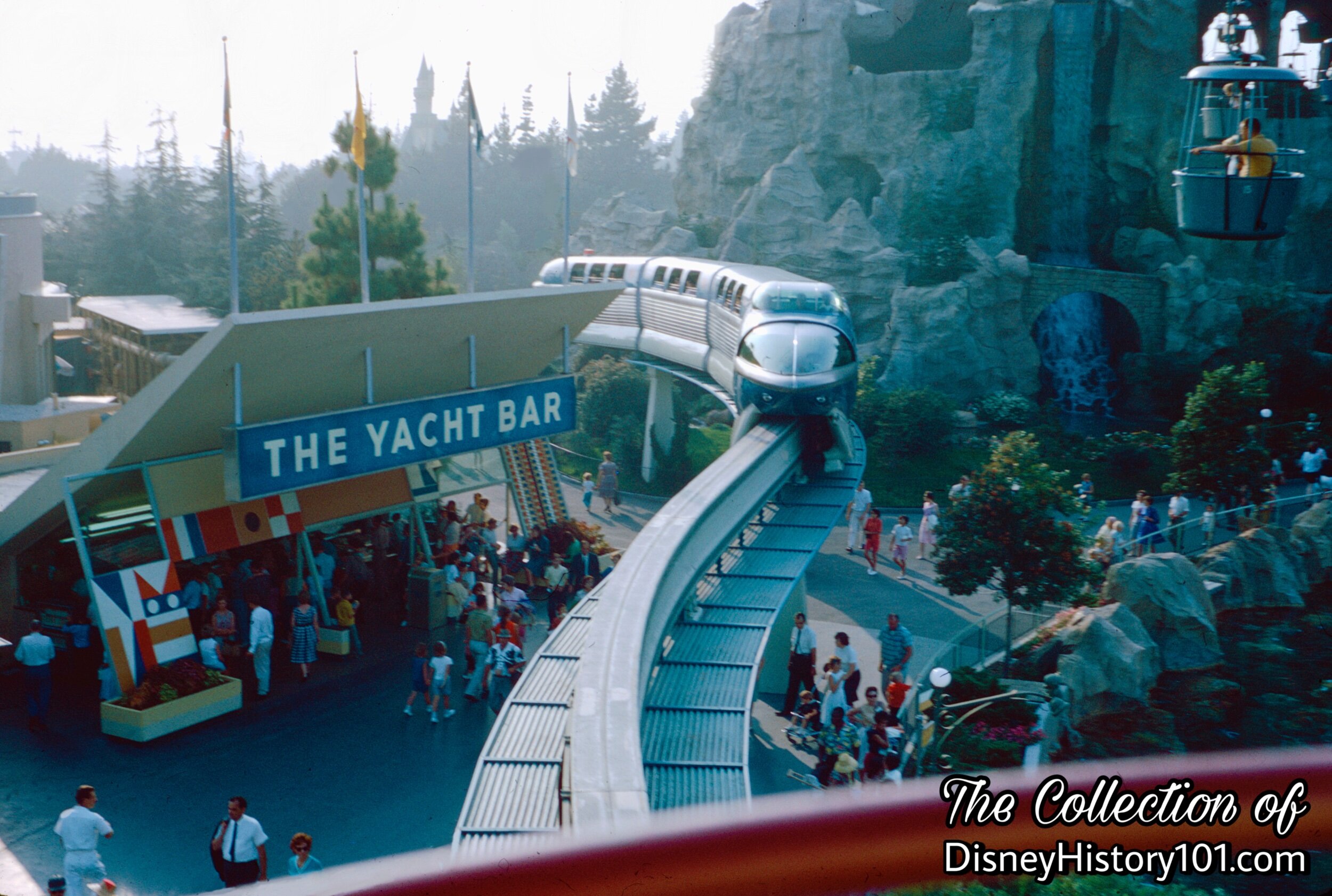
Monorail Blue Mark I passes the Yacht Bar in Tomorrowland.
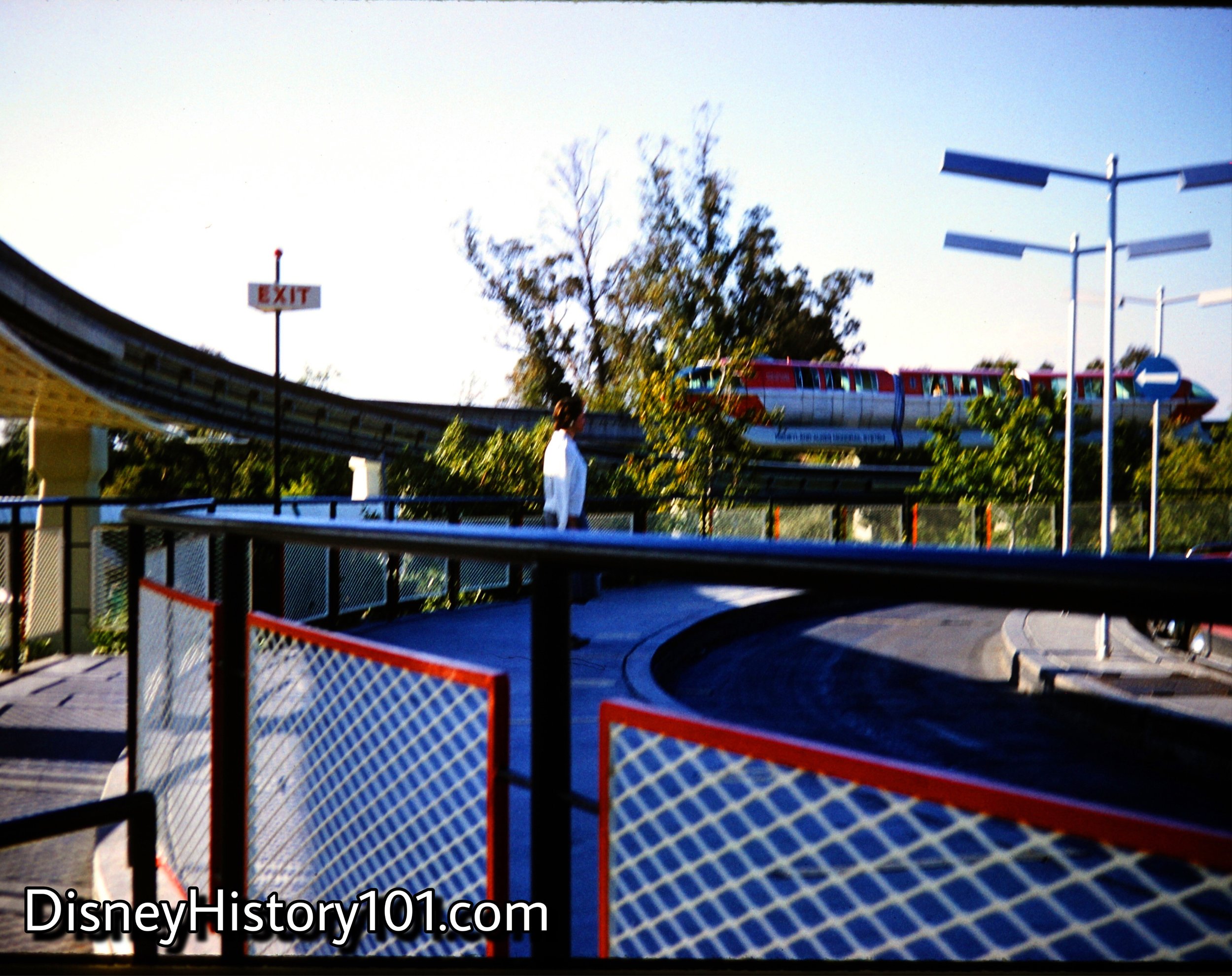
The Monorail Red Mark I passes near the Autopia, (1960)
As we head over the Tomorrowland Autopia and toward the Submarine Lagoon, we will apply the brakes and decelerate to a speed of 17 miles per hour. We will be approaching one of our stops - the Tomorrowland Station!
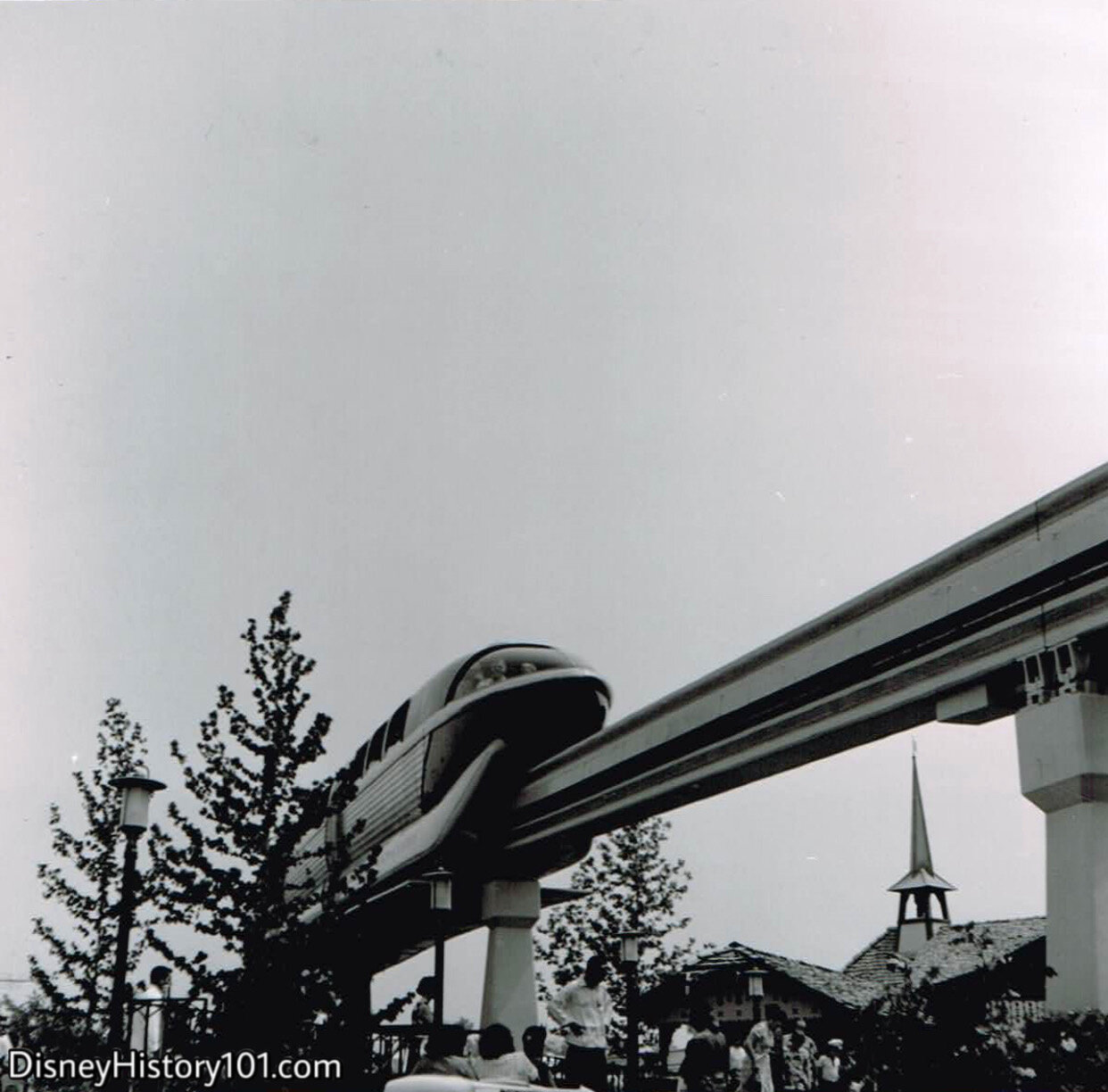
A Monorail Mark I passes near the Matterhorn queue.
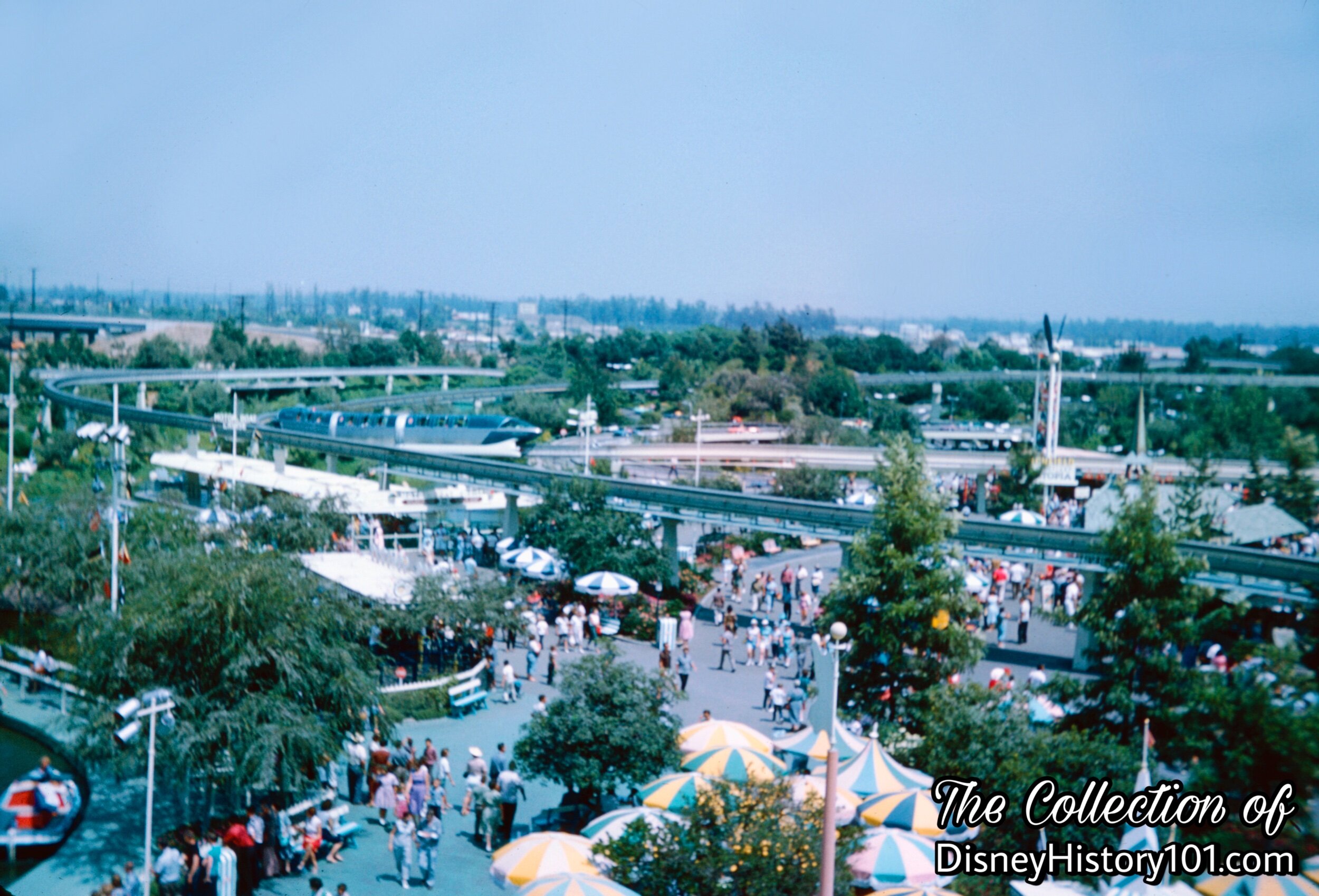
Monorail Blue Mark I over Tomorrowland, August of 1960.
As we slow down and circle around the Matterhorn, we gain an opportunity to take a gander at Tomorrowland.
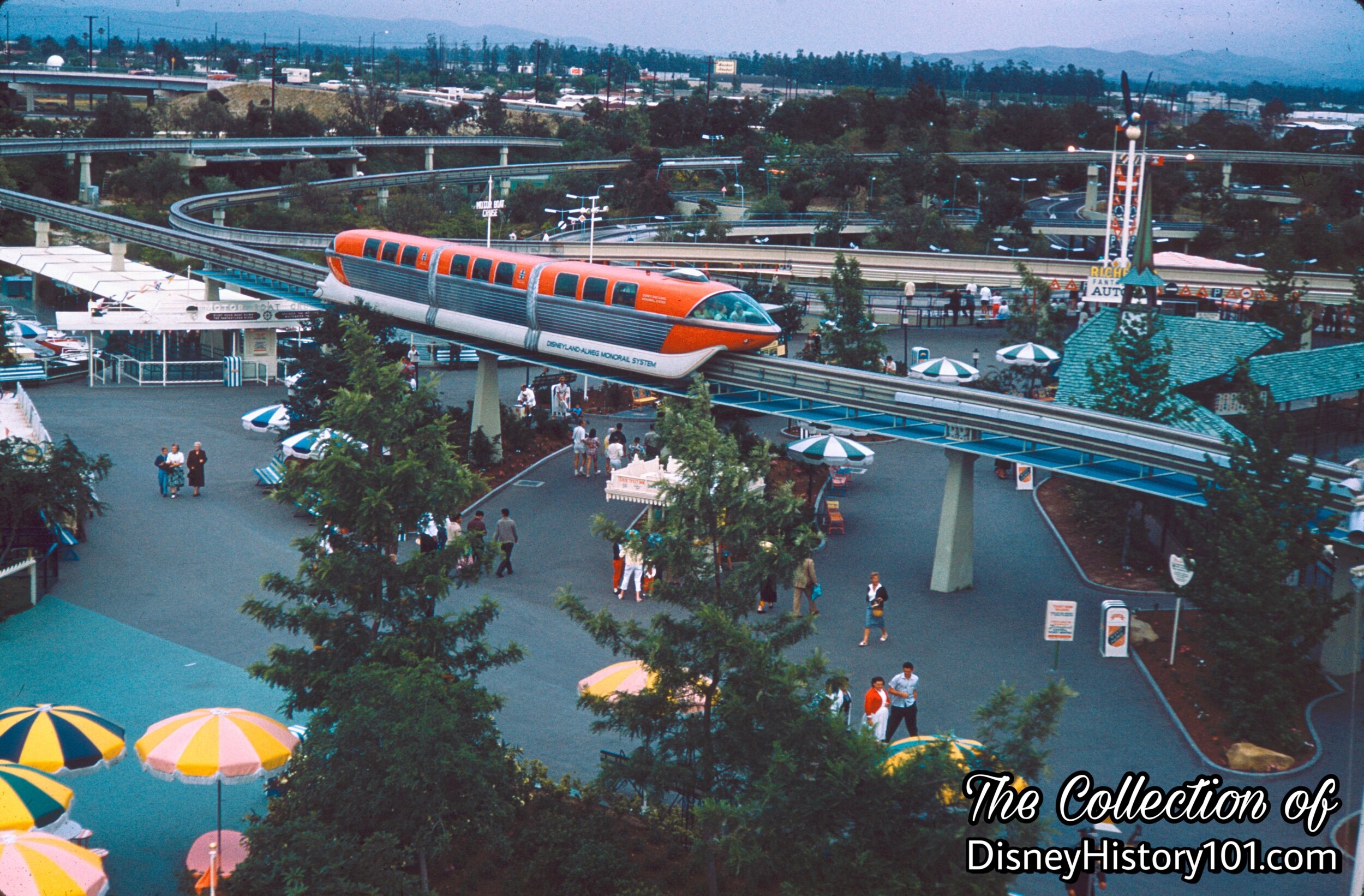
A Monorail Red Mark I over Tomorrowland, (May, 1960)
The Monorail is a moving piece of machinery. Blue translucent panels that comprise the Canopy have been placed on the underside of various portions of the Beamway to serve as a protection against any oil or condensation dripping from the trains onto guests, bobsleds, or motorboats passing below.
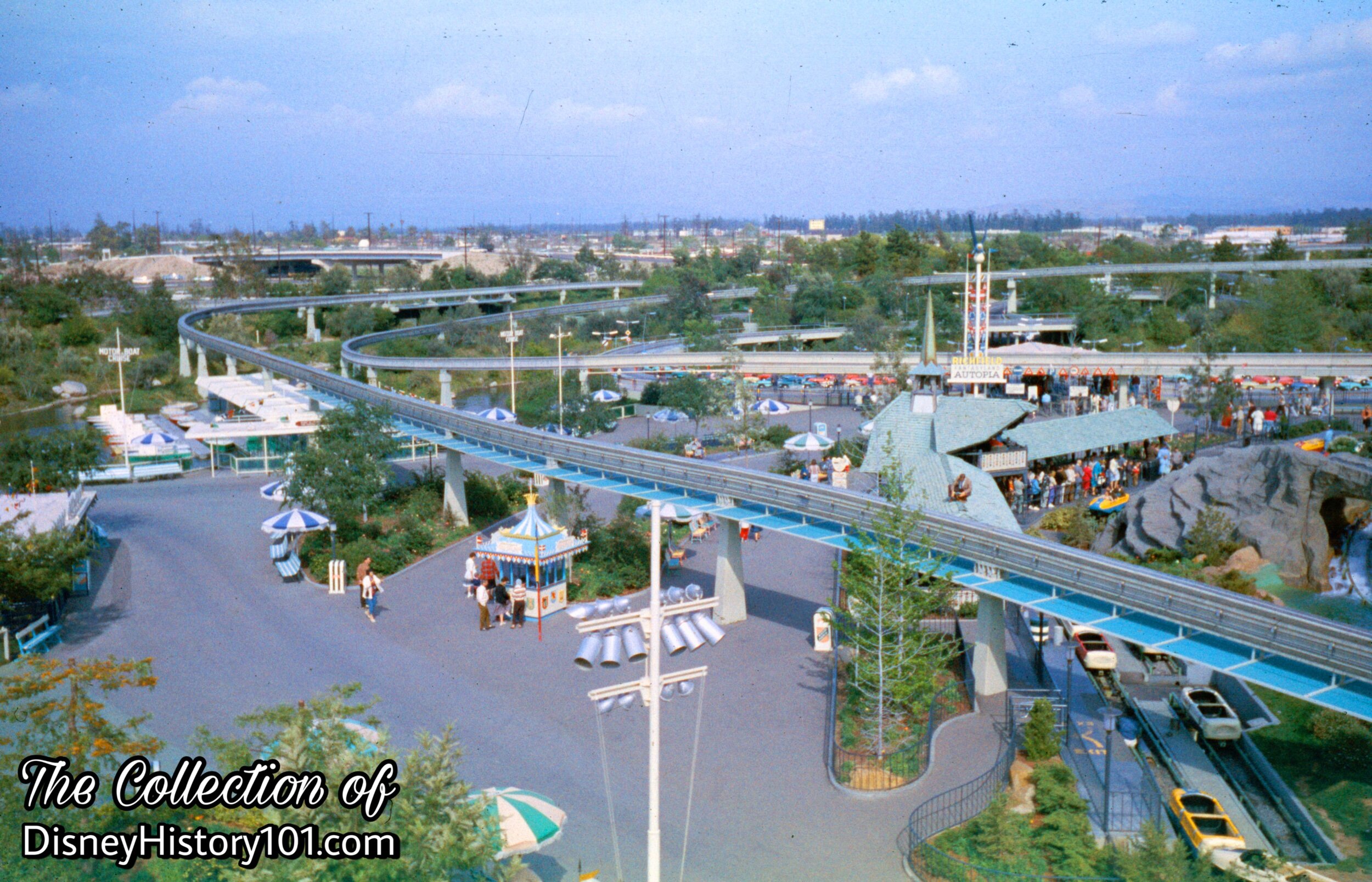
The Monorail Beamway and Canopy over Tomorrowland.
Just look at that spotless pavement!

The Monorail System over Tomorrowland.
From nautical adventures to high-flying journeys through Disneyland’s Pennine peak - The Disneyland-Alweg Monorail System certainly stood out, as one of several new attractions that accentuated Tomorrowland in 1959!
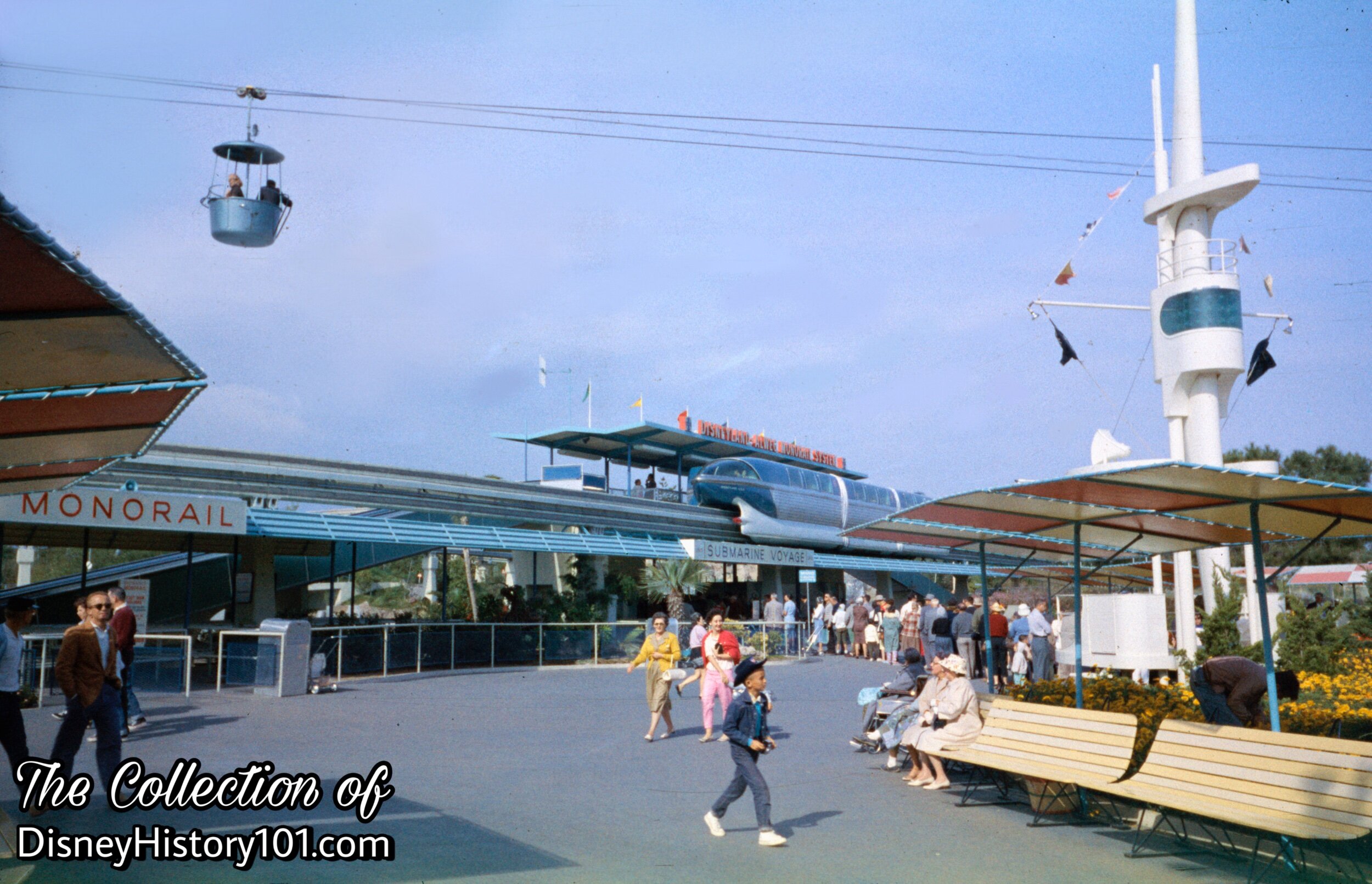
The Monorail Blue Mark I at Tomorrowland Monorail Station.

The Monorail Red Mark I at Tomorrowland Station.
Well, it looks like we’re all ready to approach the Tomorrowland Monorail Station, and depart for a round trip of sightseeing in the brand new three-car Red Mk 1!
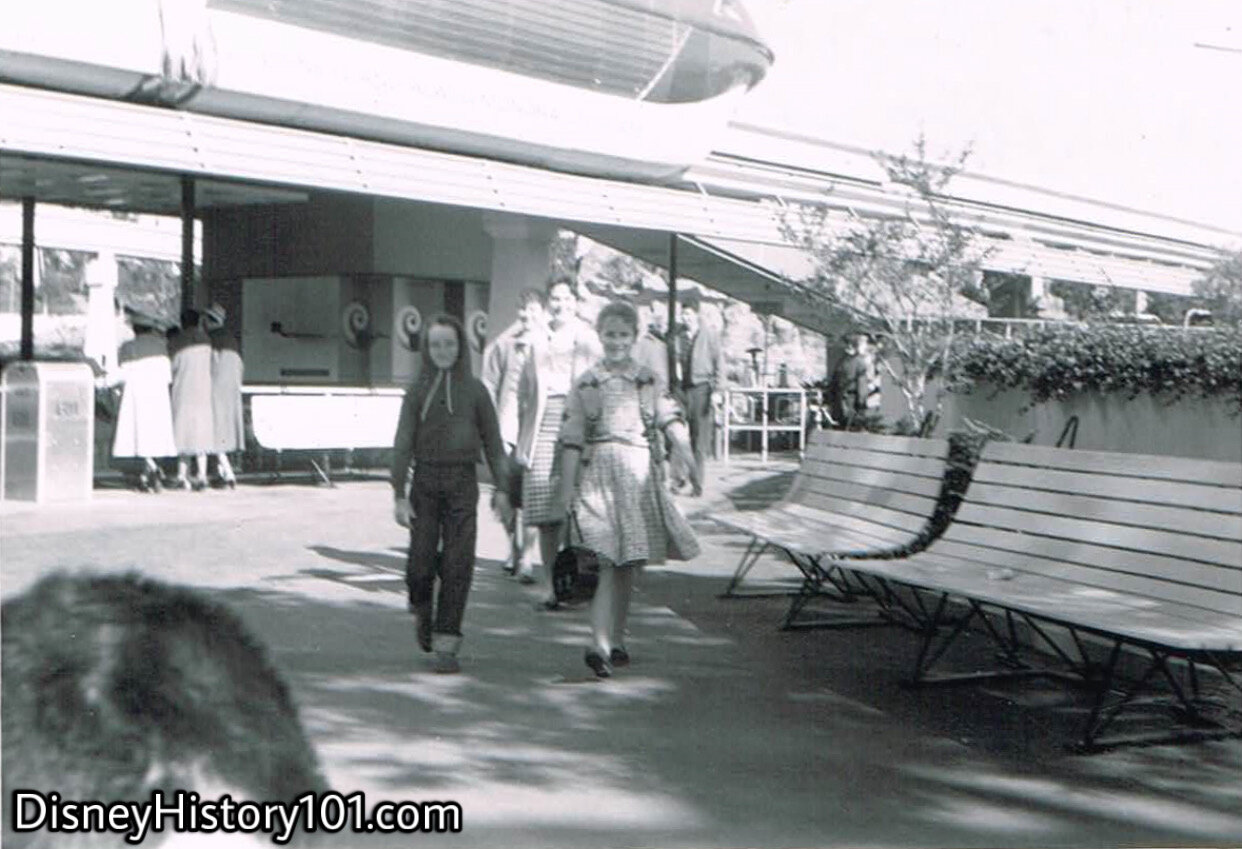
Monorail Mark I, 1960
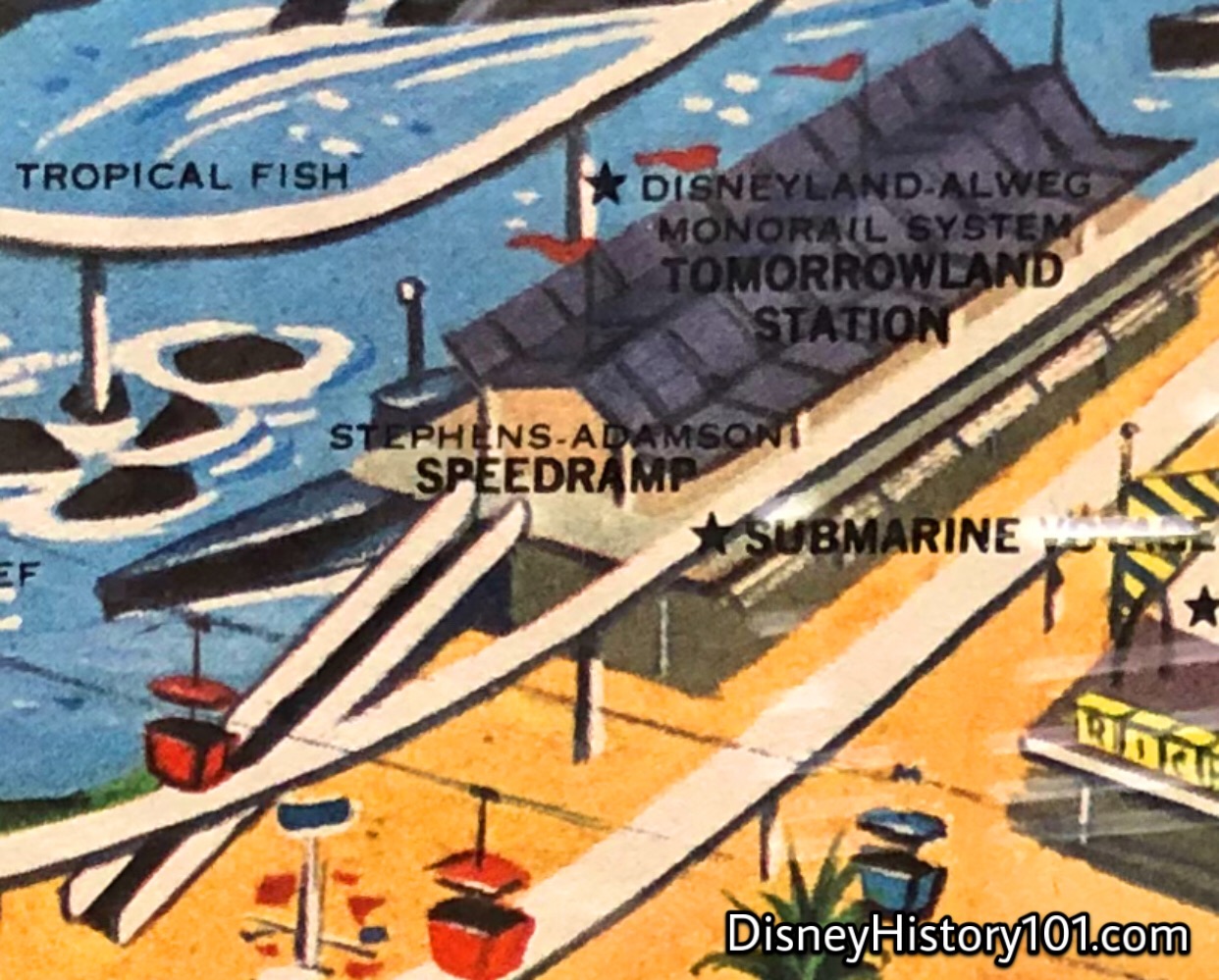
The efficient “Stephens-Adamson Speedramp” at Tomorrowland Monorail Station, (1961 Map Excerpt)
“Stephens-Adamson Speedramp Design and Construction”
During the mid-1950s, moving sidewalks were innovative and not a foreign concept. Naturally, a moving sidewalk was part of the plans for Tomorrowland since the earliest stages of development. According to the 1953 Disneyland Prospectus : “A MOVING SIDEWALK carries you effortlessly into the World of Tomorrow where the fascinating exhibits of the miracles of science and industry are displayed.”
The construction crews didn't begin work on any of Tomorrowland until six months into the project. However, as of June 2, 1955, C.V. Wood Jr. sent an Inter-Office Memorandum to Walt Disney regarding the best estimates that could be obtained at the time regarding the completion status of individual sections of the Park and Opening Day. C.V. wrote: “Moving sidewalk decision needed from the design group. This is critical if we are to have it for opening.” By Press Preview Day, Tomorrowland at Disneyland opened without its promised moving sidewalk. The closest thing was a revolving moving walk within Space Station X-1.
But the exciting “moving sidewalks” were to become a reality sooner than many guests imagined! Three years later, Walt Disney’s Guide to Disneyland (published early 1958) offered a preview of the coming Disneyland-ALWEG Monorail attraction, teasing that “even the access to the Monorail Train Station is futuristic ; a Speedramp carries passengers from ground level to the loading platform.” By that very year of 1958, Herb Ryman would create numerous “suggestions” of the “Monorail Station.” Outside contractor Stephens-Adamson Mfg. Co. designed the “Speedramp.”
Not even a year later (in 1959), Tomorrowland would finally receive the Stephens-Adamson Speedramp (the first of several Stephens-Adamson passenger conveyors to be built in Disneyland). Electric motors with a variable speed drive were capable of moving the rubber speedramp belts (and their guests) at 125 feet per minute. The impressive maximum capacity of these ramps was figured to be about 6,000 guests per hour!
“Speedramp Maintenance”
Disneyland Park Operations Crew M-43 Machinists would read the daily “Third Shift Report” and Defect Sheet and make a standard opening inspection of all "Speed Ramps" in the Tomorrowland area, checking their overall appearance, check for any discrepancies and notify M-1 Machinists and the proper department supervisor. They would notify M-41 of any further work to be done or parts needed prior to opening. M-43 Machinists would respond to all Downs and delayed openings in T/L area whether or not it was mechanical. Upon arriving at a down attraction, they would determine what the failure was, determine which crafts were needed, determine an estimated time needed to repair, notify M-1 Machinists of all available information, and assist other crafts to repair attraction as needed.
“Speedramp Legacy”
Following the success of this attraction, competing theme park Freedomland (which operated in the Bronx, New York from June 19, 1960 to September 13, 1964), launched its Stephens-Adamson Manufacturing Co. sponsored Moving Lake Walk. This attraction was a traveling sidewalk over lake in its Satellite City: The Future area! Two years later, Stephens-Adamson would also be responsible for the passenger conveyor system at the General Electric Carousel of Progress (1966), one passenger conveyor system at the Wedway Station (1967), an updated version of the passenger conveyor system at the Monorail System Tomorrowland Station (1969), and two conveyors in conjunction with the Haunted Mansion attraction (1969).

Tomorrowland Monorail Station.

Monorail Mark I at Tomorrowland Station.
“A Brief Word About Fuels & The Cycad Revoluta”
Guests approaching the waiting area prior to the entrance turnstiles can see a curious palm-like plant which is, in effect, a living fossil. According to some tour scripts : “Its relatives existed in the Mesozoic Period some two hundred million years ago.”
I know what you’re thinking! Though the Washingtonian Palm is clearly not the Cycas Revoluta aluded to in the spiel, there was one present on the other side of the Beamway.
Bill Evans (Disneyland horticulturalist and landscaper stated about this specimen in the book Disneyland World of Flowers (1965) : “We mentioned that Tomorrowland links past, present, and future. In the chemistry exhibit, for example, one learns that modern synthetic fibers are in many cases derived from coal formed millions of years ago. So it seemed not inappropriate to situate a Cycad specimen directly at the entrance to the Monorail. This curious palm-like plant, popularly though incorrectly known as the Sago Palm, is in effect a living fossil. It existed in the Mesozoic period some two hundred million years ago. Its neighbors from that era have long since disappeared, but some extraordinary tenacity has enabled the Cycas Revoluta to survive, a truly remarkable feat when no one pauses to consider the changes the crust of this Earth has undergone in that vast period of time. A nearly extinct reproductive mechanism, one of nature’s early and long-since superseded techniques, triggers a strange annual flower followed by strange seeds the size of chestnuts. Our 50-year-old specimen is still observing the ancient system.”
Another rare specimen planted near the Submarine landing was the philodendron sellom, in fact it was the “‘grandmother’ philodendron sellom to set seed in the United States,” according to Backstage Disneyland (summer of 1966).
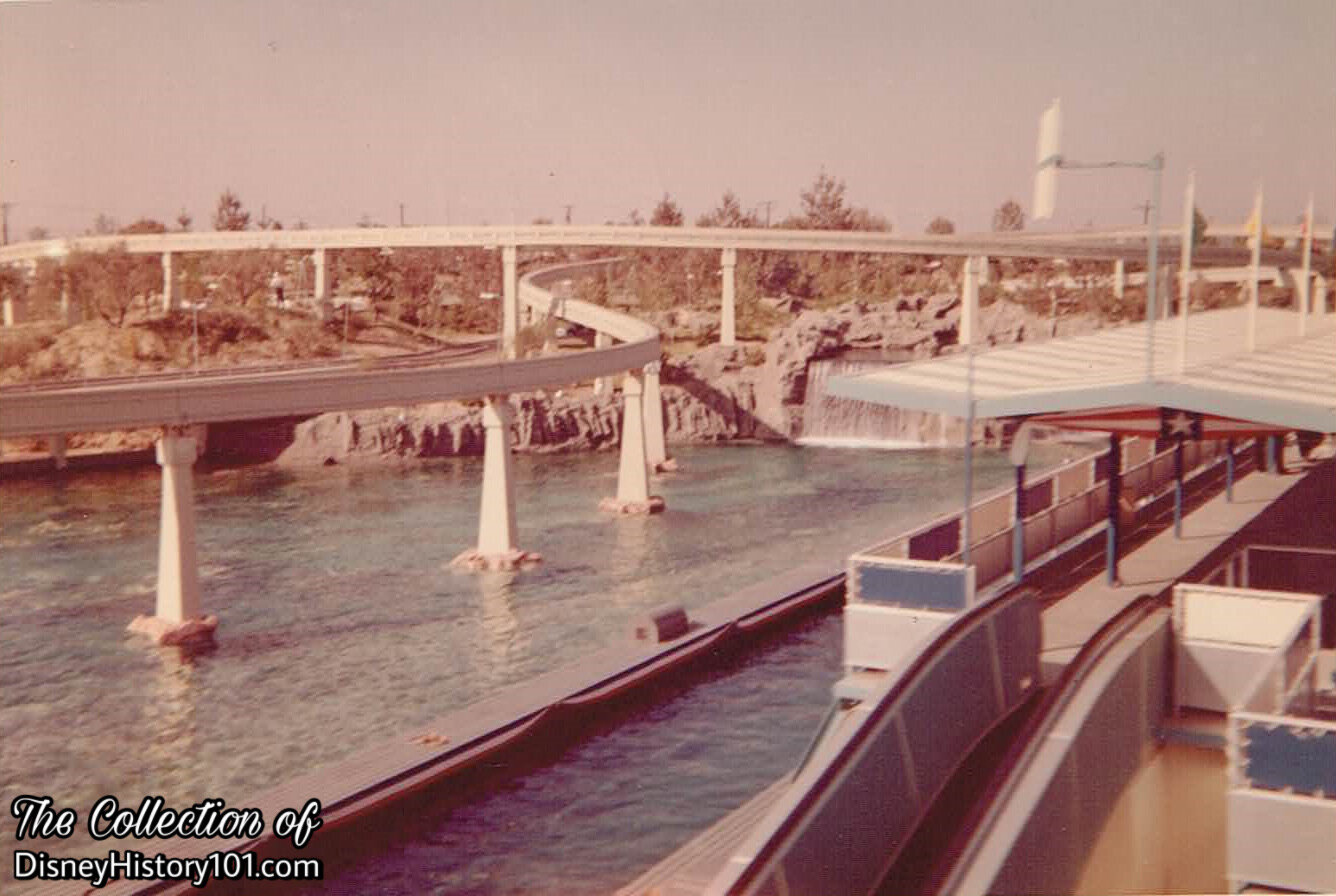
“Stephens-Adamson Speedramp” at Tomorrowland Monorail Station.
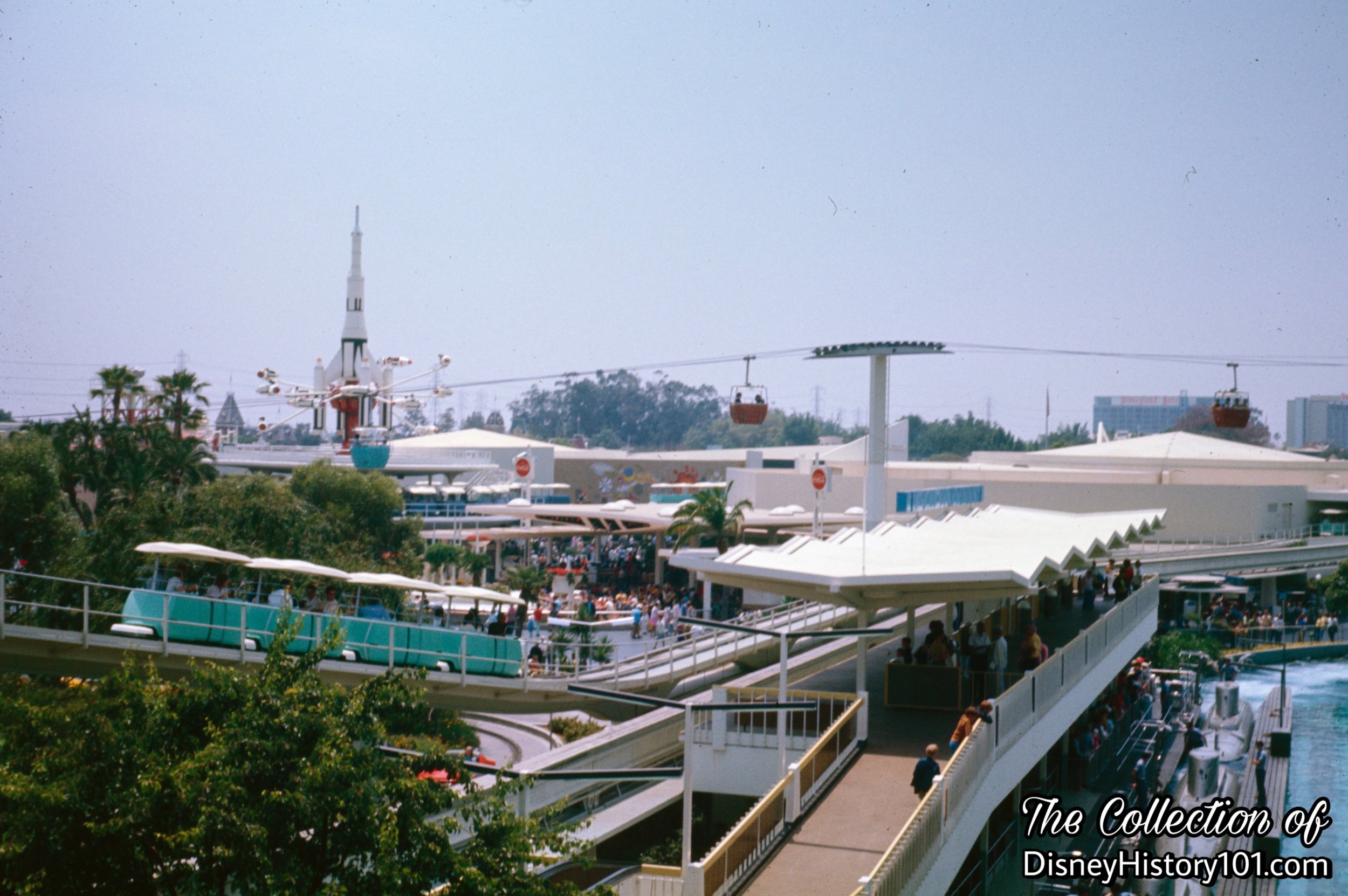
“Stephens-Adamson Speedramp” at Tomorrowland Monorail Station.
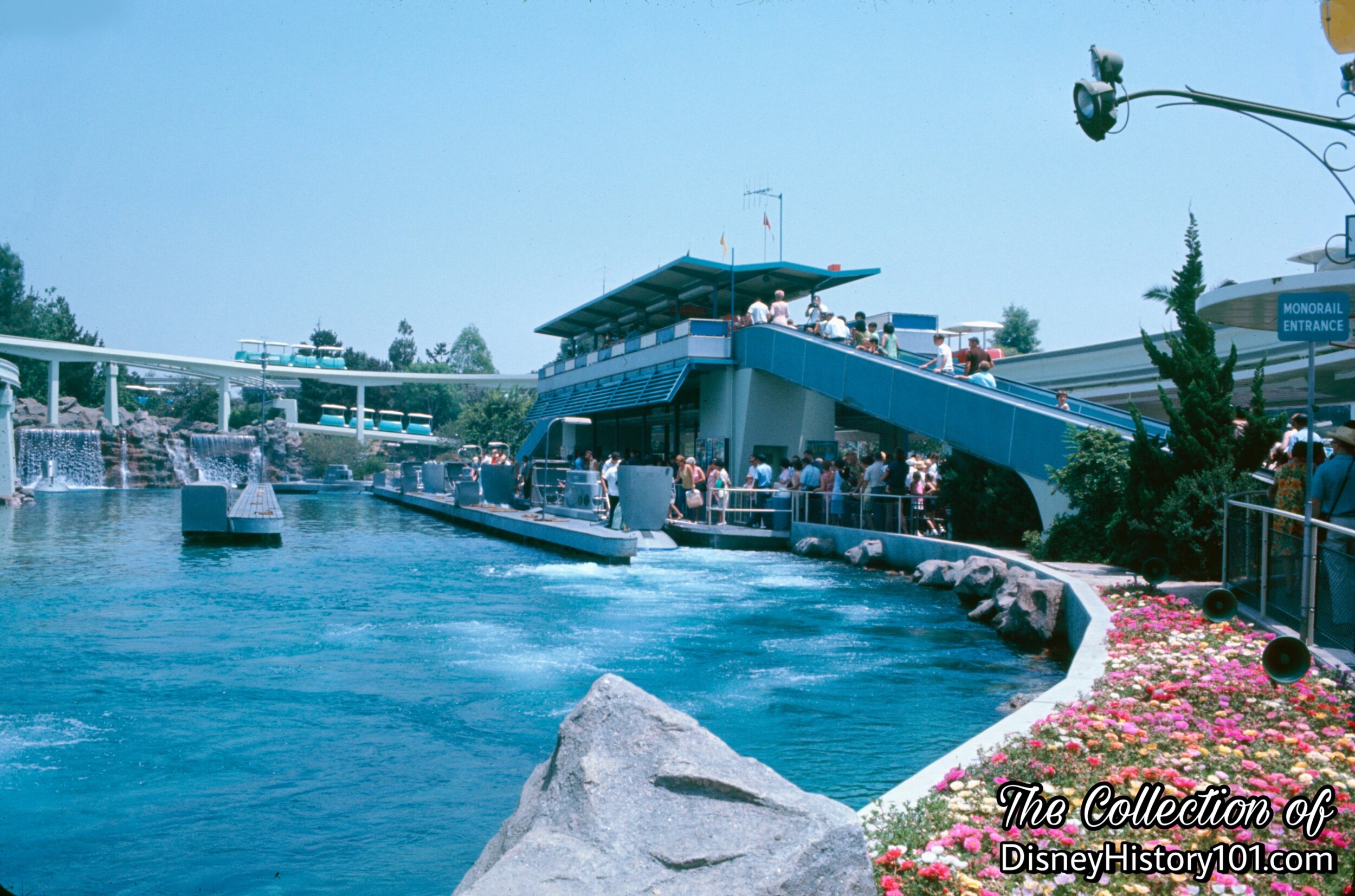
Colorful flowers lead the way to the “Stephens-Adamson Speedramp” at the Tomorrowland Monorail Station.
The Stephens-Adamson Speedramp (a moving sidewalk) carries guests to their destination at the top in 45 seconds! Guests stepping from the Speedramp should be cautioned to watch their step and to move forward onto the platform. Traffic must be kept moving smoothly at all times, but if it backs up, the Speedramp should be stopped by pressing the button located at the base of the Speedramp undercarriage. The ramp should never be started again until it is completely free of guests. Once on the platform, guests can see unique coral formations and various forms of sea life through the crystal-clear surface of the water below.
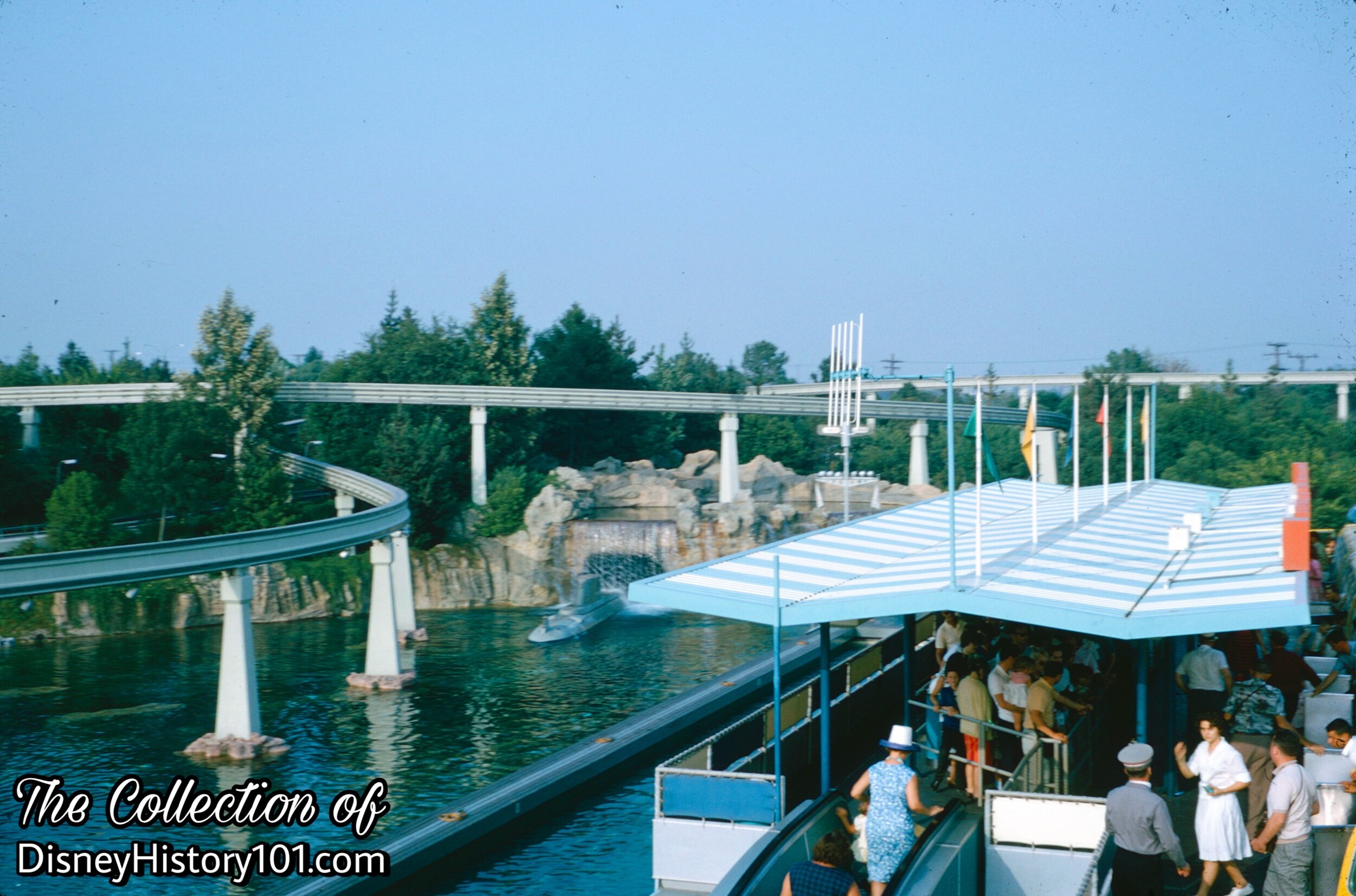
“Stephens-Adamson Speedramp” leads to the Guest Control queue area at Tomorrowland Monorail Station.

“Stephens-Adamson Speedramp” at Tomorrowland Monorail Station, (July, 1963)
According to one Guided Tour Script (1962) : “Please follow me as we take the ultramodern Speedramp to the Monorail Landing. . .watch your step.”
Other amendments added the reminders “please be sure to look down” and “hold on to the hand railings.”
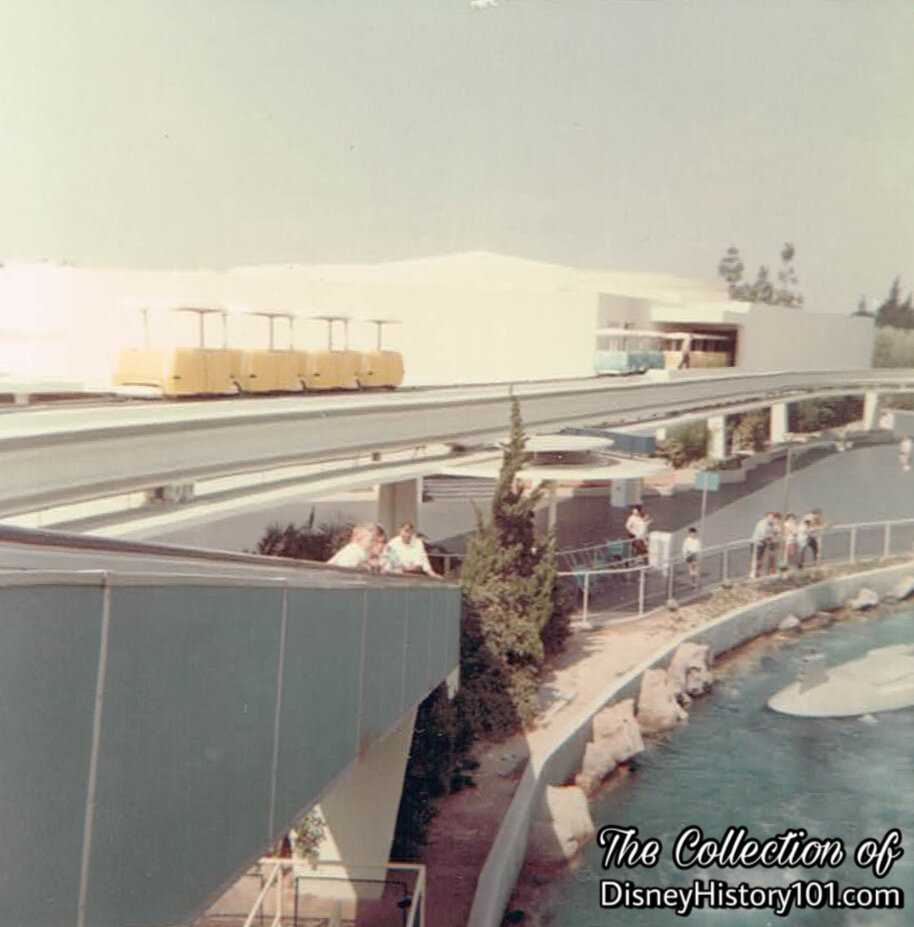
“Stephens-Adamson Speedramp” at Tomorrowland Monorail Station.

Disneyland-ALWEG Monorail Mark I Blue at Tomorrowland Monorail Station.

Monorail Mark II Blue, (1960)

Disneyland-ALWEG Monorail Mark I Blue, (November, 1960)
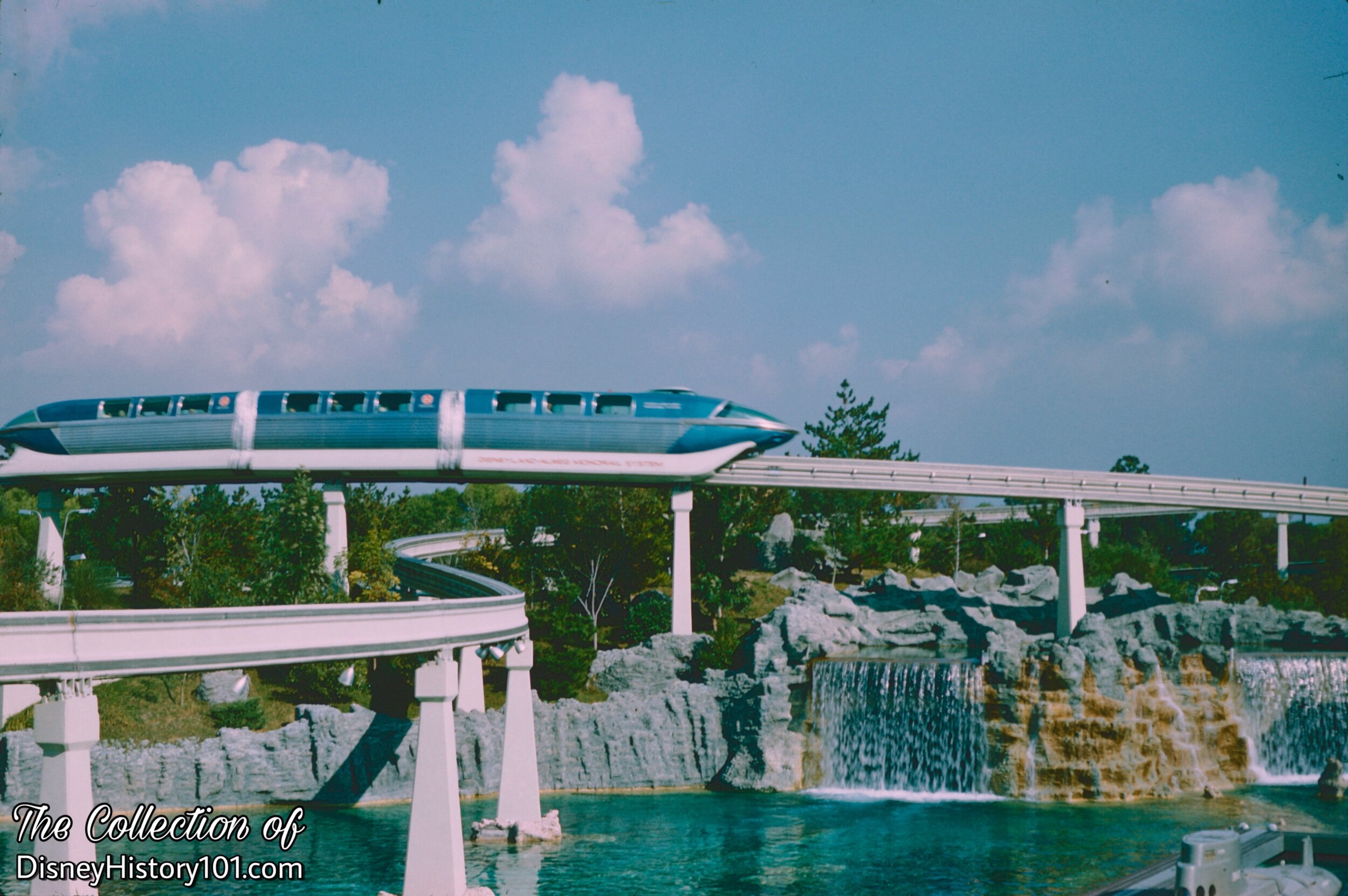
Disneyland-ALWEG Monorail Mark I Blue, (December 2, 1960)
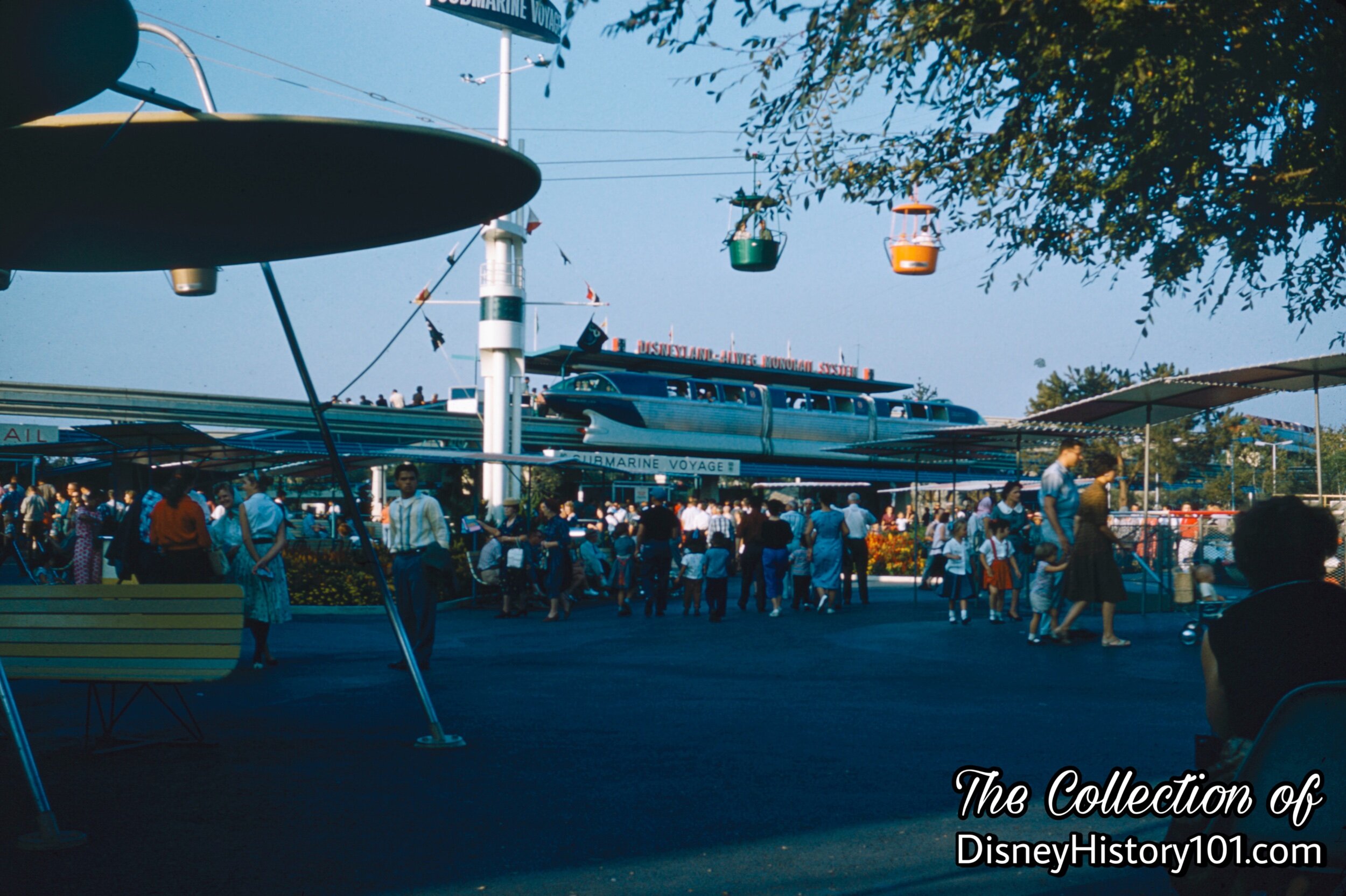
Disneyland-ALWEG Monorail Mark I Blue
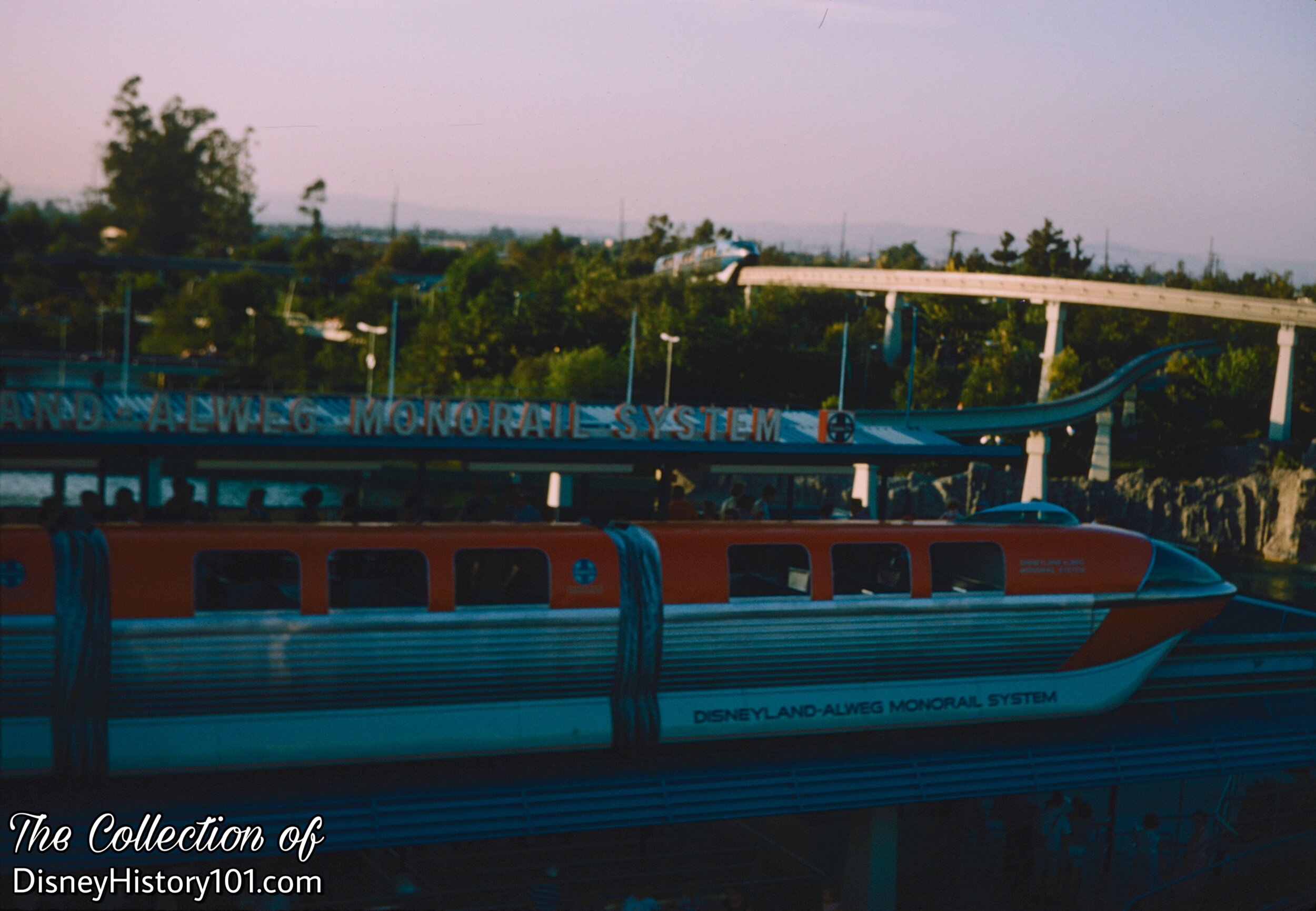
Disneyland-ALWEG Monorail Mark I Red, (December 22, 1960)
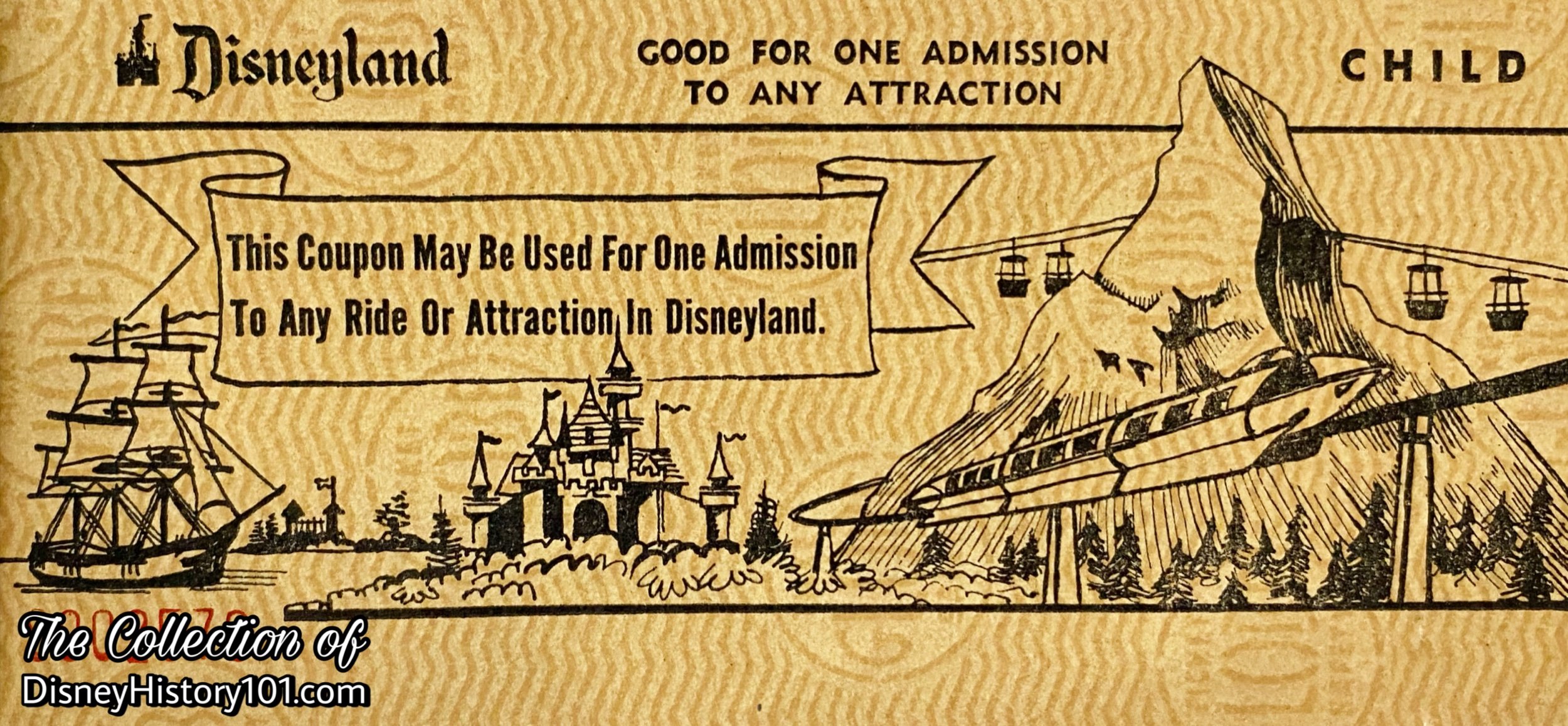
“Good for One Admission to Any Attraction” Media Coupon featuring the Monorail train.
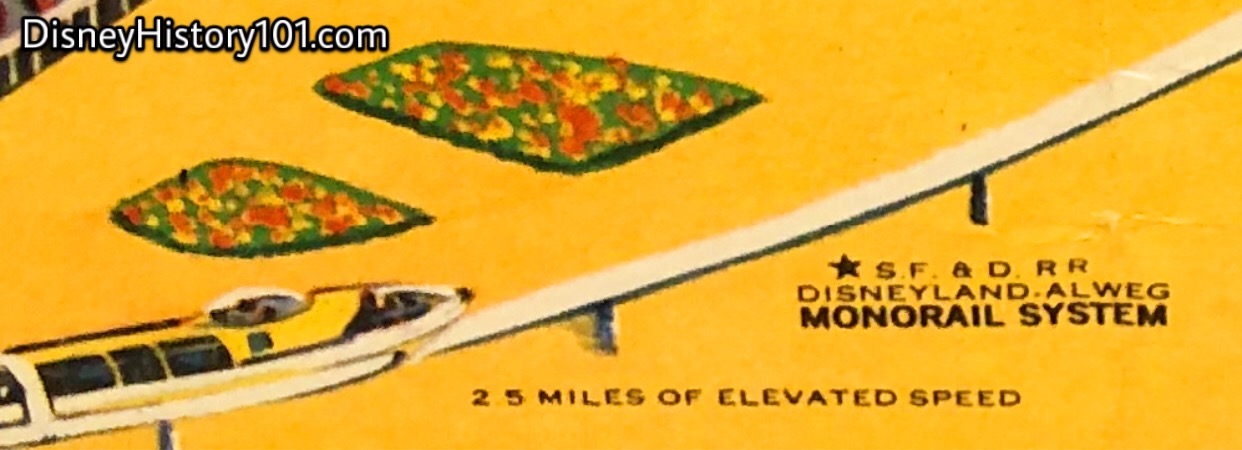
Disneyland-ALWEG Monorail Mark I Yellow and Monorail extension in a c.1961 Map Excerpt.
By 1960, the exciting, two-hour Guided Tour of Disneyland Tour included a ride on the Disneyland-Alweg Monorail.
Then on April 10, 1960, the Monorail was shut down to add an extension of track to the Disneyland Hotel. “Construction of the additional mile and three quarters of elevated beamway started in March and was completed in late May” of 1961, according to Vacationland, (Summer, 1961). The track length went from 0.8 miles to 2.5 miles, as advertised on this Disneyland map from 1961. The publication continues : “Cost of the extension which required 118,000 man hours of work, 66,700 sacks of cement, 10,760 tons of sand and gravel plus 702 tons of reinforcing steel, amounted to $1,900,000. To tap combined investment in both the original line and the extension is $3,200,000.00.” The expense was shared between Jack Wrather and Walt Disney.

Monorail Mark II Patent Drawing Facsimile signed by Bob Gurr.
Though the Monorail Mark Is were still new, plans were already in the works for a Monorail Mark II model. Though capable of 80 miles per hour (on long straight sections), these new aluminum lightweight air-frame designs will traverse the one-half mile circuit at a maximum operating speed of 45 miles an hour! The “Bogie” carriages (underneath the train) and some of their six pneumatic rubber-tired wheels can clearly be seen on this drawing.
Vacationland (Summer, 1961) elaborates on the workings of the Monorail Mark I trains : “‘Drive wheels’ roll on top of the beam and are about the same size as those used on a Ford or Chevrolet. Rolling on either side of the beam are two smaller wheels which guide and balance the train. The upper wheels press against the top ridge or ‘flange’ of the beam and the lower wheels press against the bottom flange. Powerful springs keep them in tight contact with the beam. The trains are electronically powered and each has six, 35 horsepower motors. Three hundred volts of electricity is transmitted along the two rails, known as ‘bus bars’, located along one side of the beam. Power is picked up by brushes on the bogies. The trains are constructed of aluminum and utilize light-weight air frame design. The trains and supporting structures are of essentially the same size as those that would be used as a metropolitan transit system. However, because Disneyland-Alweg cars have no provisions for standees or baggage storage they are slightly smaller than those that would be used in such a system. The Disneyland-Alweg trains are capable of speeds in excess of 80 miles per hour but will traverse the two and one-half mile loop line at a maximum of 45 miles per hour.”
If you’ve ever wondered what those “bogies” (with its rubber tired wheels) looks like, excerpts of a vintage 1961 publication (below) give us a rare glimpse. You may recall that the Monorail trains had four bogies - the non-motorized No.1 and No.4 (one at the front and one at the rear of the train), and the motorized No.2 and No.3 (one between car 1 and car 2, and the other between car 3 and car 4). The motorized bogies (No.2 and No.3) were powered by two 55 HP, 300 volt D.C. traction motors mounted on each side, driving two 32” wheels. A rare view of these wheels can also be seen in Walt Disney’s Railroad Story by Roger Broggie, page 304.
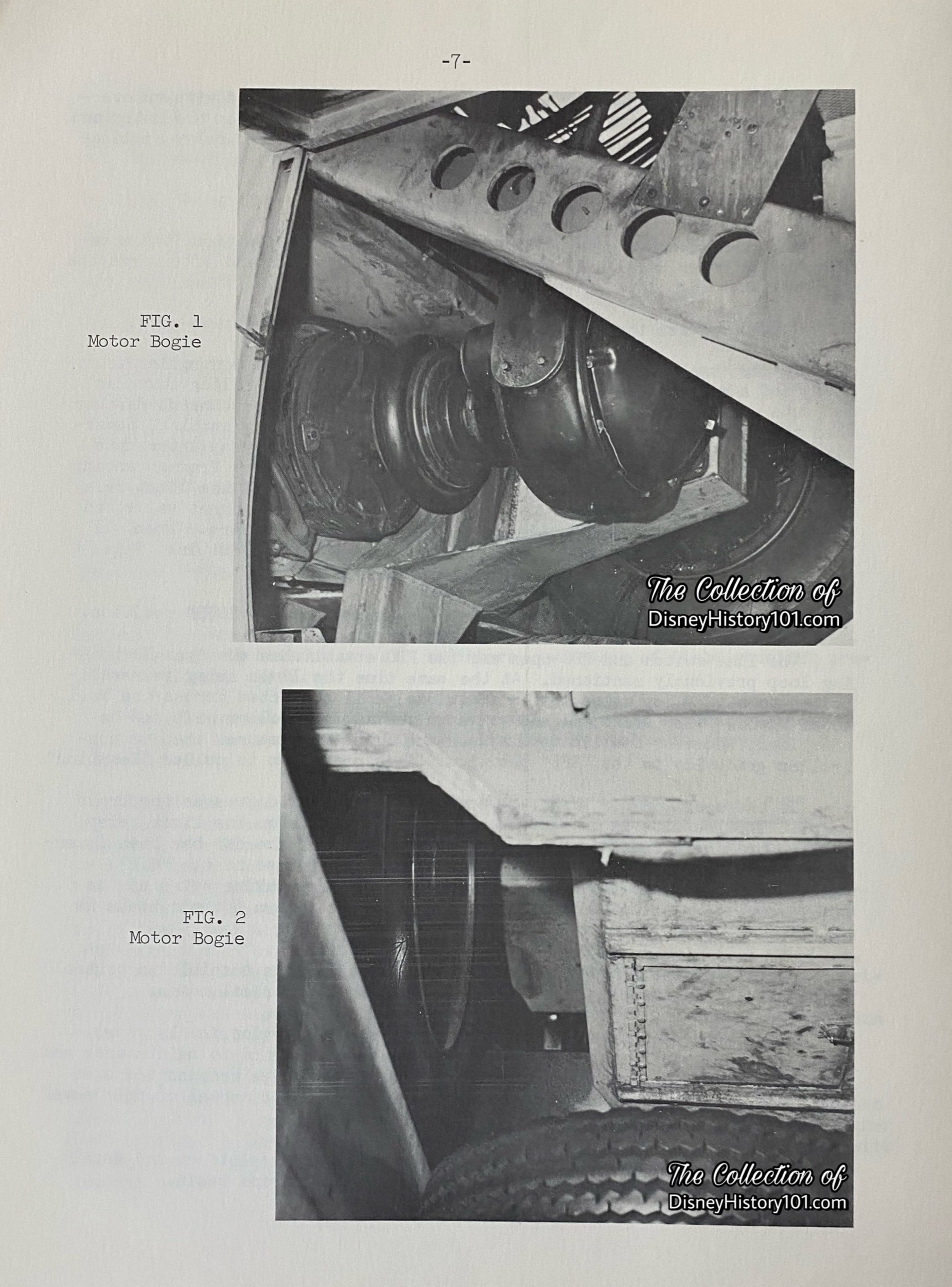
Electrical Control Equipment for Disneyland Monorail Trains, 1961.
Bogeys are four-wheeled trucks and the lead trucks on Santa Fe & Disneyland Railroad locomotives. The Monorail trains also have bogeys and bogie units. Bogie Units are the complete drive assembly that straddles the beam in such a way that the drive and supporting wheels run on the top surface of the beamway, and the guiding and stabilizing wheels contact both lateral surfaces of the beam.
According to Vacationland (Summer, 1961) : “The trains ride on ‘carriages’ known as ‘Bogies’, and each has six pneumatic, rubber-tired wheels. The drive wheels roll on top of the beam and are about the same size as those used on a Ford or Chevrolet. Rolling on either side of the beam are two smaller wheels which guide and balance the train. The upper wheels press against the top ridge or ‘flange’ of the beam and the lower wheels press against the bottom flange. Powerful springs keep them in tight contact with the beam.” This Operating Guide/OG gives reader a few rare views a Motor Bogie “Drive Wheel” in the Monorail undercarriage. The wheels of the bogie can be seen in Figure 2 (above).
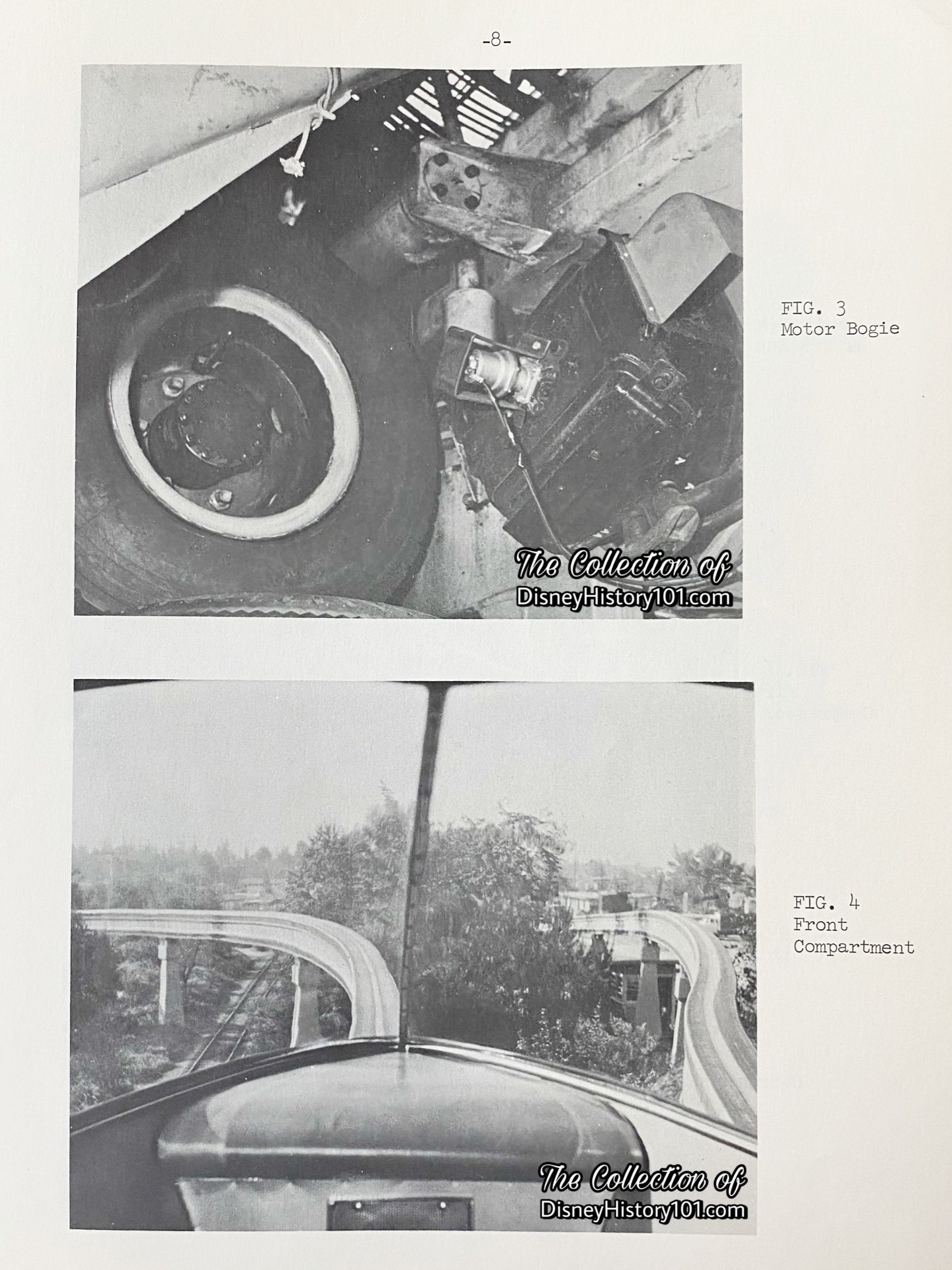
Electrical Control Equipment for Disneyland Monorail Trains, 1961.
The drive gear of the bogie can be seen in Figure 3 (above). The enclosed areas within the transparent bubbles of the dome compartment (Figure 4, above) had the potential to get quite warm, so they were ventilated and cooled with the help of an air conditioning unit (Figure 5, below). Air brakes and pneumatic air controls functioned with the help of a constant-running air compressor (Figure 6, below) power by a 3Hp motor. That motor also drove a 60 ampere, 14 volt alternator that charged the 12-volt batteries that supplied power to the lights and the blowers. In the event of a power failure, air circulation was assured thanks to those charged batteries and the air conditioner blowers that they powered.
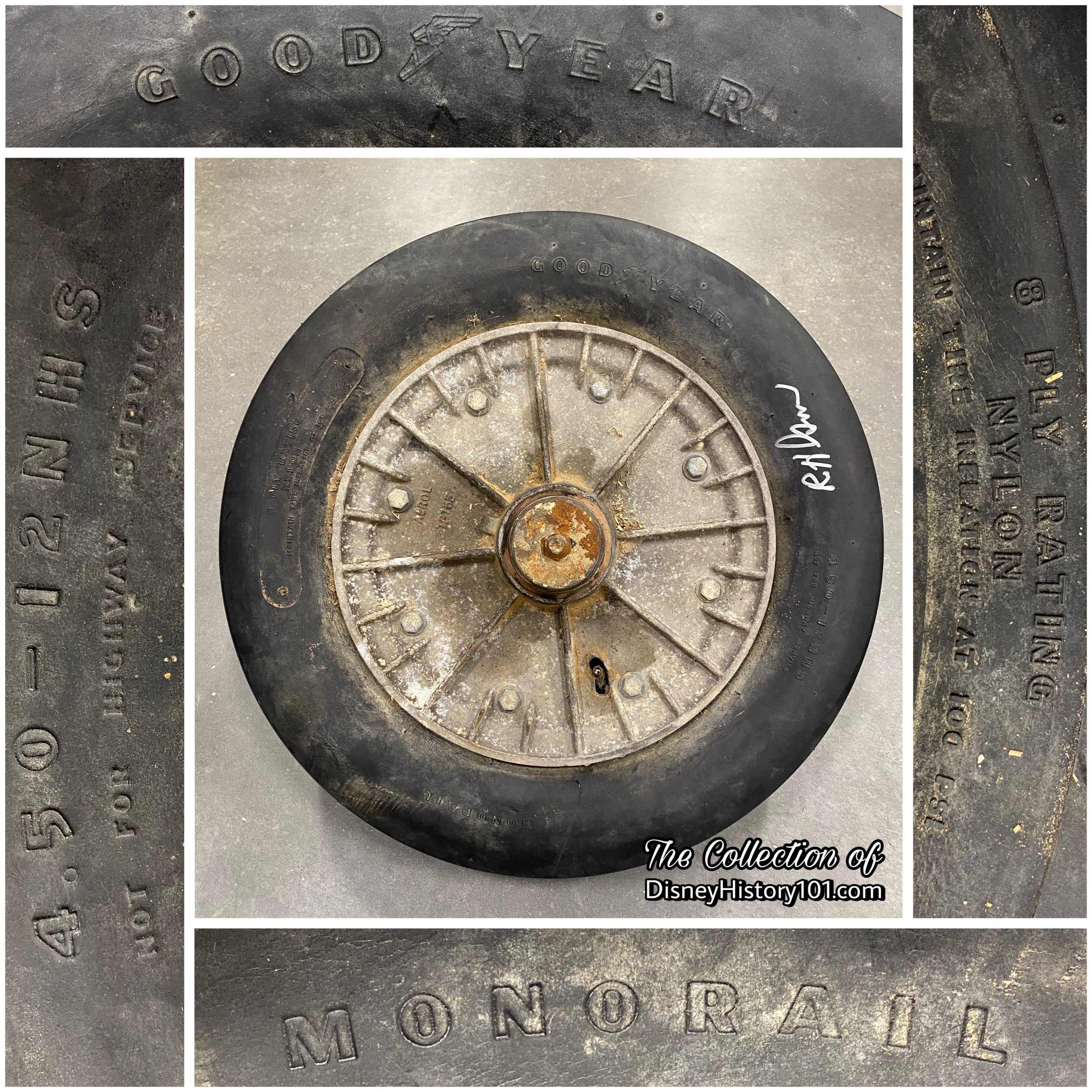

Electrical Control Equipment for Disneyland Monorail Trains, 1961.
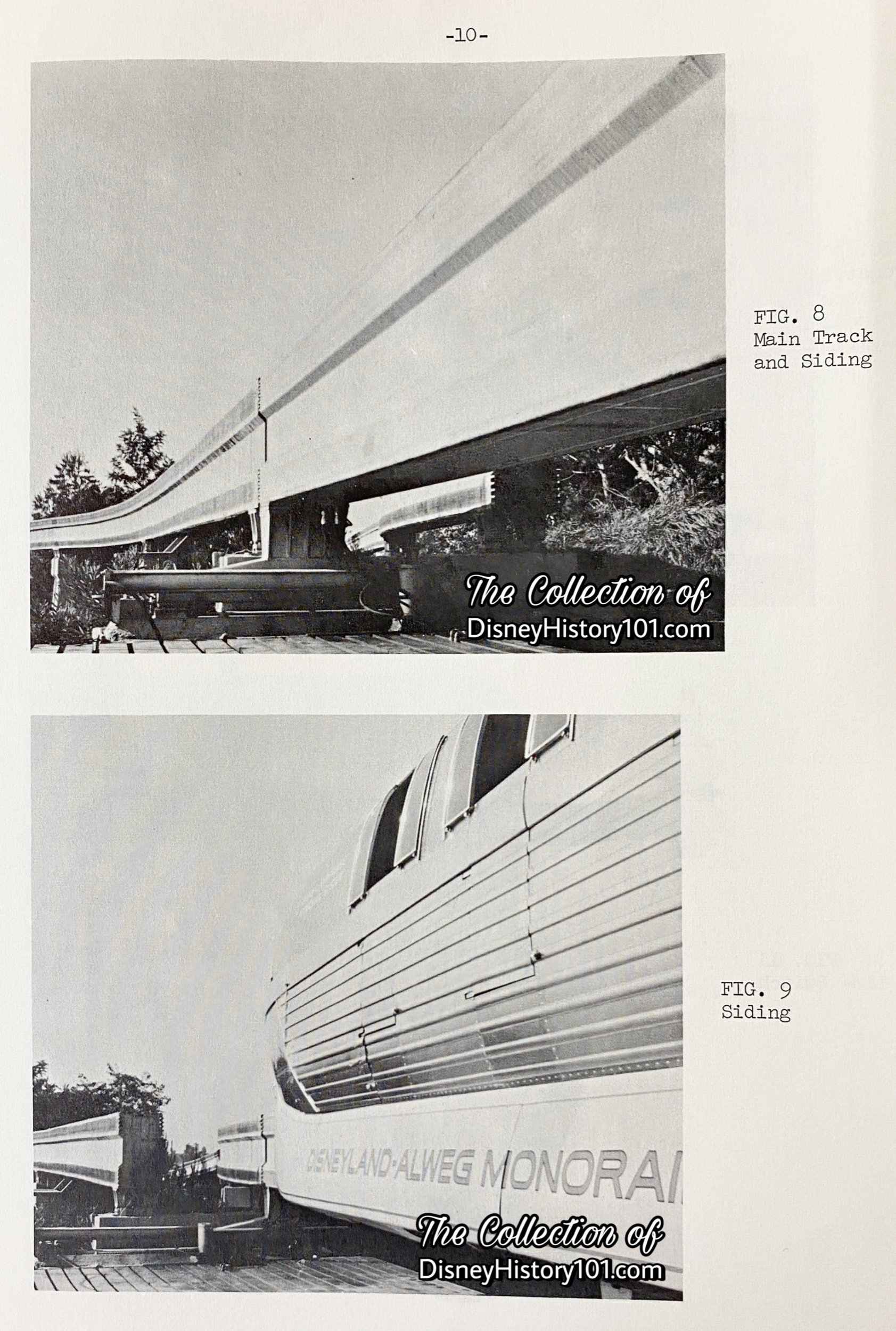
Electrical Control Equipment for Disneyland Monorail Trains, 1961.
The Monorail Beamway consists of a Main Track (Figure 8) and a “siding” (Figure 9) which runs to the Monorail Train Shed. Located behind Tomorrowland, the Beam Switch was 75-feet long, could pivot at one end while the other end could swing at a distance of 5.5 feet to meet with either the Main Track or the “Siding.” This moveable section of Beamway was supported by “rollers” every 25 feet, powered by an electric hydraulic switch, and had “locking pins” to assure that the Beamway was “locked” in its proper and safe positions before the trolley could be energized. Once this section of moveable Beamway was assuredly in place, the Monorail trains could be switched from the main line to the “Roundhouse spur.”
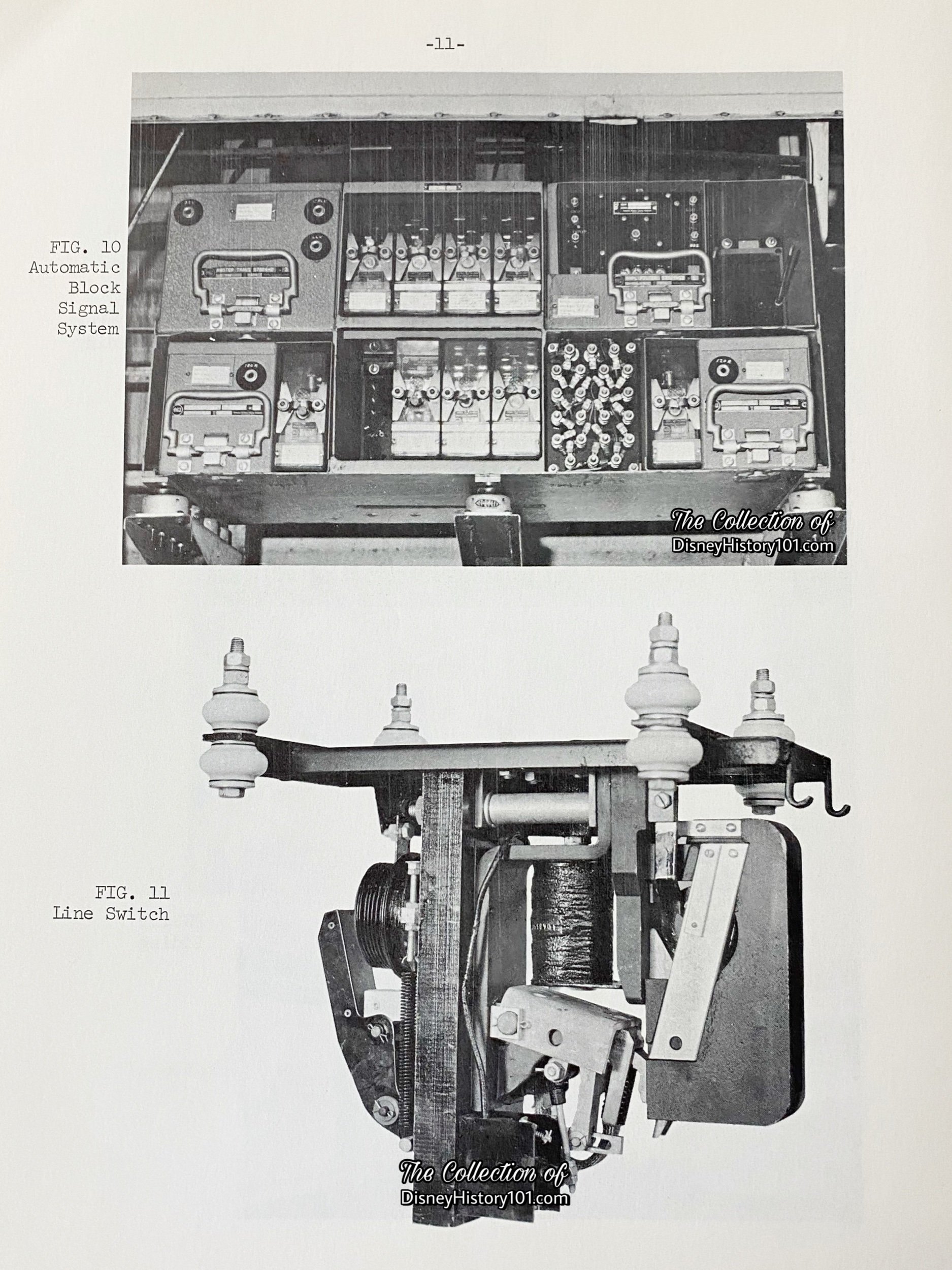
Electrical Control Equipment for Disneyland Monorail Trains, 1961.
The Automatic Block Signal System (Figure 10) provides cab signals and automatic stop facilities to the trains. Signal information is carried by means of a pulsating current transmitted by a single No.10 wire installed along the beam.
An overload relay (seen in Figure 11) cares for overloads.
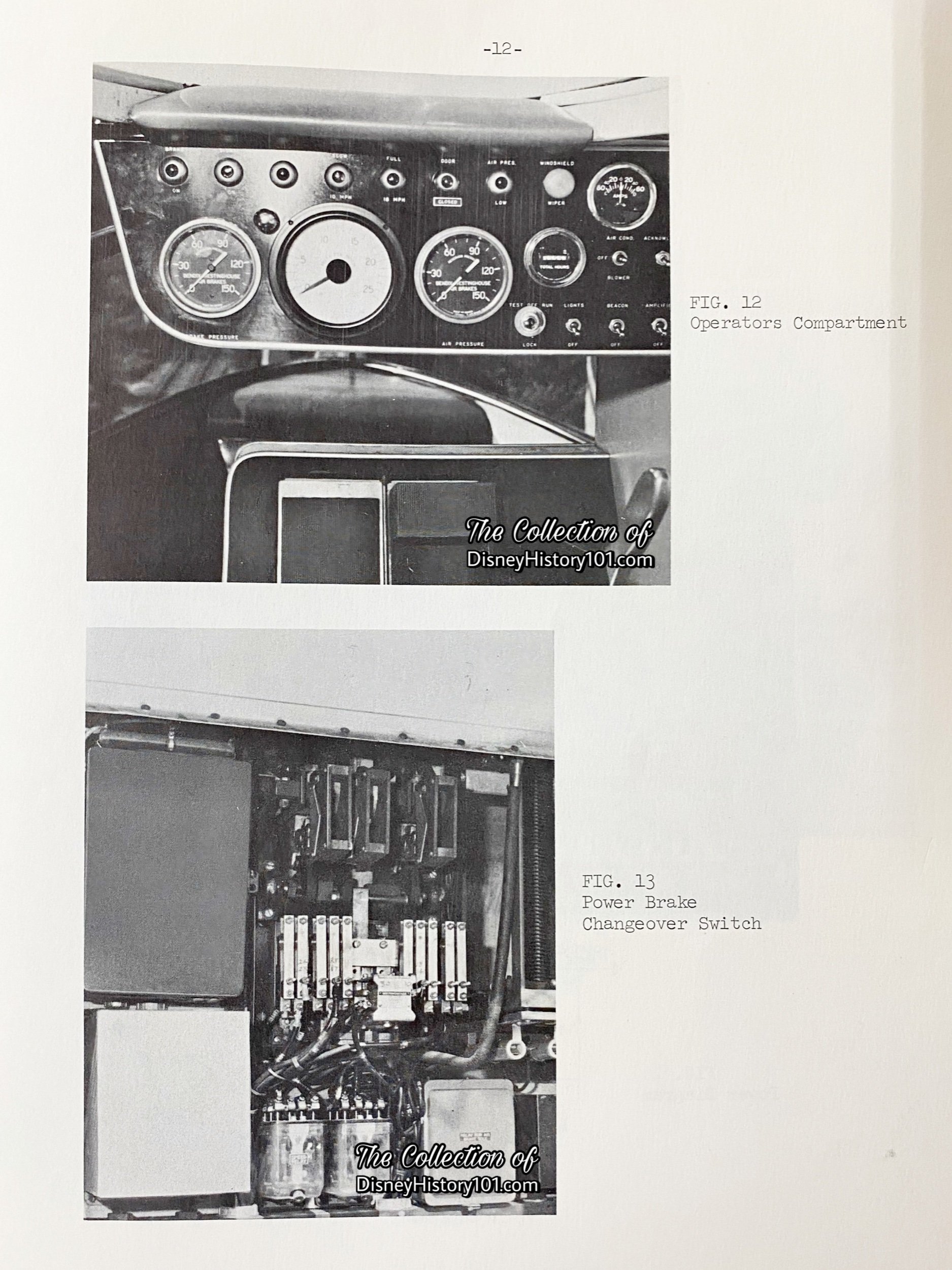
Electrical Control Equipment for Disneyland Monorail Trains, 1961.
Let’s take a look in the Driver’s Station. At this time, the trains are operated by a power pedal (connecting four motors across the line), a brake pedal, and a “reverser” handle (seen in Figure 12). Many years later (by the 1980s) the power pedal had been replaced with a power lever.
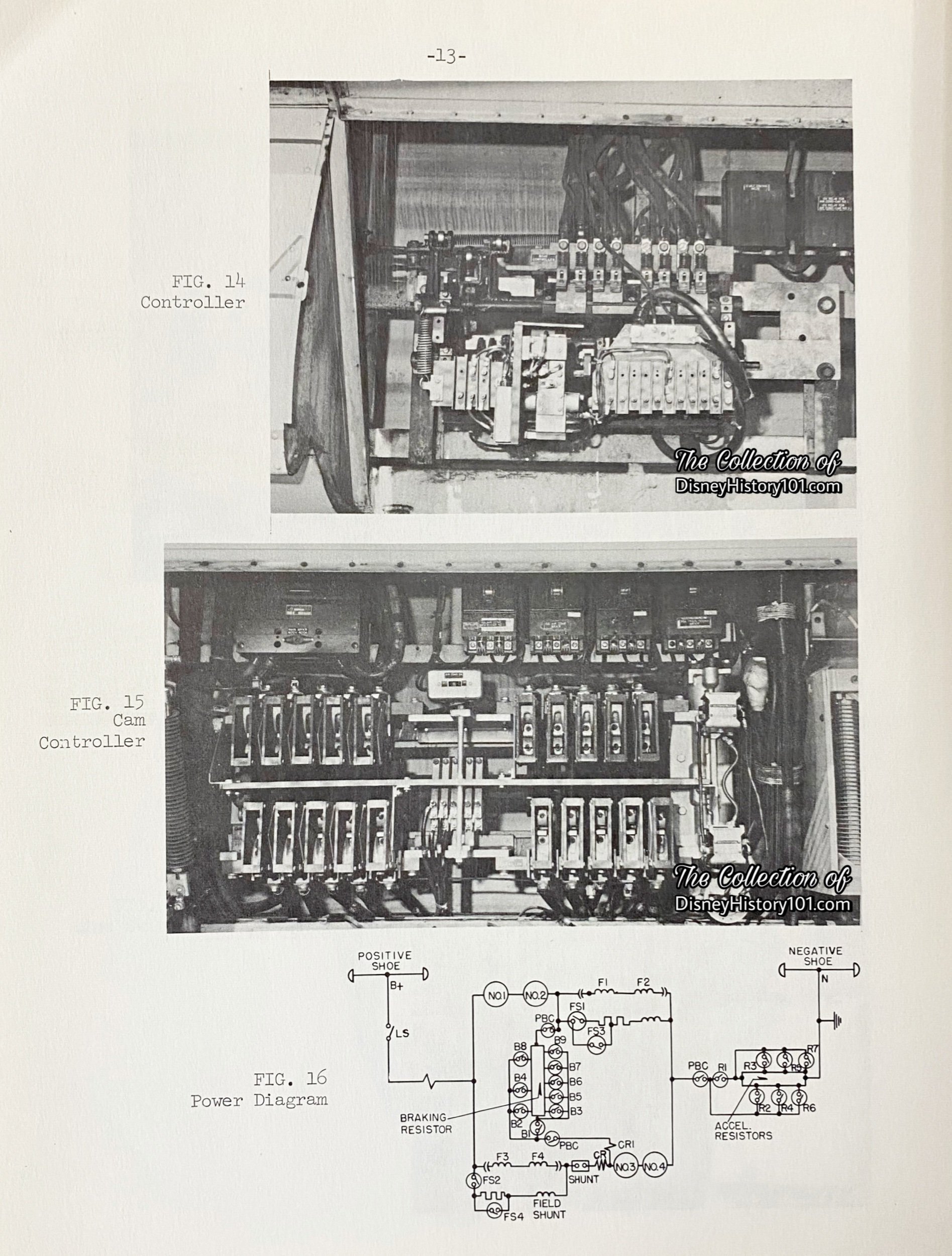
Electrical Control Equipment for Disneyland Monorail Trains, 1961.

During 1961, Eleanor Heldt (Magic Kingdom Club Administrator) commented that “During a major rehabilitation, it is sometimes necessary to close an attraction for several weeks. This, of course, is when the smallest details were checked, replaced or repaired as required for the maximum safety, convenience, and comfort for our guests.” That being said, what came next for the Disneyland ALWEG Monorail system was no mere “major rehabilitation.”
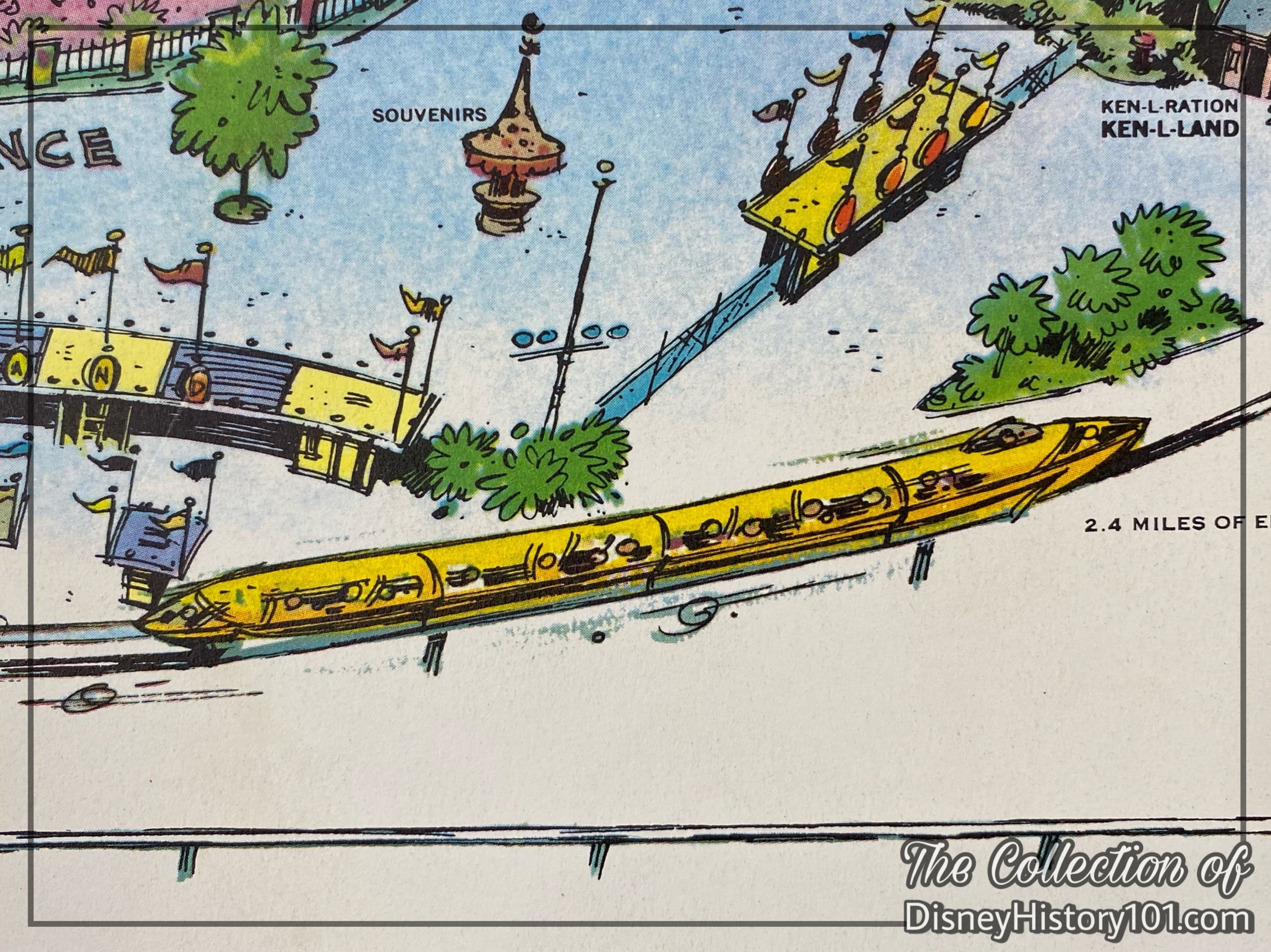
A 1961 Disneyland Map excerpt depicting the Monorail Mark II Yellow.
Construction of completely-new Mark II train sets were underway at the Walt Disney Studios.
According to Michael Broggie, construction of the ergonomically tubular outer frame was comparable to that of aircraft. Bob Gurr designed a new Monorail Mark II Yellow (or, “Gold”) train with the safety feature of a “drop-down” door on the nose cone, and an efficient additional coach. The extra coach was also added to both the blue and red Monorail Mark I nose and tail sections (to increase guest capacity of the attraction by 22%). Now each original MonorailMark I train would be comprised of four cars with a total 106-Guest capacity. Theoretical hourly capacity increased to 1,200 passengers, and trips per hour increased to 19.5. “Since 1959, more than 3,000,000 people have ridden the glistening monorail trains that soar over the magic kingdom,” according to Vacationland magazine, published for the summer, 1961. By another figure acquired during the summer of 1961, the Monorail had travelled 60,000 miles, carried 4,370,000 passengers, and was apparently a “much talked about mass transit concept,” according to the aforementioned Vacationland magazine. The Alweg-Disneyland Monorail would join the outstanding features (like the Main Street Railroad Station, Matterhorn Mountain, and Sleeping Beauty Castle) which would stand out against the new Disneyland skyline, during June of 1961!

Tomorrowland Monorail Station to Disneyland Hotel Ticket.
This was more than a major rehabilitation - it was a revolutionary and practical use of urban transportation, and it was progress! Things would continue to move forward in 1961, as the Monorail track was extended over Disneyland’s 18-foot-tall earthen wall, almost 2 1/2 miles (12,300 feet) - all the way alongside Harbor Boulevard (and over West Street), to the 112 foot-long Disneyland Hotel platform. The entire circuit’s trip time was increased to 9 minutes and 20 seconds. The cost of the extension was $1,900,000 (in addition to 118,000 man hours of work, 66,700 sacks of cement, 10,760 tons of sand and gravel, and 702 tons of reinforcing steel). The total combined investment in both the original line and the extension is $3,200,000 (contributing to the Park’s total investment of $37 million).
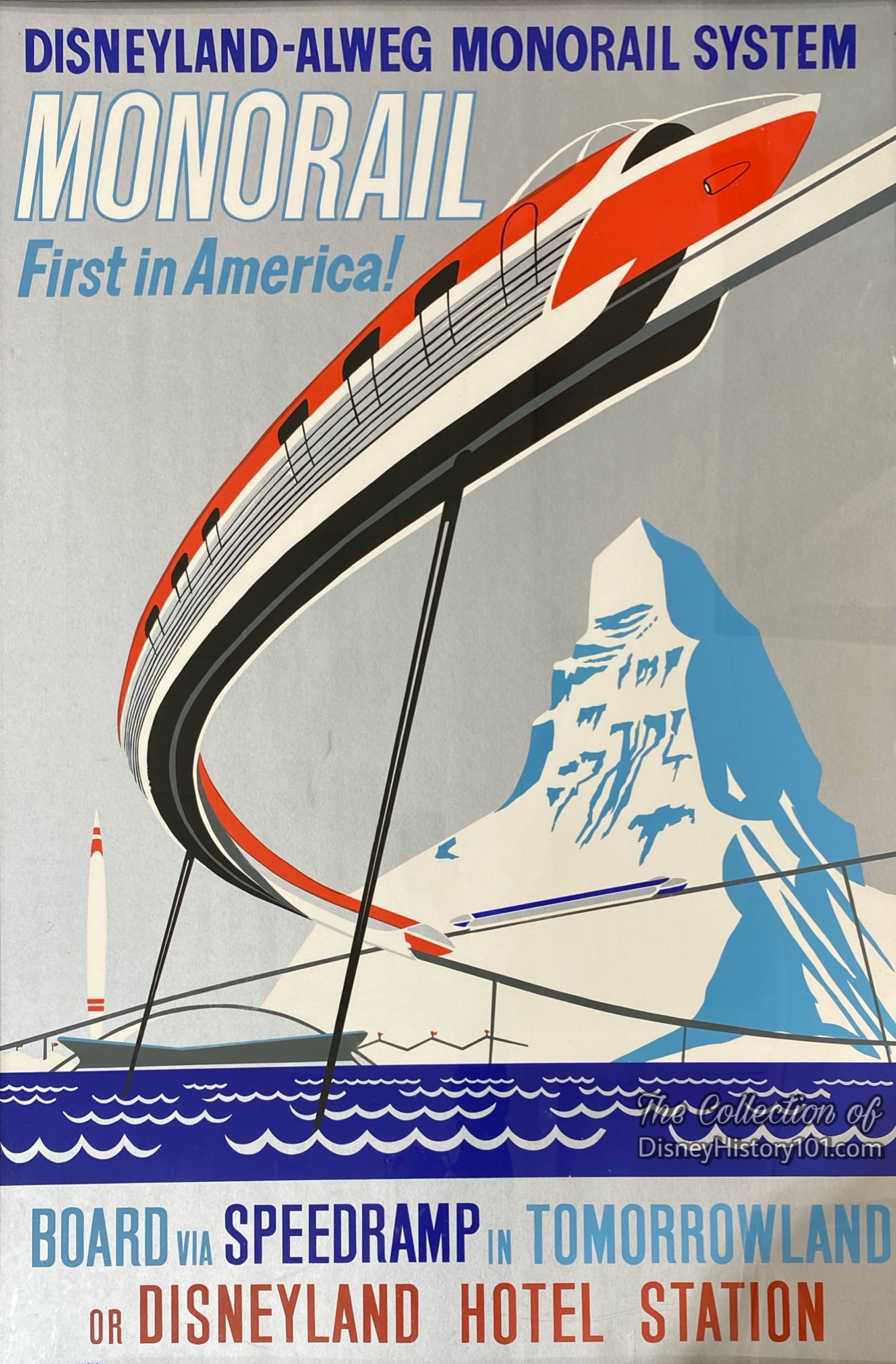
Disneyland-ALWEG Monorail poster by Paul Hartley.
All art work, posters, etc. were created by the Walt Disney Studios. Upon entering Disneyland, 1961 audiences would have spotted Paul “Coke” Hartley’s dynamic attraction poster design boasting the “Disneyland-ALWEG Monorail System” - the “first in America!” The poster would have further directed them to “board via Speedramp in Tomorrowland,” with a stop at the “Disneyland Hotel Station.” As a sidelight, this poster has been attributed in some way to John Hench in “Walt Disney’s Railroad Story” by Michael Broggie.
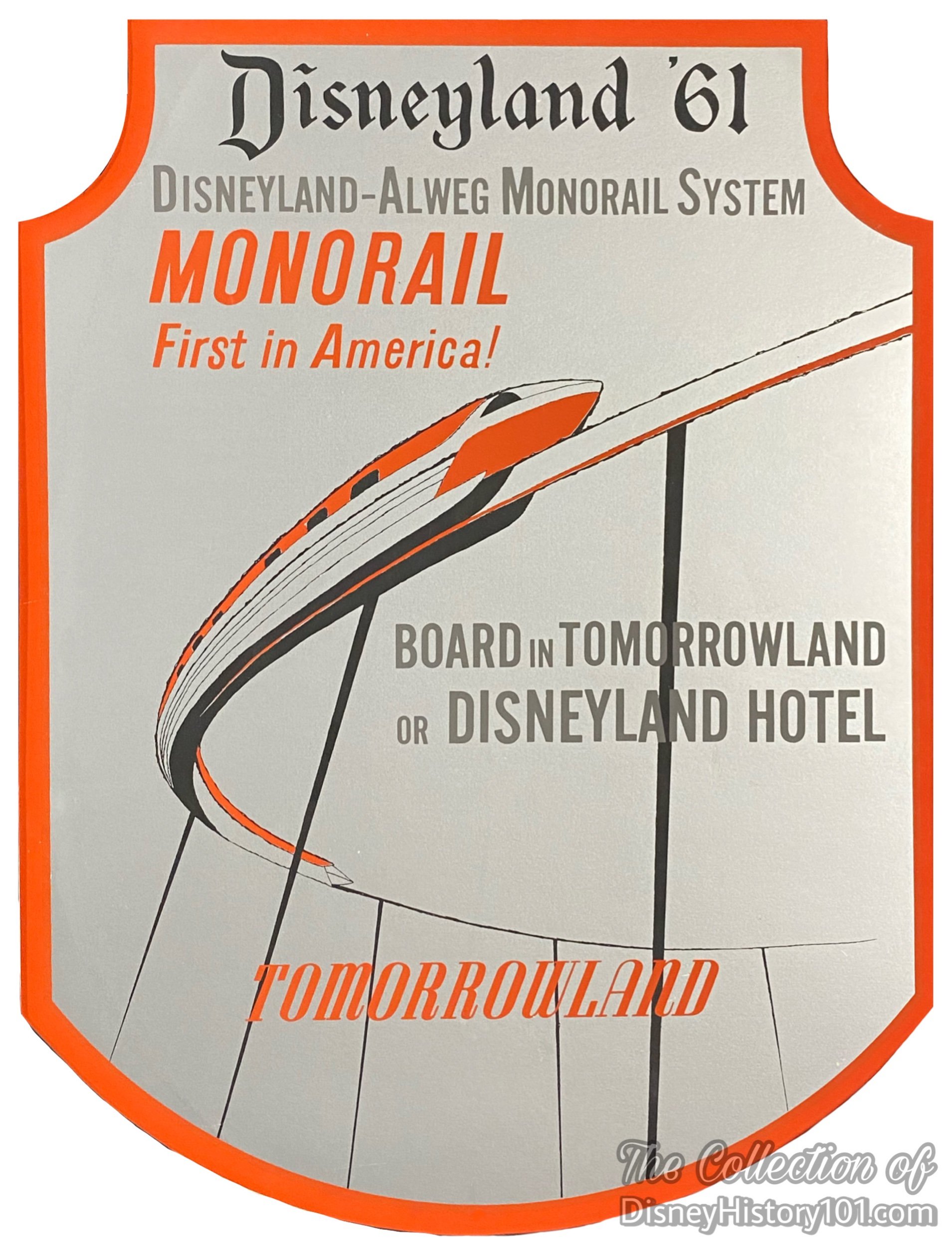
The posters and signs gave top billing to Disneyland, followed by ALWEG (an acronym of Swedish entrepreneur Dr. Axel Lennert WEnner Gren’s name). Incidentally, Axel passed November 24, 1961, the very user that the Disneyland-ALWEG Monorail line was extended to the Disneyland Hotel.

A Disneyland Hotel matchbook featuring the Monorail Mark II.
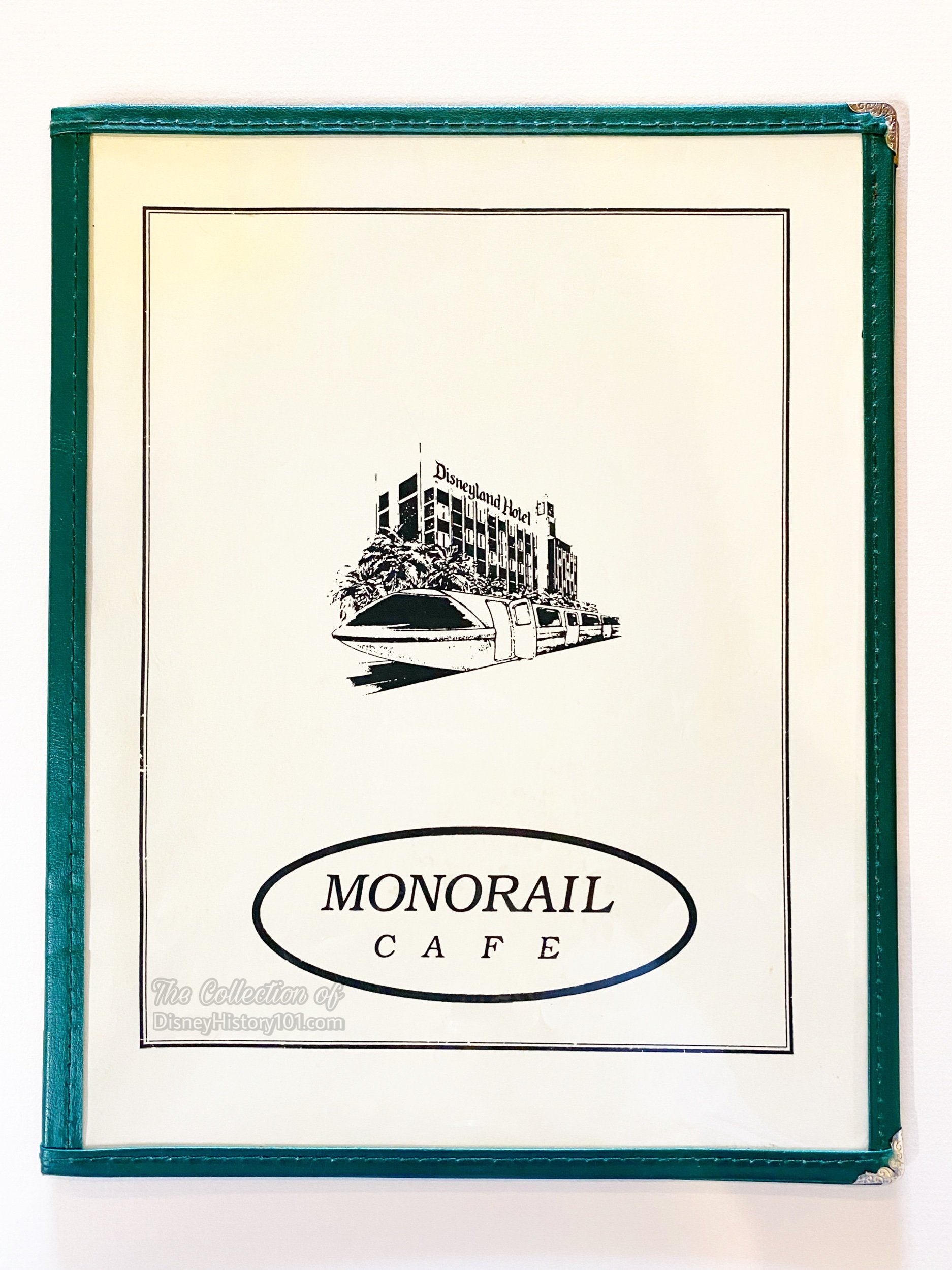
Monorail Cafe Menu Cover.
Once arrived at the new $100,000 Hotel Station, guests are greeted by a tiny bar, in the Monorail Plaza just south of the Monorail Station. The interior featured a “replica of an early suspended monorail car (patented 1905)” and “walls…papered with patent applications and specification sheets for dozens of others monorail designs.” Amidst those settings, guests enjoyed a relaxing early-morning breakfast, light lunch, full-course dinner or between-meals snacks. You may especially recall those great, thick, ice cream shakes and sundaes.

A Disneyland Hotel Gourmet Restaurants matchbook featuring the Monorail Mark II.

A "Disneyland '61" Banner advertising the Disneyland-ALWEG Monorail System, (1961)
After a few months of connecting the new route to the Disneyland Hotel, the Monorail reopened in June 1st, 1961. Main Street U.S.A. got into the spirit of things with banners announcing the addition!
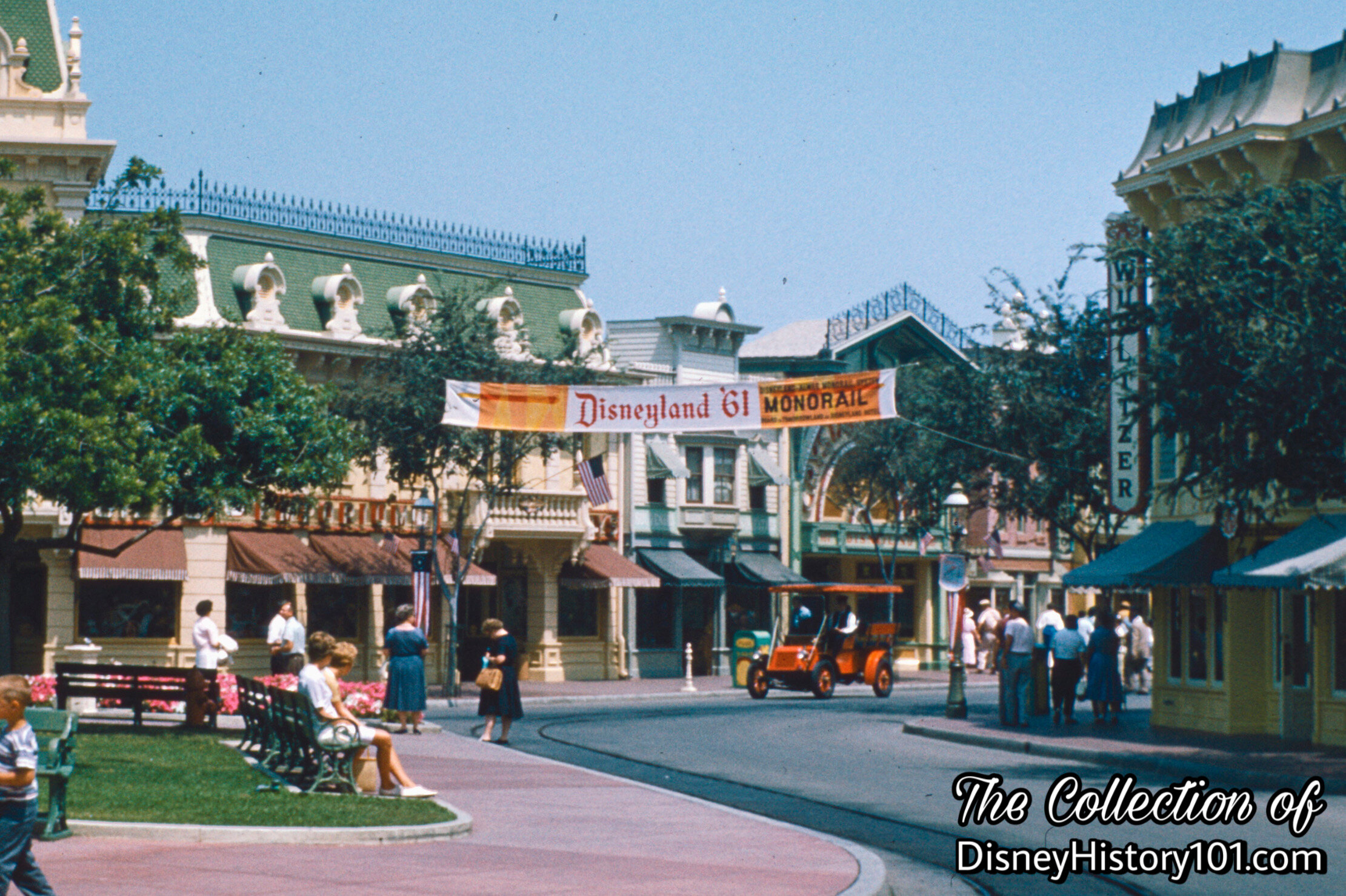
A "Disneyland '61" Banner advertising the Disneyland-ALWEG Monorail System, (1961)
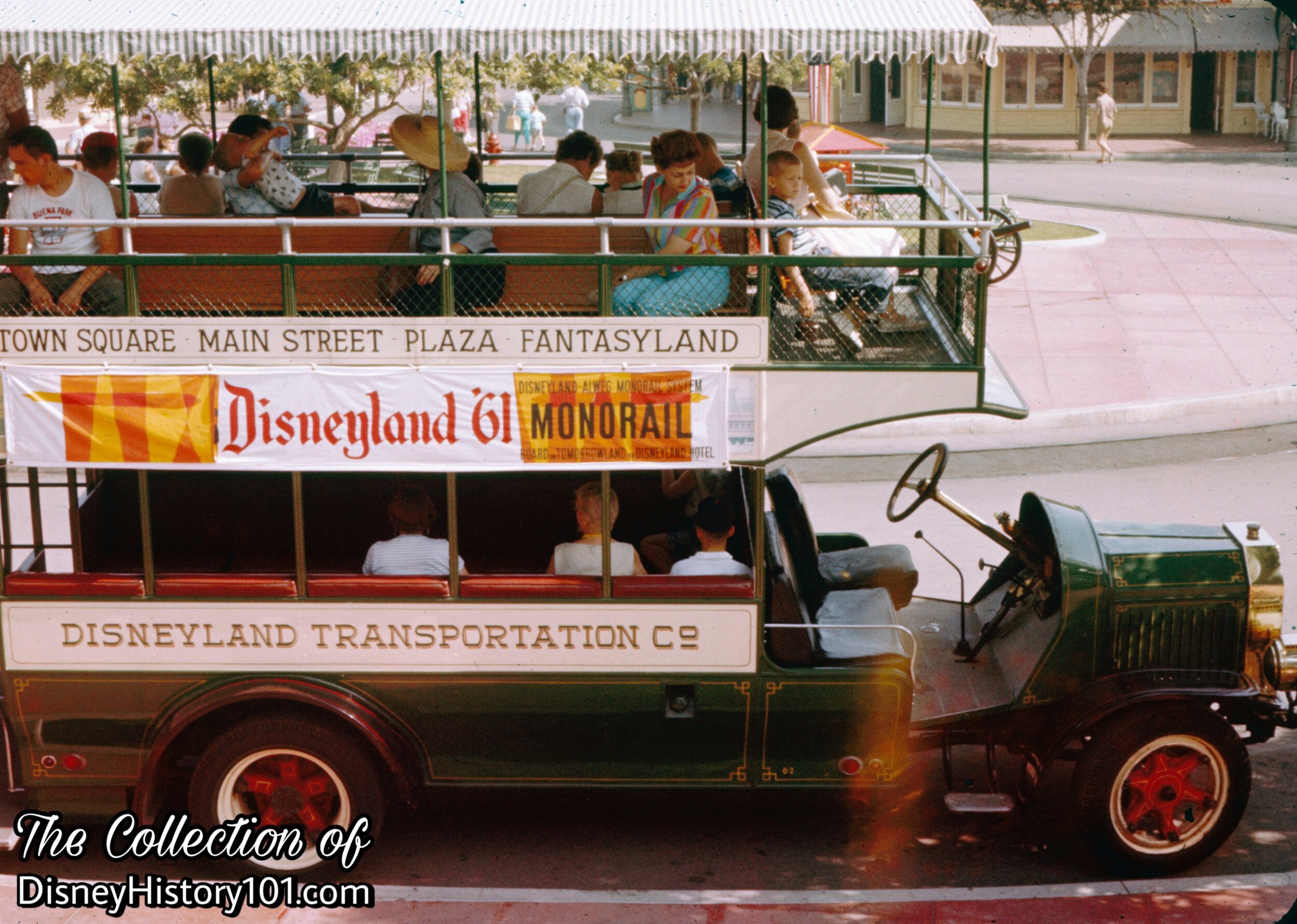
A "Disneyland '61" Banner on the Omnibus advertised the Disneyland-ALWEG Monorail System, (1961)
Main Street U.S.A. was always a place where older forms of transportation (like the horse drawn cars) operated side by side with the new. Now, the Omnibus would advertise the all new Monorail track system on its side!
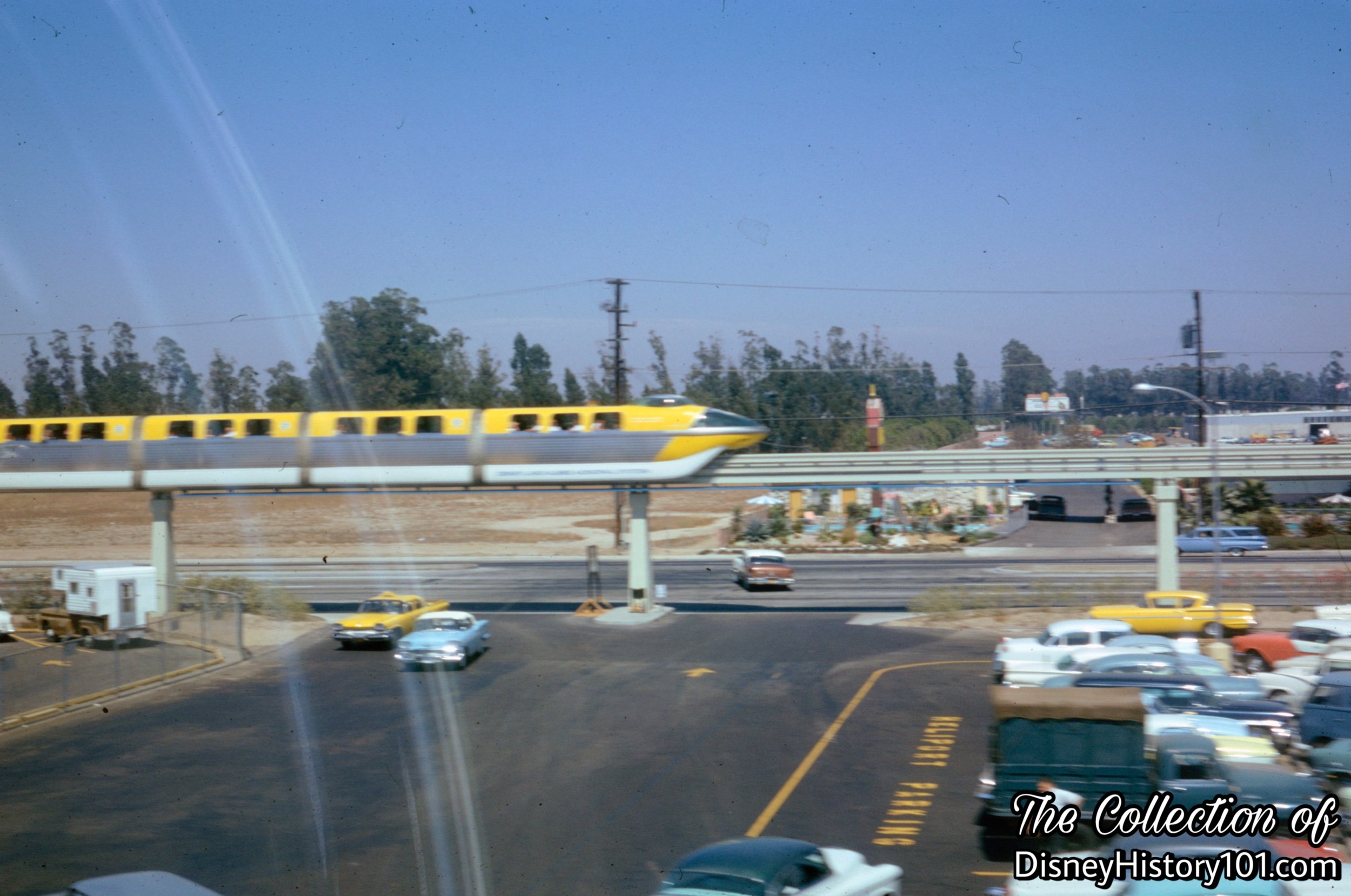
Heliport Parking Lot Area Entrance and the Monorail Mark II Yellow saddling the Beamway overhead, 1961.
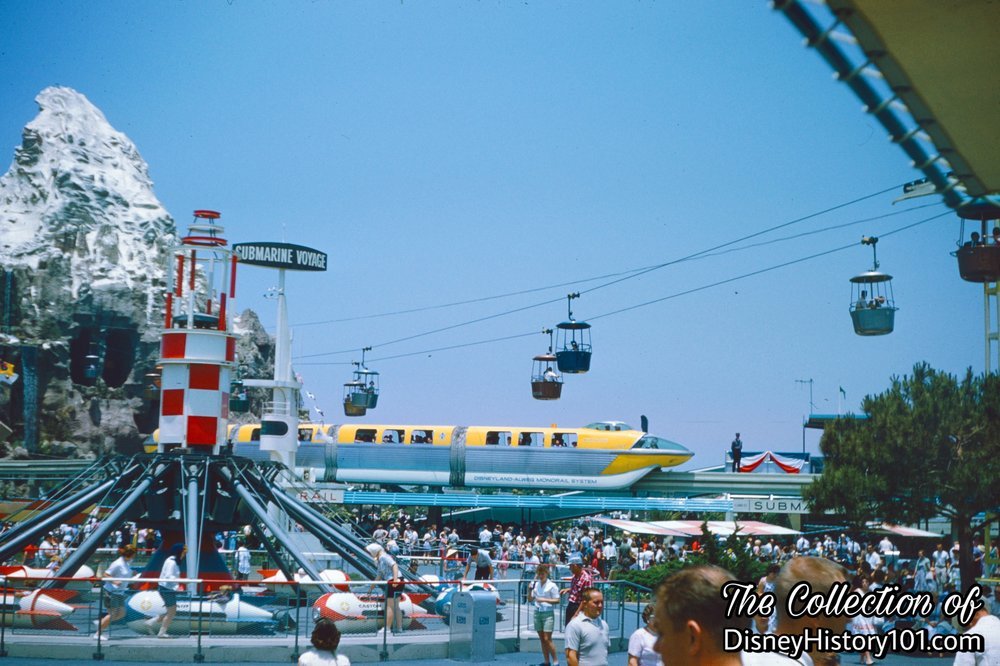
REENTERING THE PARK AND TOMORROWLAND SEGMENT

Guests near the Monorail sign during the Monorail Mark II era.
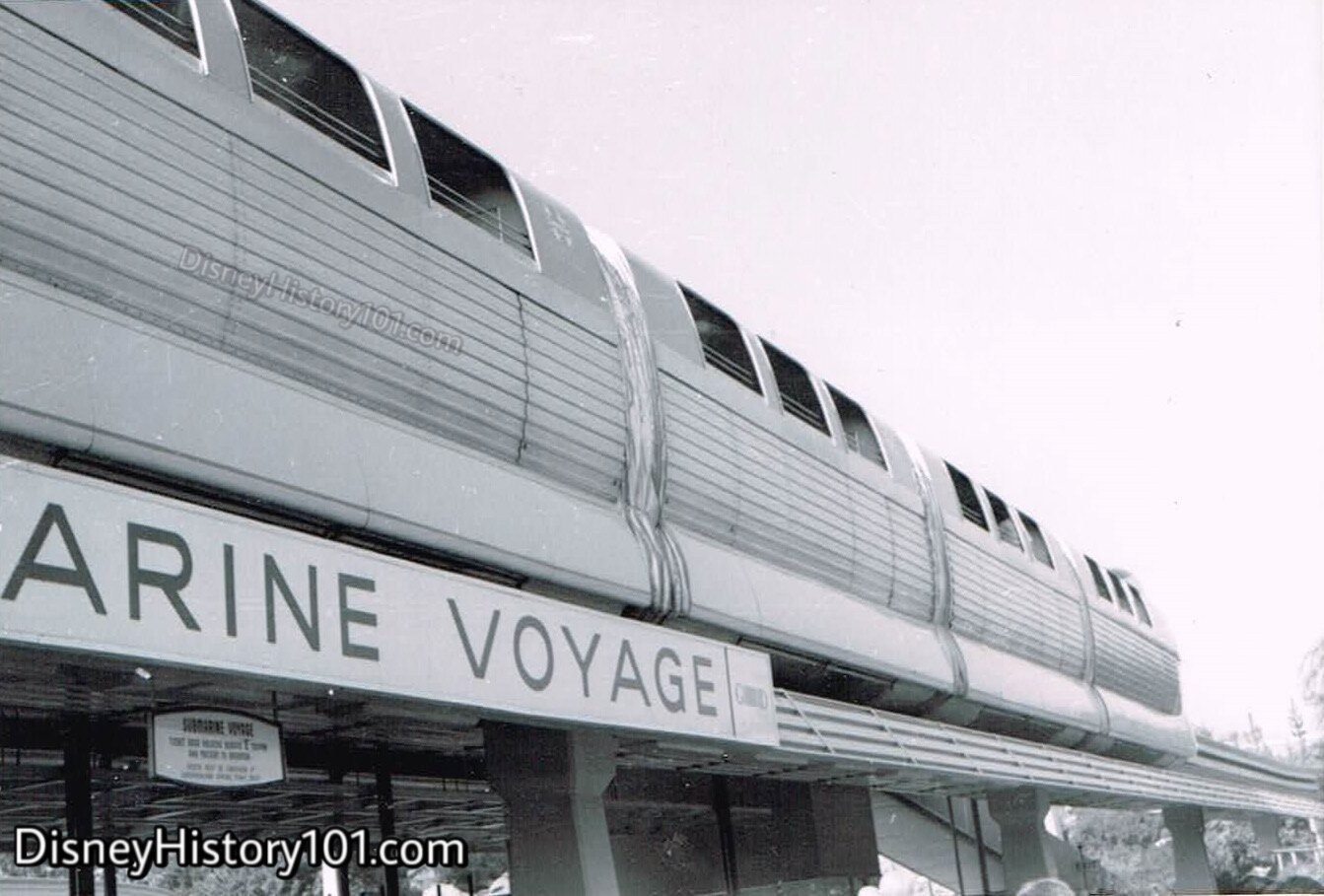
REENTERING THE PARK AND TOMORROWLAND SEGMENT - Monorail Mark II
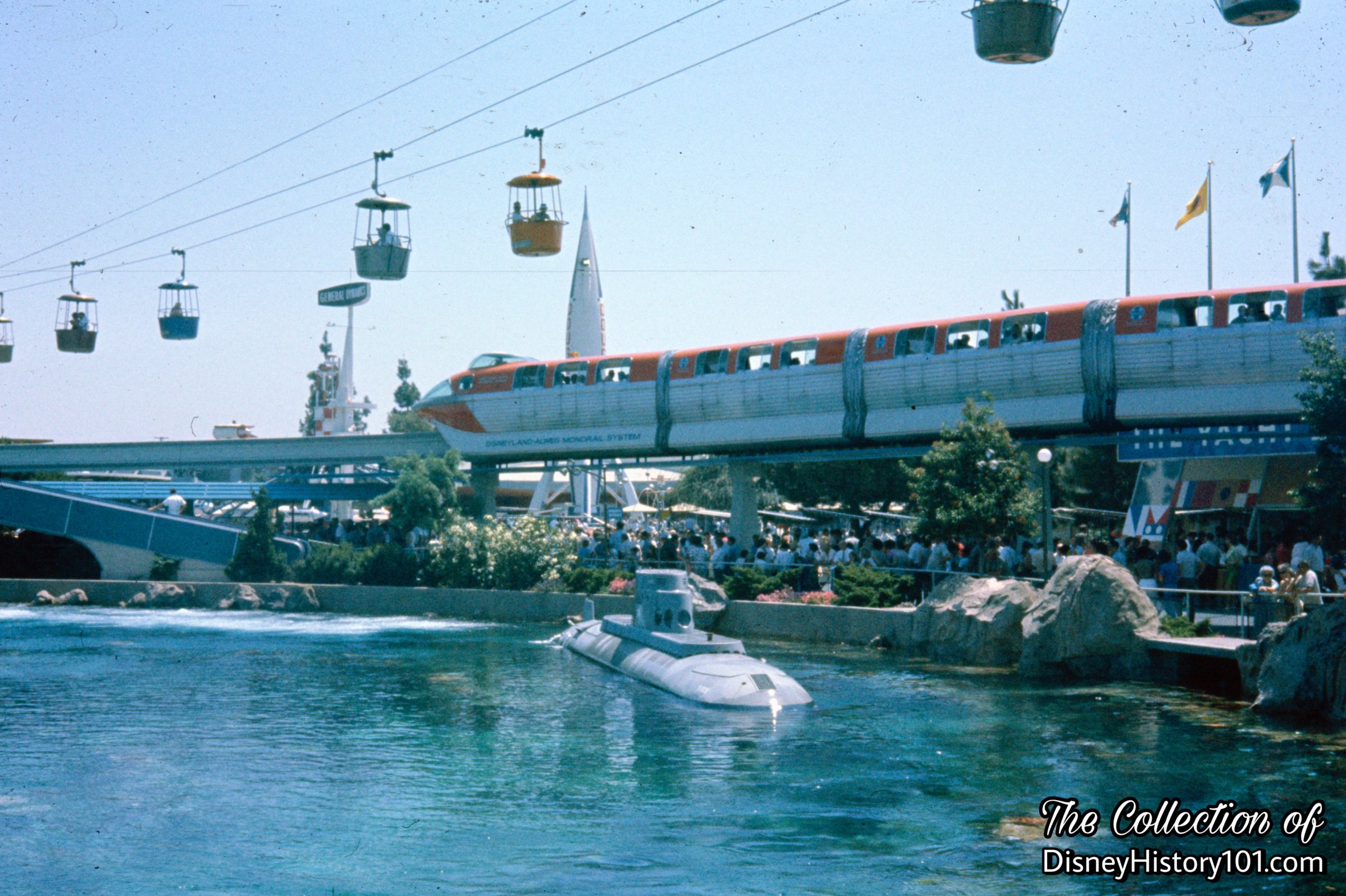
REENTERING THE PARK AND TOMORROWLAND SEGMENT - Monorail Mark II Red.

REENTERING THE PARK AND TOMORROWLAND SEGMENT - Monorail Mark II Blue, (October, 1961)
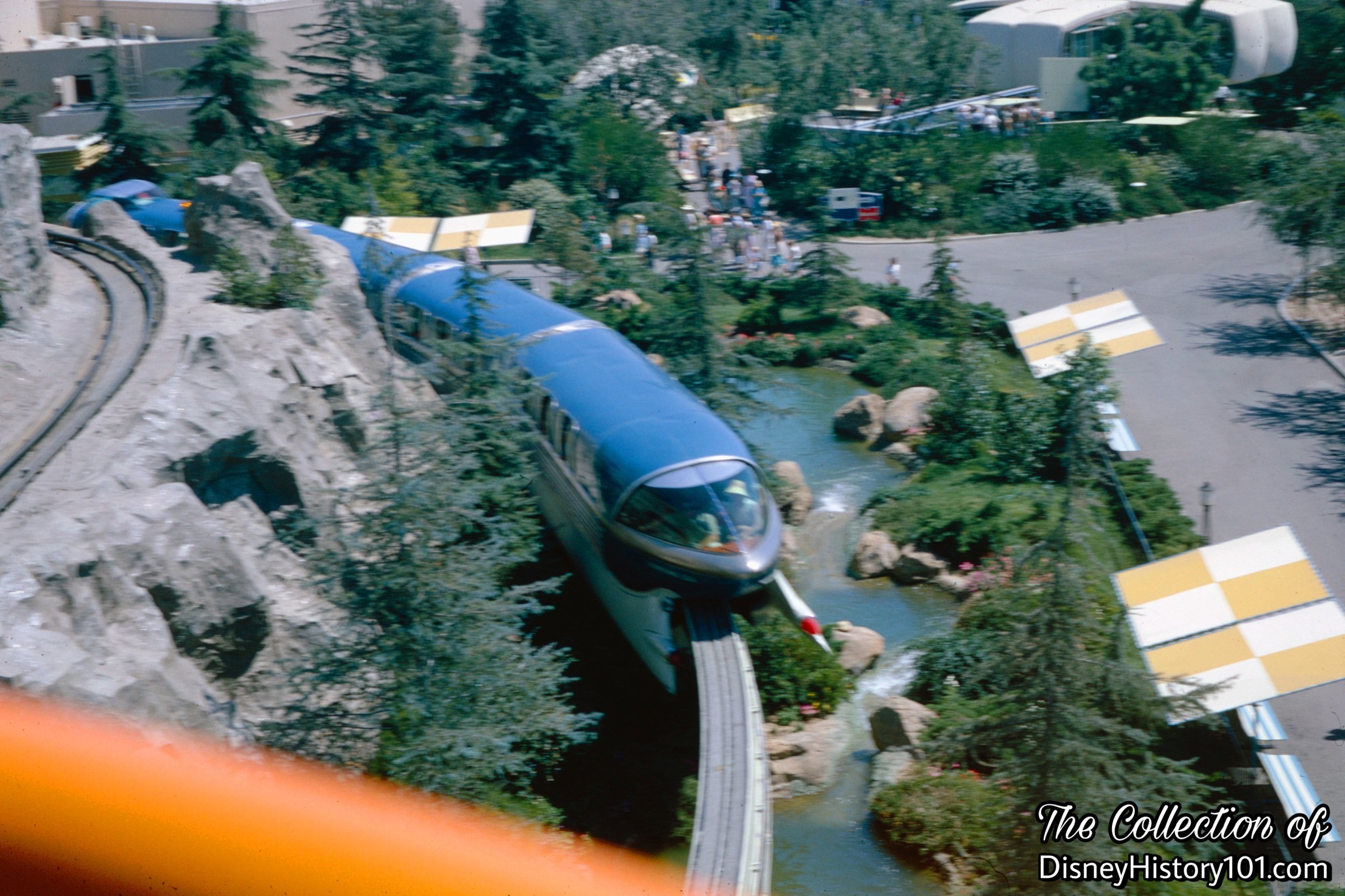
REENTERING THE PARK AND TOMORROWLAND SEGMENT - The Monorail Mark II Blue passes one of the lowest points of the Beamway.
Note there is no catwalk on top of the cars.
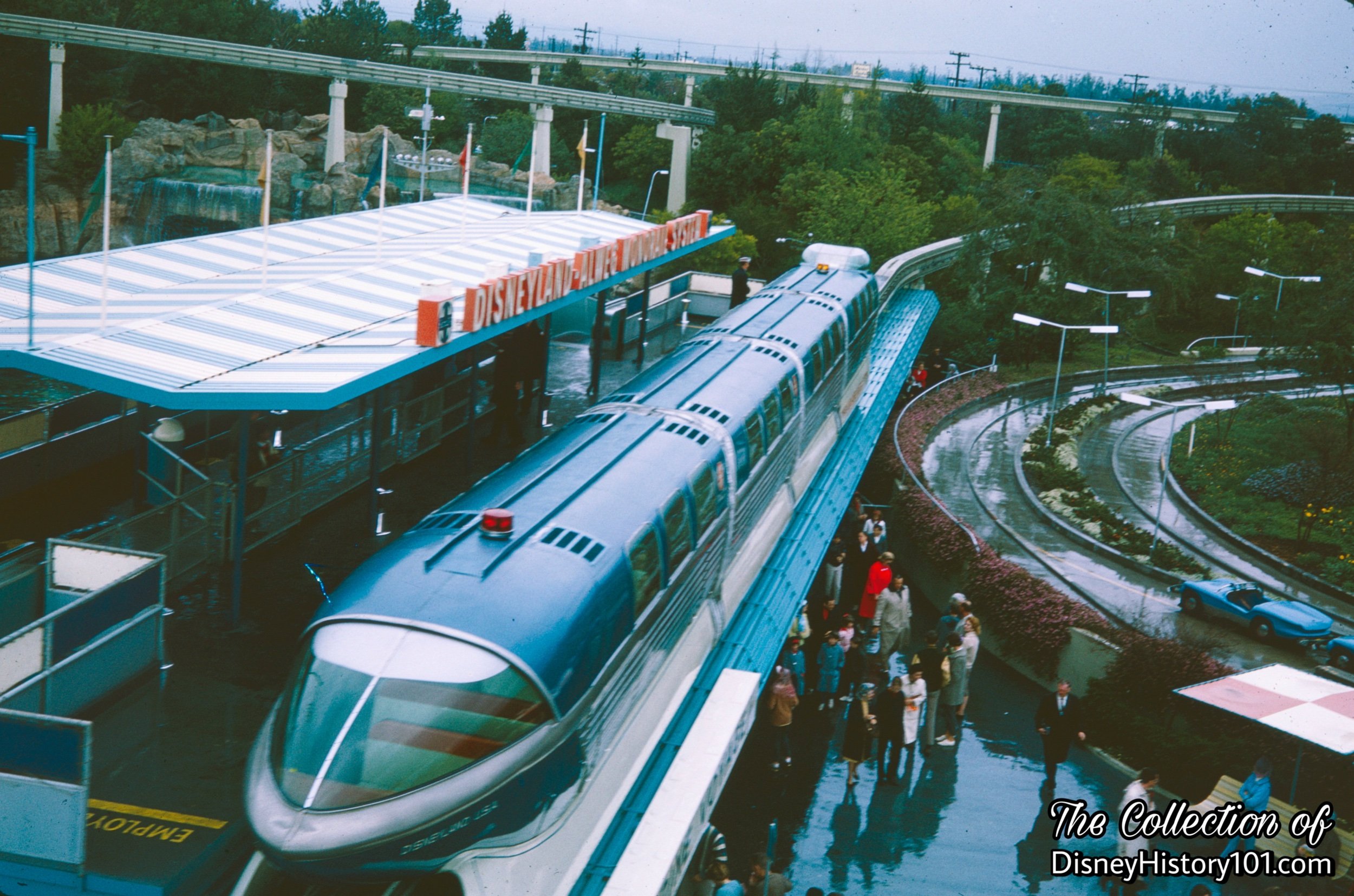
REENTERING THE PARK AND TOMORROWLAND SEGMENT - Monorail Mark II Blue on a rainy day, c.1961.
From this angle we get a clear view of the:
•DOME: The transparent enclosure over the Monorail Pilot Control.
•BEACON: The amber revolving light located behind the dome on the first section of the train.
•CATWALK: A narrow walkway on top of the cars.
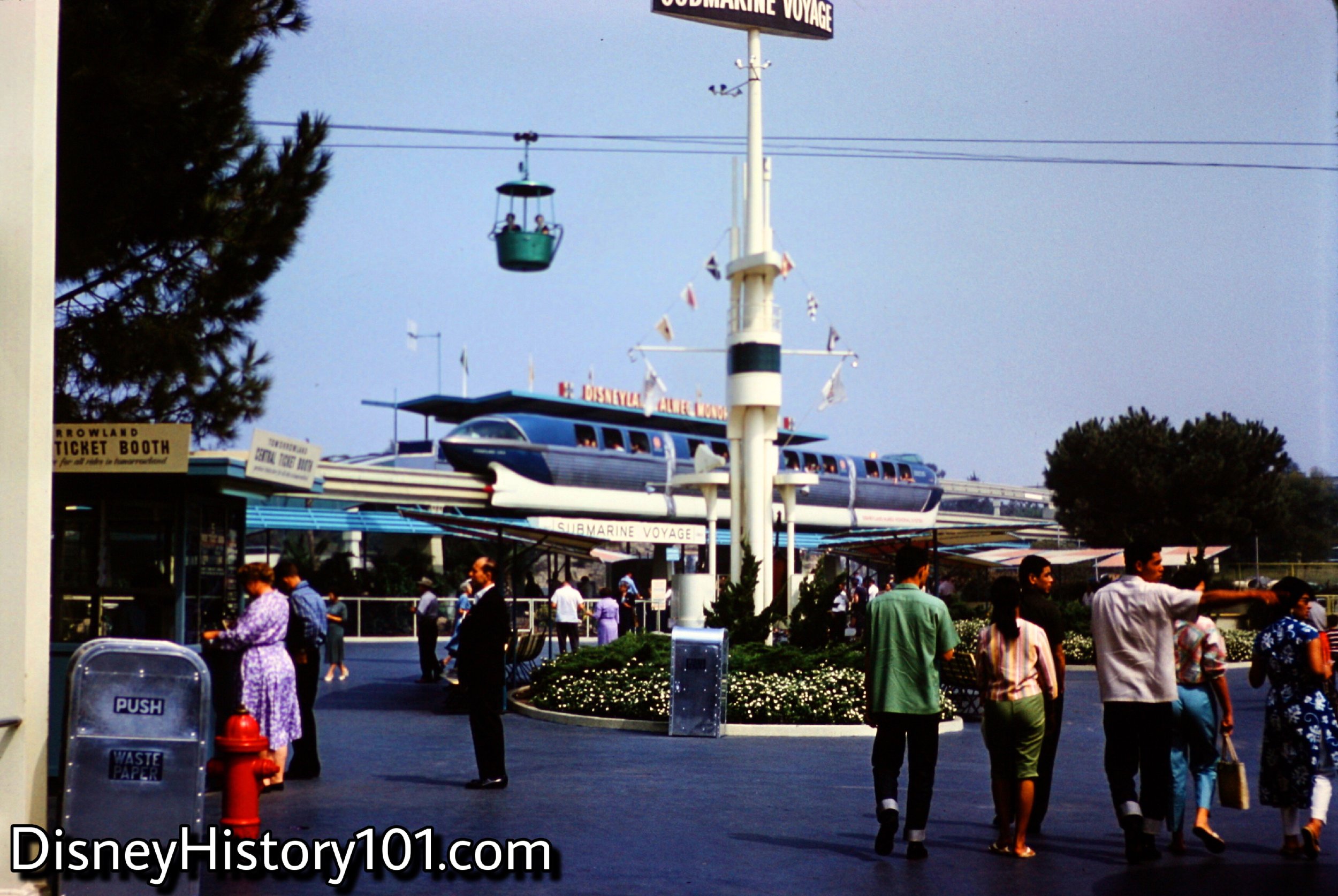
REENTERING THE PARK AND TOMORROWLAND SEGMENT - Monorail Mark II Blue, (1961)
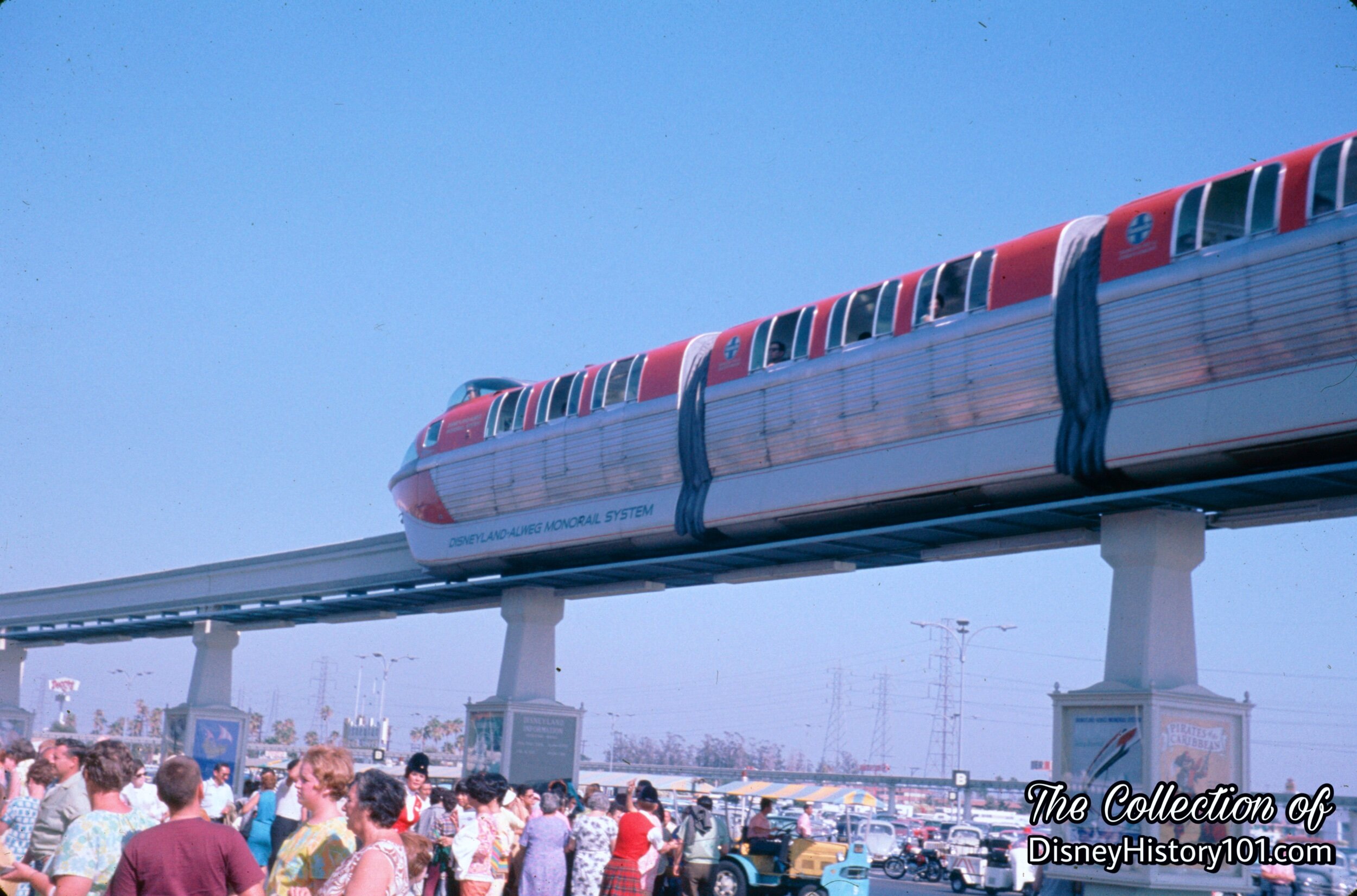
Monorail Mark II Red

REENTERING THE PARK AND TOMORROWLAND SEGMENT - Monorail Mark II Blue, (1962)
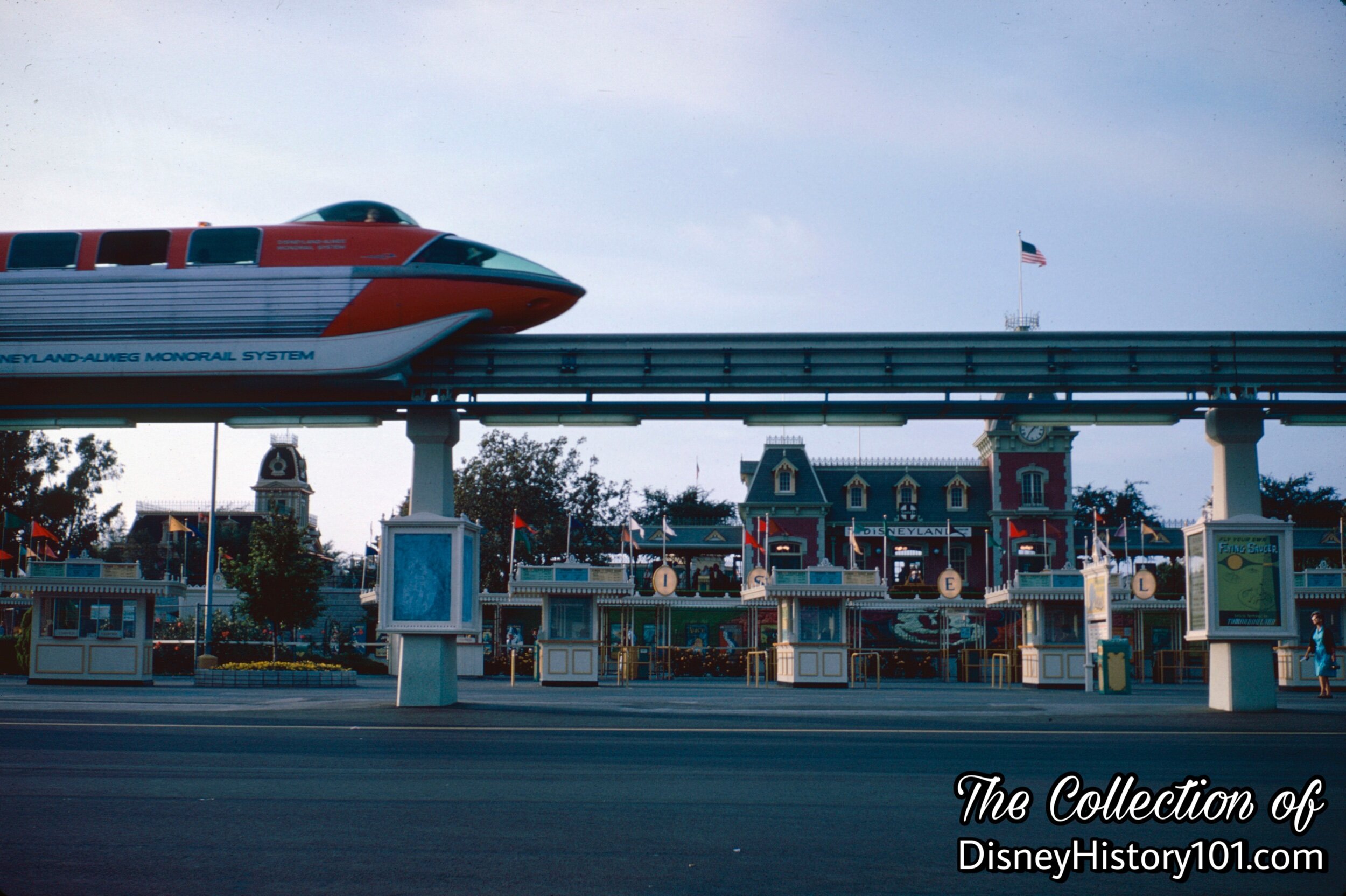
Monorail Mark II Red, (June, 1962)
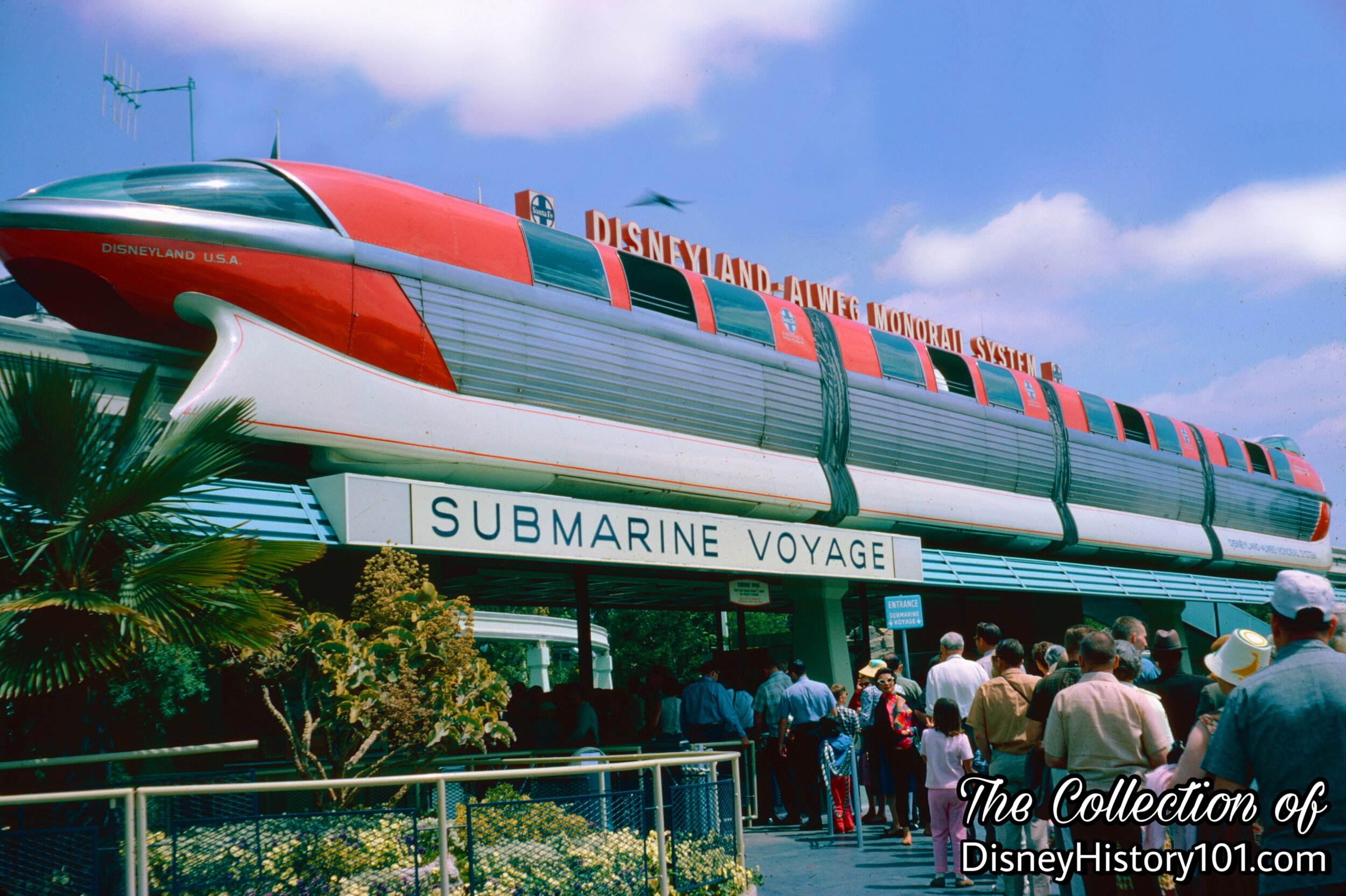
Monorail Mark II Red at Tomorrowland Station Disneyland, (May, 1962)
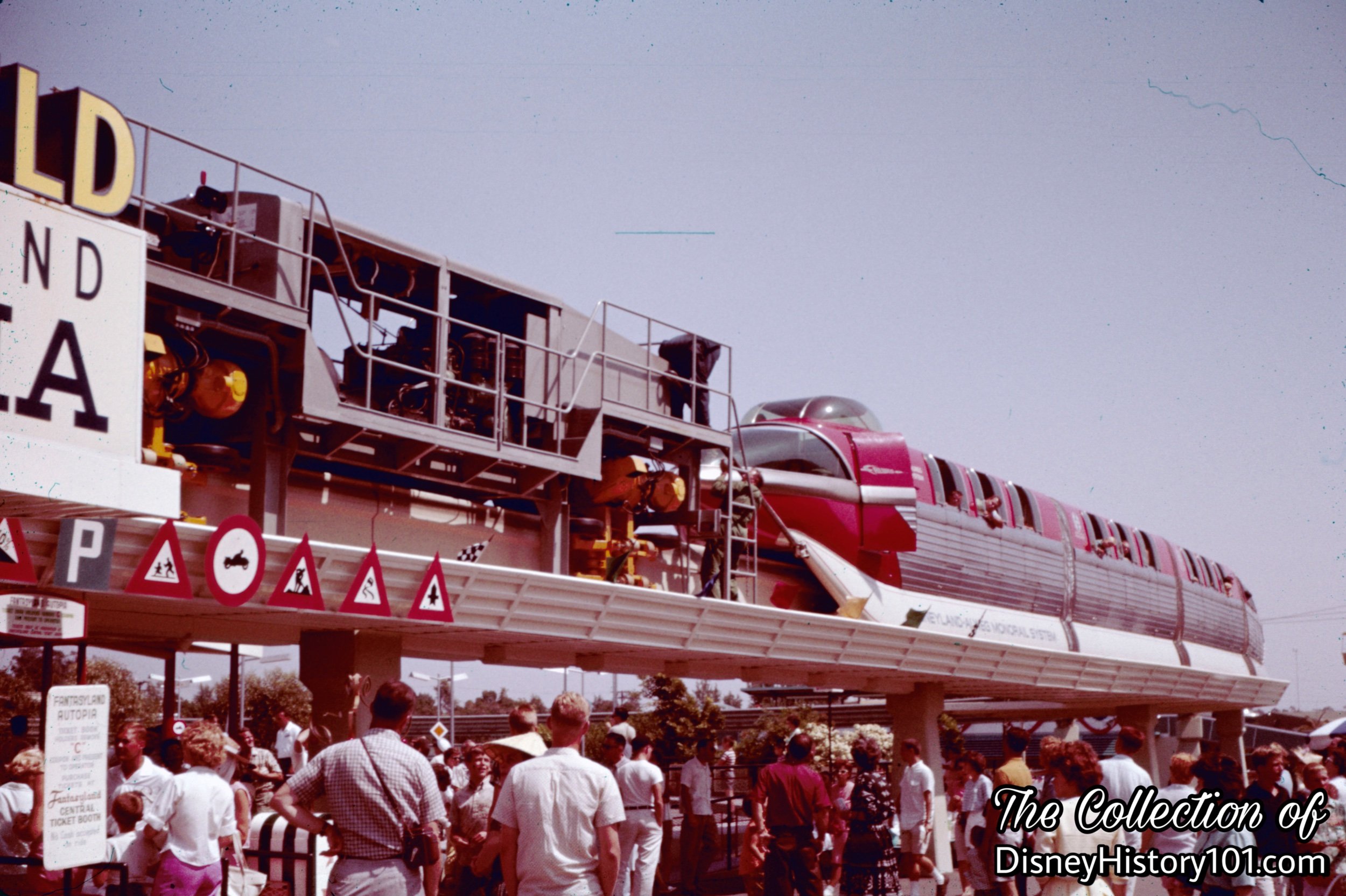
A “101” Monorail Mark II Red serviced by the W.E.D. Monorail Diesel Power Tractor.
The attraction would experience a “Show Failure” situation and go “101.” In case of a power failure, a unique gasoline driven work car known as the W.E.D. Monorail Power Tractor would tow the train to the station where the passengers would be unloaded. This unique piece of general equipment was powered by an internal-combustion Diesel engine.
The Pilot would wait until the work tractor had hooked onto the train. Then, when signaled, the Pilot would put the test-run switch in the test position and push the towing brake release.
During the towing procedure, Guests may recall the door “safety feature.” The Monorail train doors were electrically operated and remained locked while the train was in motion, only capable of opening once the train had stopped at the Monorail Station and the “propulsion power control switch” was maneuvered into the “off” position. In case of a power failure, the doors were operated by solenoids powered by just one “contactor,” and could be opened from the outside. That is what happened after the train towed by the Monorail Power Tractor arrived at the station (in the Vintage View, above).
The work tractor unit was also used for working on the beamway. As a sidelight, unscheduled maintenance time ran approximately 68 hours for the first year.
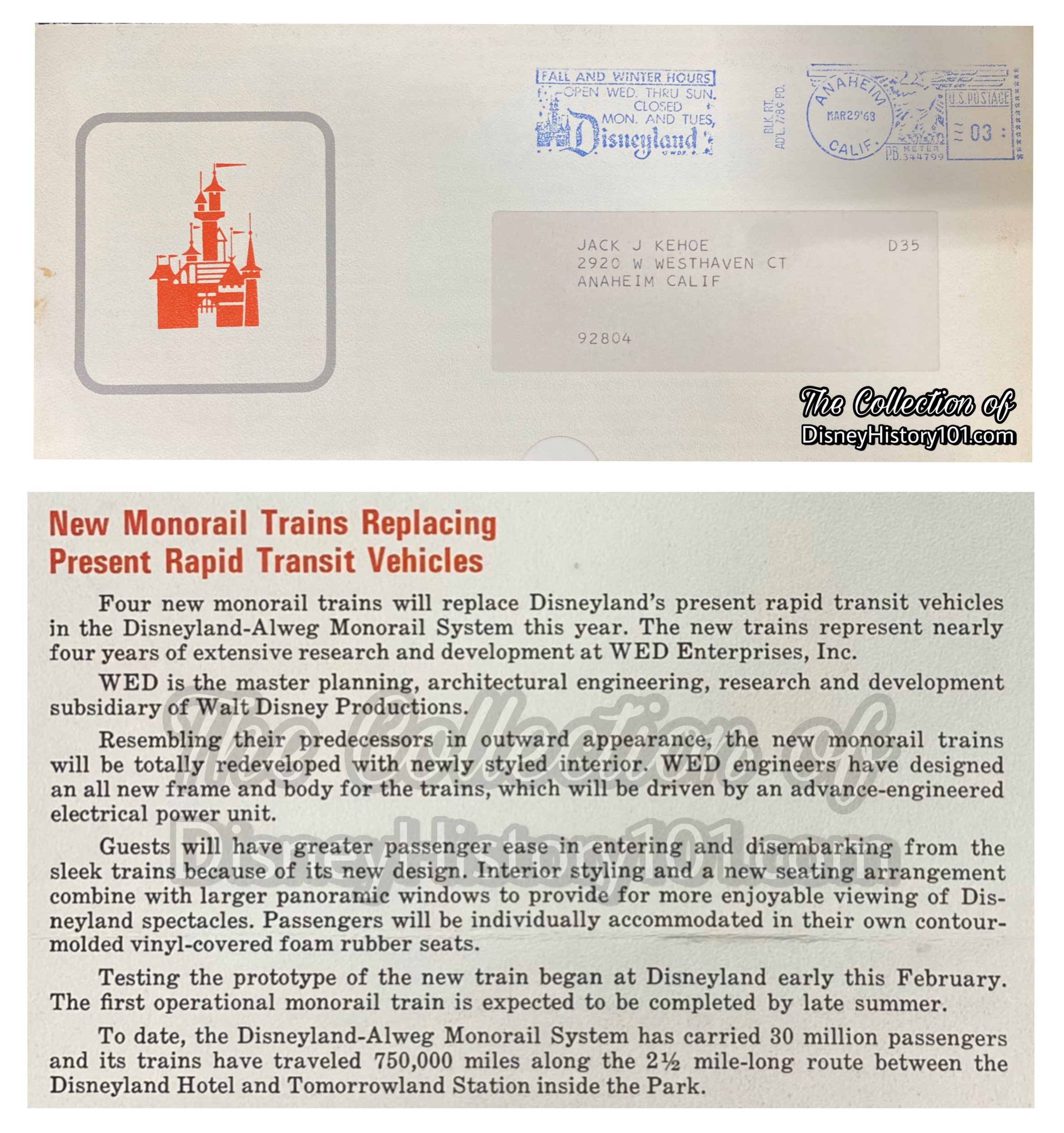
New New Monorail Trains Replacing Present Rapid Transit Vehicles announced via “Inside Disneyland” News and Views, March 1963.
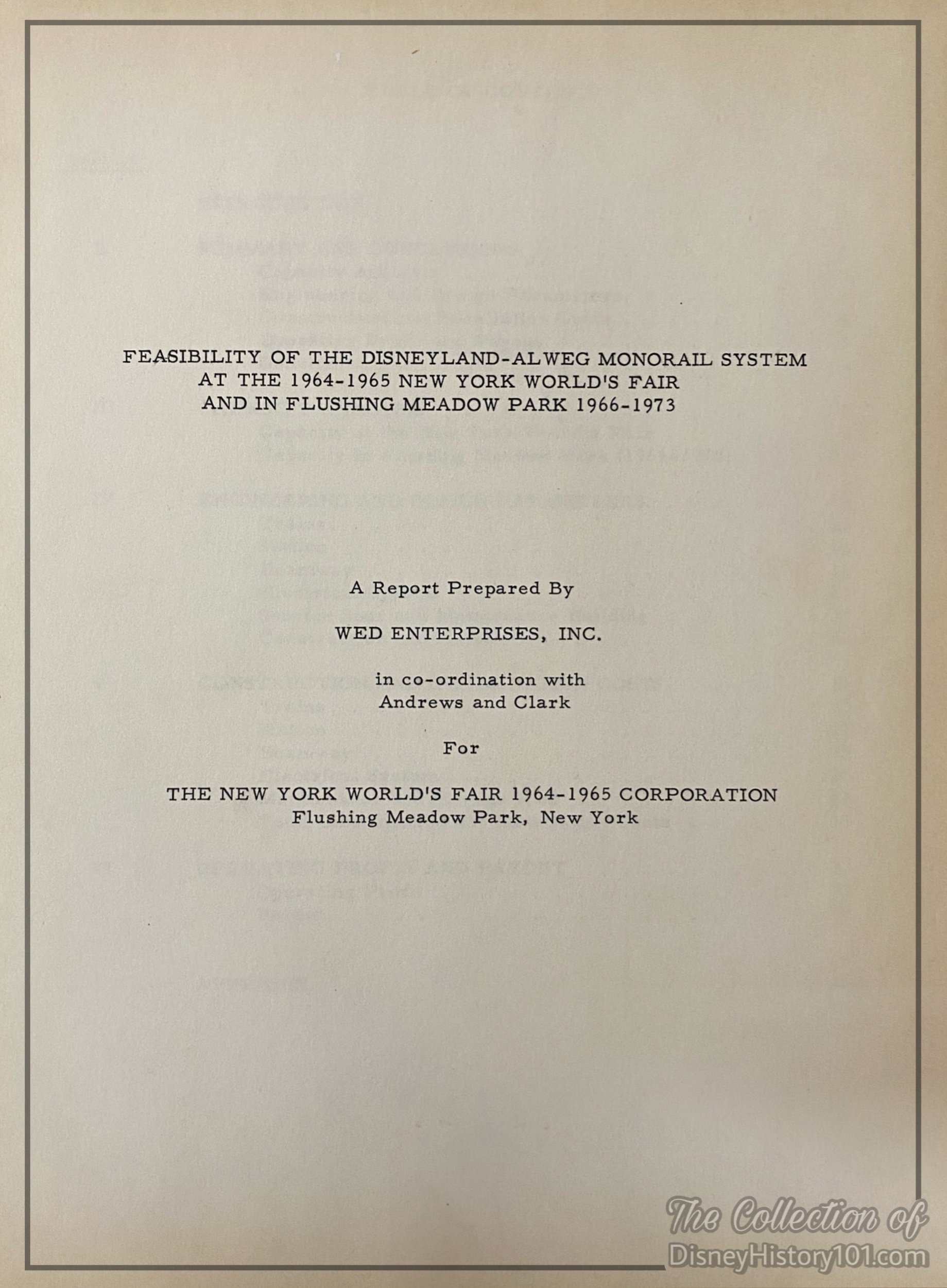
Disneyland-ALWEG Monorail Feasibility Study for the New York World's Fair, prepared by May of 1962.
By the early 1960s, Disneyland had grown into a proving ground for design talent, future products, and transportation systems. Meanwhile, ALWEG manufactured Monorail systems, including the Seattle Center Monorail for the “Century 21 Exposition” Seattle World’s Fair. In 1964, the first Disney-designed PeopleMover system carried guests through the Ford pavilion at the New York World's Fair. Similarly, the ALWEG Disneyland Monorail had crossed a Submarine Lagoon and over the berm, the route was extended to practical use, transporting guests to the Disneyland Hotel. There was soon talk of a proposed Disneyland ALWEG Monorail route for the New York World’s Fair of 1964 - 1965 which would cross the Flushing River. This would have meant that the Monorail could have become a fifth Disney show Imagineered for the Fair. A study was prepared by WED Enterprises, Inc. in coordination with several firms including Andrews and Clark, Consulting Engineers, Walt Disney Productions and Disneyland, Economics Research Associates, Economic Planners, J.B. Allen and Company, General Contractors, Wheeler and Gray, Consulting Structural Engineers, and Wegematic Corporation (ALWEG).
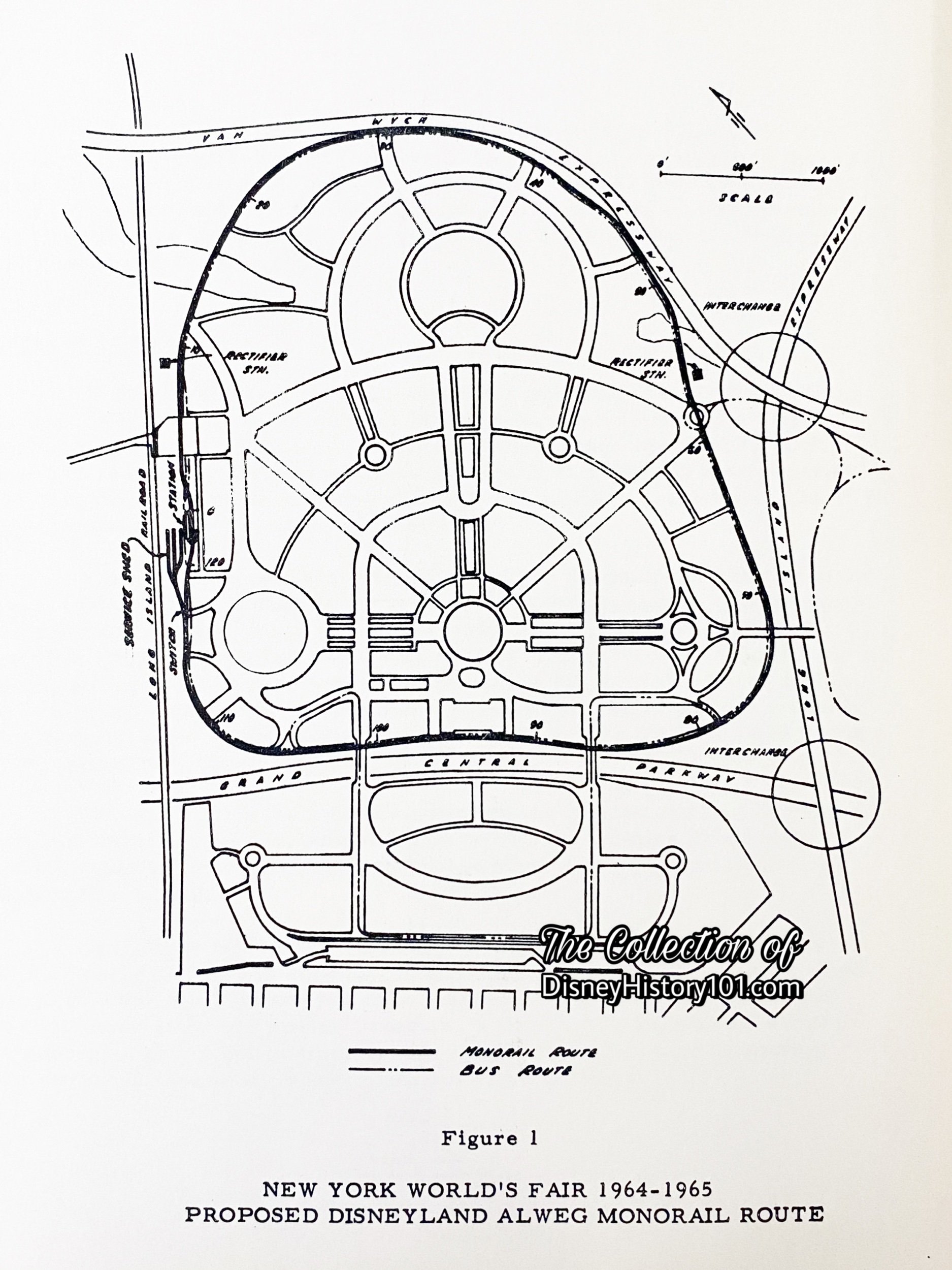
Disneyland-ALWEG Monorail Feasibility Study for the New York World's Fair, prepared by May of 1962.
The length of the proposed single-track beamway would have been 12,400 feet of main line and 1,000 feet of spur track, and a station located at the Main Entrance of the Fair. The designs were dated from Disneyland.
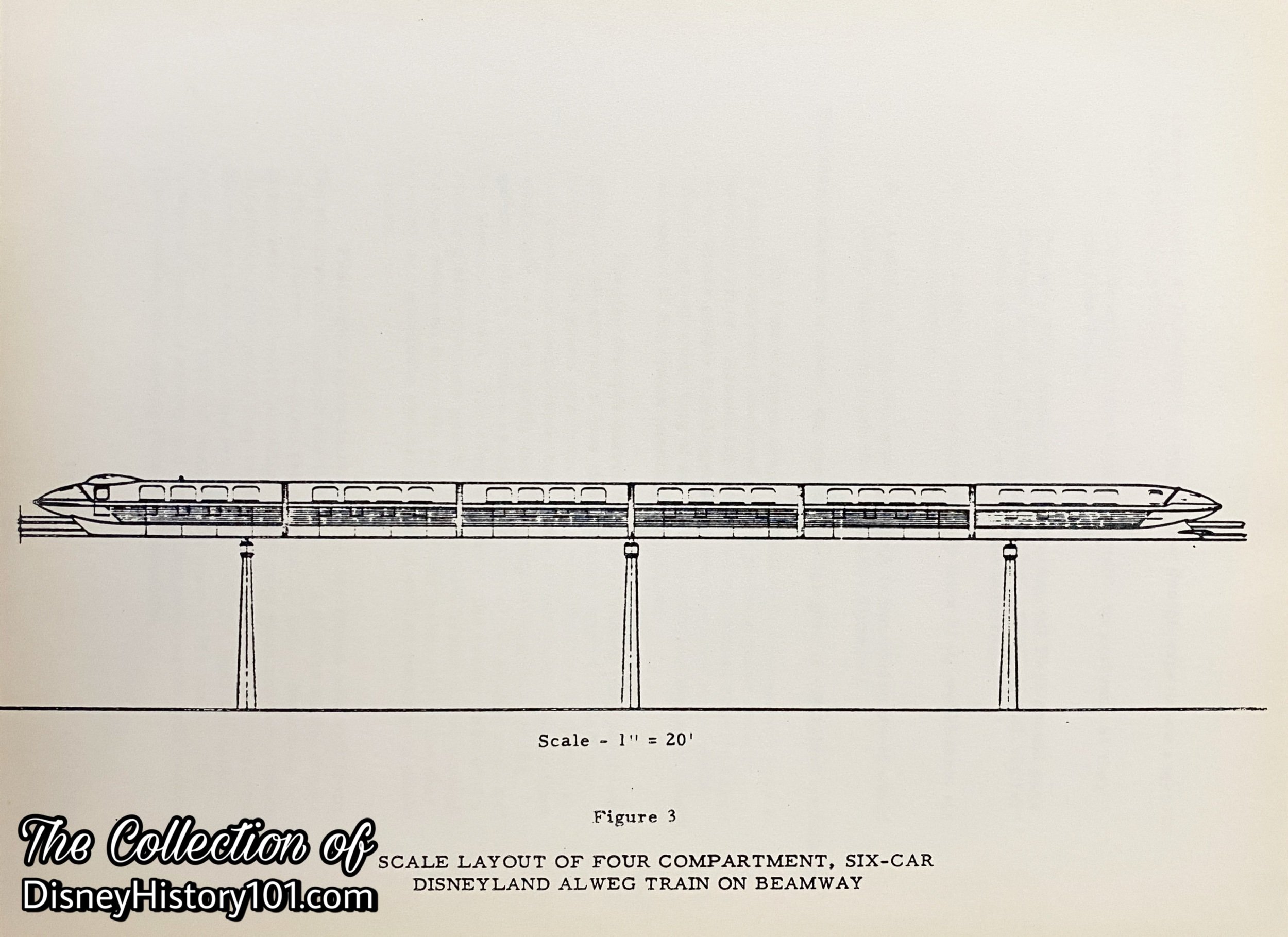
Disneyland-ALWEG Monorail Feasibility Study for the New York World's Fair, prepared by May of 1962.
While Disneyland Monorail trains had four cars, this feasibility study proposed a six-car Monorail train.

Disneyland-ALWEG Monorail Feasibility Study for the New York World's Fair, prepared by May of 1962.


Disneyland-ALWEG Monorail Feasibility Study for the New York World's Fair, prepared by May of 1962.
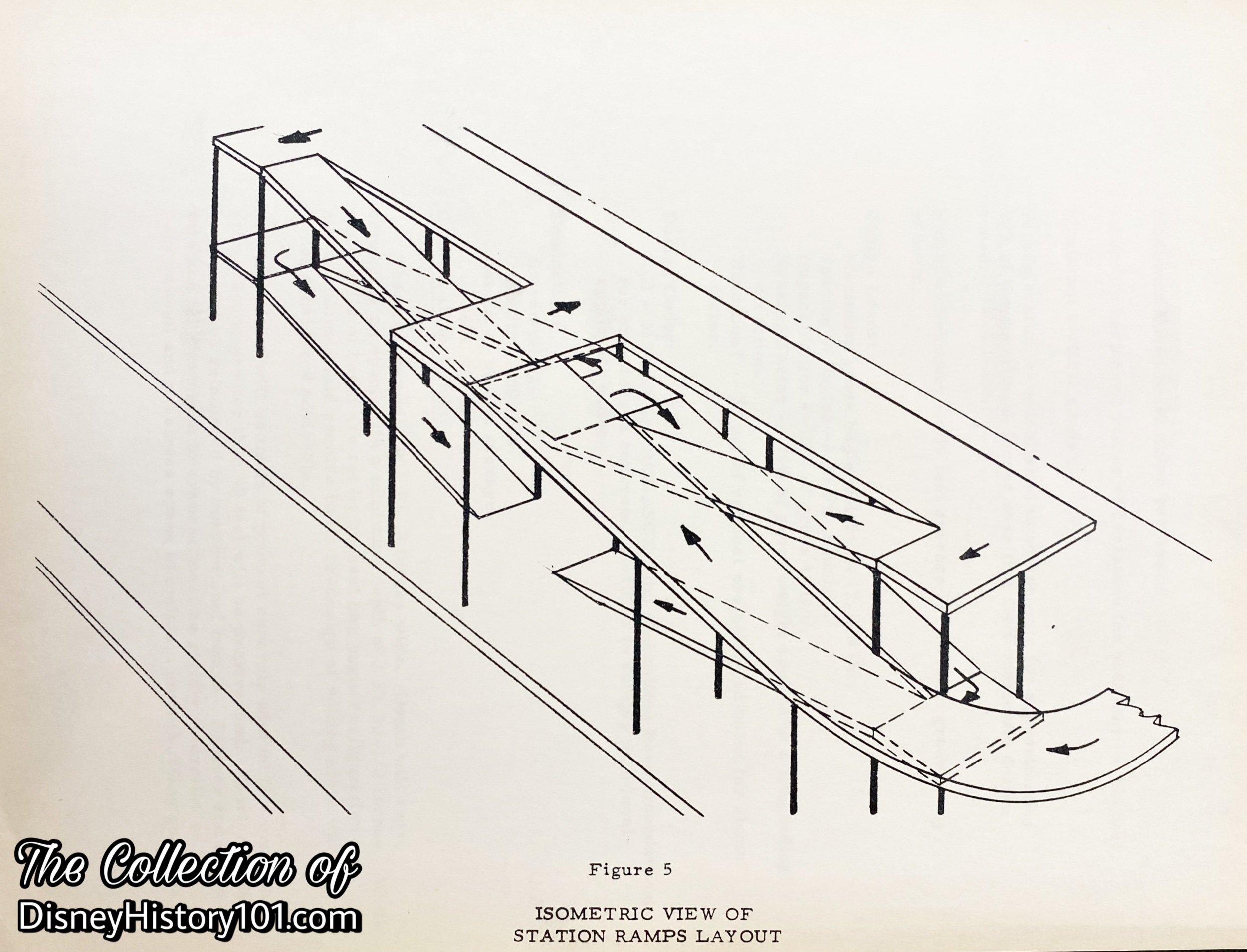
Disneyland-ALWEG Monorail Feasibility Study for the New York World's Fair, prepared by May of 1962.
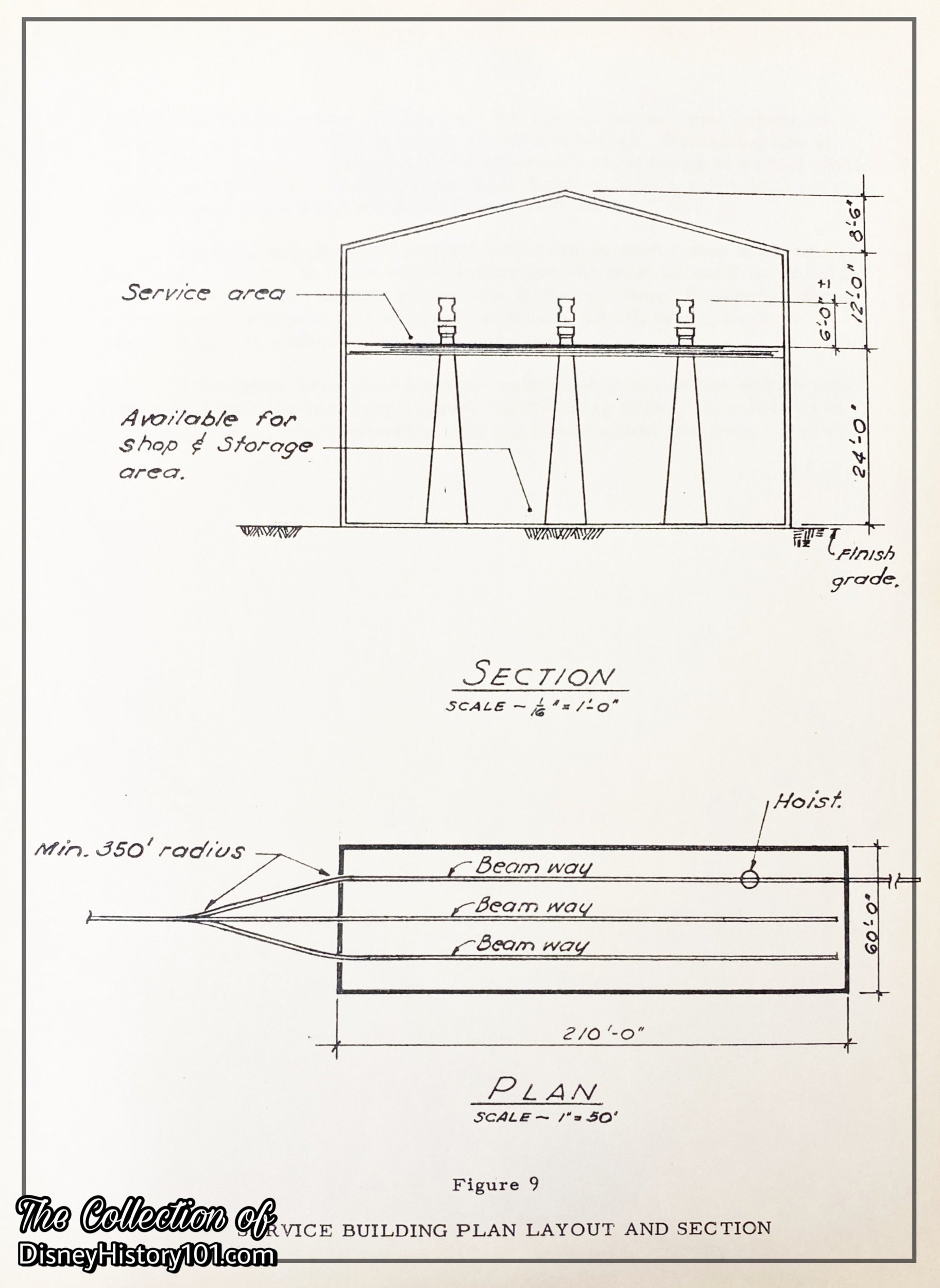
Disneyland-ALWEG Monorail Feasibility Study for the New York World's Fair, prepared by May of 1962.
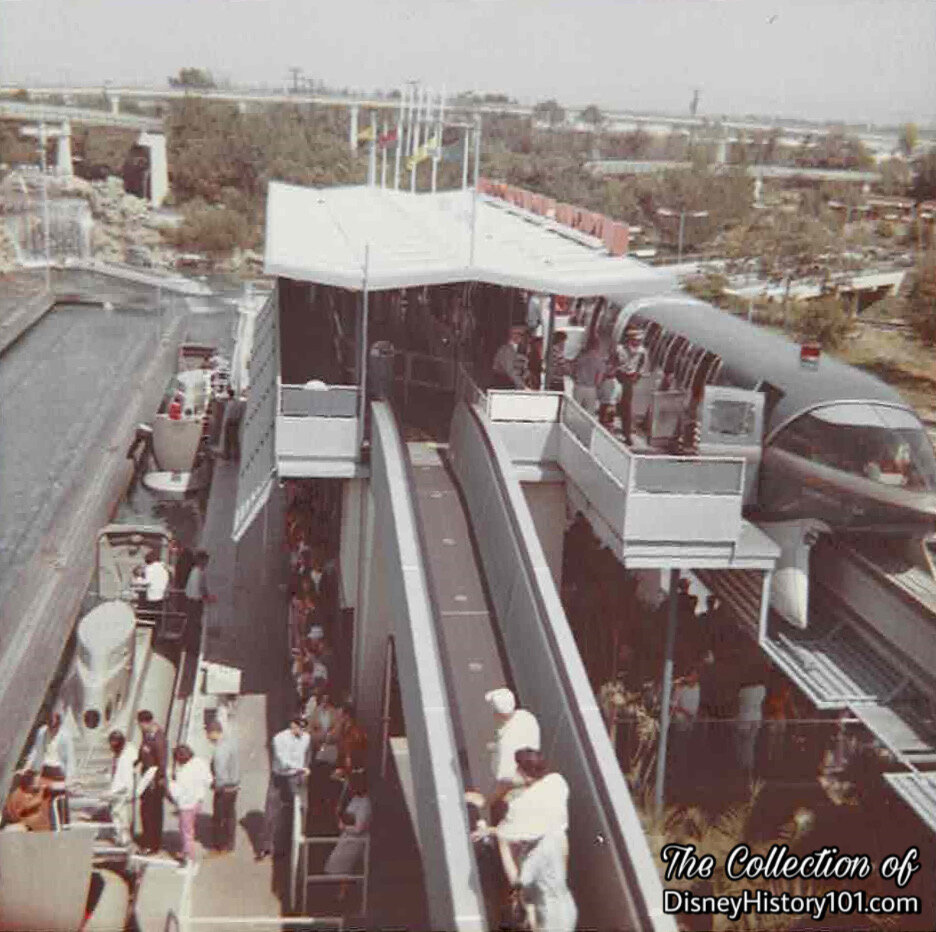
The Stephens-Adamson Speedramp carries guests to the Monorail Mark II Blue, (April, 1963)
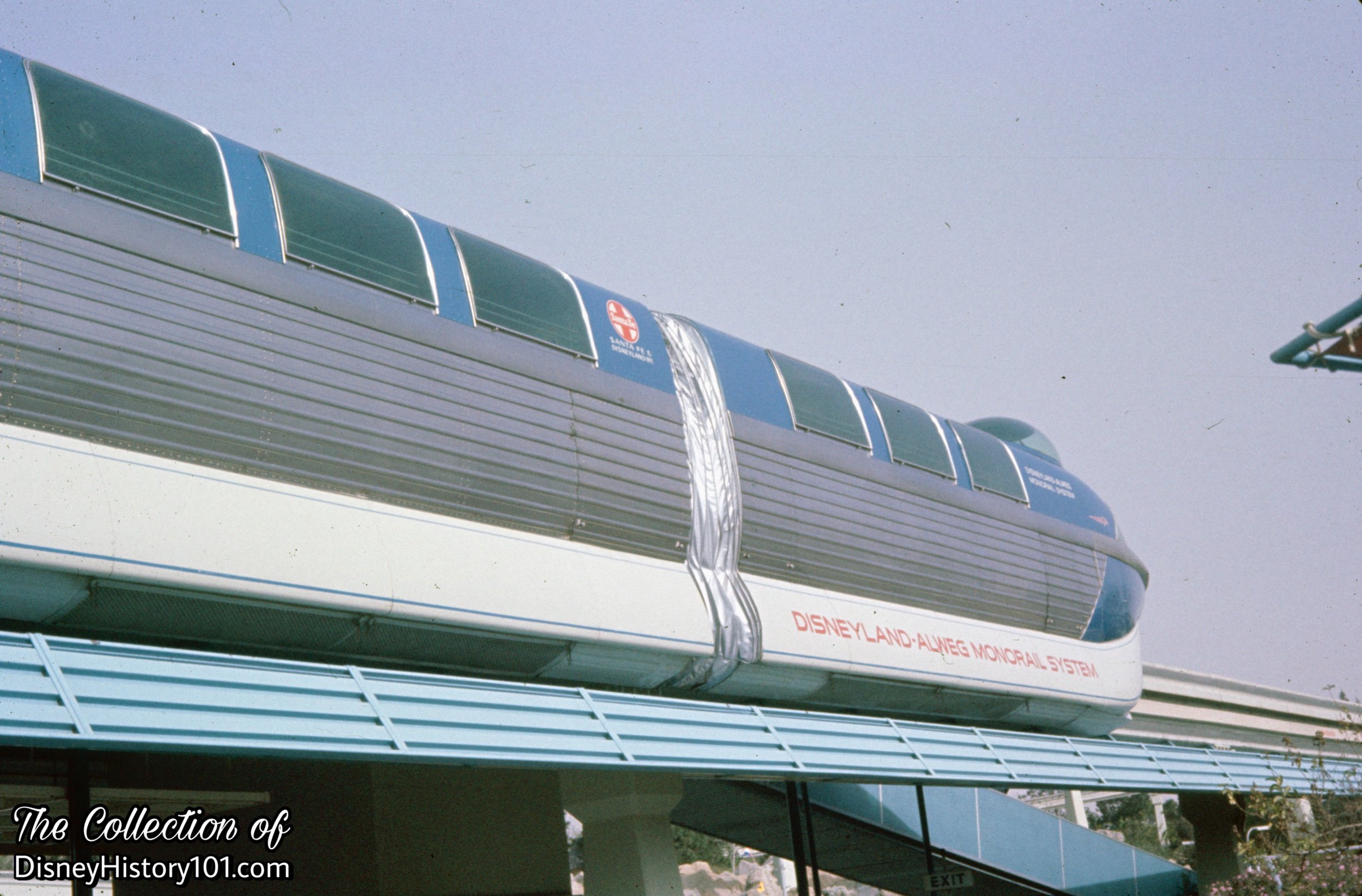
REENTERING THE PARK AND TOMORROWLAND SEGMENT - Monorail Train , 1963.
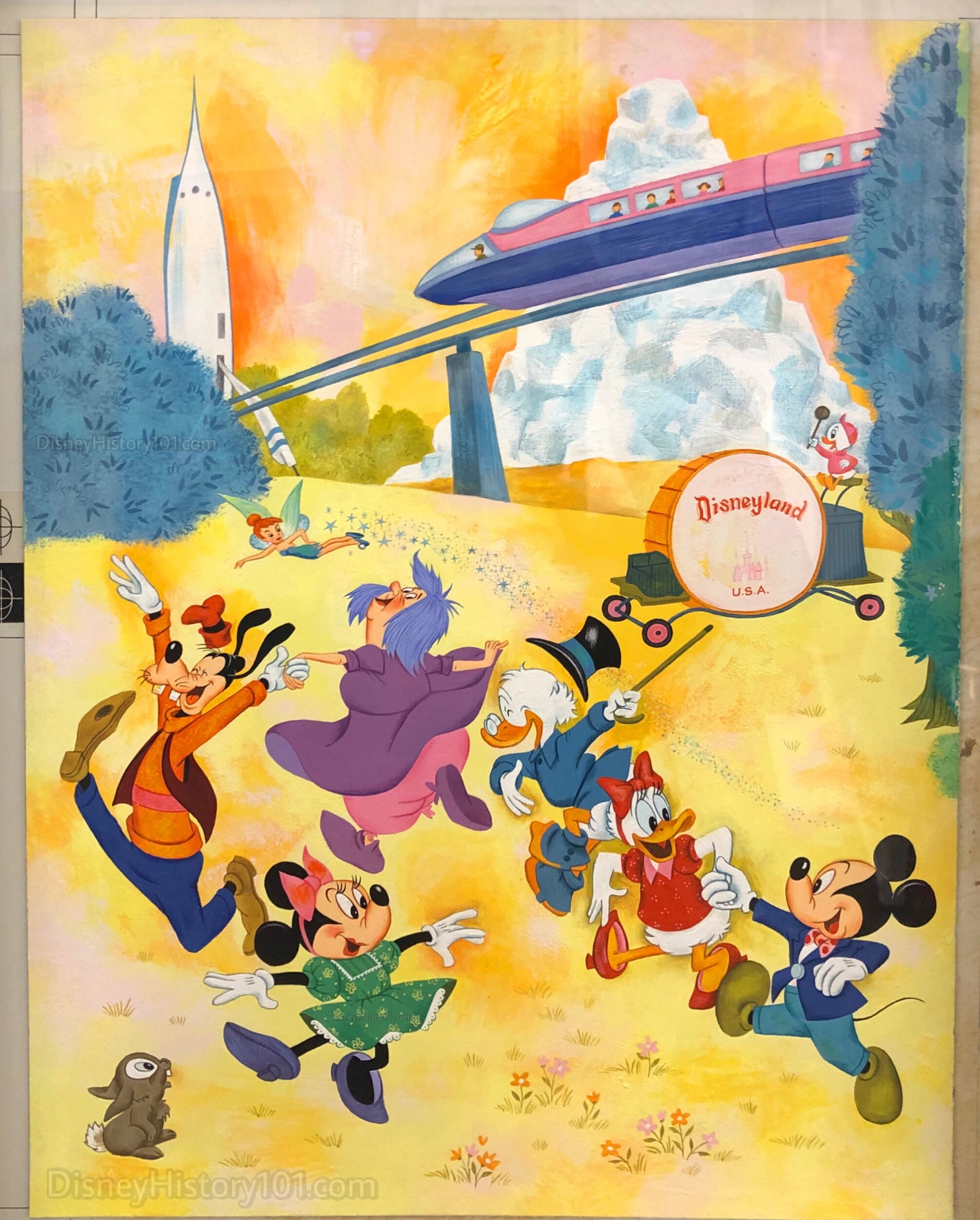
Whitman Disneyland 128-Page Coloring Book Illustration produced for the Tencennial, c. 1963
(Former Collection of Richard Kraft on Display at “That’s From Disneyland,” Presented by Van Eaton Galleries)
After his purchase of WED in 1965, Walt wished to retain the Santa Fe and Disneyland Railroad trains, the Mark Twain, and monorail trains. So he formed RETLAW Enterprises, Inc. for his privately held and owned vehicles and assets. In other words, WED Enterprises, Inc. (Walt’s theme park design and architectural group) was purchased by the Walt Disney Studios on February 5, 1965, along with the WED Enterprises name. After that deal, the WED the Corporation needed a new name, and Retlaw Enterprises was born. RETLAW Enterprises Inc. (once located at 4111 West Alameda AVENUE, Suite 500 Burbank, California 91505) owned the railroad trains operated at Disneyland.
By 1965, ALWEG had been renamed Alwac International, Inc. and was reckoned as one of Disneyland's 29 Institutional Lessees.
While Disneyland was steadily moving toward its “Tencennial Celebration” in 1965, there were many attractions to celebrate, including the Biggest Bass Drum in the World, the McDonnell Douglas Flight to the Moon, and the Monorail “trains of the future”! By the time this illustration was created (in 1963), the Disneyland-ALWEG Monorail trains had “carried more than 11,000,000 passengers and travelled 225,000 miles,” according to Meccano magazine (Vol.50, No.5 ; published for May of 1965).
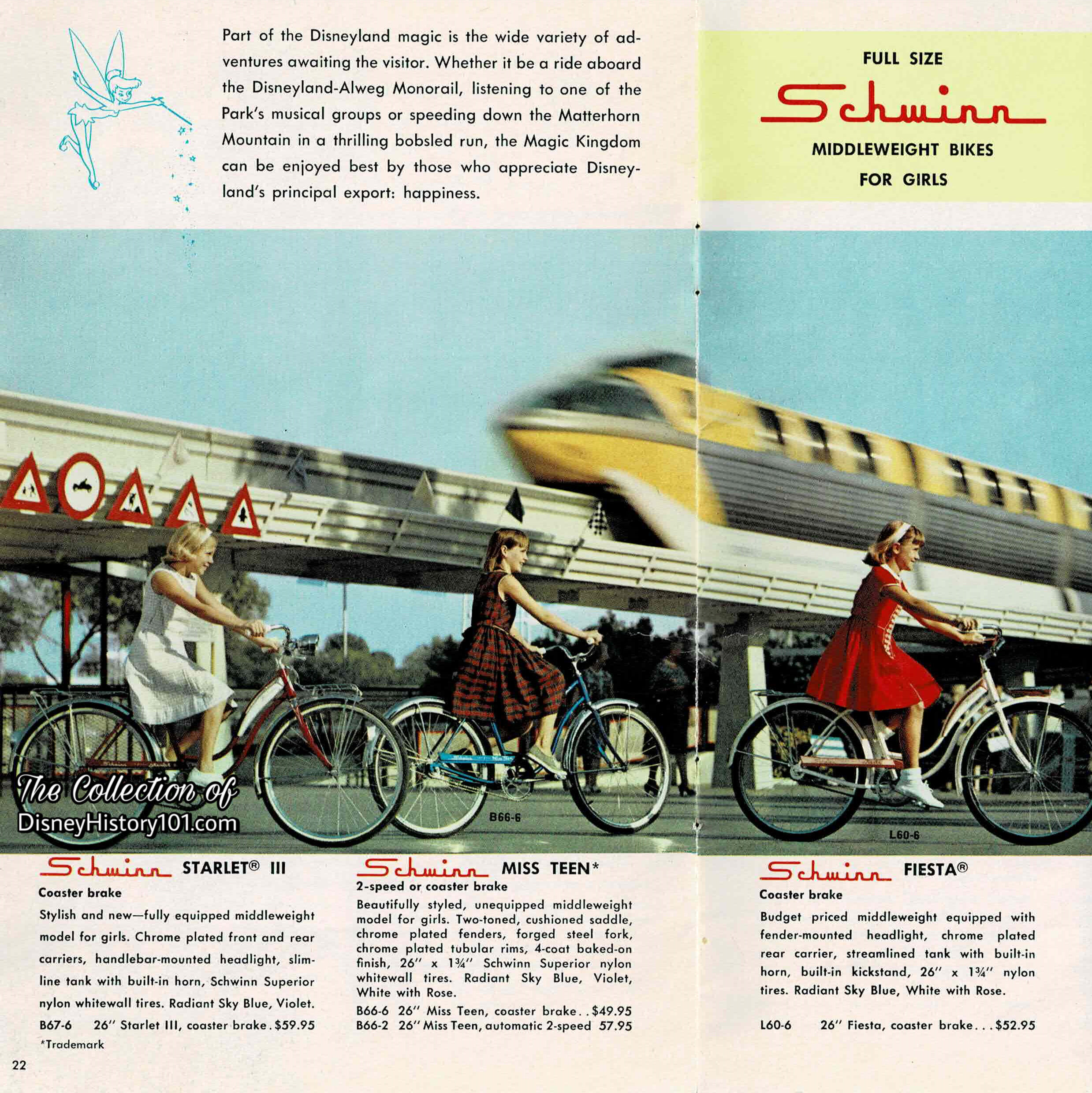
The transportation of today and tomorrow is showcased in a “Schwinn Takes A Trip To Disneyland” Catalogue Excerpt; published 1966.
Photographs of Schwinn middle weight bikes for girls (i.e. the Starlet III, Miss Teen, and Fiesta models) were photographed (with the Monorail Yellow in view) for this catalogue at Disneyland during the Tencennial celebration of 1965. About May of 1965, Ben Harris and Royal Clark were discussing the redevelopment of the “narration scripts for [the] Monorail and trains.”
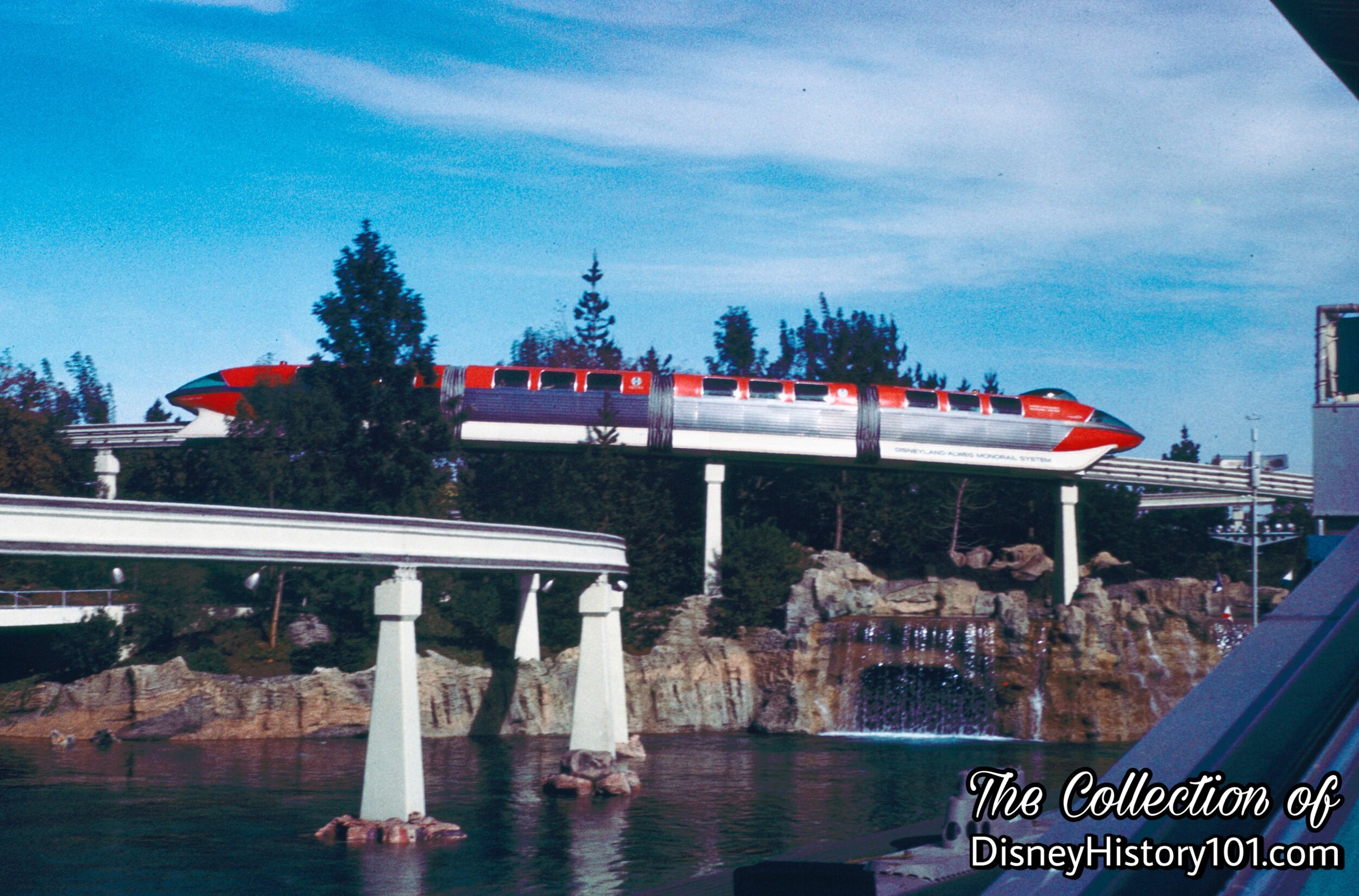
REENTERING THE PARK AND TOMORROWLAND SEGMENT - Monorail Mark II Red, (1965)
By the milestone year, a number of notable Disneyland Cast Members had operated the Monorail, like Chris Ridgway (whose story is preserved in Backstage Disneyland magazine, Vol.4, No.4, December 1965).
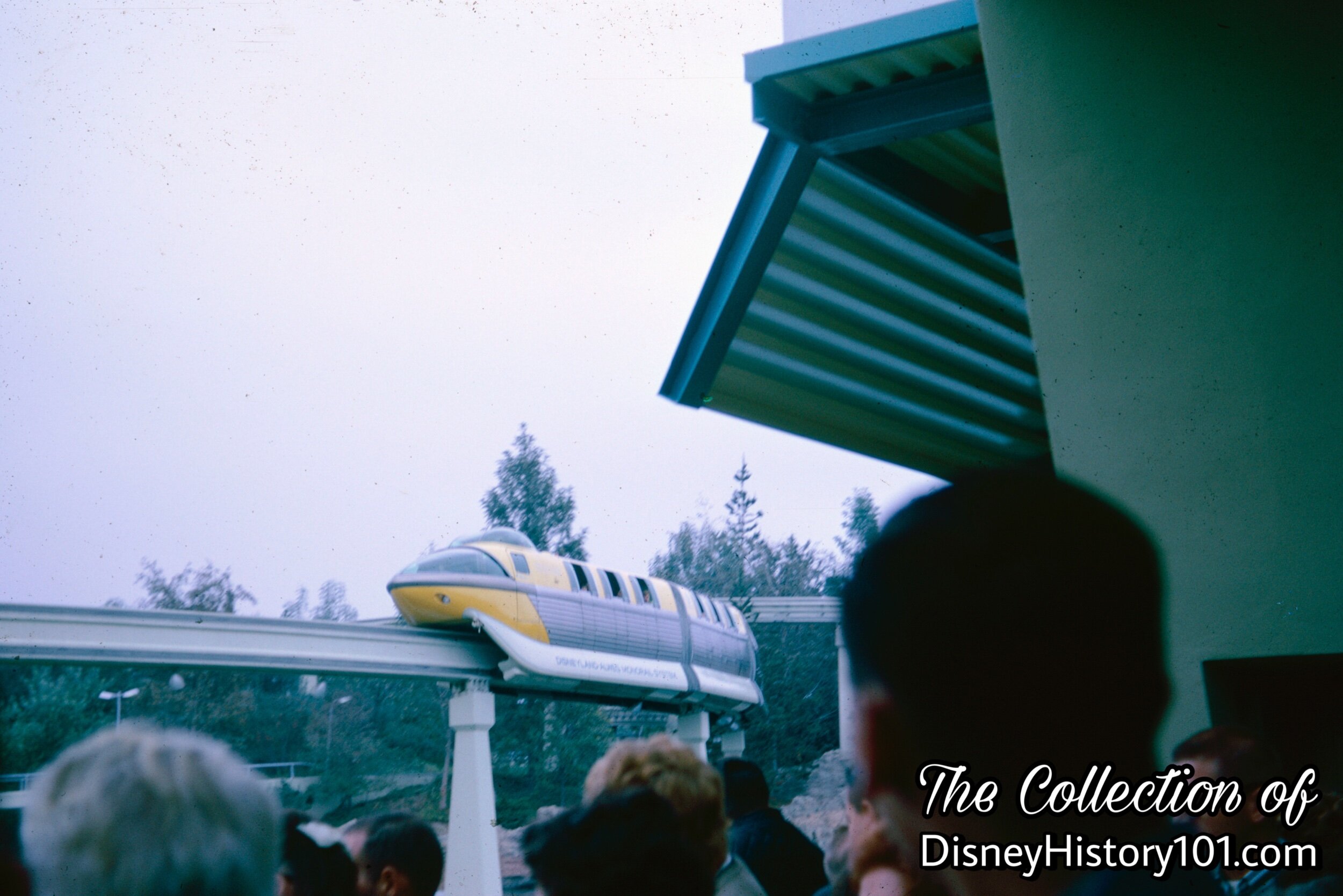
REENTERING THE PARK AND TOMORROWLAND SEGMENT - Monorail Mark II Yellow, (1965)
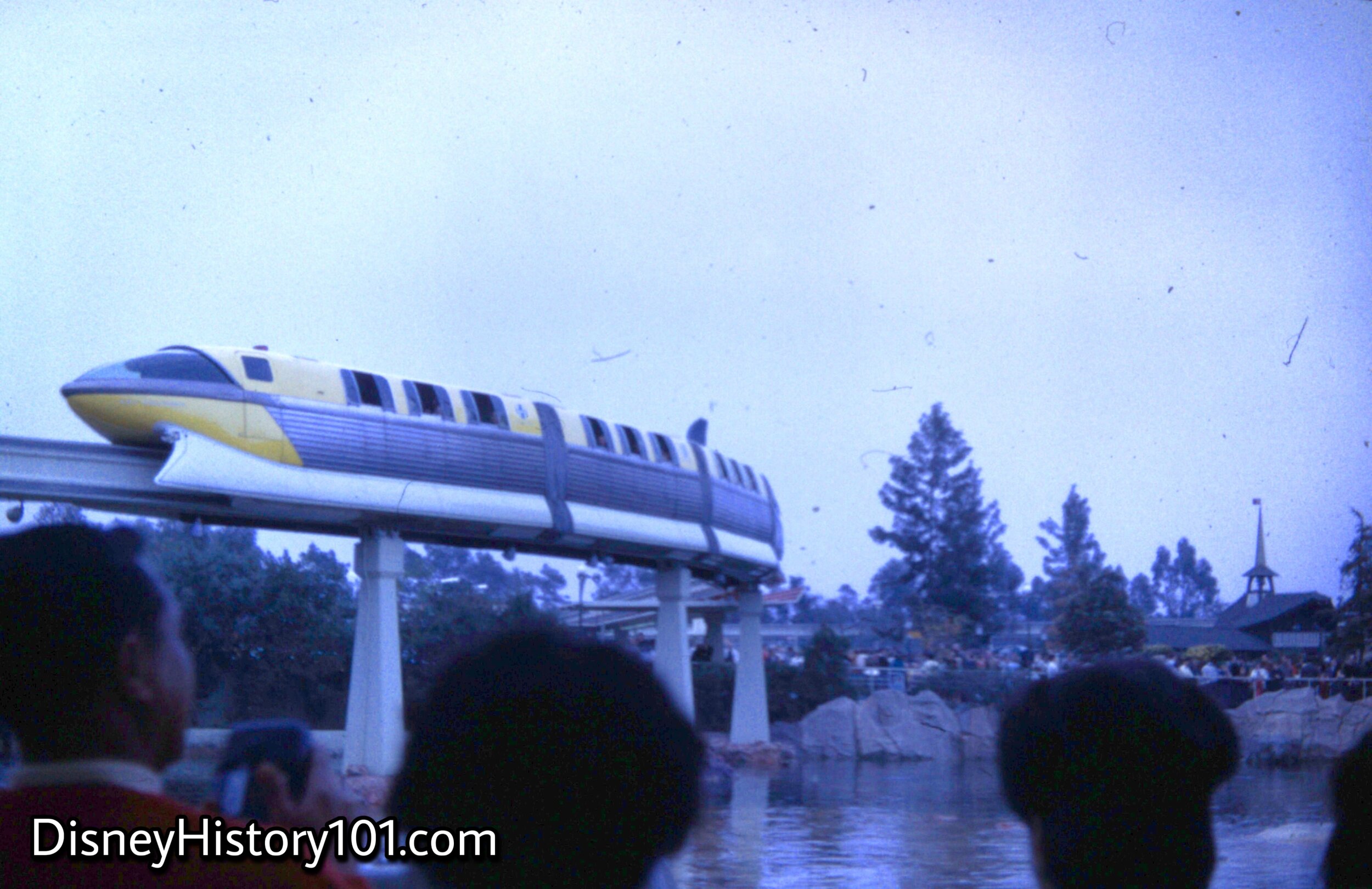
REENTERING THE PARK AND TOMORROWLAND SEGMENT - Monorail Mark II Yellow, 1965
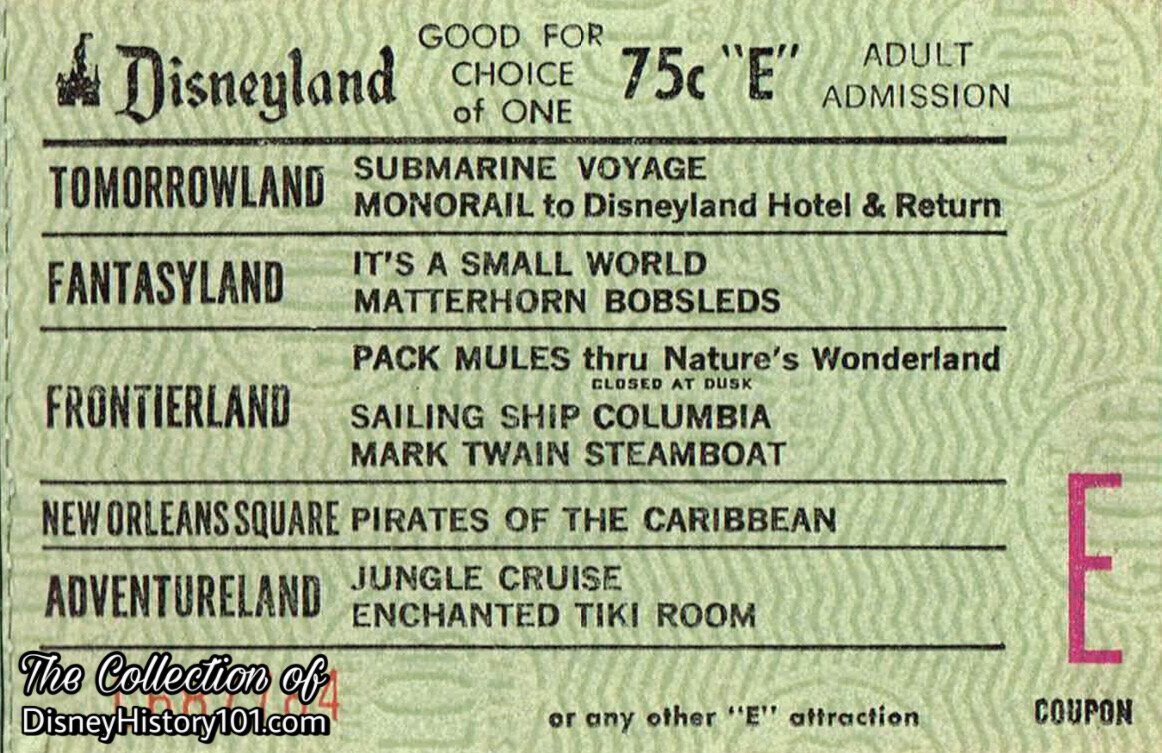
In 1965, the price of admission for circling above Disneyland on the transportation system of tomorrow was exactly one “E” coupon, or 75¢ for adults and 65¢ for children.
Speaking of prices…
In 1965 the Disneyland Railroad and Monorail grossed $2, 487, 500, and the family company RETLAW paid its "landlord, " Walt Disney Productions (which owns Disneyland), 20 percent of this figure as rent for the right-of-way. RETLAW would retain the other 80 percent for operating expense, amortization, and profit.
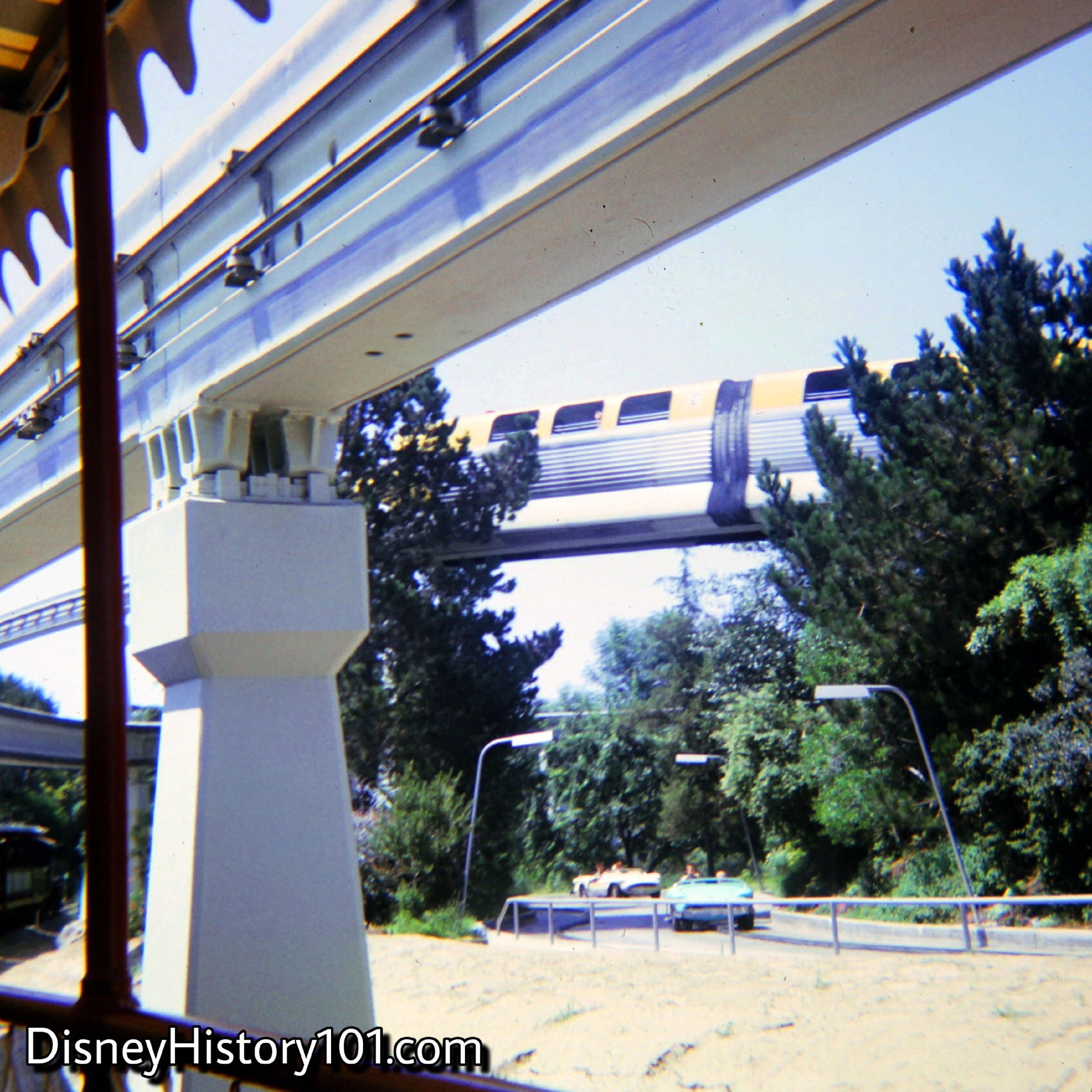
REENTERING THE PARK AND TOMORROWLAND SEGMENT - Monorail Mark II Yellow, 1966
A switchway in the Monorail Beamway leads two directions - the main Beamway, and the spur track leading to the Train Storage Building! The Train Storage Building is where the Monorails and the Santa Fe and Disneyland Railroad trains are stored, cleaned, and maintained.
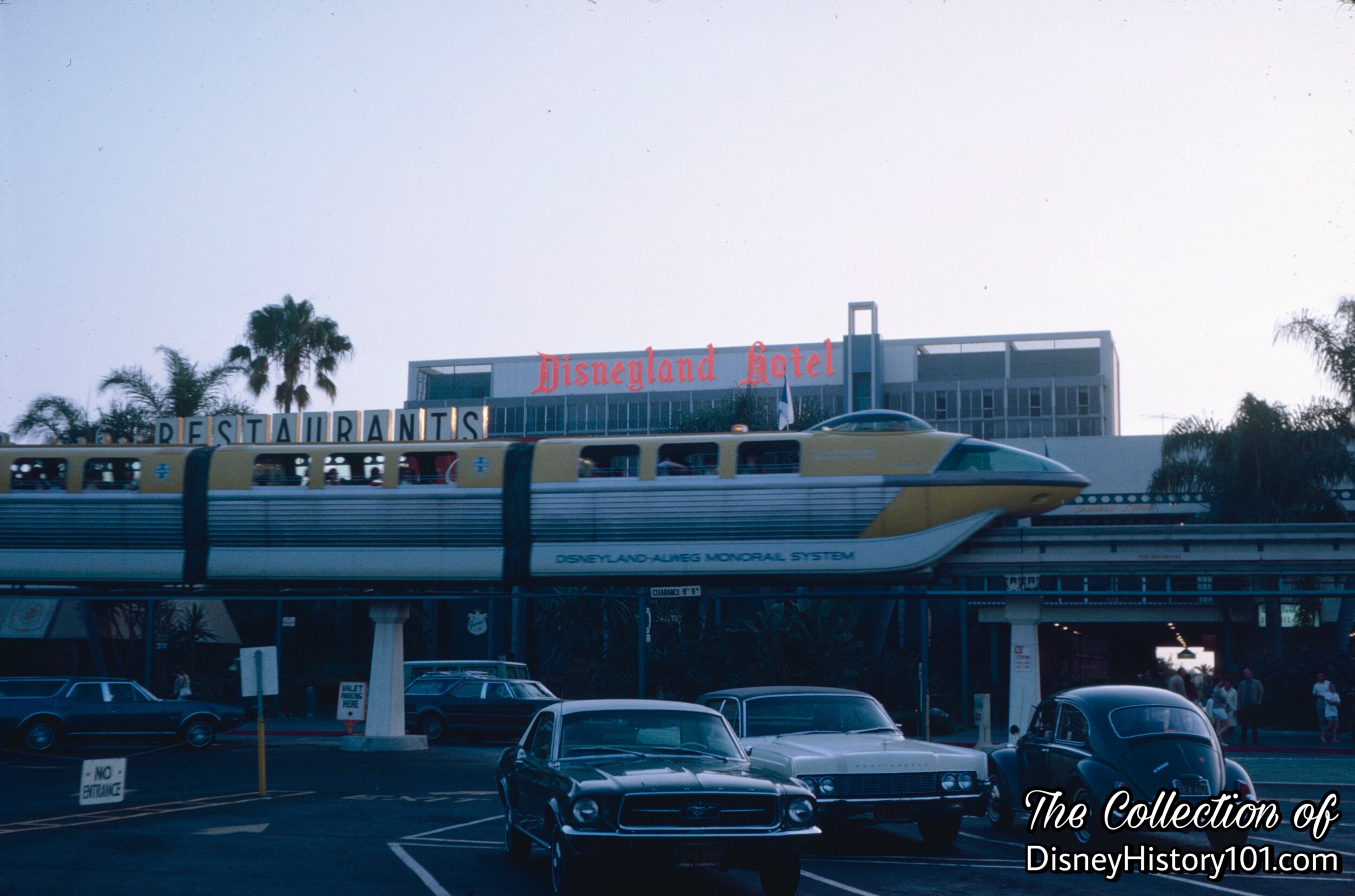
REENTERING THE PARK AND TOMORROWLAND SEGMENT - Monorail Mark II Yellow
When the Disneyland Hotel was open (but Disneyland was closed Mondays and Tuesdays), it only makes sense that a different live Monorail narration was given. By September of 1966, live narration drew attention to a “green building” (referred to as the “pirate building” on scripts) that would ”soon contain an exciting adventure.”
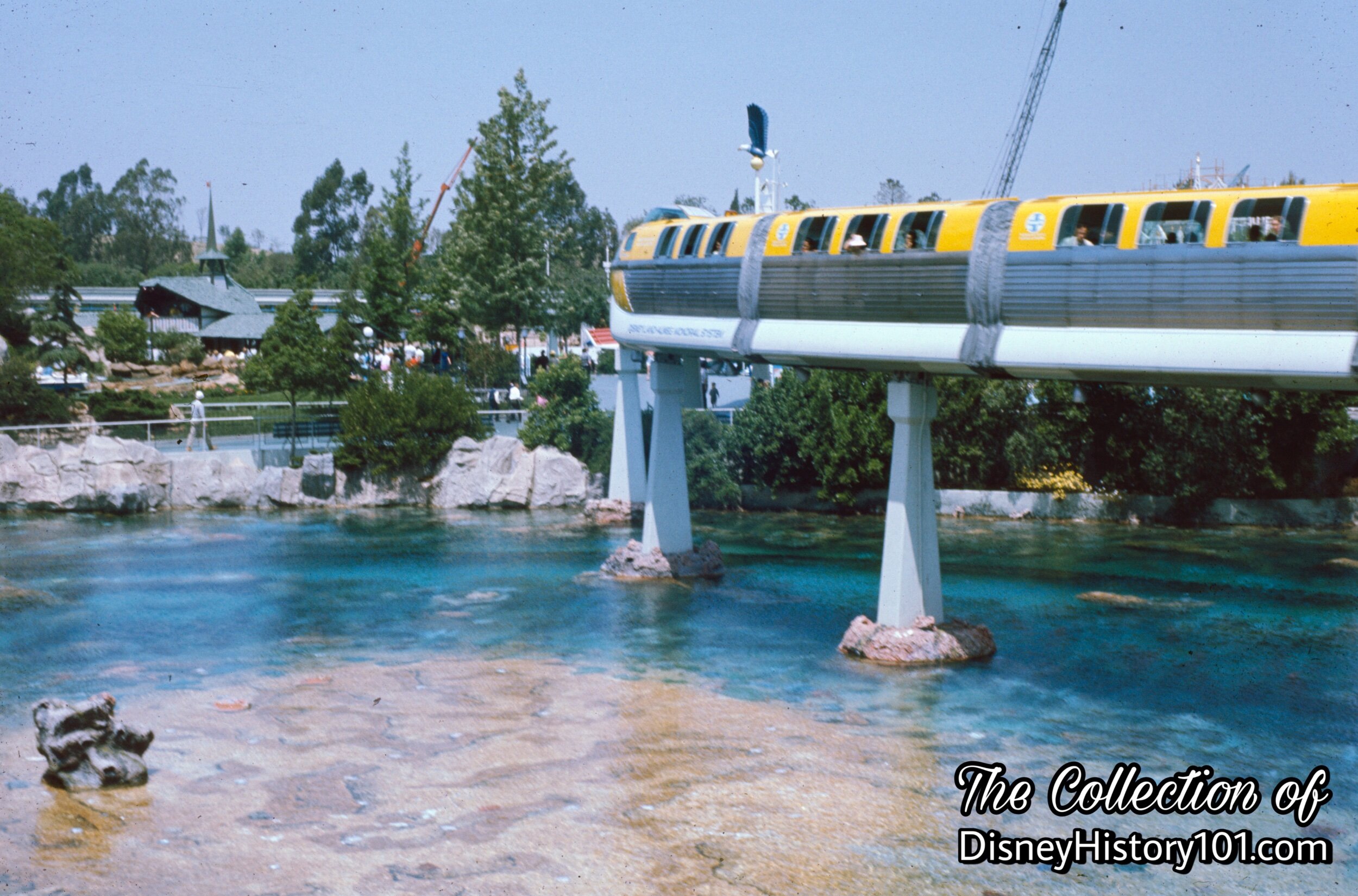
REENTERING THE PARK AND TOMORROWLAND SEGMENT - Monorail Mark II Yellow, (c. 1966)
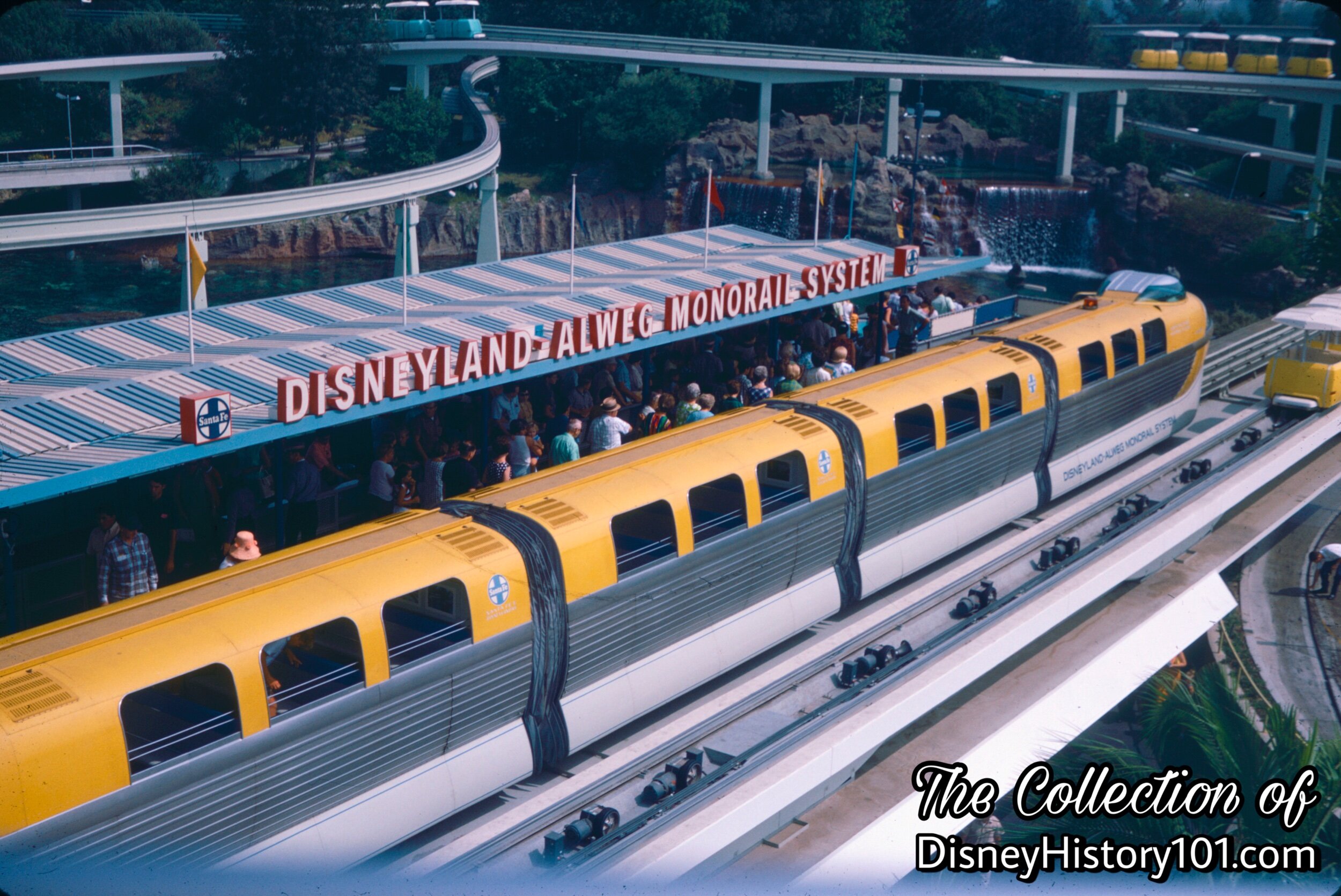
Monorail Mark II Yellow, (c. September, 1967)
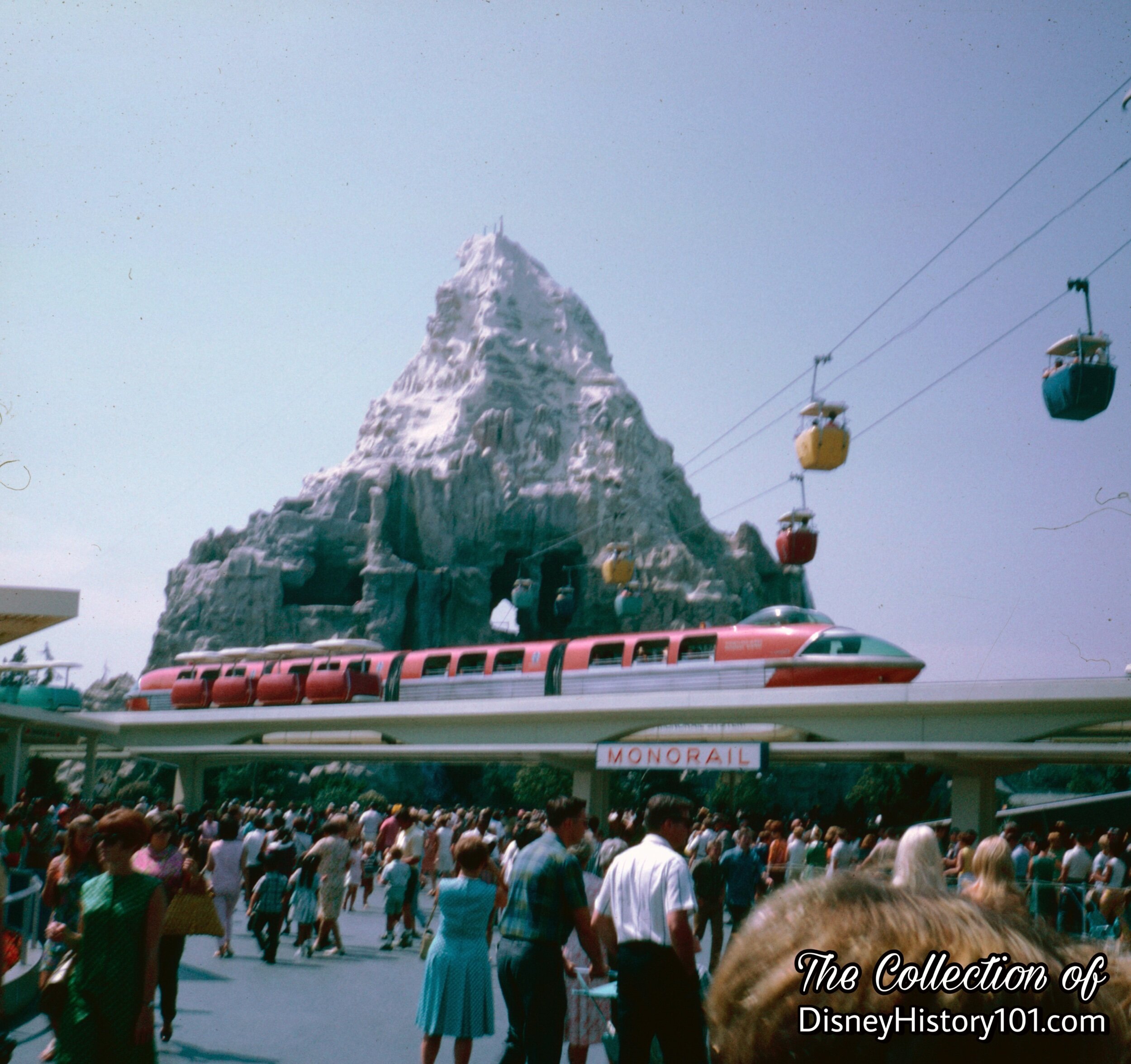
REENTERING THE PARK AND TOMORROWLAND SEGMENT - Monorail Mark II Red, (1967)
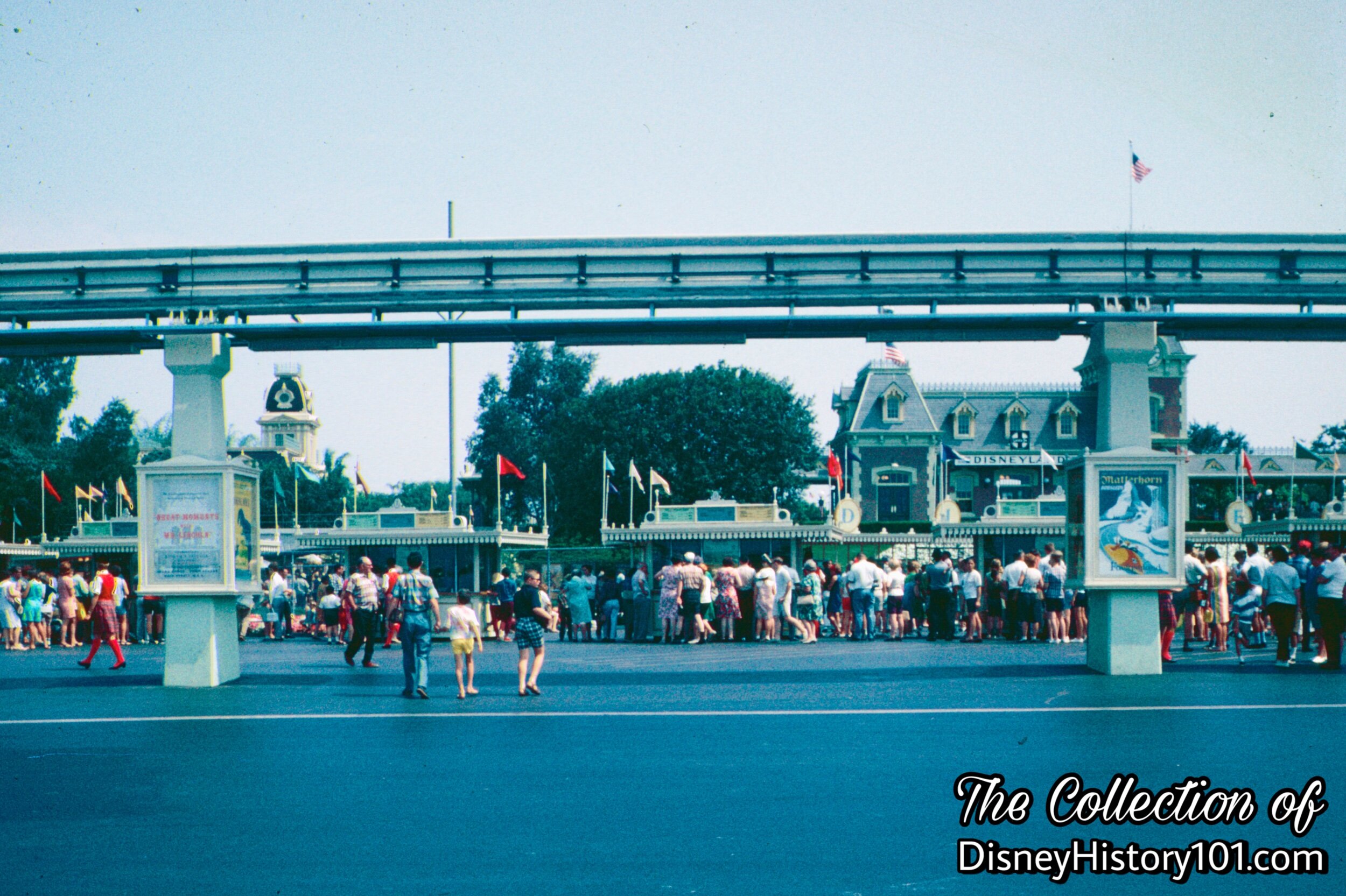
Disneyland-ALWEG Monorail System near the Ticket Booths and Main Gate Area, (1967)
This Vintage View was captured in 1967, but it gives an idea of what Disneyland’s Main Entrance Gate and Ticket Booths look like with the new monorail and pylons towering over guests below!
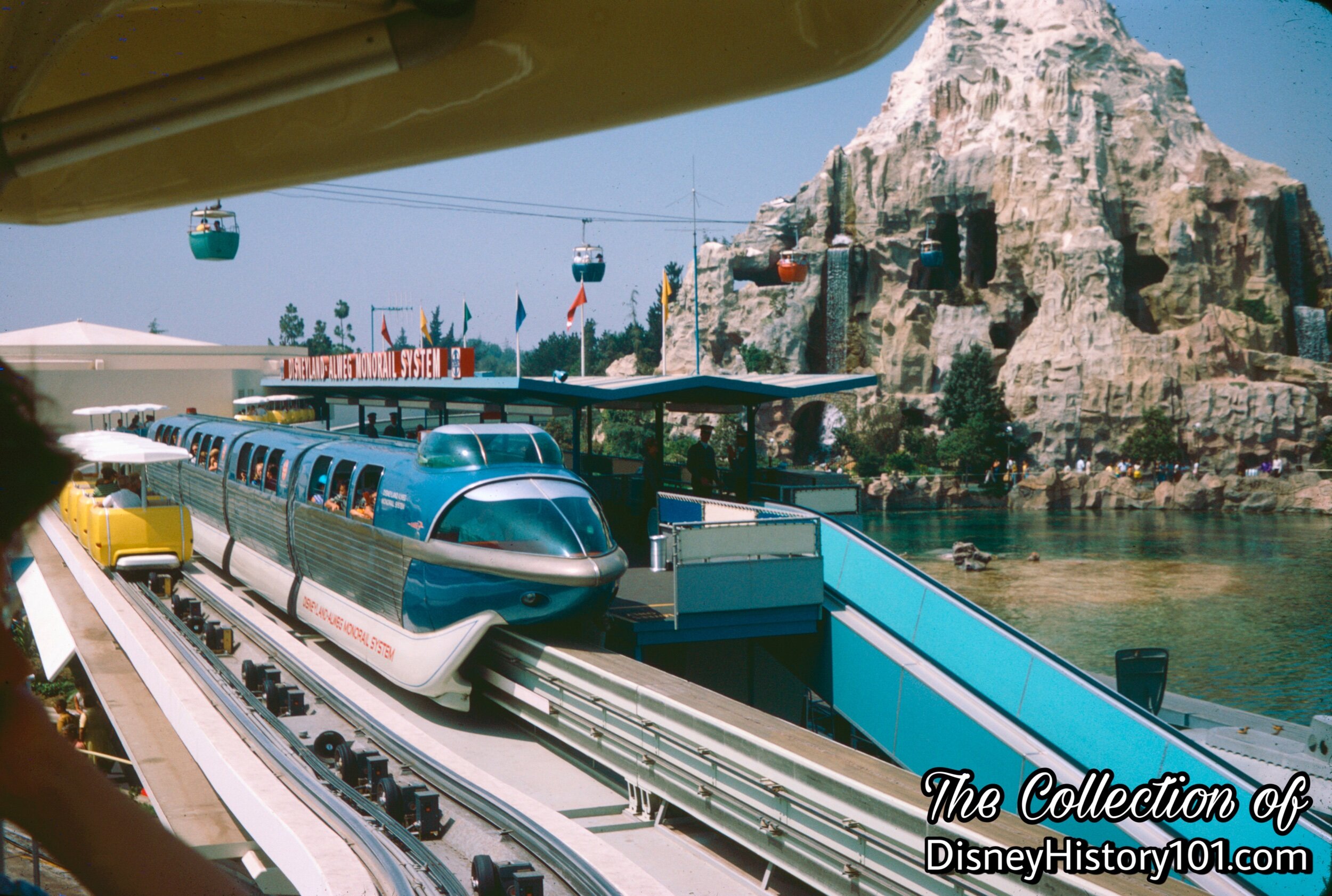
REENTERING THE PARK AND TOMORROWLAND SEGMENT - Monorail Mark II Blue, 1967.
Do you see those copper and steel bus-bars mounted along the right side of the beam?
Back in 1958 and 1959, some initial Monorail designs detailed how power to the train motors was to be supplied “by two steel and copper bus bars which are installed on one side of the beamway, carrying 300 volts.“ This power was to be ”supplied from a 600 amp silicon diode rectifier to the bus bar system at five points along the main track.” The bus bar was to be covered by a continuous aluminum shield for the protection of maintenance personnel. Back then, it was believed that this method provided enough power to drive the two 50 horsepower direct current traction motors belonging to each of the three-car trains. It was even stated that these motors would “have a capacity of sufficient energy to operate a four-car train.”
Now (by 1967), some 600 volts of direct current run through them in order to power the four 55 horse power direct current traction motors of the four-car Monorail trains. How was the power collected? The positive bus bar was mounted eight inches above the negative bus bar (with the collector surfaces facing each other). With the help of two electrical trolleys (or “shoes”) per train mounted on the same side of the beam, four spring-loaded flanged nylon wheels with carbon brushes would rub against the bus-bars. From the collectors, power was fed to the main breaker, then the sub breakers to power the air conditioning, air compressor, controls, door openers, and more. These essential components (the bus-bars) were easily viewed up-close from the PeopleMover (see the Vintage View above), but not from the Speedramp that guests would take to depart from the Tomorrowland Monorail Station Platform. On that note, contrary to what appeared on the “April Fools” cover of Disneyland LINE vol.13, no.13, (published April 1, 1981), the PeopleMovers and Monorail trains ran on two separate currents and two separate rails (as seen in the Vintage View above).

A c.1966 Tomorrowland Transportation Size Comparison by Sam McKim (once available through The Disney Gallery); ©️The Walt Disney Company.
From January 2, 1966 to March 19, the Monorail stopped operating briefly.
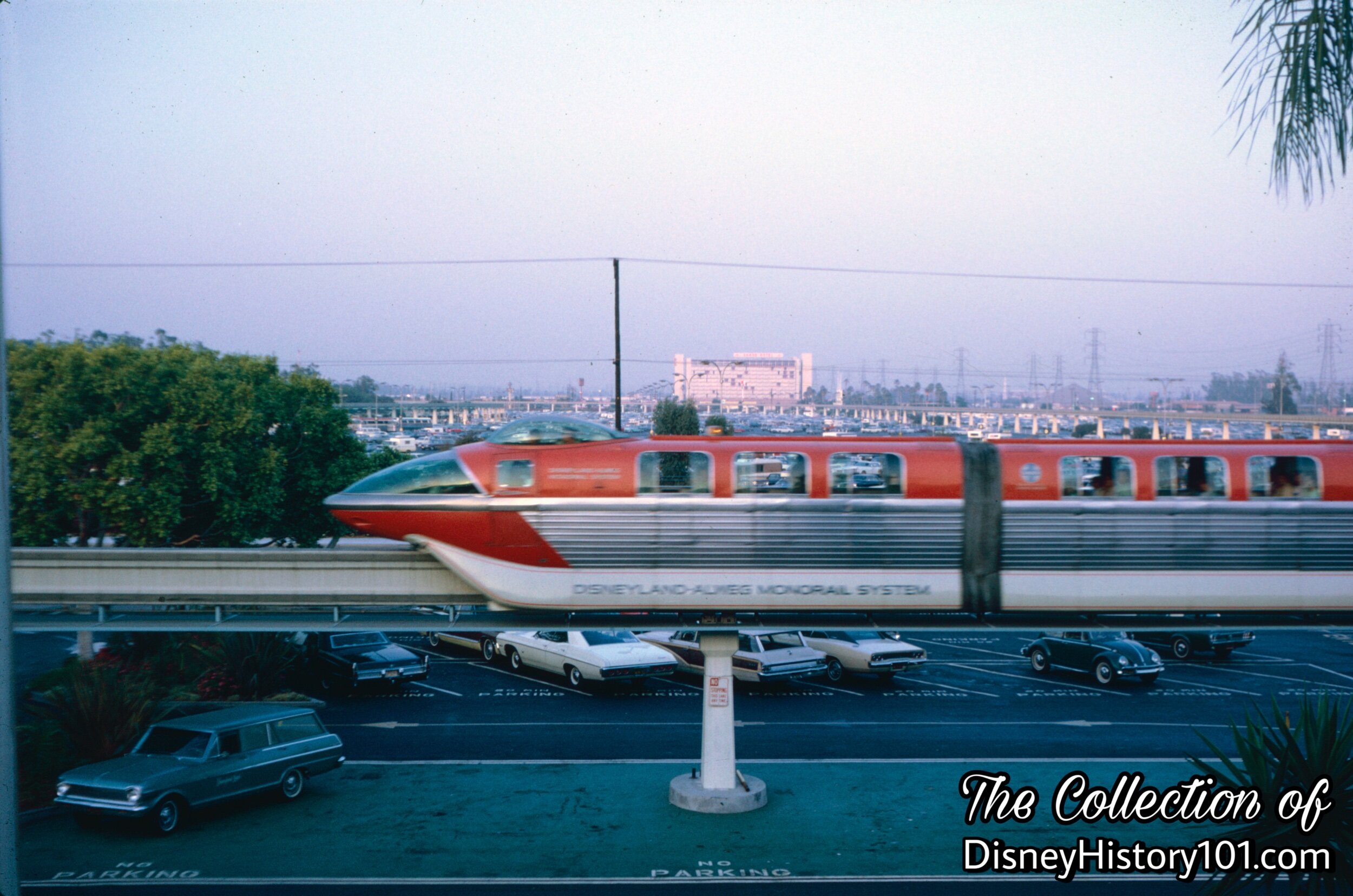
REENTERING THE PARK AND TOMORROWLAND SEGMENT - Monorail Mark II Red, 1968.
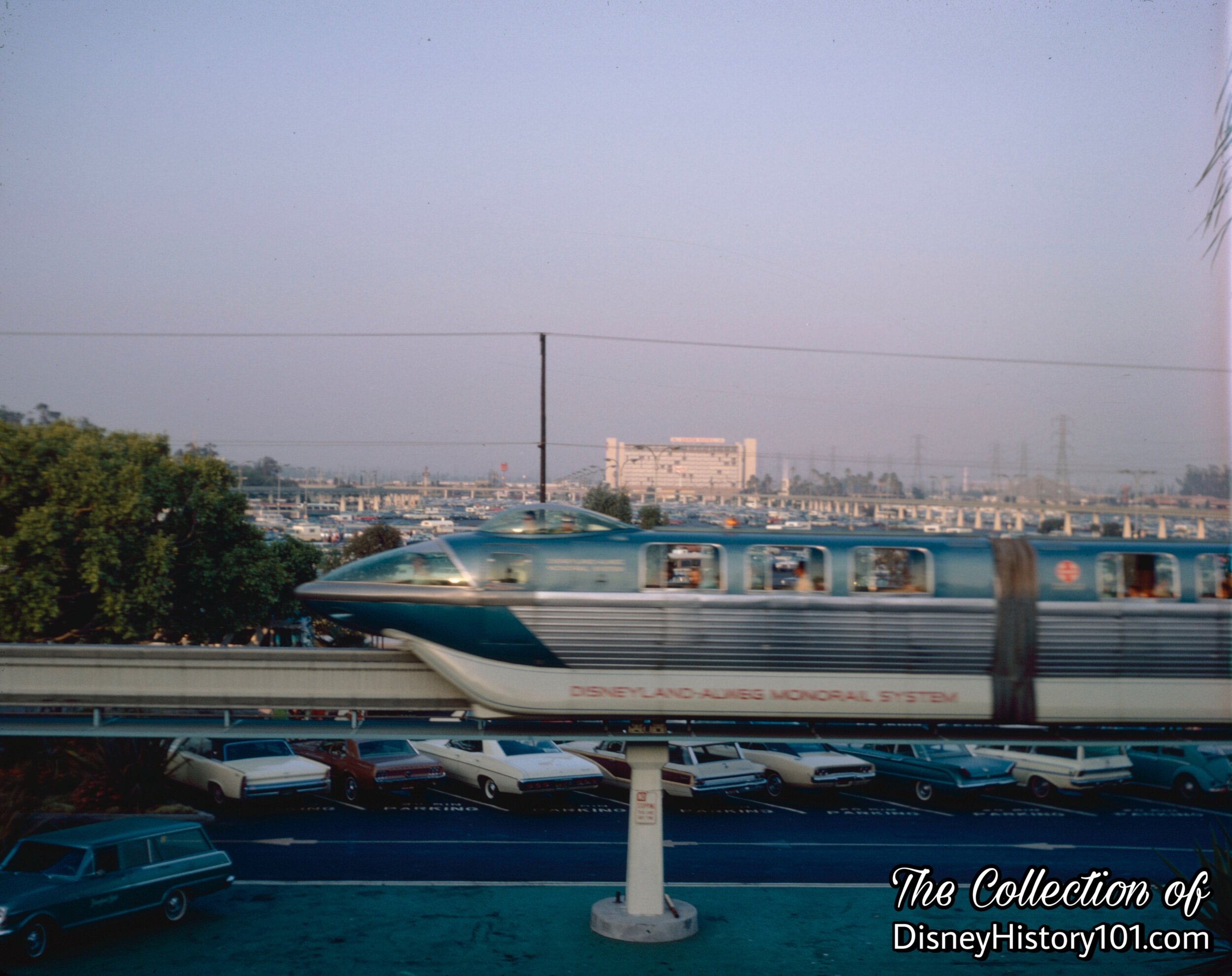
REENTERING THE PARK AND TOMORROWLAND SEGMENT - Monorail Mark II Blue, 1968.
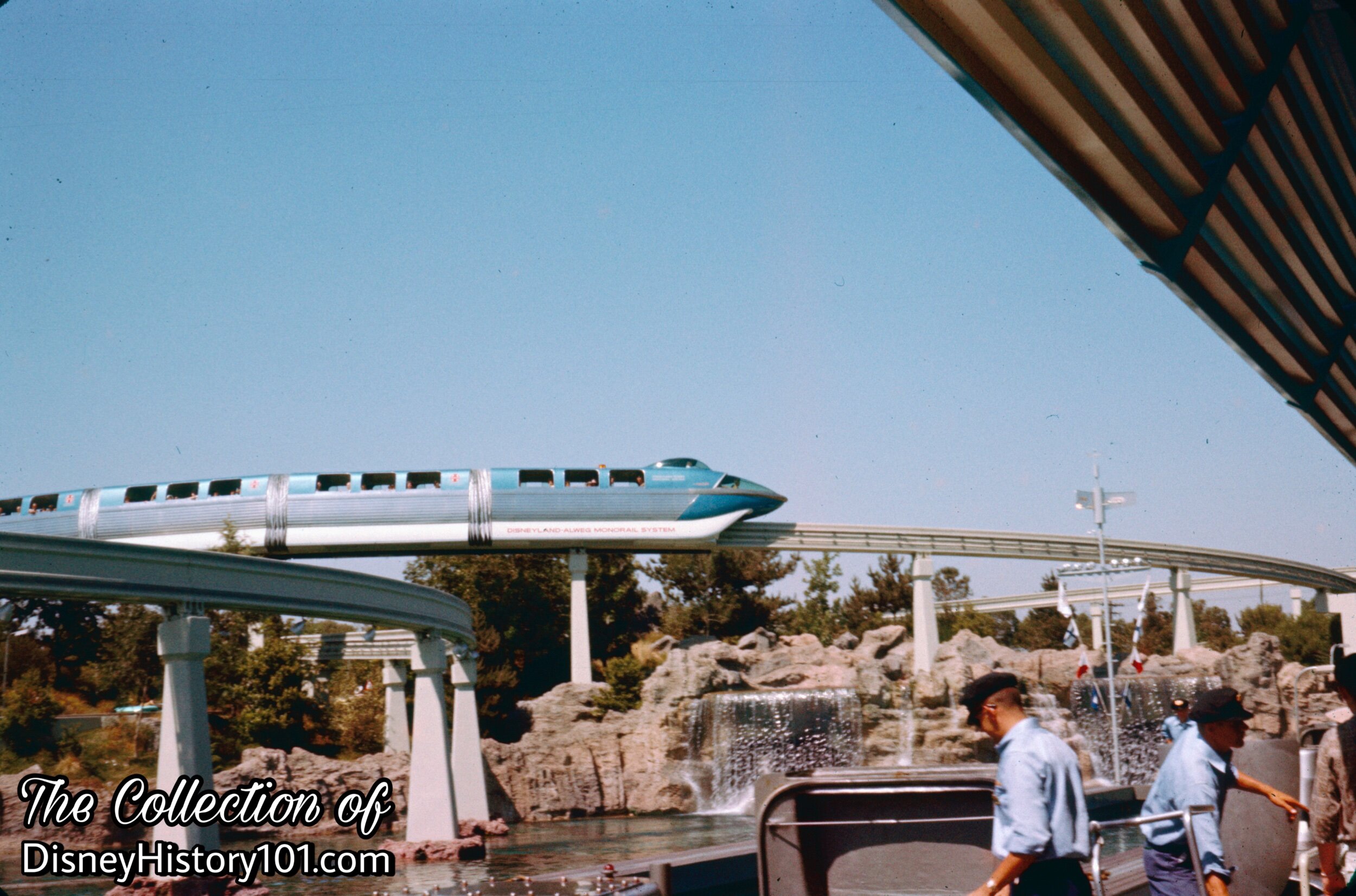
REENTERING THE PARK AND TOMORROWLAND SEGMENT - Monorail Mark II Blue
Re-entering the park, the Monorail reaches its highest point, 31 feet, which gives guests a most spectacular view of the Tomorrowland area.
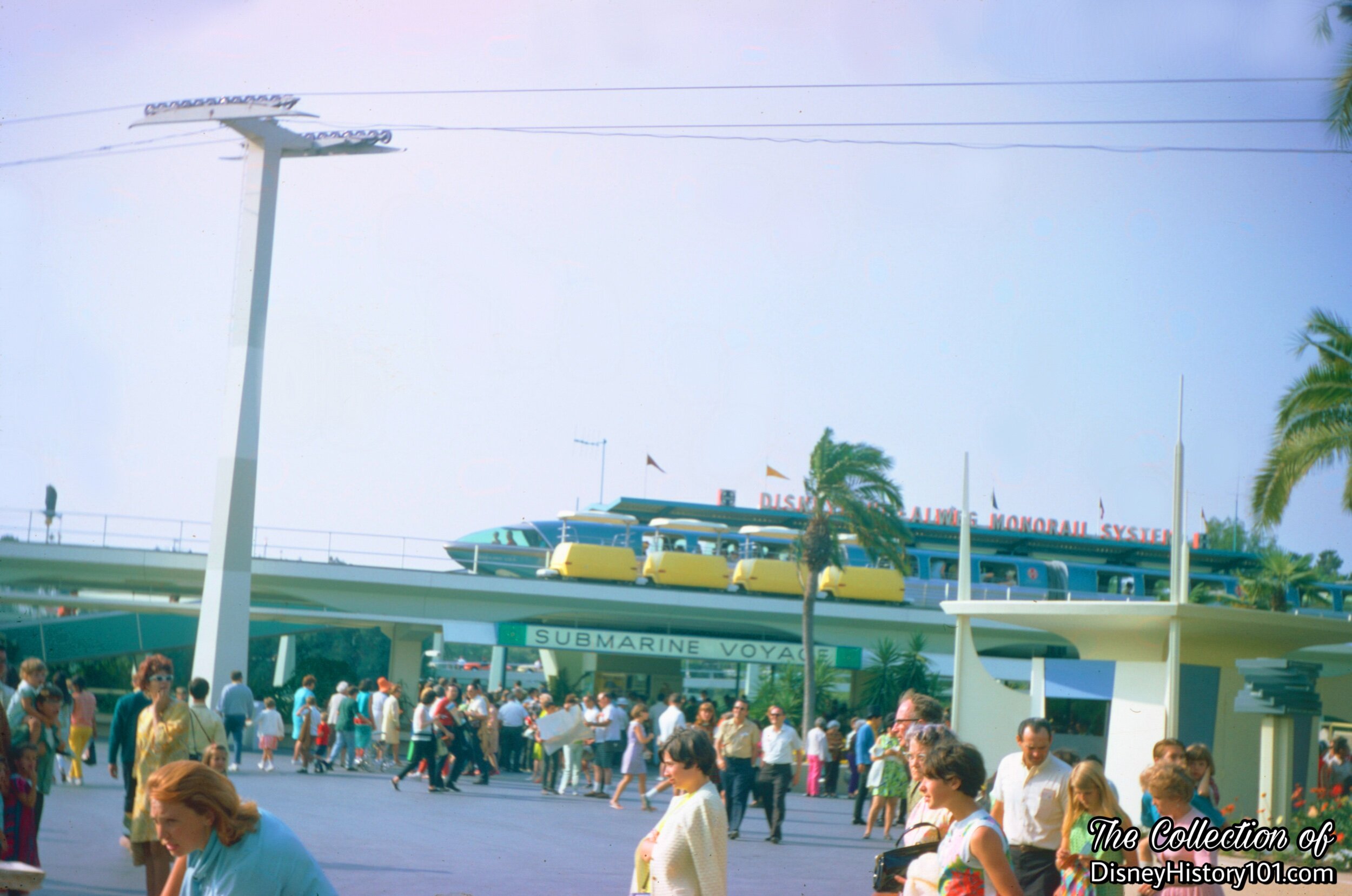
REENTERING THE PARK AND TOMORROWLAND SEGMENT - Monorail Mark II Blue
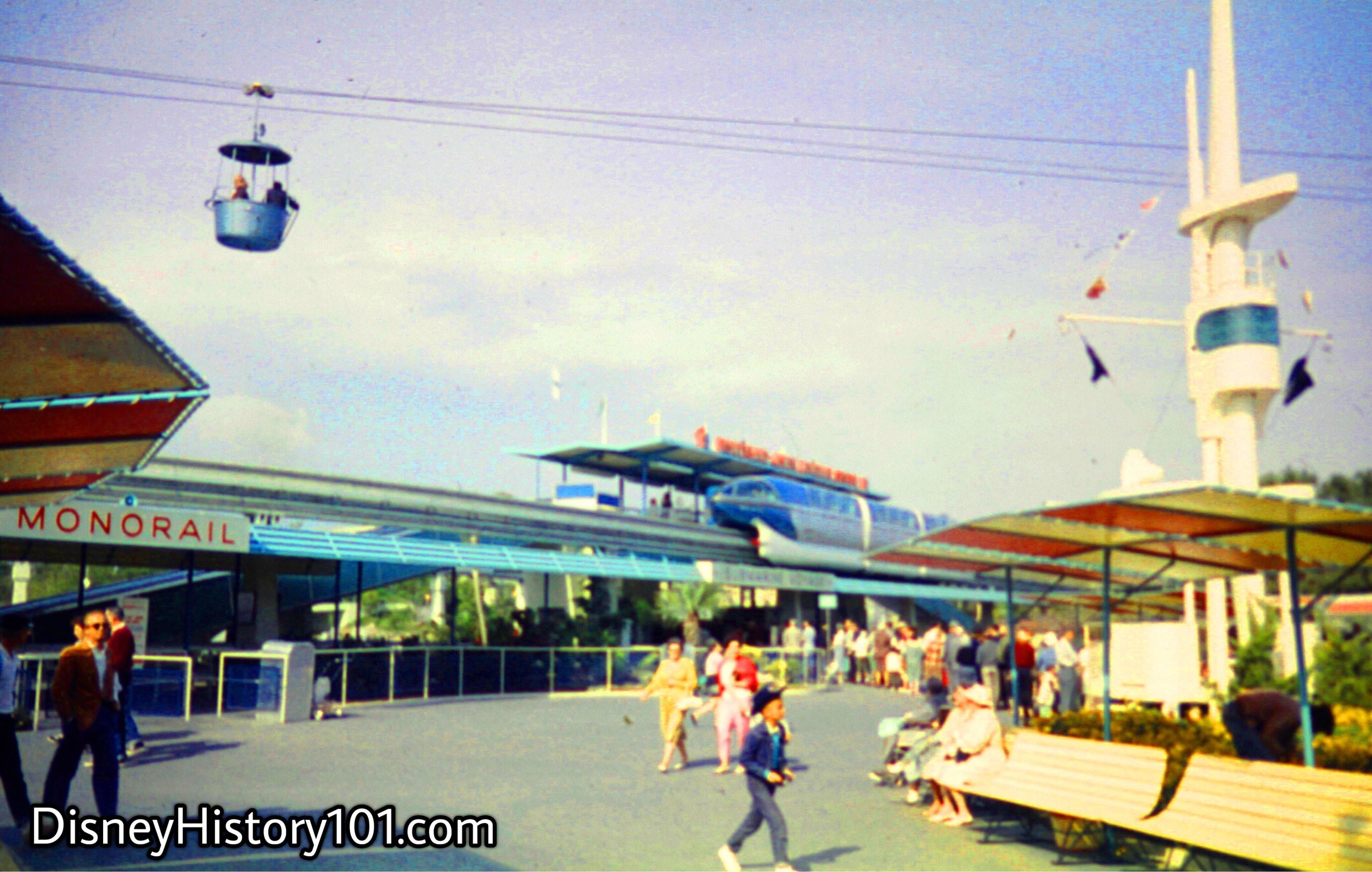
REENTERING THE PARK AND TOMORROWLAND SEGMENT - Monorail Mark II Blue
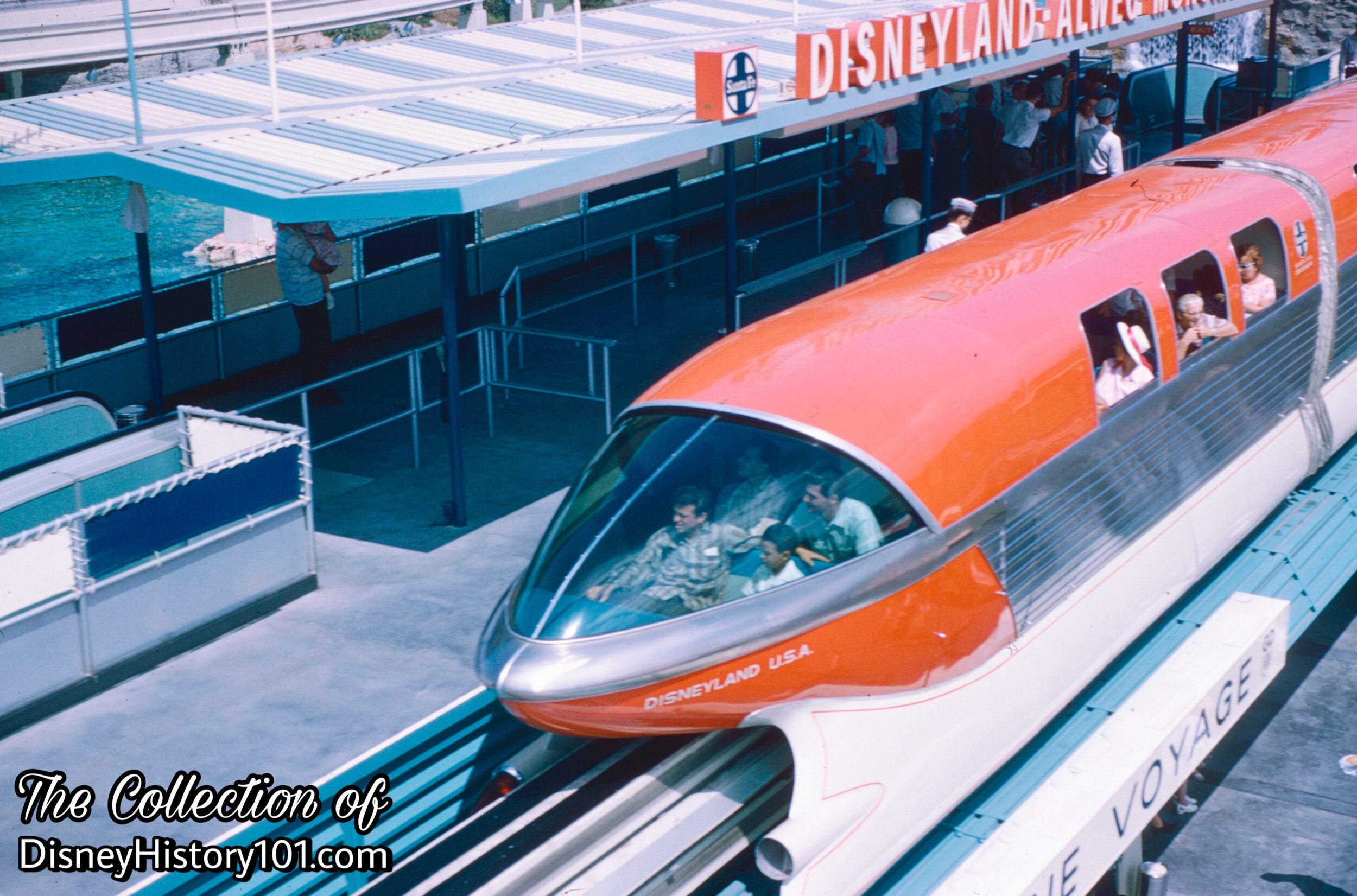
The tail cone of the Monorail Mark II Red missing one bulb.
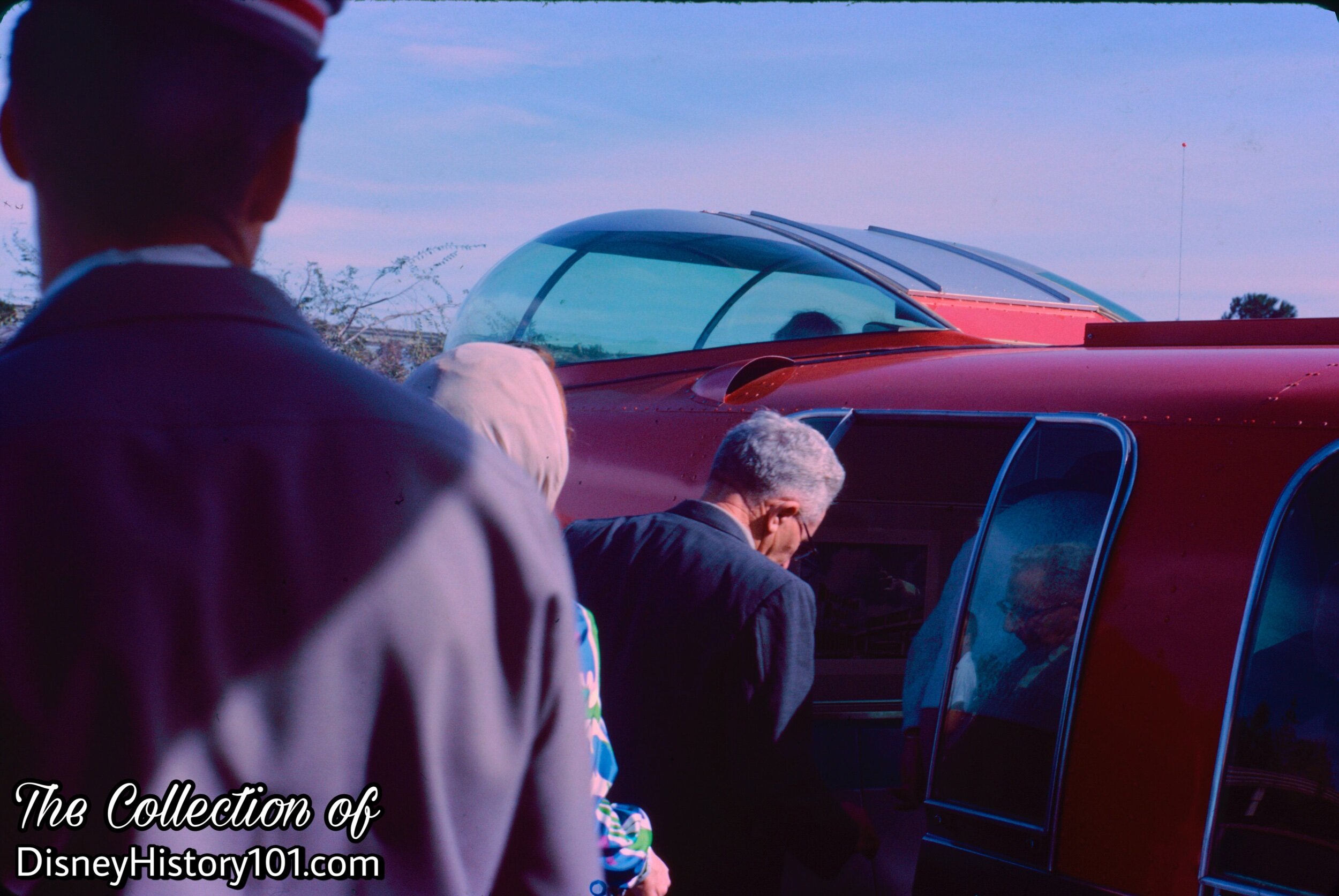
Guests entering the nose cone of the Monorail Mark II Red

REENTERING THE PARK AND TOMORROWLAND SEGMENT - Monorail Mark II Yellow
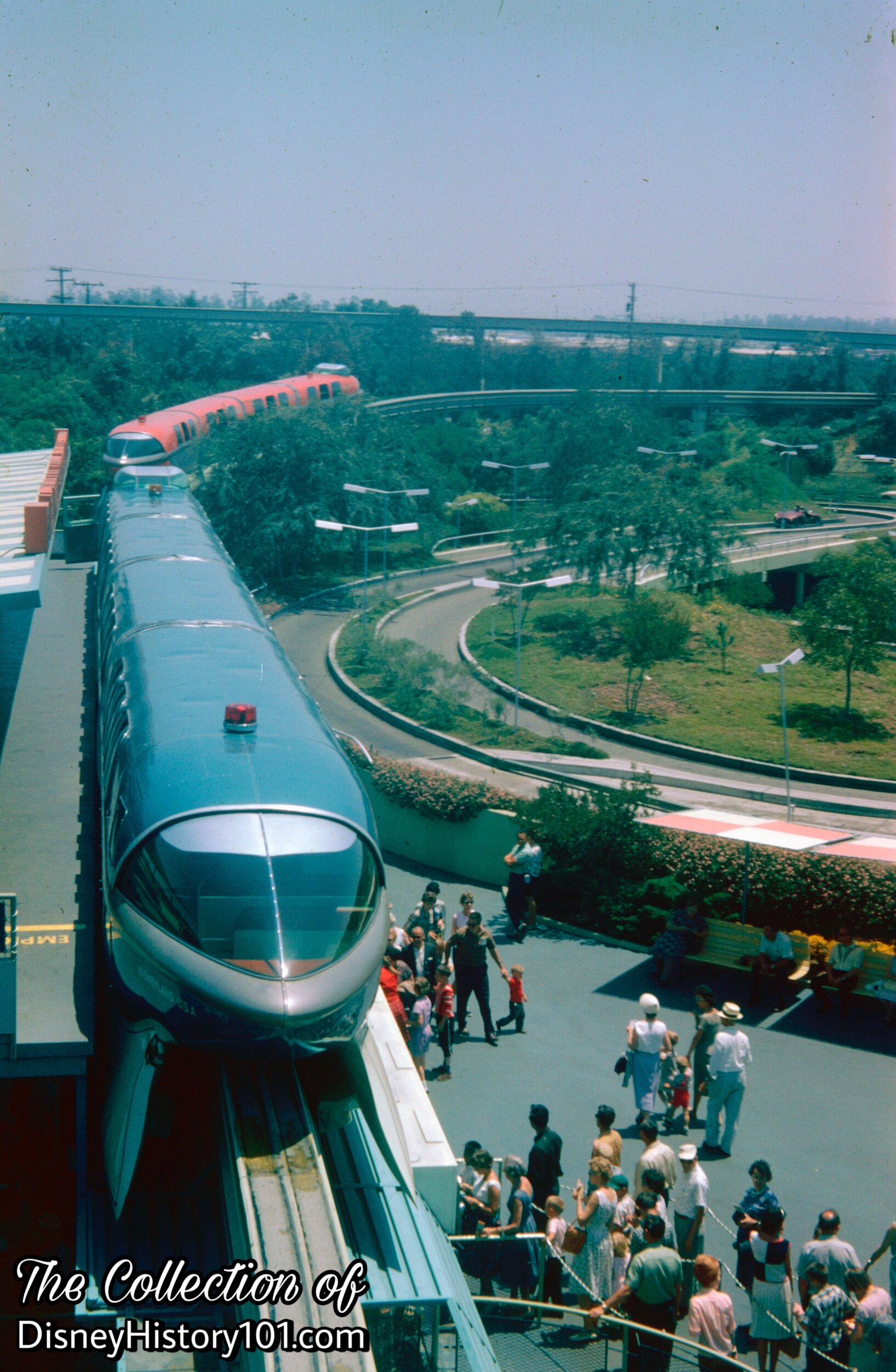
REENTERING THE PARK AND TOMORROWLAND SEGMENT - The dual-coach Monorail Mark II Blue & Monorail Mark II Red.
This is a rare scene, because Monorail trains generally didn’t operate so close to each other. The Automatic Block System detected the presence of a train in any designated section of track, which was displayed by the cab control system in the control compartment. Owing to this, trains were usually spread out across the line.
Above, the Monorail beamway winds over the Autopia, “freeway of the future.”
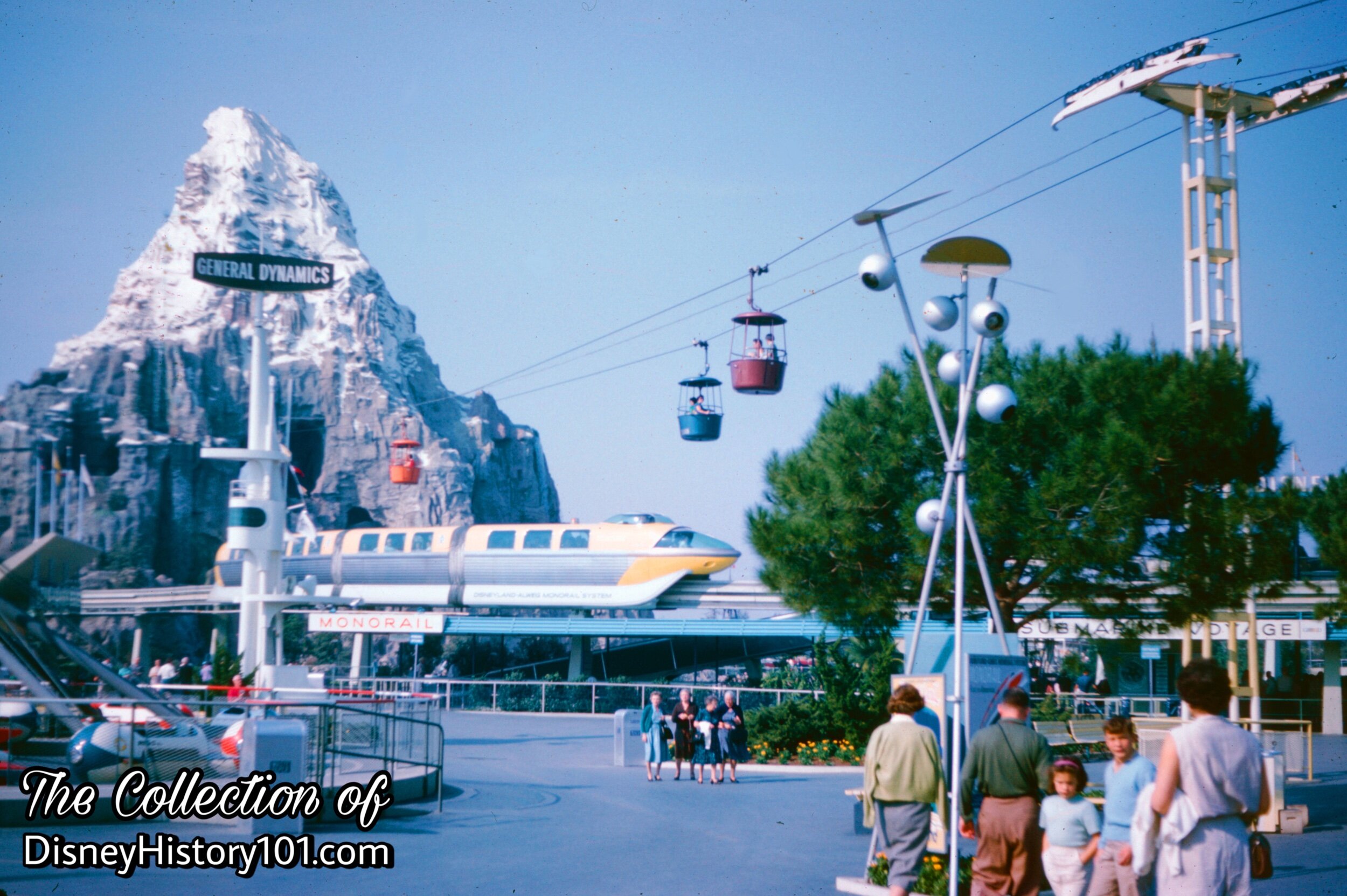
REENTERING THE PARK AND TOMORROWLAND SEGMENT - Monorail Mark II Yellow
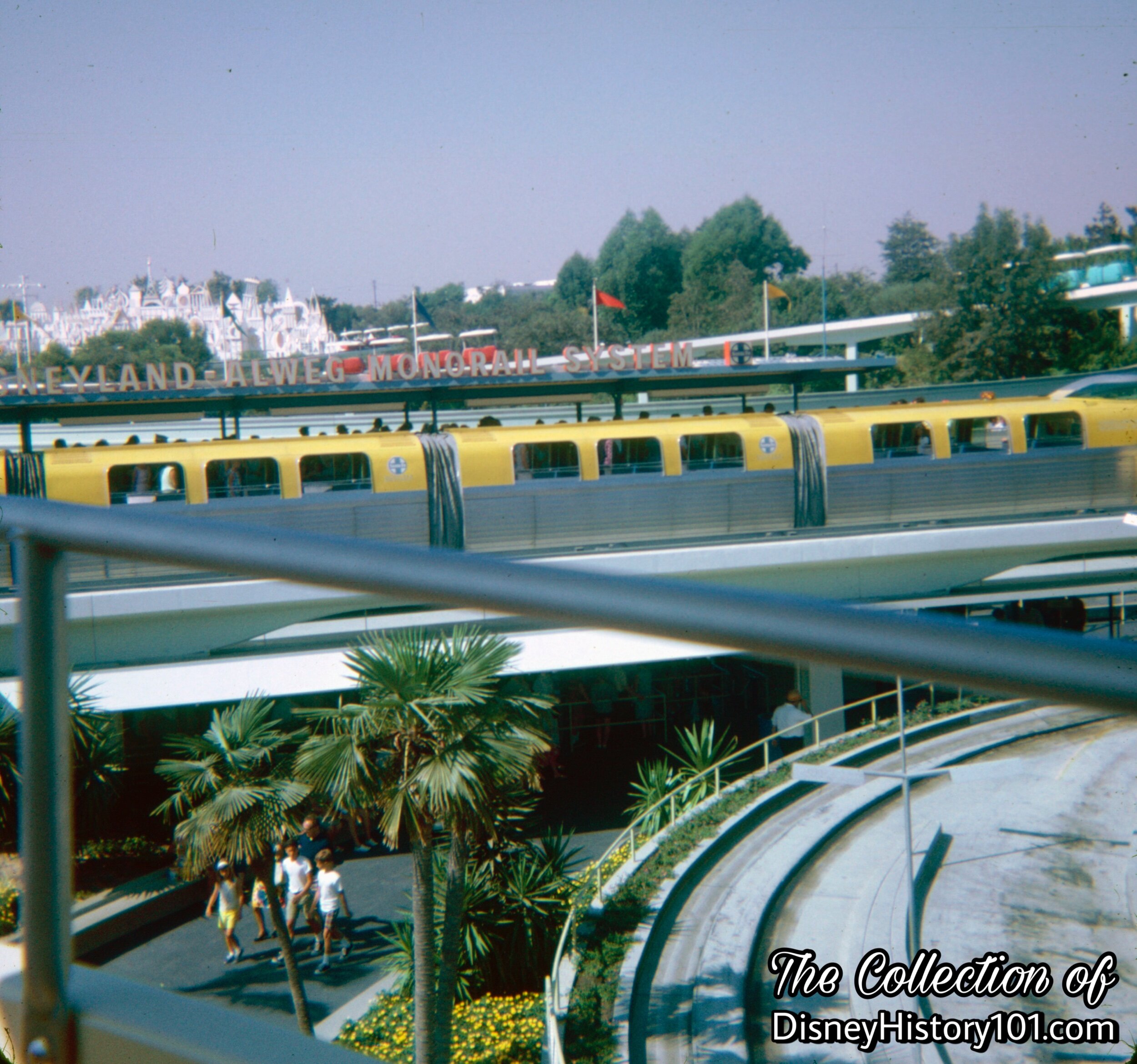
REENTERING THE PARK AND TOMORROWLAND SEGMENT - Monorail Mark II Yellow
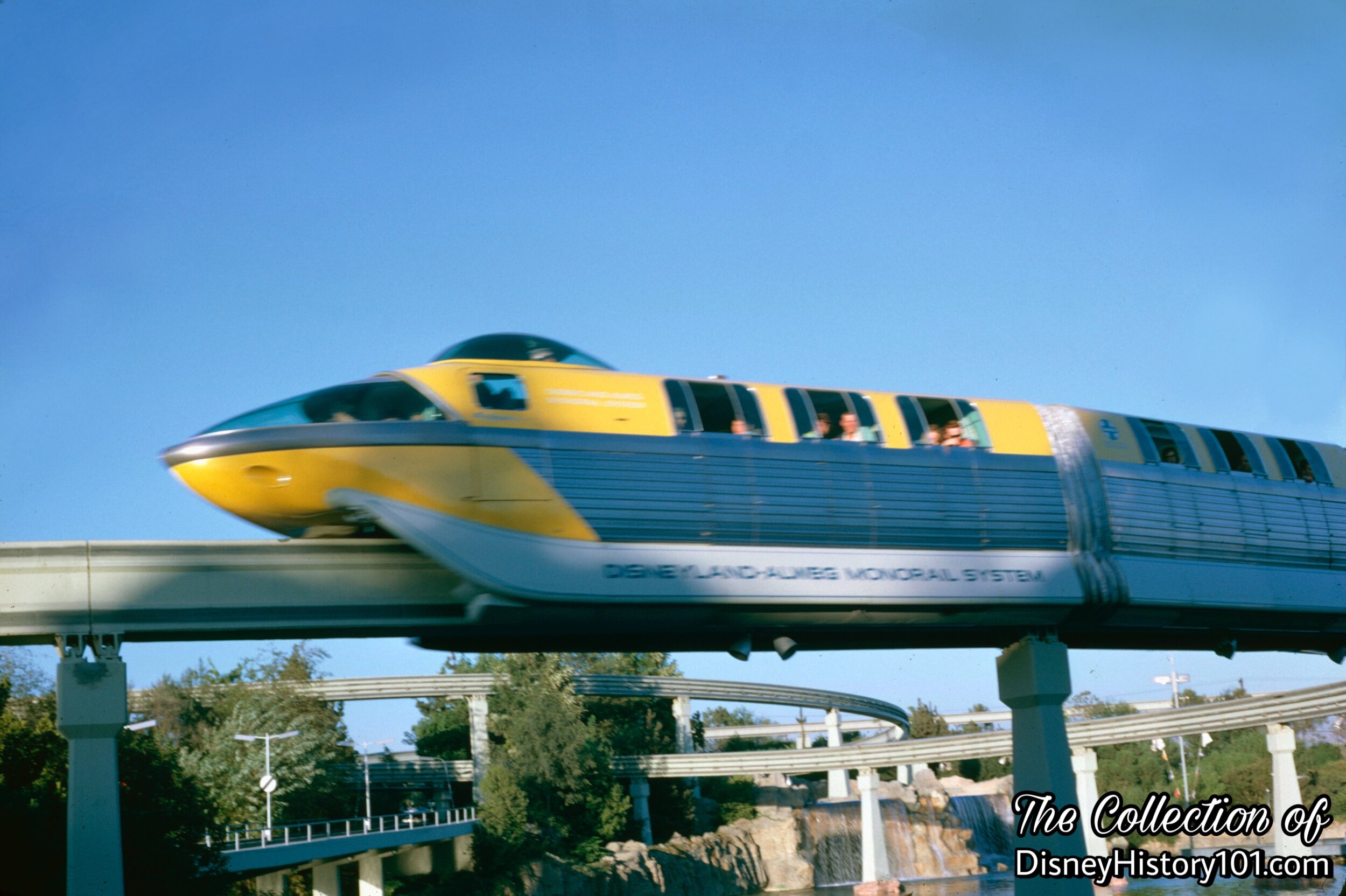
REENTERING THE PARK AND TOMORROWLAND SEGMENT - Monorail Mark II Yellow
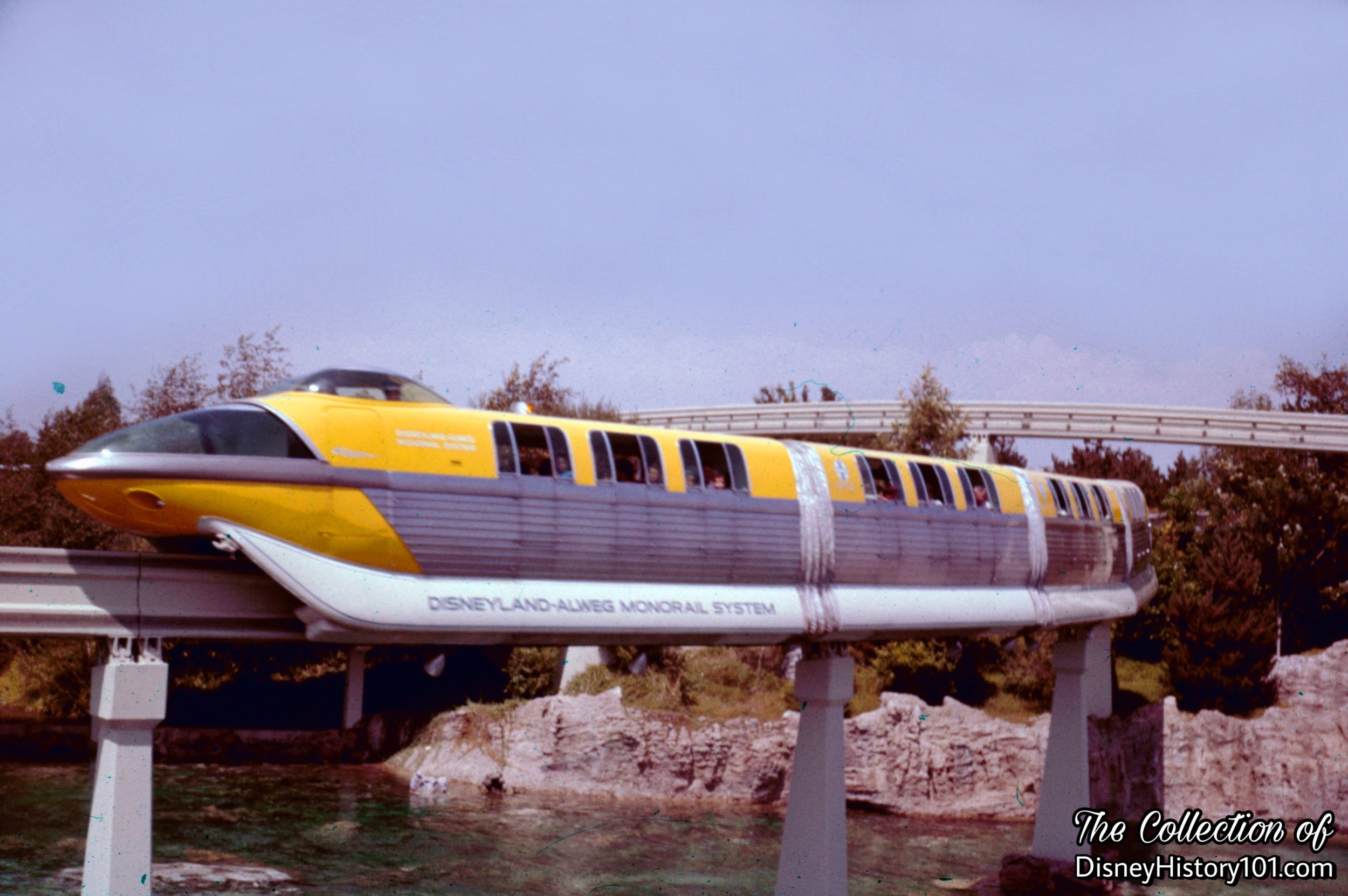
REENTERING THE PARK AND TOMORROWLAND SEGMENT - Monorail Mark II Yellow
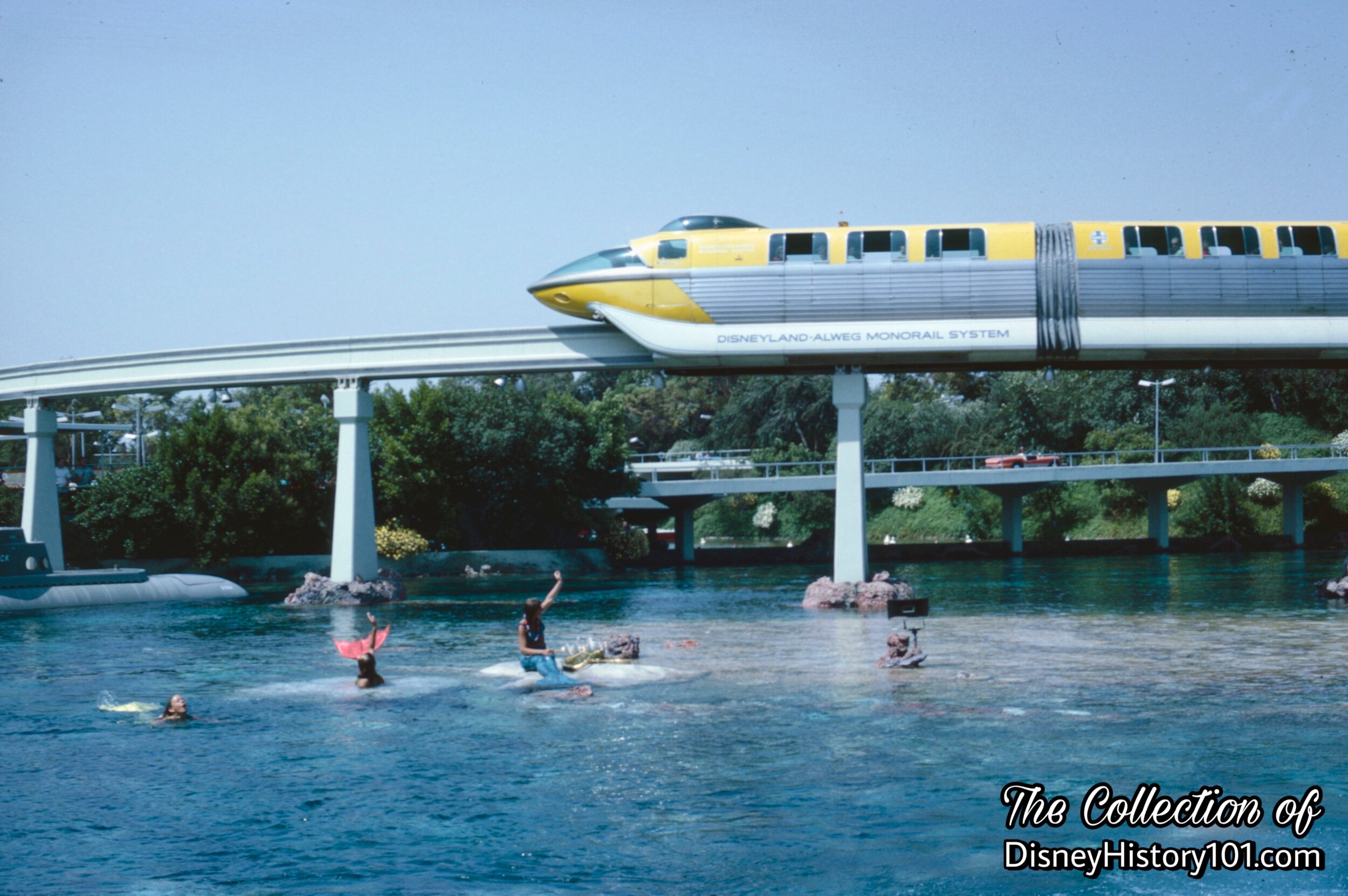
REENTERING THE PARK AND TOMORROWLAND SEGMENT - Mermaids from Mythical Times greet the Monorail Mark II Yellow.
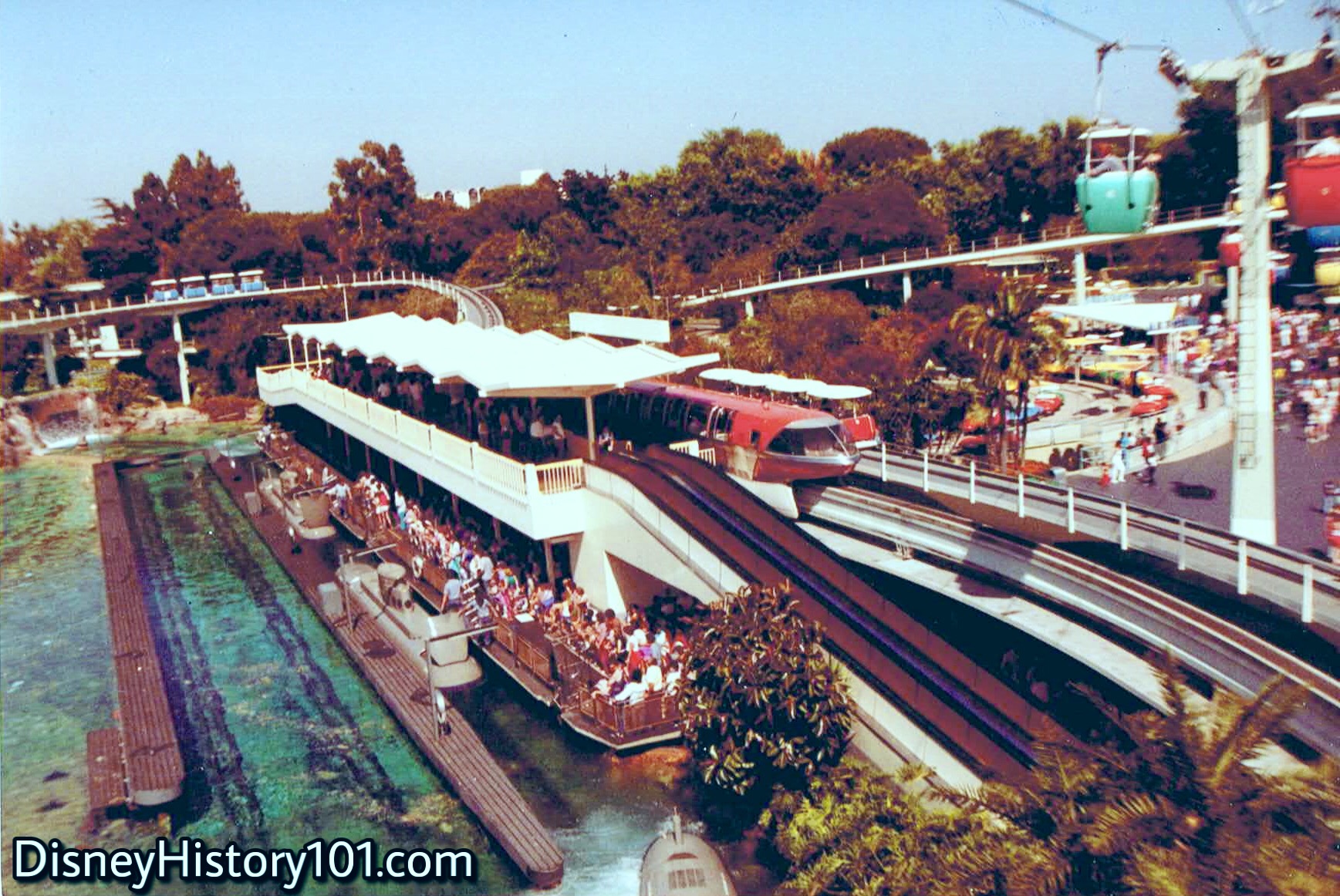
REENTERING THE PARK AND TOMORROWLAND SEGMENT - Monorail Mark II Red
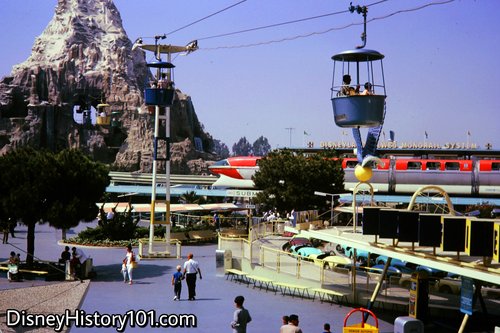
REENTERING THE PARK AND TOMORROWLAND SEGMENT - Monorail Mark II Red
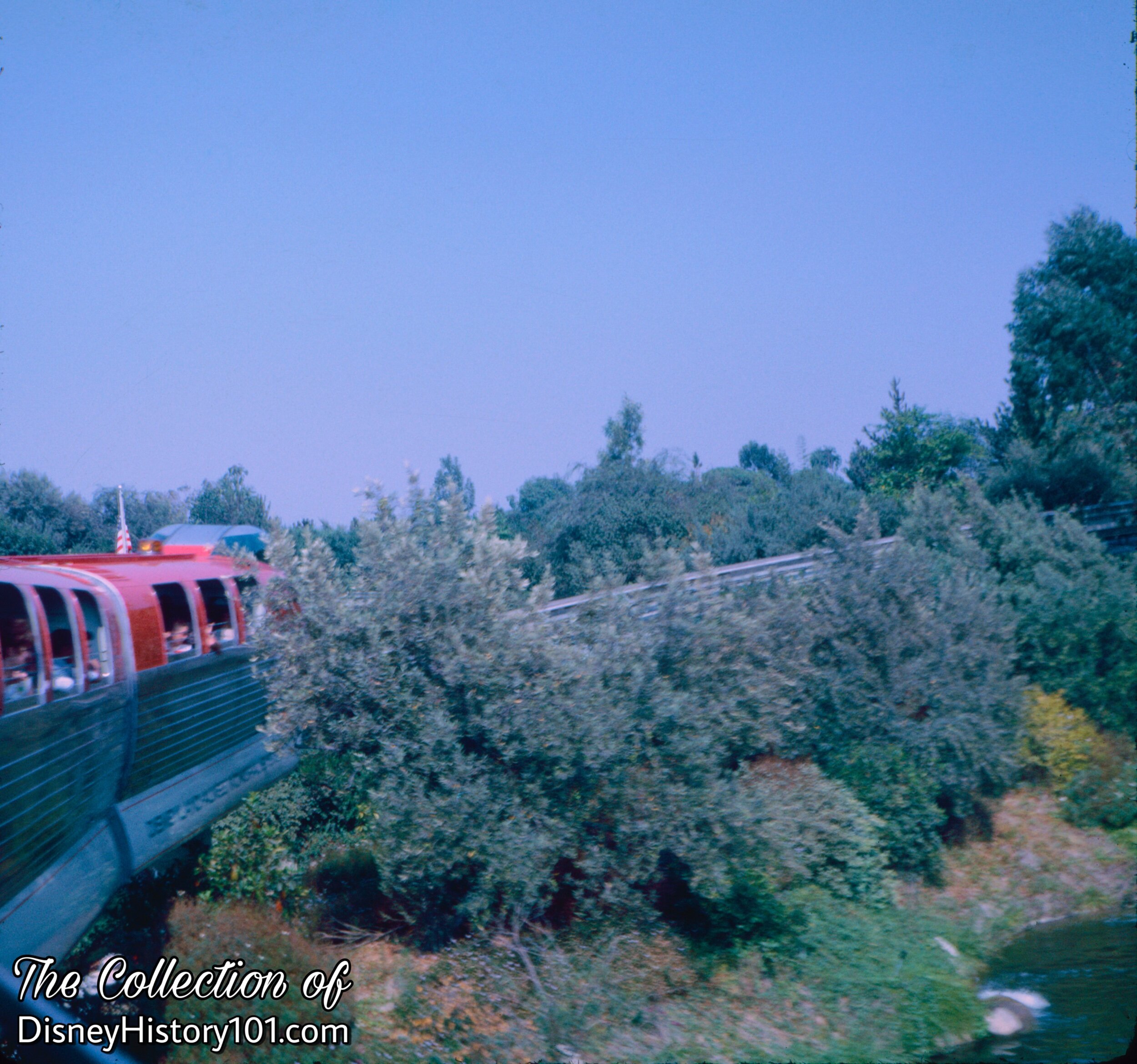
REENTERING THE PARK AND TOMORROWLAND SEGMENT - Monorail Mark II Red, (1964)
“From Tomorrowland the elevated, concrete ‘highway in the sky’ rises above the 18-foot high earthen wall which surrounds Disneyland and sweeps southward along a path paralleling Harbor Boulevard”, according to Vacationland magazine, Vacationland, Summer, 1961.
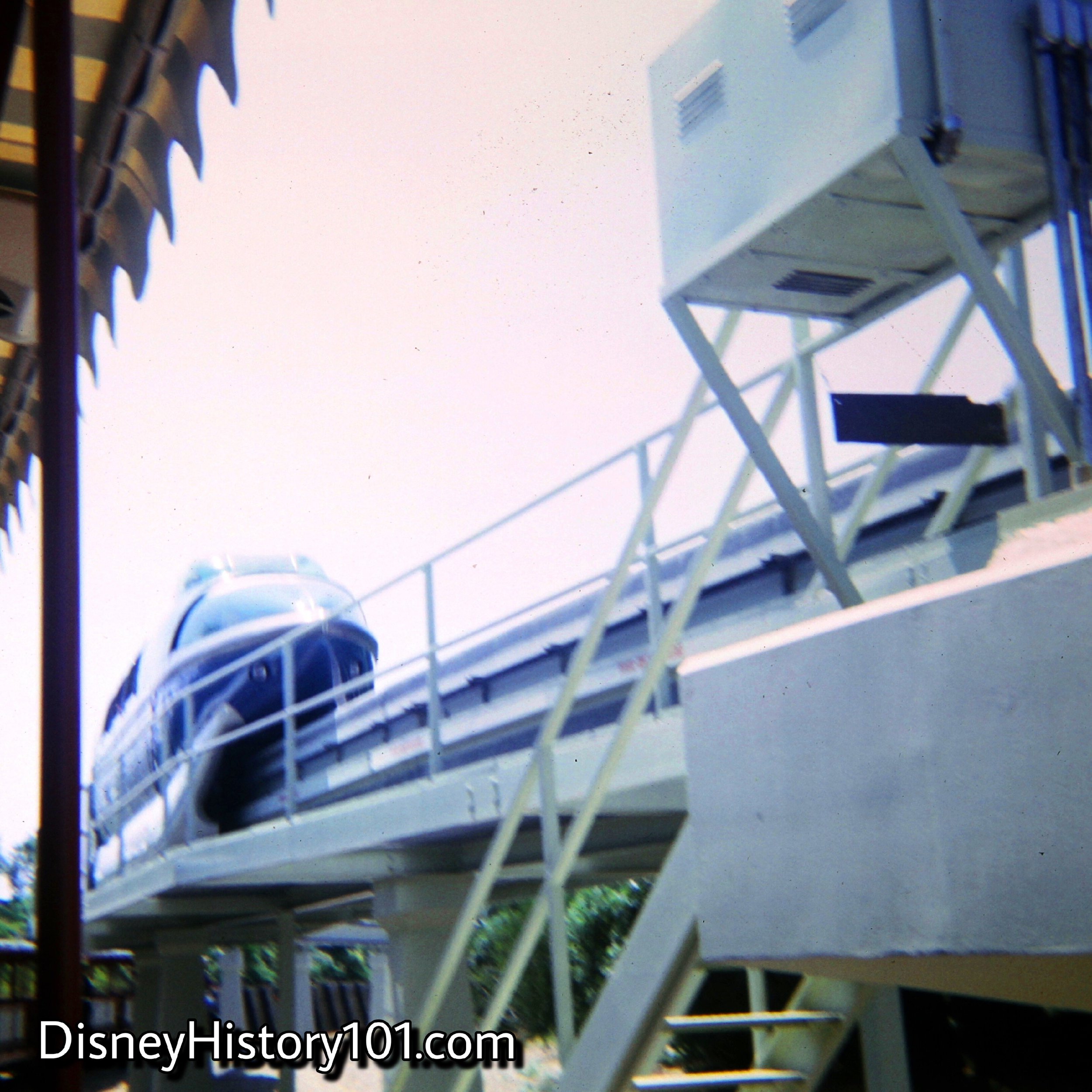
REENTERING THE PARK AND TOMORROWLAND SEGMENT - Monorail Mark II, 1966
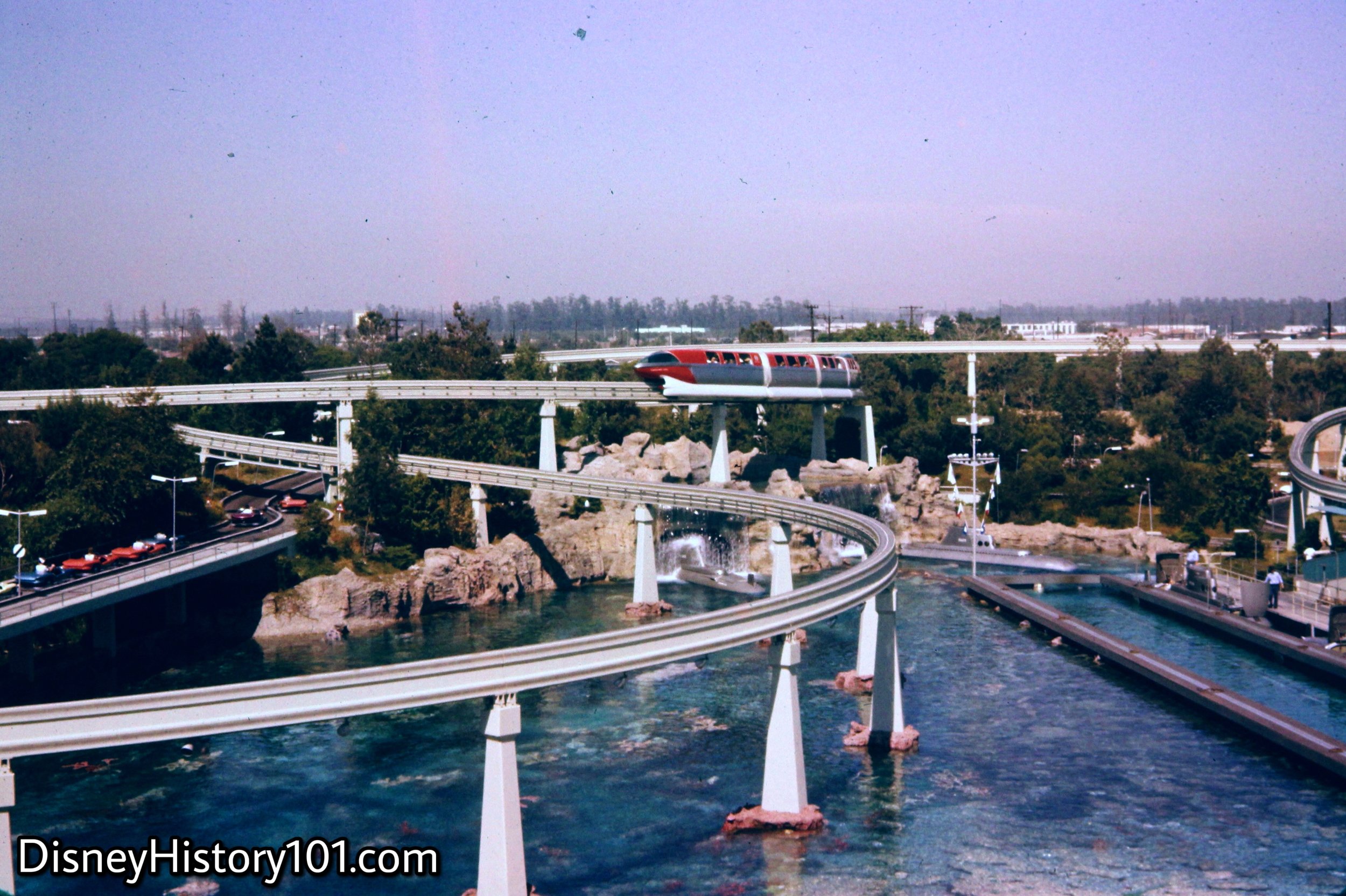
REENTERING THE PARK AND TOMORROWLAND SEGMENT - Monorail Mark II Red.
The tight curves around the Submarine Lagoon necessitate a maximum operating speed of 10 miles per hour. This speed also gives guests an opportunity to enjoy the futuristic scenery of Tomorrowland!

REENTERING THE PARK AND TOMORROWLAND SEGMENT - Monorail Mark II Blue
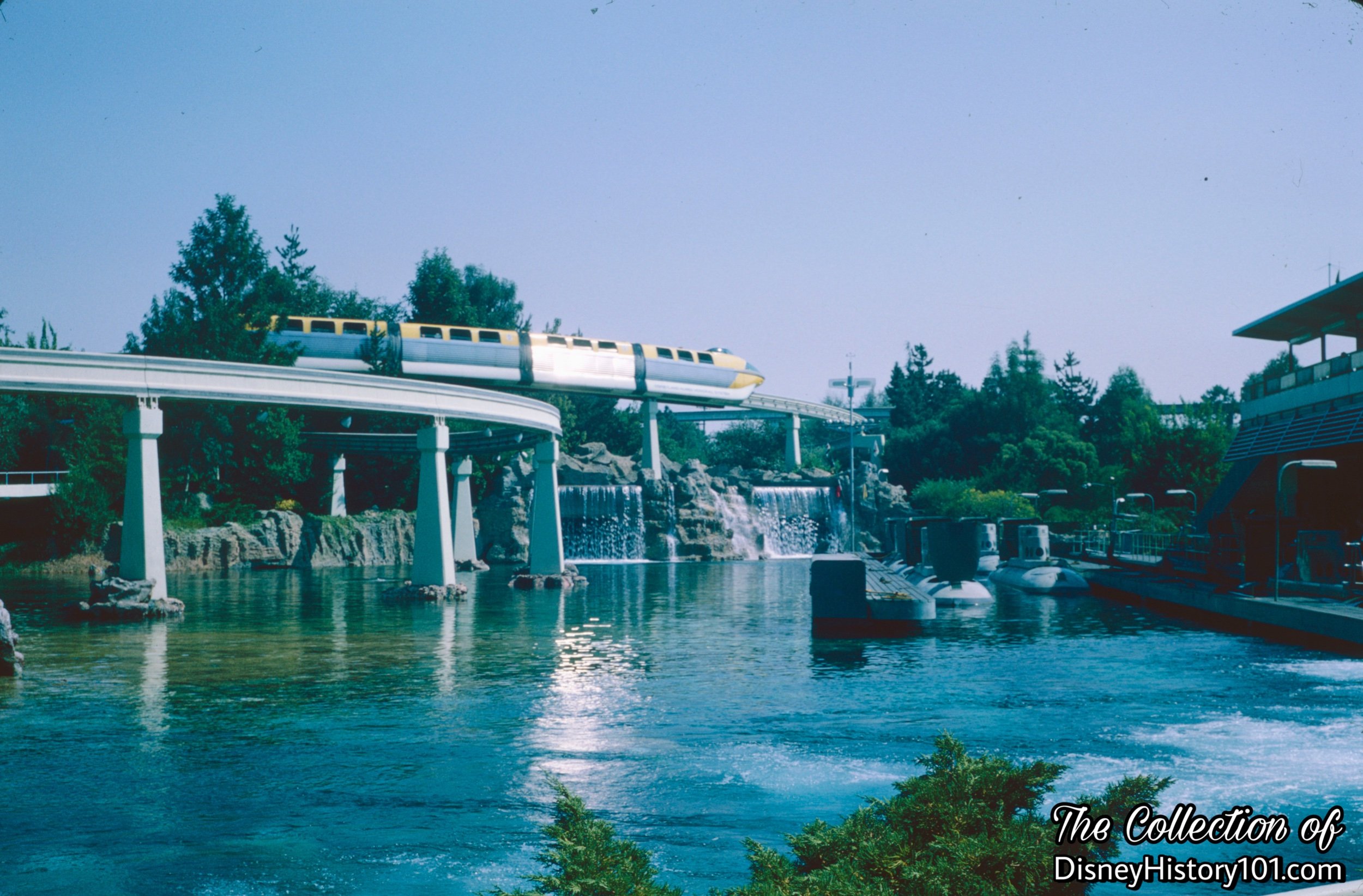
REENTERING THE PARK AND TOMORROWLAND SEGMENT - Monorail Mark II Yellow Reentering the Park, the Monorail reaches its highest point, 31 feet, and affords a spectacular view of Submarine Lagoon, 1965.
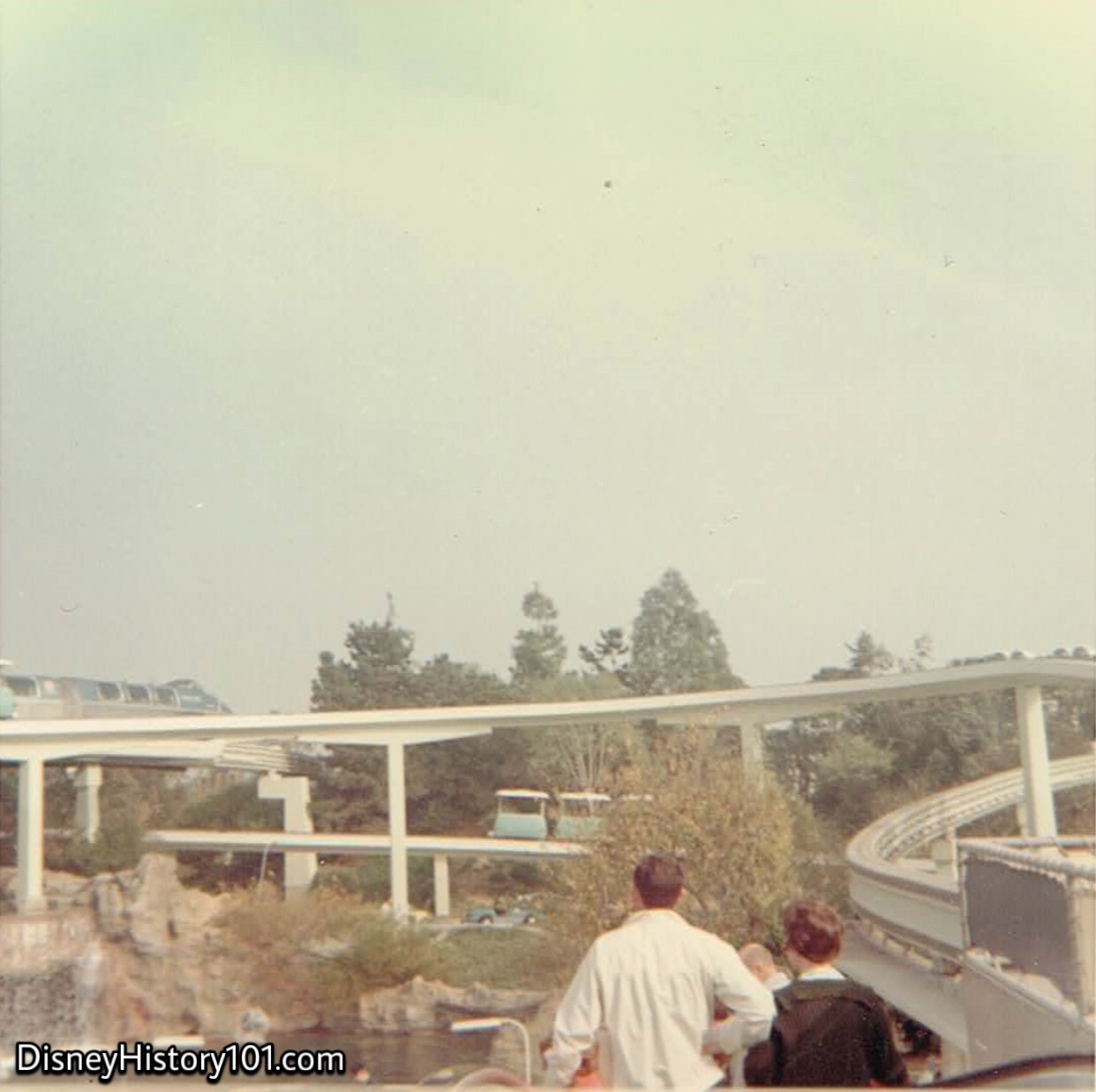
REENTERING THE PARK AND TOMORROWLAND SEGMENT - Monorail Mark II, 1967

REENTERING THE PARK AND TOMORROWLAND SEGMENT - 1967
In the distance, you can see “the happiest cruise to ever set sail”.

1967
Below, you’ll note the Motorboat Cruise’s waterways.
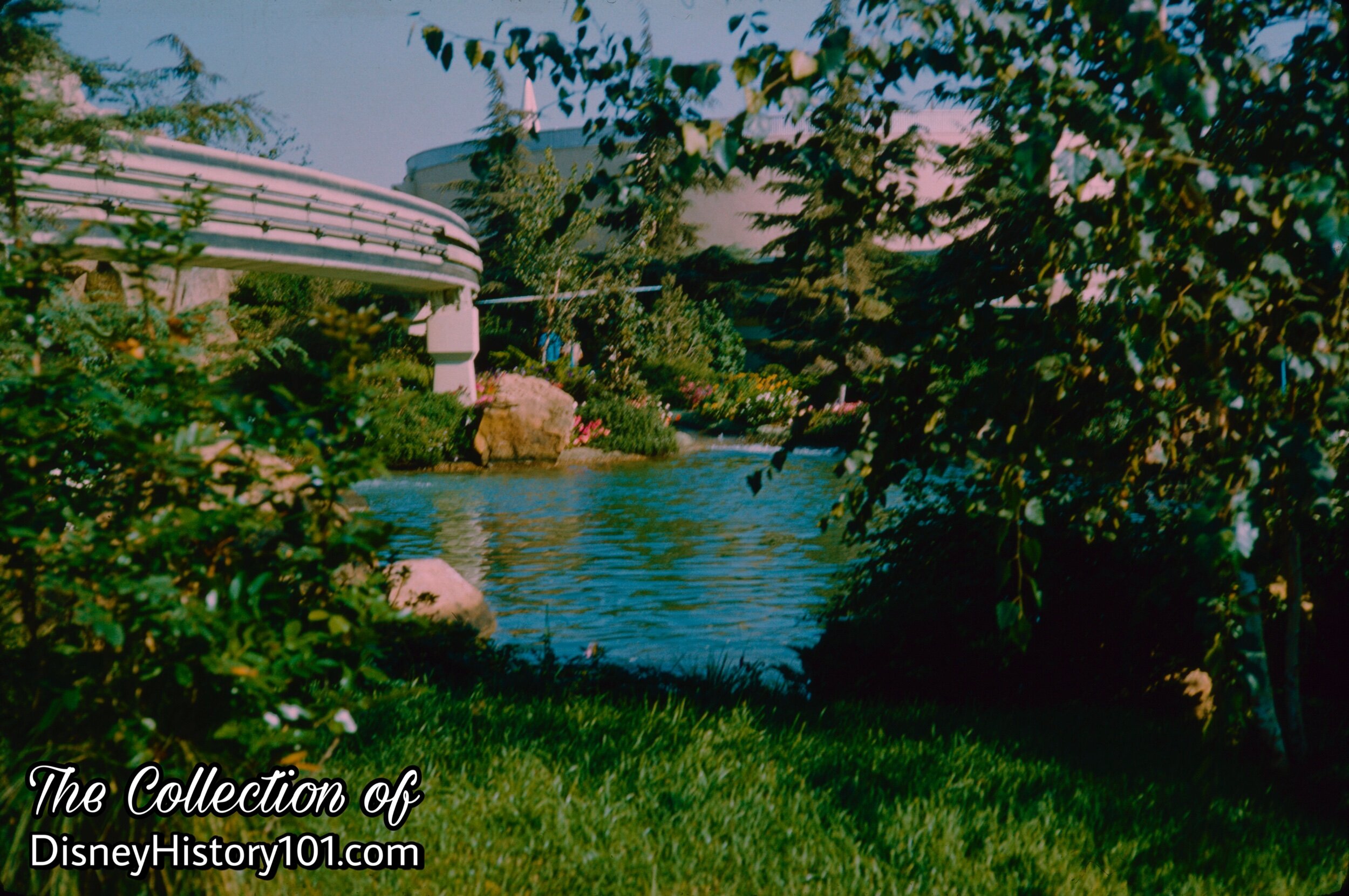
REENTERING THE PARK AND TOMORROWLAND SEGMENT (c. September, 1962)
Here, some of the rails traveled over a pond at the bottom of the Matterhorn.
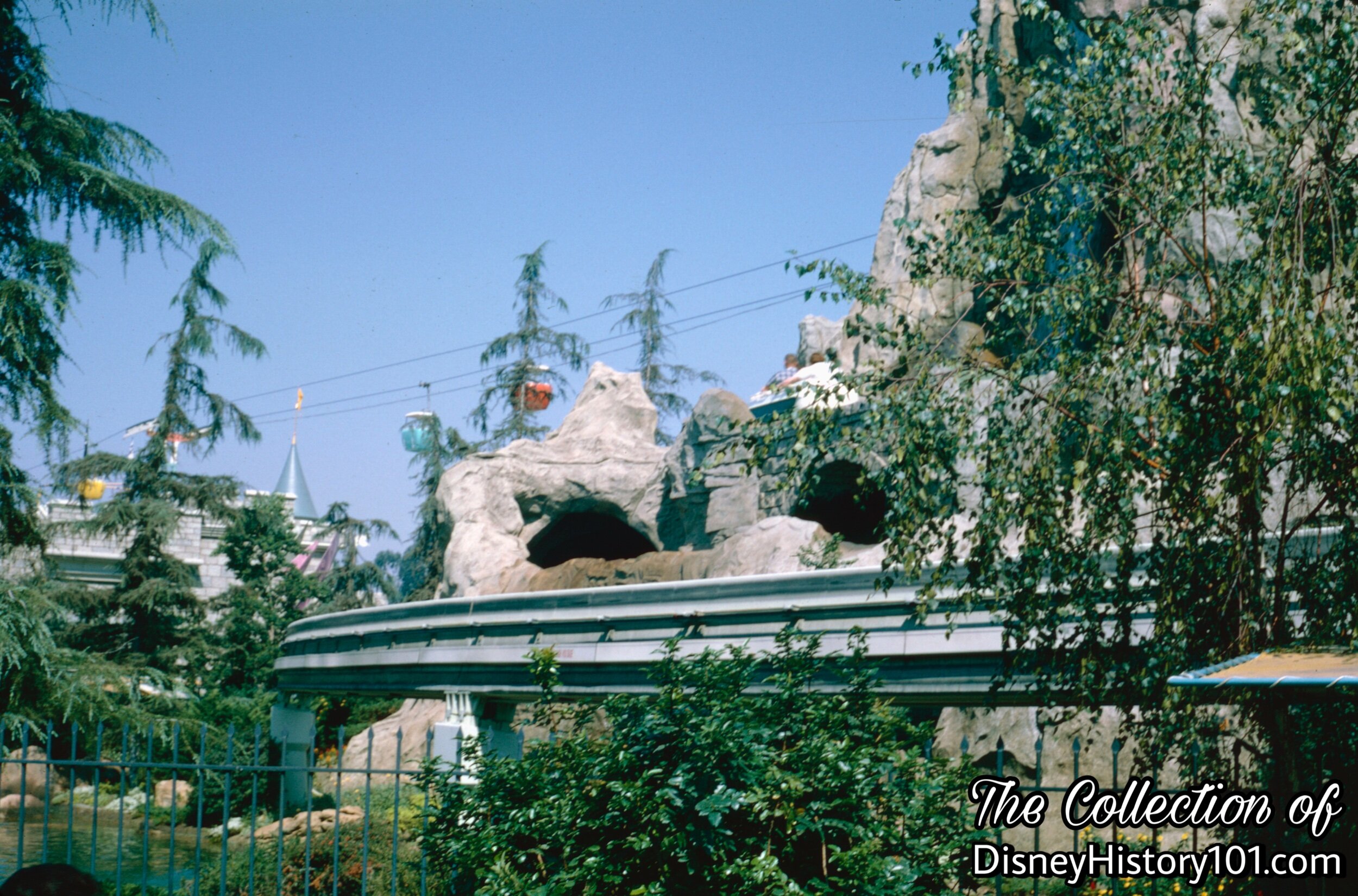
REENTERING THE PARK AND TOMORROWLAND SEGMENT
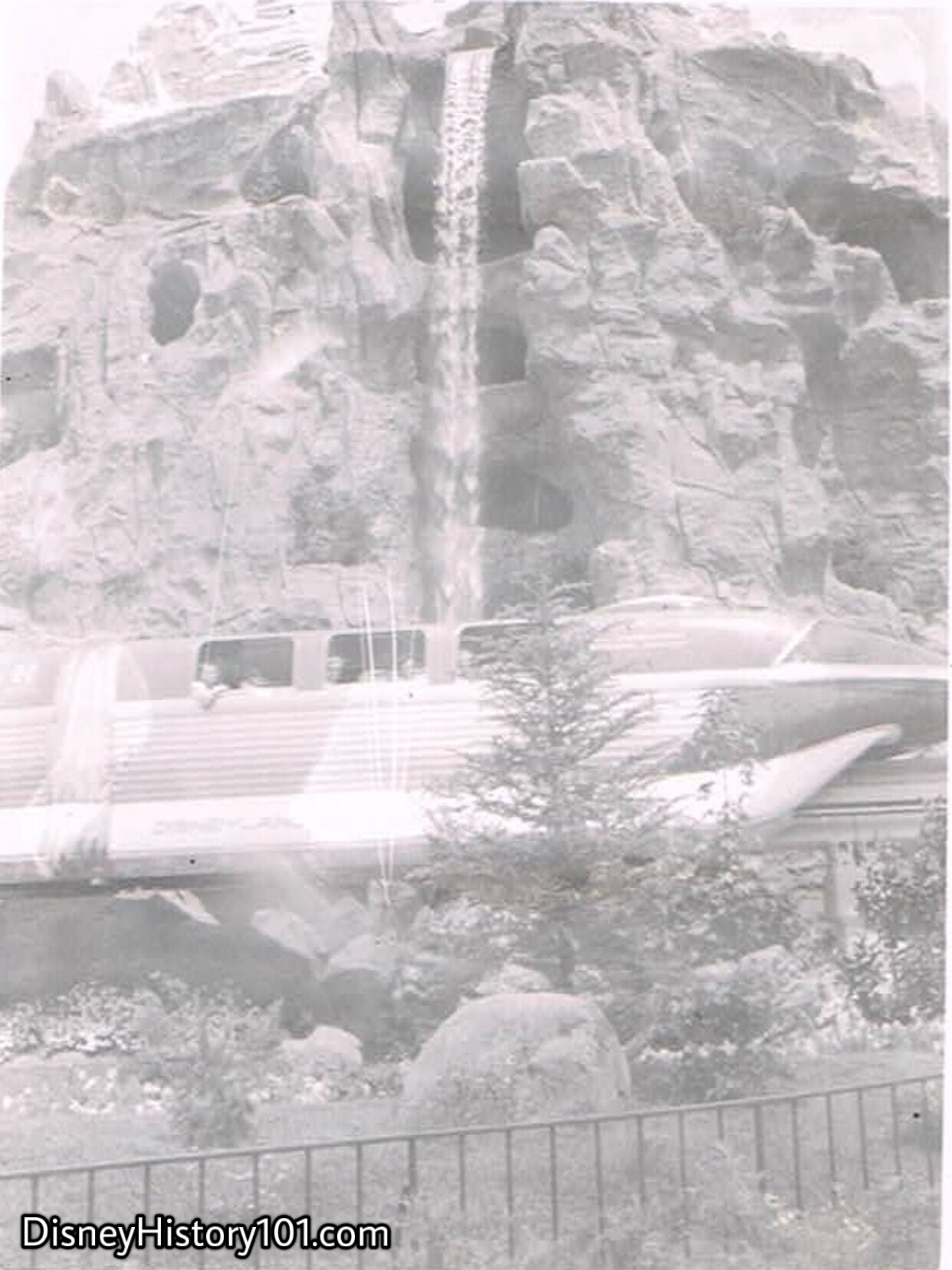
REENTERING THE PARK AND TOMORROWLAND SEGMENT - Monorail Mark II

Monorail Mark II View
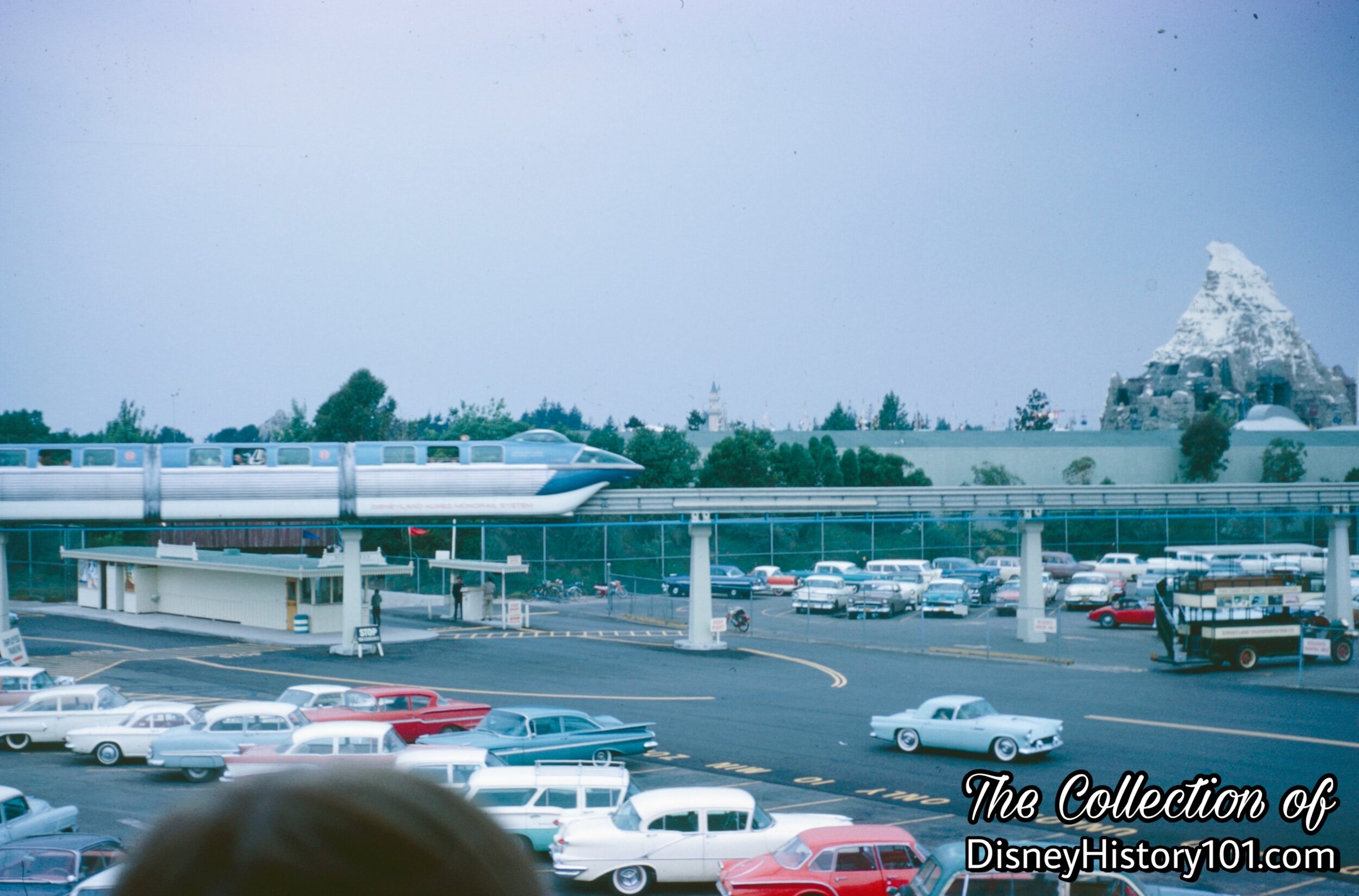
Monorail Mark II Blue
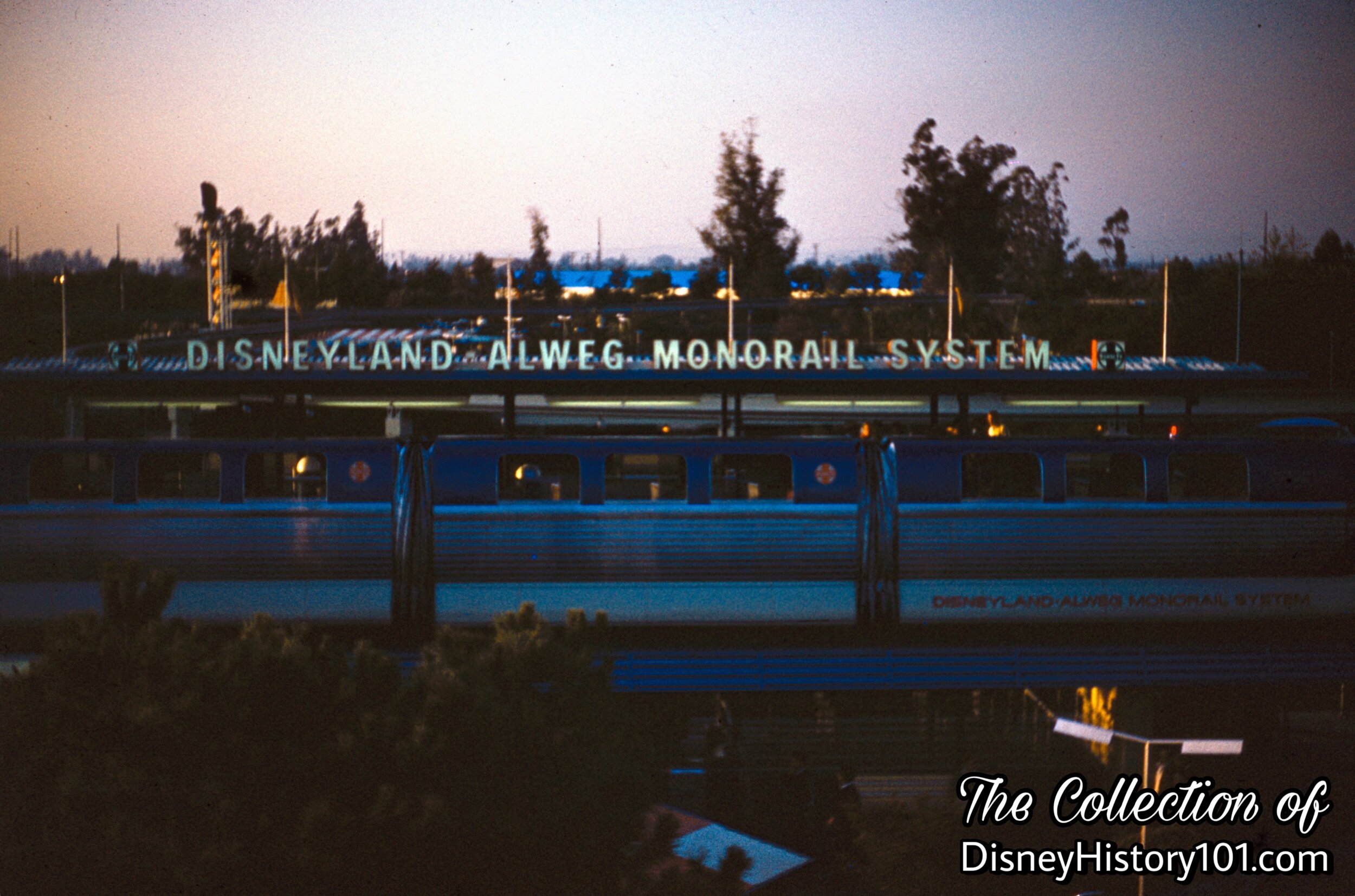
REENTERING THE PARK AND TOMORROWLAND SEGMENT - Monorail Mark II Blue
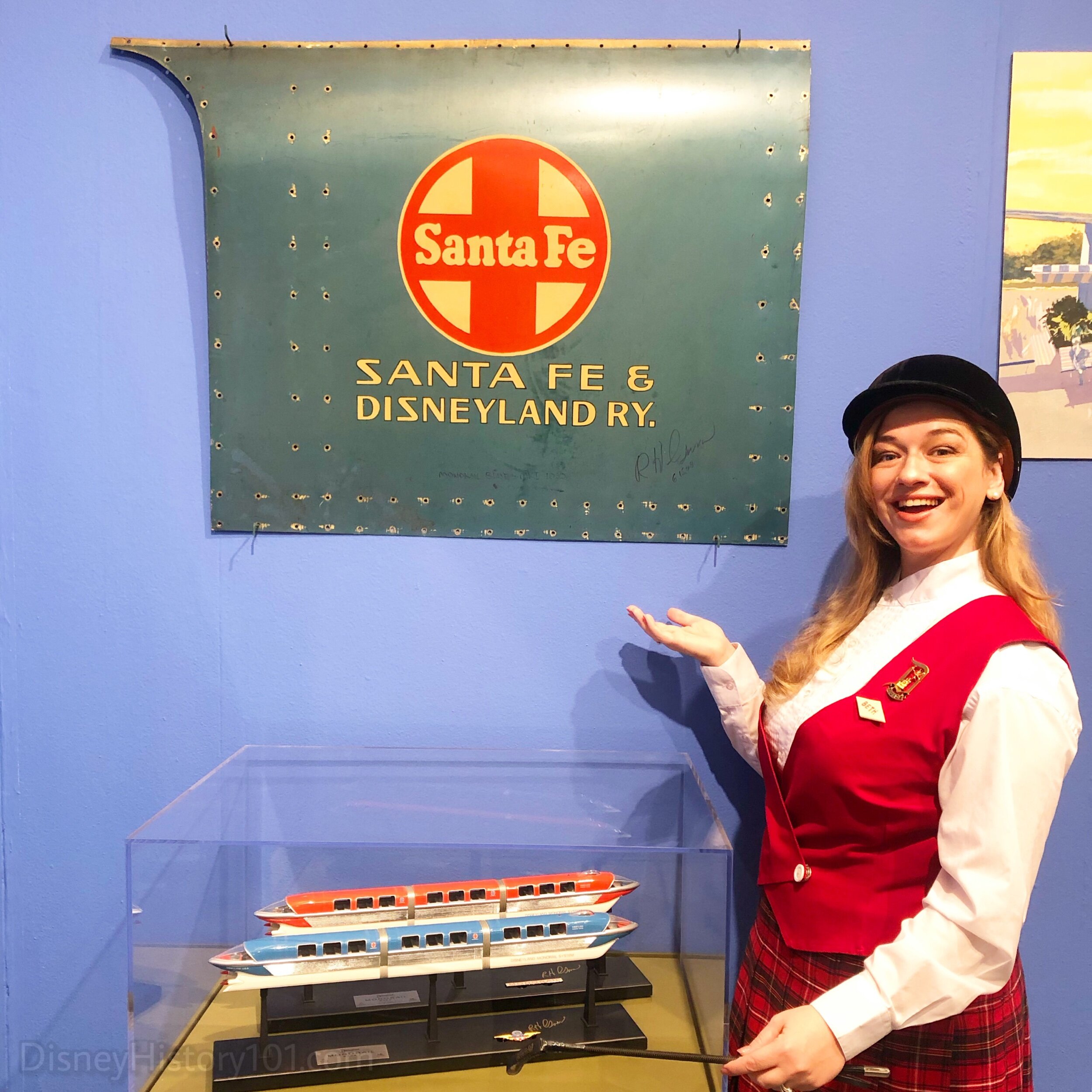
Monorail Mark I Door Panel, The Collection of Bill Barbe, (c. 1959)
We’re looking at one (of two) lightweight aluminum door panels salvaged from the Monorail Mark I.
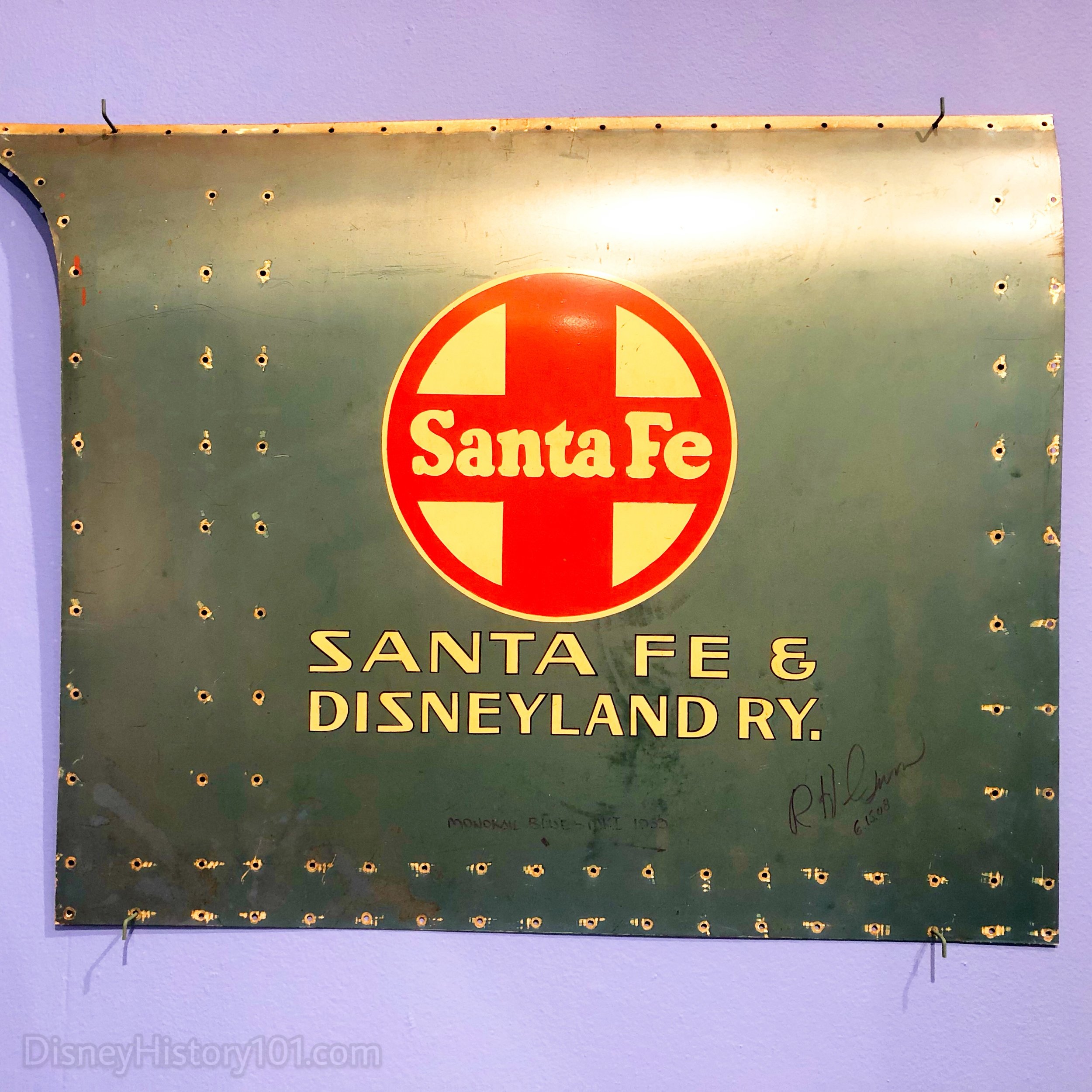
Monorail Mark I Door Panel, The Collection of Bill Barbe, (c. 1959)
This is a panel from the four-car Monorail Blue Mark II which was signed by reverse engineer Bob Gurr, before being sold at auction. We found this panel included among the exhibits at “Walt’s Trains” a temporary exhibit (now closed) at the Napa Valley Museum! The Santa Fe logo was featured on Monorails from 1955 through 1974.
Artifacts from the early Monorail trains have even made their way to the eastern coast. For instance, one Monorail Mark II Gold panel has been preserved inside the Monorail Shop north of the Contemporary Hotel at Walt Disney World Resort.
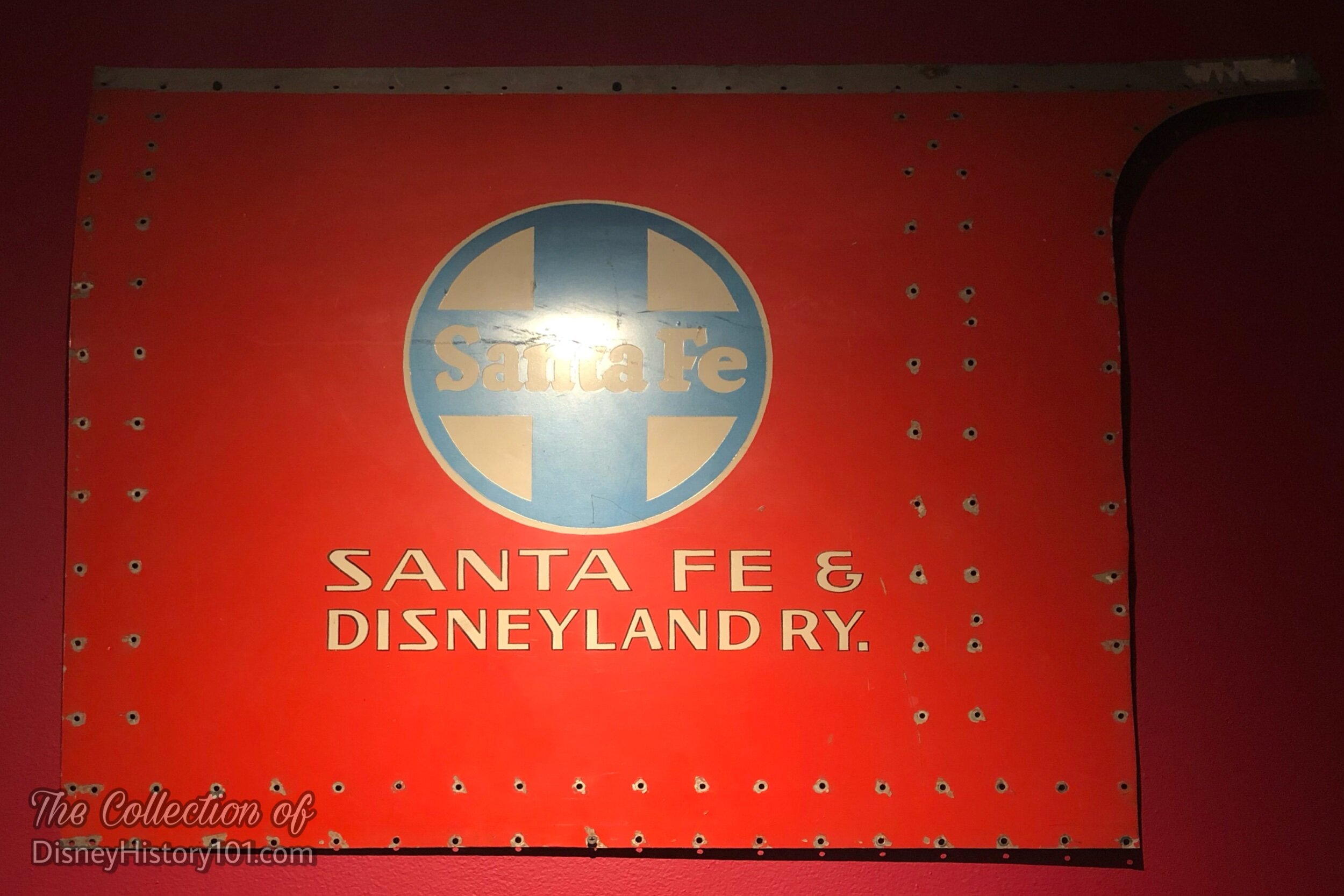
Monorail Red Mark I Steel Panel Currently on Display at "Walt Disney's Carolwood Barn" Museum, (1959)
According to Dave Smith (previous Chief Archivist Emeritus of the Walt Disney Archives), “Bob [Gurr] has a red panel from a Mark I ; it is currently on display in Walt’s Barn at the Los Angeles Live Steamers area in Griffith Park, and previously had been shown at the Richard Nixon Presidential Library. Bob also has two panels from the Mark I blue Monorail.” [Disney Facts Revealed by Dave Smith, 2016]

(1969-1985)
Back in 1962 (months following the Monorail Mark II debut), Walt had moved WED Enterprises, Inc. to an industrial park on the corner of Flower and Sonora streets in Glendale, California. A few years later, Walt Disney’s MAPO was incorporated on July 23, 1965. By 1966, a brand new Monorail Mark III was in development for Disneyland. In addition, Walt dreamed about the practical use of Monorail trains to be incorporated into the research and designs performed for EPCOT (an Experimental Prototype Community of Tomorrow) in Florida. From the transportation lobby in the Central core of the city, Monorail trains were to carry employees “either to the theme park or to EPCOT’s 1,000-acre industrial park.” However, the unexpected would seemingly halt these dreams.
“‘Moving Ahead’ With Walt’s Monorail Dream Legacy”
Internal materials published in 1966 mentioned: “With four maior new attractions nearing completion for summer, 1966, openings at Disneyland, Walt and his staff af WED are looking toward 1967 - 1968.“ Walt’s 65th birthday fell on December 5, 1966. Ten days later, on Thursday, December 15, 1966, at 9:35 a.m., a brother, a friend, and a leader, Walt Disney died. Many Disney personnel who were present, still remember this tragedy. Soon after, Roy O. Disney, President and Chairman of the Board of Walt Disney Productions addressed the staff with an official statement, in which it was conveyed:
“Walt Disney spent his entire life and almost every waking hour in the creative planning of…Disneyland… and the other diversified activities that have carried his name through the years. Around him Was Disney gathered the kind of creative people who understood his ways were always unique and he built a unique organization. A team of creative people that he was justifiably proud of… Many have been with us for over thirty years. They take great pride in the organization which we helped to build. Only through the talent, labor ad dedication of this staff could any Disney project get off the ground…
Much of Walt Disney’s energies had been directed to preparing for this day. It was Walt’s wish that when the time came he would have built an organization with the creative talents to carry on as he established and directed it through the years. Today this organization has been built and we will carry out this wish.
Walt Disney’s preparation for the future has a solid, creative foundation. All of the plans for the future that Walt had begun… the expansion of Disneyland… will continue to move ahead.”
During his lifetime, Walt went into the Monorail Mark III project with faith and confidence in the ability of his people to work hard and do the best possible job. In fact, if you were around at Walt Disney Productions during the 1960s and 1970s, then you may have had one of Walt’s most profound statements hung on your office wall: “You can dream, create, design and build the most wonderful place in the world… but it requires people to make the dream a reality.”
As the years passed Walt had occasionally wondered: “Can management produce Disney product after Disney?… That's the sixty-four-dollar question." In an effort to free the Company from dependence on him, Walt did not retire, but he began to step away from supervising so many projects (e.g. motion pictures and Disneyland). As Walt once put it, he would untie “the apron strings-until they scream for help.” On another occasion Walt expressed the belief: “Since my outlook and attitudes are ingrained throughout our organization, all our people have this curiosity; it keeps us moving forward, exploring, experimenting, opening new doors.”
After all, Walt was confident in the ability of his people to “move ahead” after he was long gone, that he once stated in a Canadian broadcast interview: “I think they’re going to stay with that policy because it’s a good business policy… I think they’ll hang on… well after Disney.”
That being a fact, may help explain why just four days after Walt’s passing, the WED Enterprises, Inc. Board of Directors “moved ahead” and met for a special meeting agenda on December 19, 1966. There, the third subject discussed, involved two related items - “the proposed new space for MAPO - the assembling of Monorail trains. These two items pretty well go hand in hand. In lieu of perhaps building this additional space, and becoming locked in on a long-term lease, and further consideration, if it is the opinion of the Board, Roger will actually assemble the Monorail trains, then it is suggested that we revert to the Kaiser building down the street from WED. We can obtain this building for no more than a three-year lease at a monthly cost of $1,250. It would provide the space required for assembling the Monorail trains and likewise provide some additional space so badly needed by Roger’s shop.” (See the proposal below.)
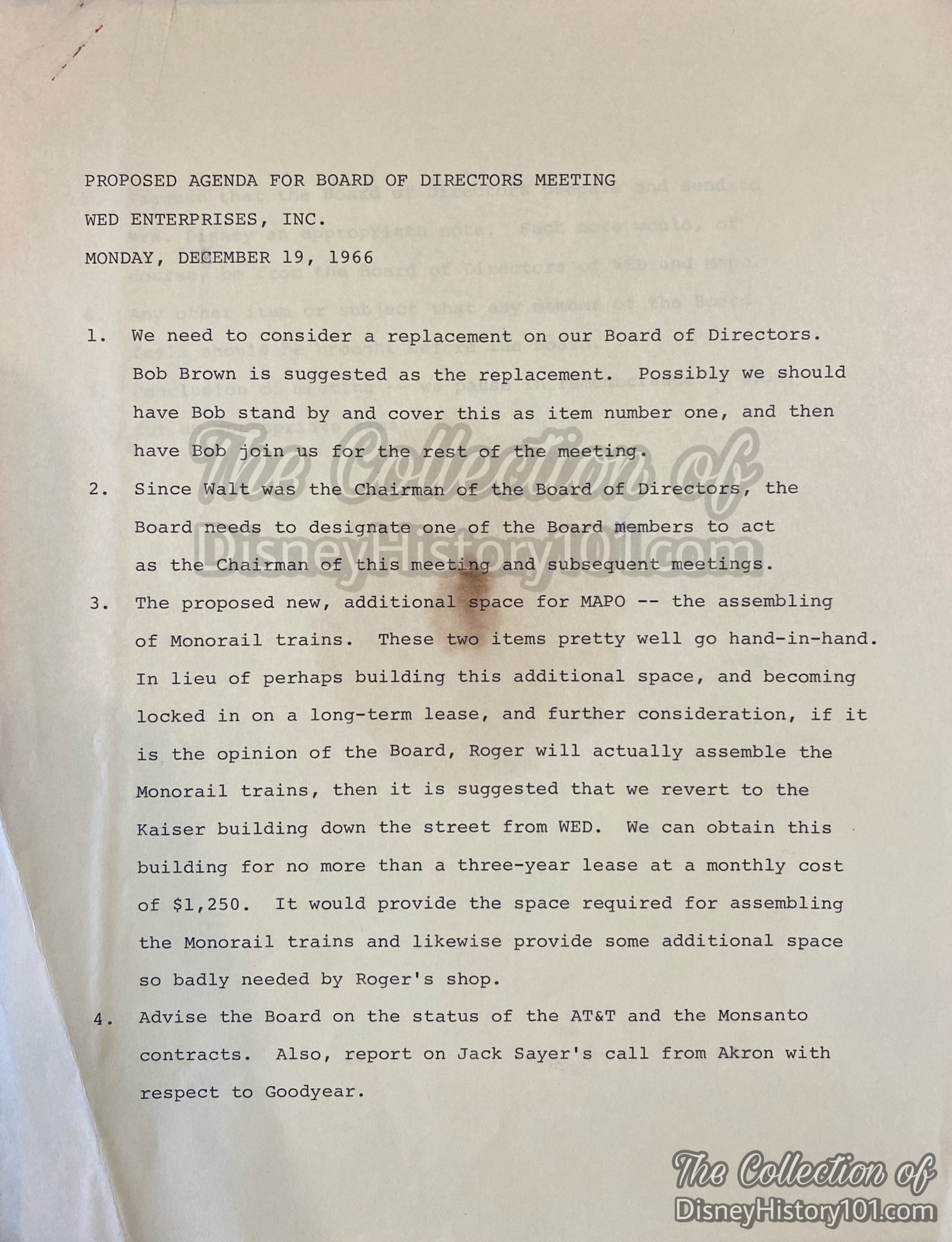
WED Enterprises, Inc. Board of Directors Meeting Proposed Agenda, December 19, 1966 (four days after Walt’s passing).
A WED Enterprises meeting held four days after Walt’s passing would address the Monorail trains.
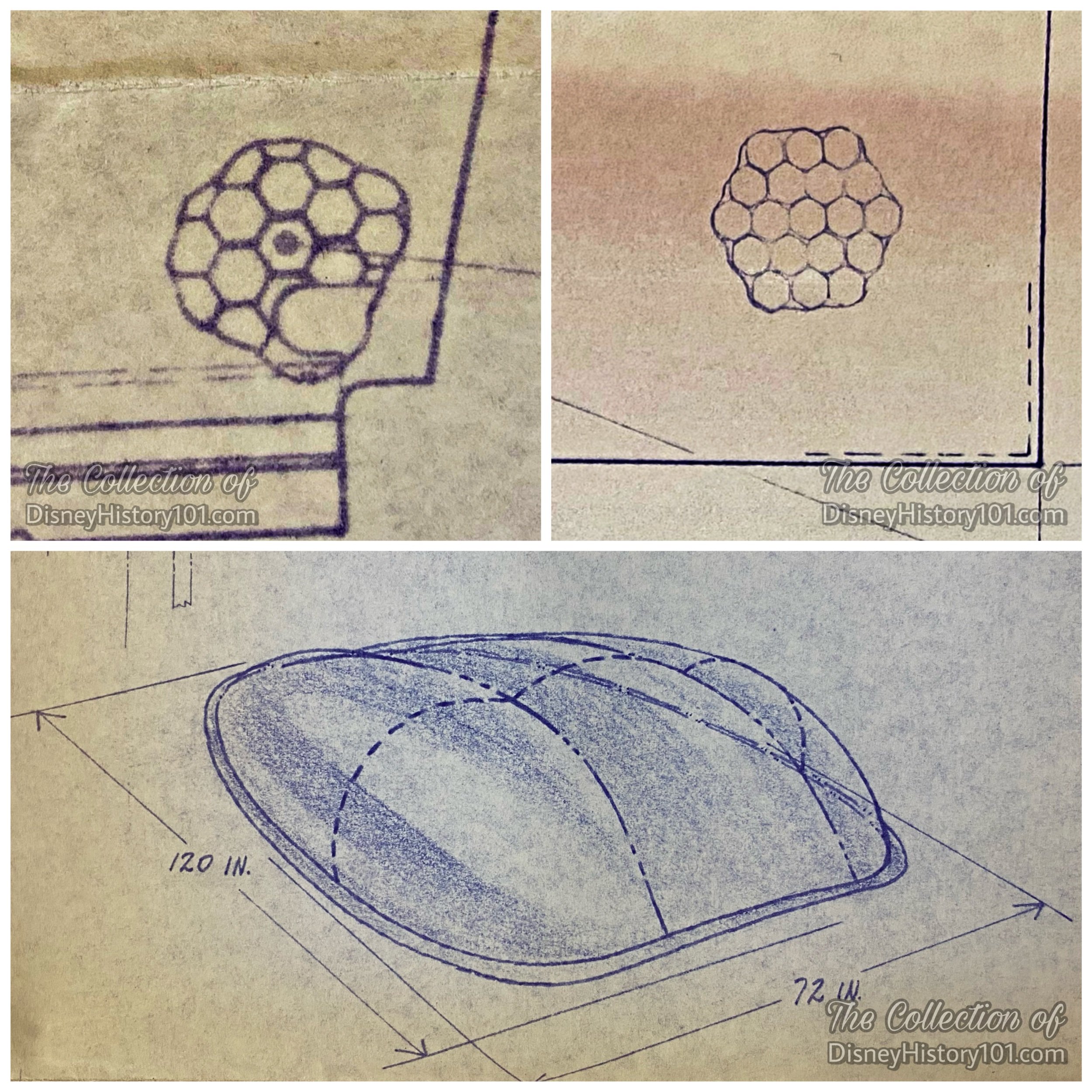
Mark III Monorail Drawing Excerpts produced c.1967-1968 - (clockwise from upper left) - two examples of the structural reinforcing "phenolic honeycomb," the Driver Bubble Canopy.
In order to meet the demand of guest capacity, Bob Gurr designed initial concepts for the sleek, five-car Monorail Mark III trains. In 1967 and 1968, subsequent drawings were engineered by Feuer and Moseley and approved by Gengenbach. The Monorail Mark IIIs would be very different from the Monorail Mark Is and Monorail Mark IIs. The Monorail Mark IIs were of “unit construction with the body structure an integral part of the chassis frame.” The Monorail Mark IIIs would differ in that they would have a separate body attached to a chassis. Further “this chassis in turn is composed of major sub-assemblies bolted together,” according to one c.1970s source. Some honeycomb panels were used in the construction.

Just a few of the individuals involved with the creation, checking, and approval of the Mark III Monorail drawings.

A Mark III Monorail Phenolic Honey Comb drawing title block sample.
Some electrical diagrams of preliminary proposals (for components like the Speed Regulator) had already been designed and generated by General Electric S.A.M.C.&G. Division in 1965. Over at WED Imagineering, Inc. by June of 1967, numerous 1/2 size and full-size assembly, component, and part drawings had been approved. These were drawn by a number of engineers including Gurr, D.V. Kuchta, Feuer, Moseley, and Hurt, and approved by Gengenbach (of WED Enterprises, Inc. Engineering), while schematic diagrams (for things like the voltage regulator, motor, and generator) were drawn by Hogsett, and checked by R.L. Brown. Some drawings were produced at 1/4 or 1/2-scale while some were even produced at full scale. Many of these drawings were released from about the spring/summer of 1968 to 1969 and used to machine caps, panels, plates, rivets, screws, and many other parts of the Mark III Monorail trains. Some assemblies like the Sill Moulding End Bubble, partitions, the bulkheads would contain a structural reinforcement (comprised of a synthetic material) called a “phenolic honeycomb” (or “Aircomb”) which was concealed by aluminum sheets in most cases.
Soon, four sleek, brand-new, efficient, air-cushioned, five-car Mark III trains (with a 132 passenger capacity) were introduced, beginning with the Monorail Green, during the Spring of 1968, and officially during 1969. The electrically powered trains alone were at the cost of $2 million (more than twice the investment of the original Monorail trains). By 1968, RETLAW (the Disney family’s company) had invested some $3,200,000 in the Disneyland Railroad and Monorail train systems.
Each Monorail train had four 100 horse-powered 600 volt DC electric drive traction motors capable of reaching speeds of up to 50 miles per hour. The motors were checked daily and subjected to periodic overhaul. Each train operated on a 600-volt direct current which transmitted along a pair of copper and steel bus bars on the right side of the concrete beamway stretching 12,300 feet, just short of two and a half miles.
There were about 7,000 feet of wire on each Monorail train, varying in size from #18 to 3/10. In addition, there were 64 relays and contractors per train.
To keep the trains in motion, each train had 4 guide tires, 10 vertical pneumatic rubber tires over the elevated beamway (for load carrying driving and braking), and 40 smaller pneumatic rubber tires along the sides of the “I” shaped beamway (for stabilization). These features would help the trains safely reach operating speeds of 10 to 35 miles per hour.
Those 44 pneumatic rubber tires on each train, were checked daily, constantly checked, and replaced on pre-arranged schedule. This maintenance was performed by the Retlaw Maintenance crew of about 60 men which included operating engineers, laborers, mechanics, and electricians.
From the forward car compartment, the Monorail Pilot operated the mechanical and electrical controls, used speakers to communicate with passengers, and used short-wave radios to communicate both with other trains and stations. Safety controls would allow the Pilot to open the passenger doors only when the Monorail Trains were “standing in the stations.”
“The Station Platforms”
The old platforms at the Disneyland Hotel and the Tomorrowland Station were lengthened to accommodate the longer trains. According to Vacationland magazine (Fall, 1971 ; vol. 15, no. 3) : “Since their introduction in 1959, Disneyland-ALWEG Monorail trains have carried well over 30-million passengers and traveled more than 850,000 miles on the 2 1/2 mile ‘highway in the sky’ between Tomorrowland and the Disneyland Hotel.”
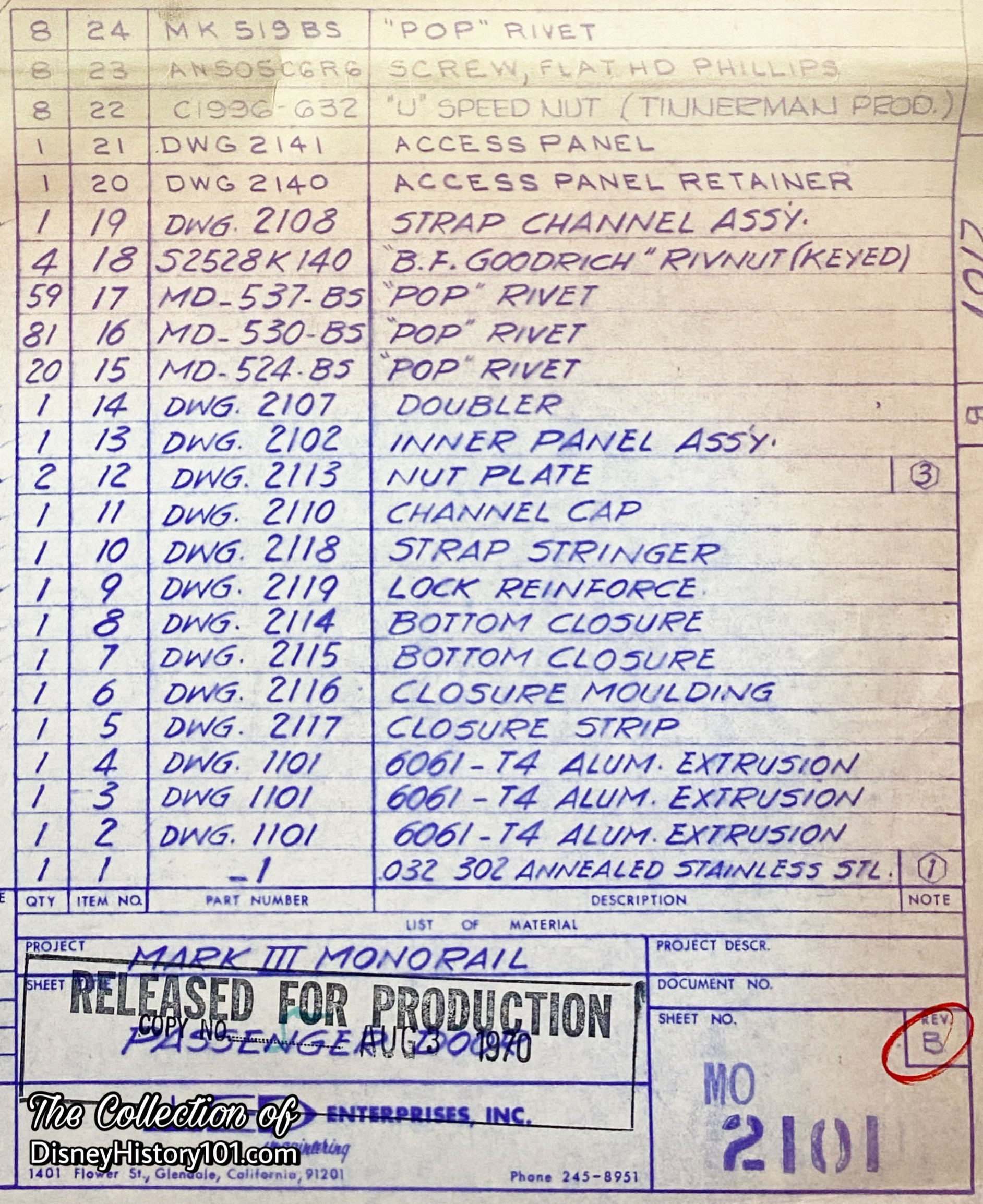
A Mark III Monorail Passenger Door title block (bottom) and schedule (top).
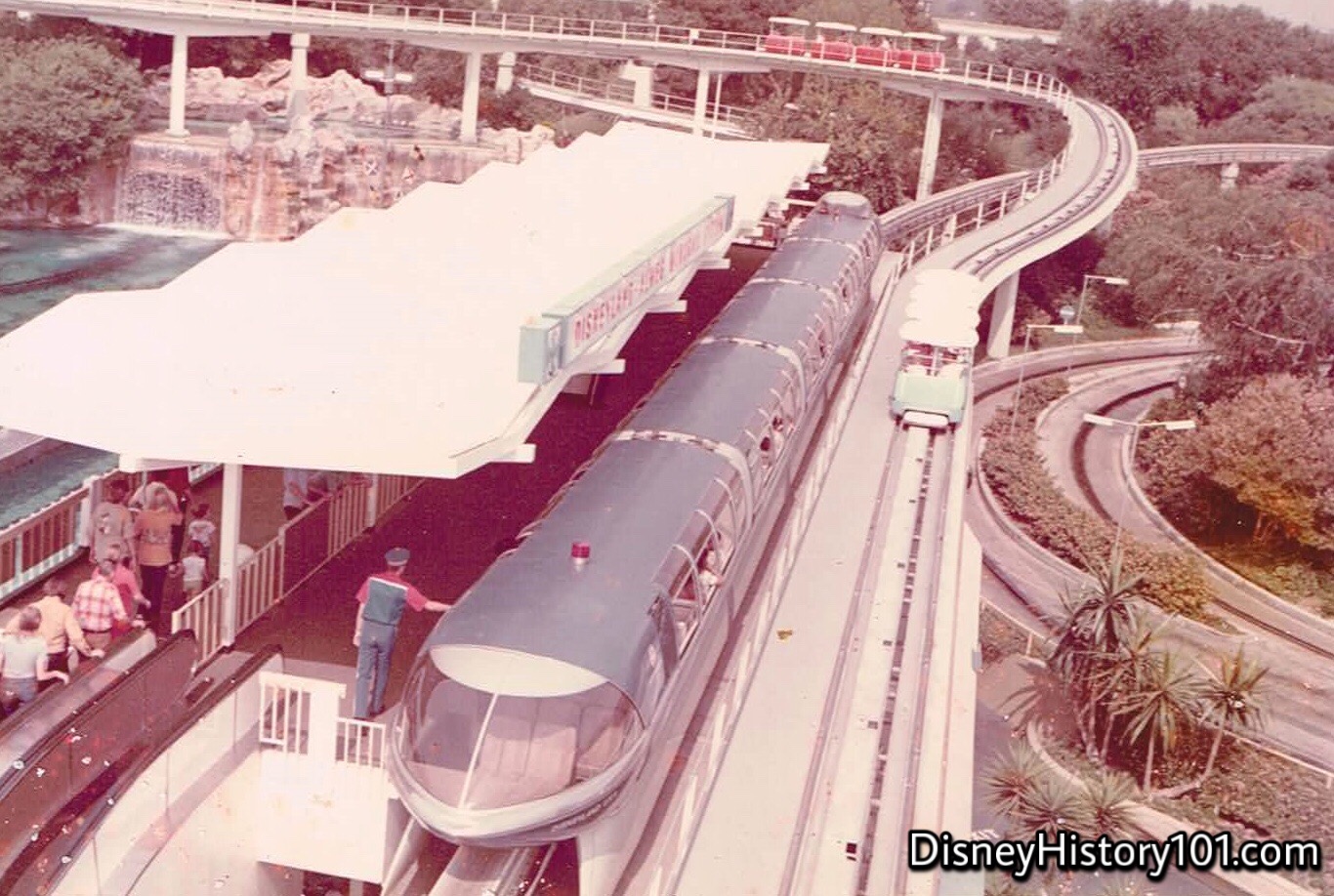
REENTERING THE PARK AND TOMORROWLAND SEGMENT - Monorail Mark III Blue
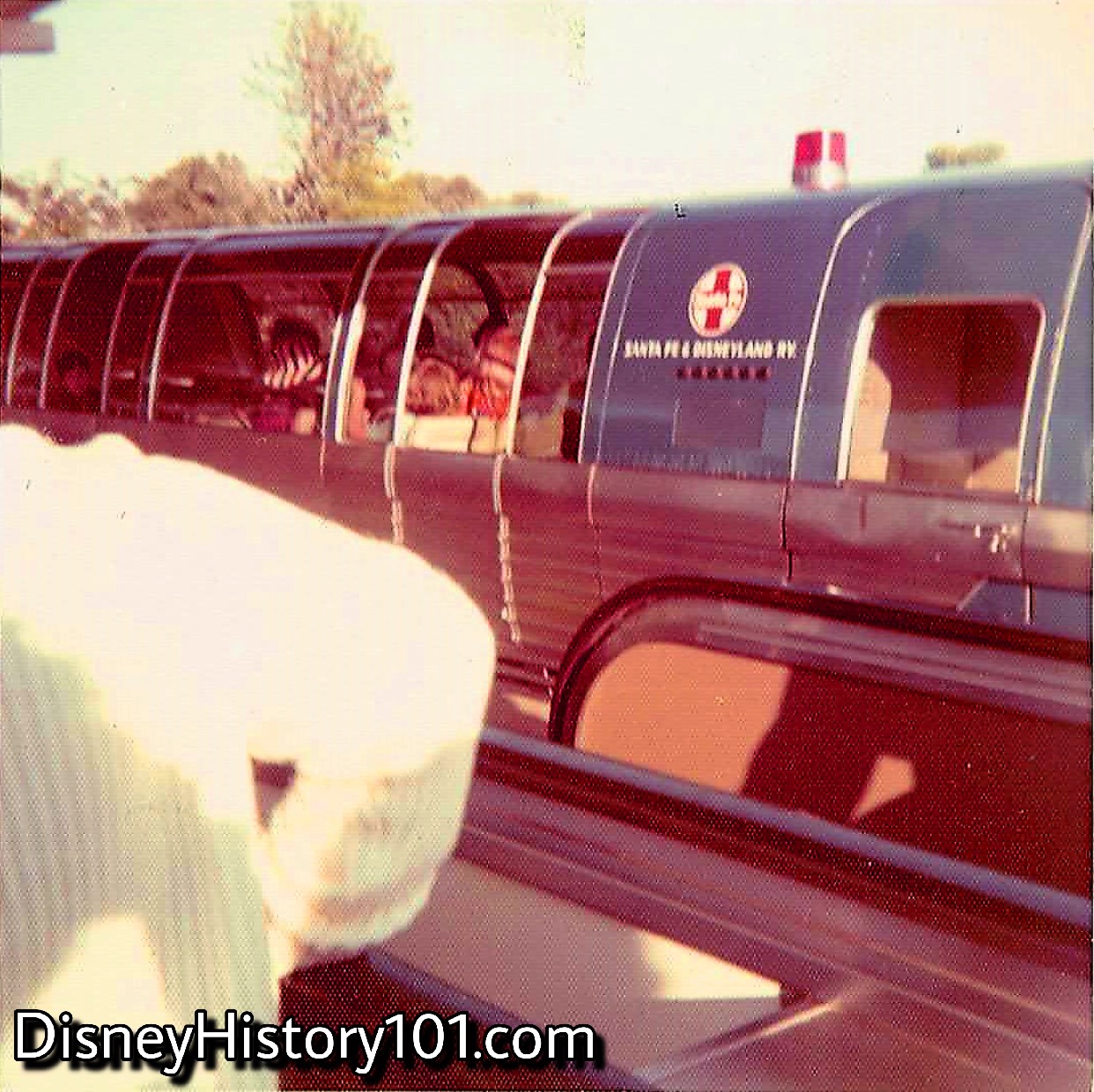
REENTERING THE PARK AND TOMORROWLAND SEGMENT - Monorail Mark III Blue
The Monorail Blue (with its rotating bright-red Beacon light atop the Tail Cone) ready to depart the Tomorrowland Platform.
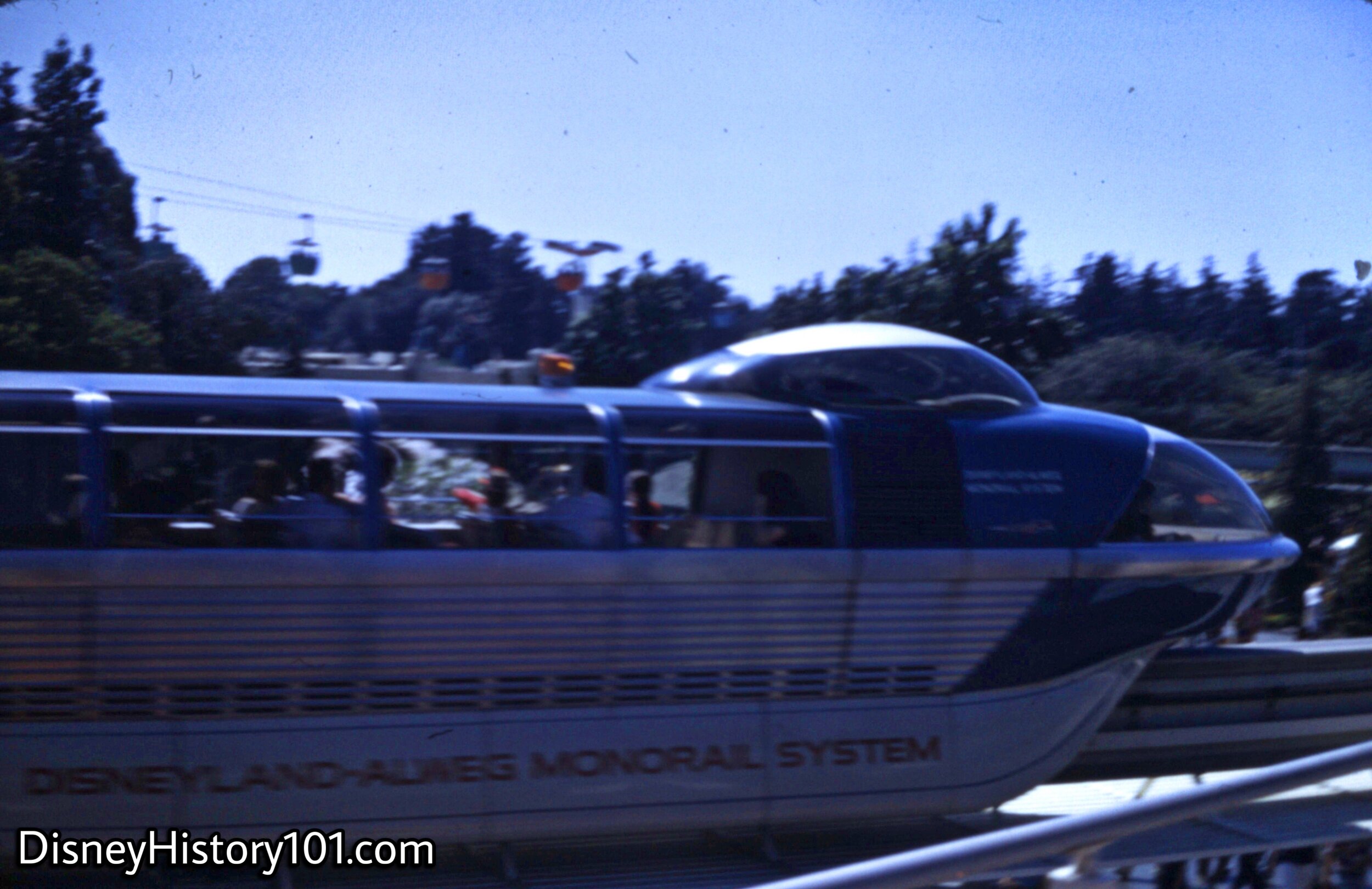
REENTERING THE PARK AND TOMORROWLAND SEGMENT - Monorail Mark III Blue
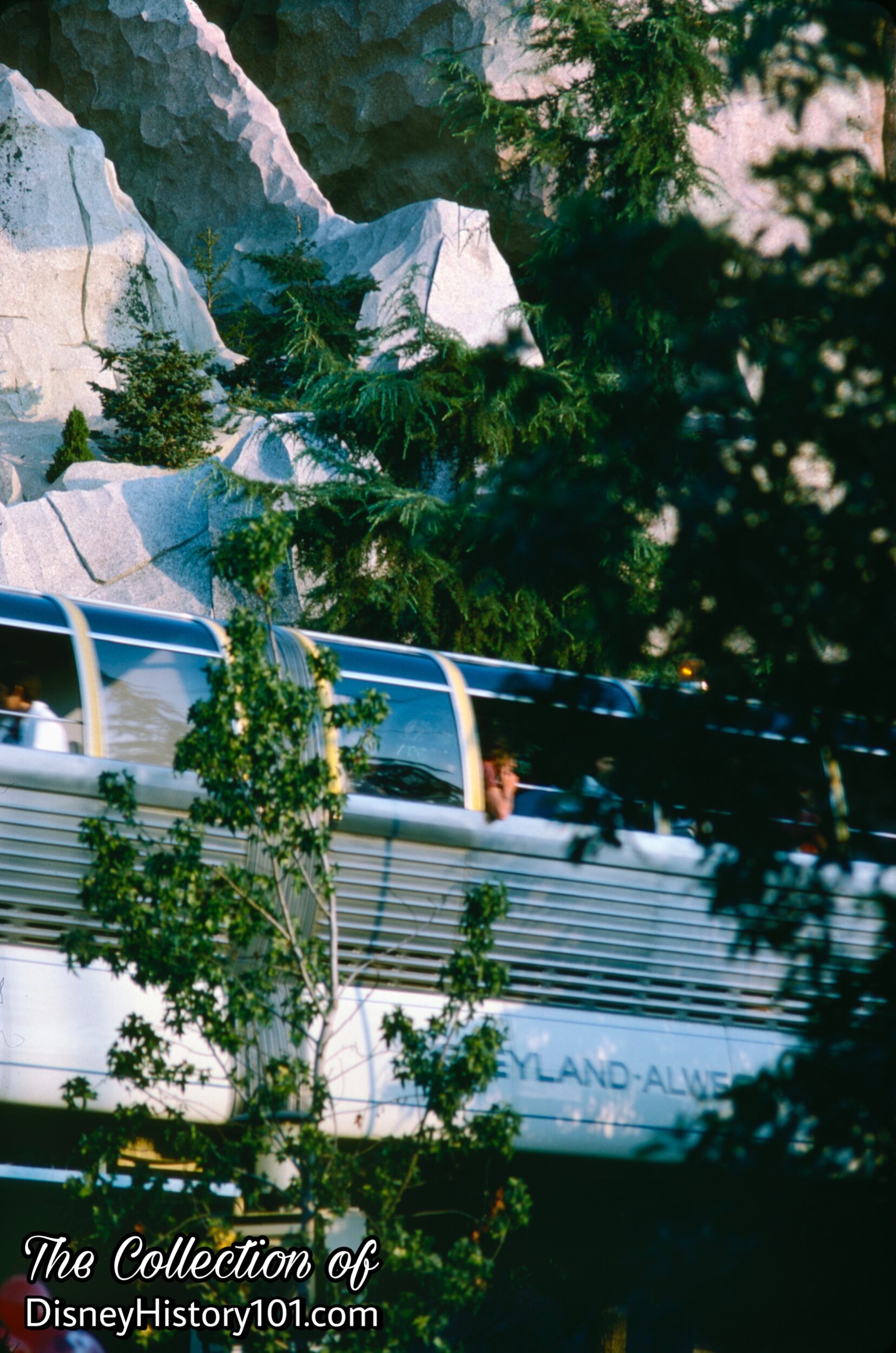
REENTERING THE PARK AND TOMORROWLAND SEGMENT - Monorail Mark III Yellow
As the Monorail trains pass in front of the Matterhorn, they actually reach the lowest point in the beamway - five feet off the ground! The trains even pass close enough to the mountain, that guests can feel the spray from the cascading waterfalls!
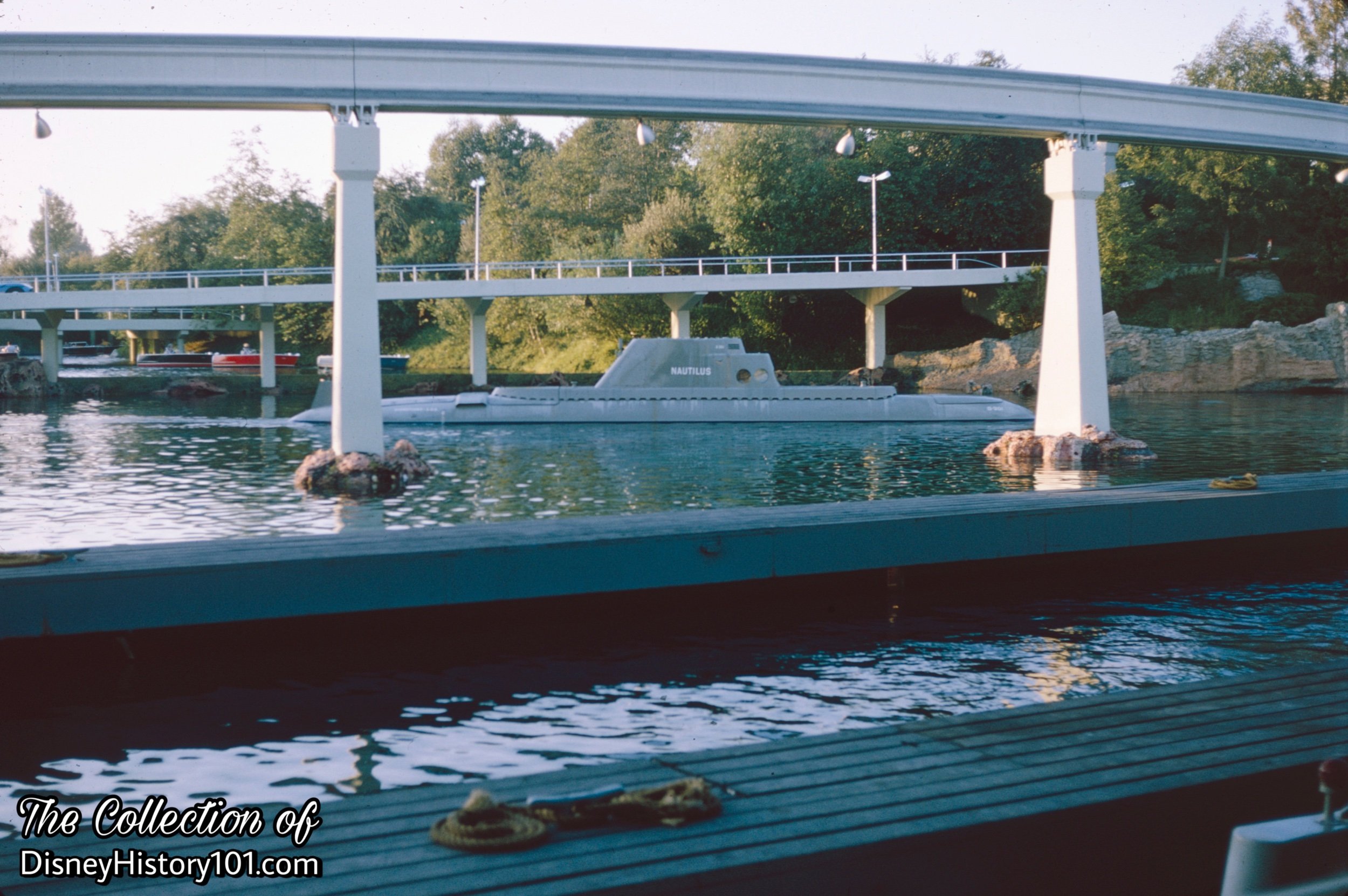
REENTERING THE PARK AND TOMORROWLAND SEGMENT
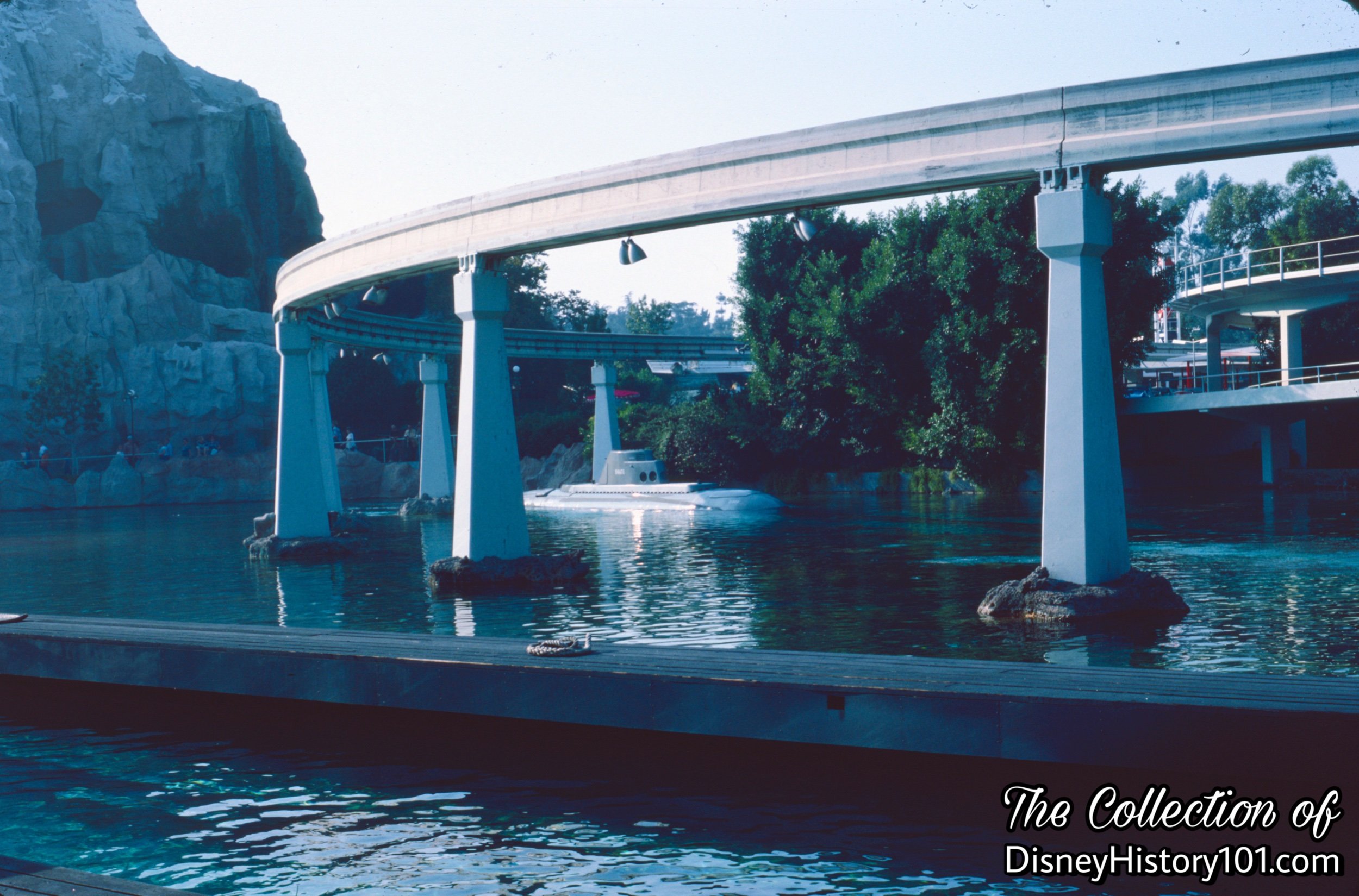
REENTERING THE PARK AND TOMORROWLAND SEGMENT
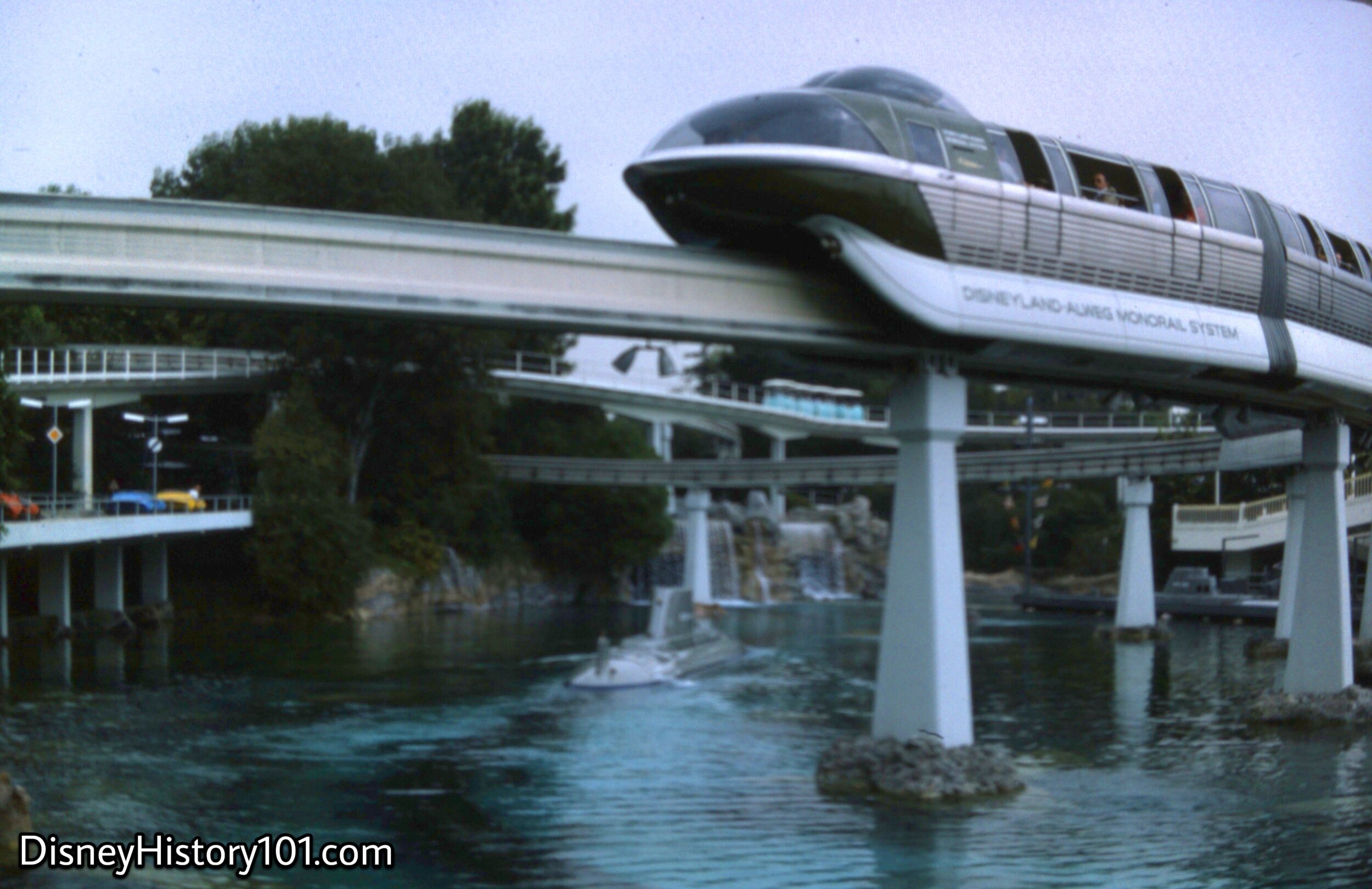
REENTERING THE PARK AND TOMORROWLAND SEGMENT - Monorail Mark III Blue
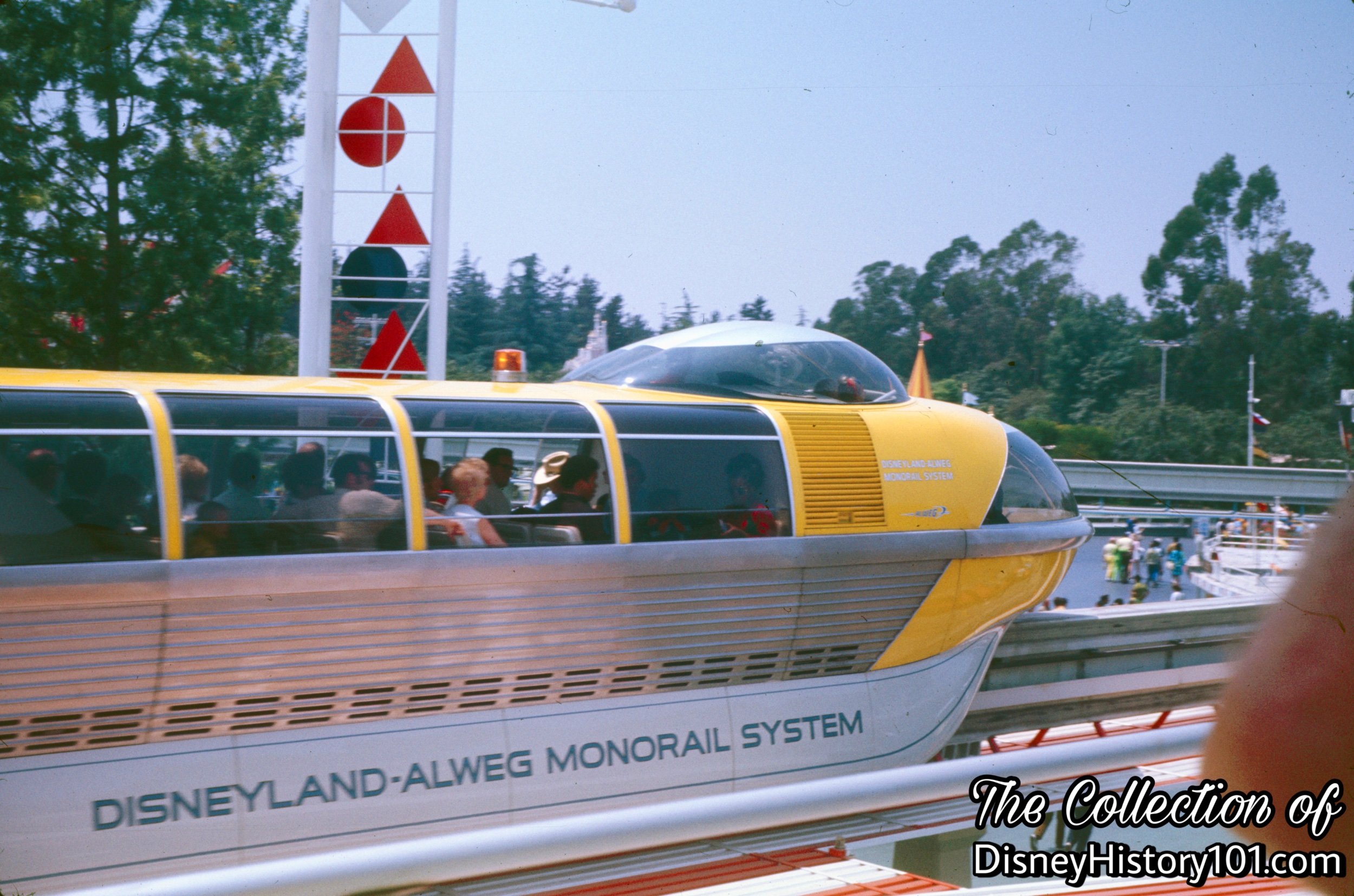
REENTERING THE PARK AND TOMORROWLAND SEGMENT - Monorail Mark III Yellow
The nose cone - the enclosed section constituting the forward end of the train.
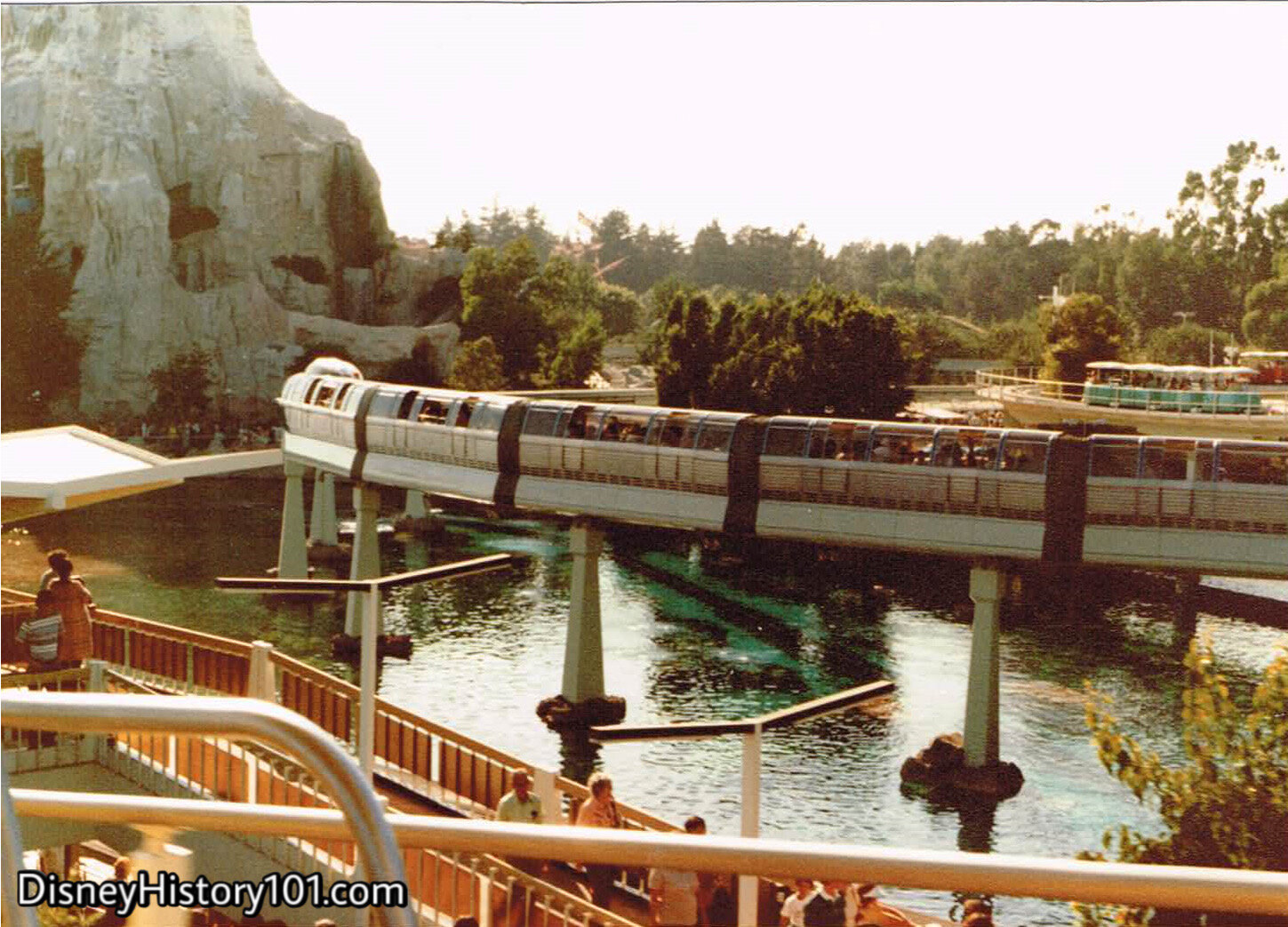
REENTERING THE PARK AND TOMORROWLAND SEGMENT - Monorail Mark III Blue
“Each of the four five-car trains is 137-feet long and carries 127 passengers”, according to Vacationland magazine (Fall, 1971, Vol.15, No. 3)
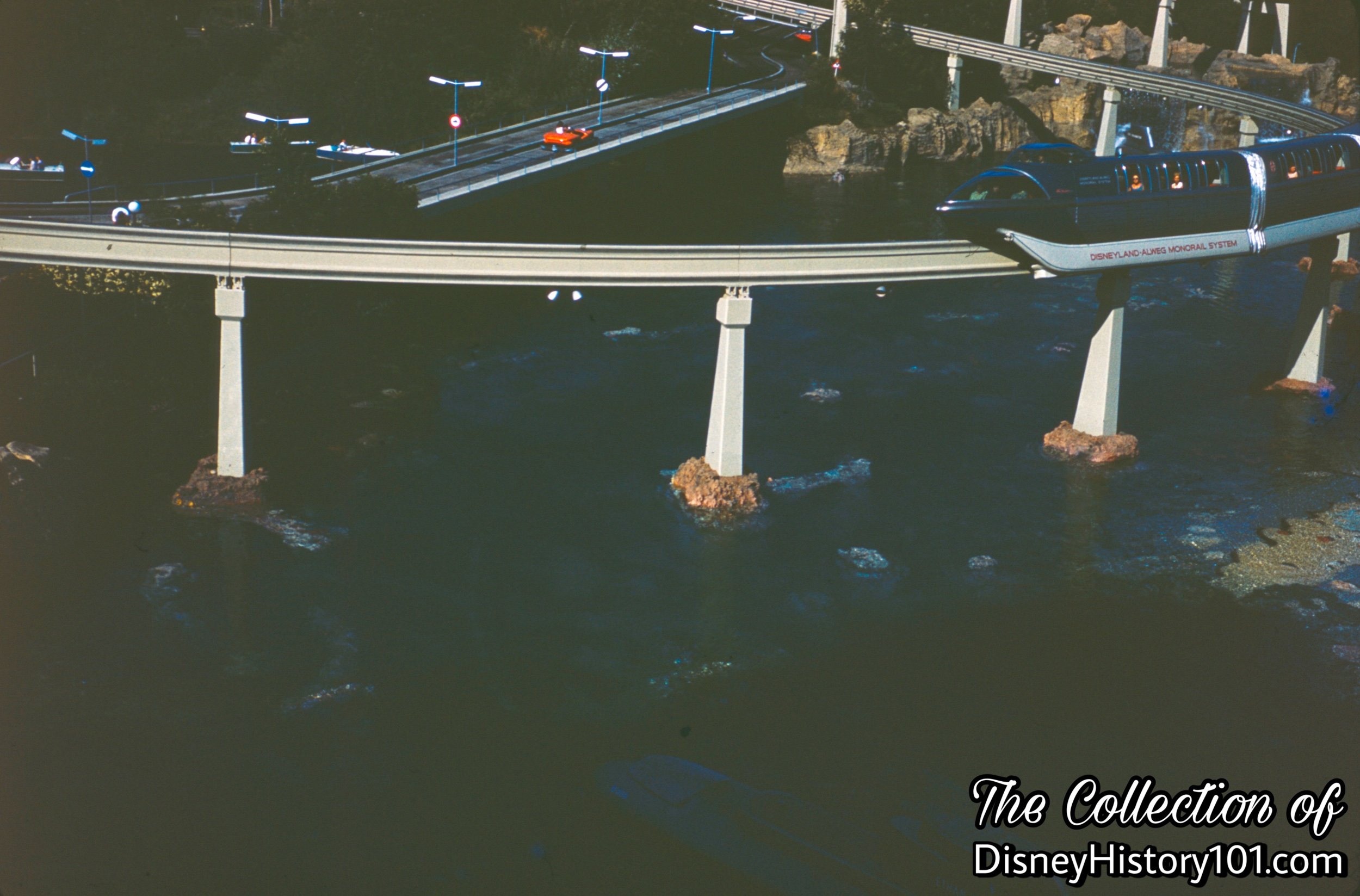
REENTERING THE PARK AND TOMORROWLAND SEGMENT - Monorail Mark III Blue
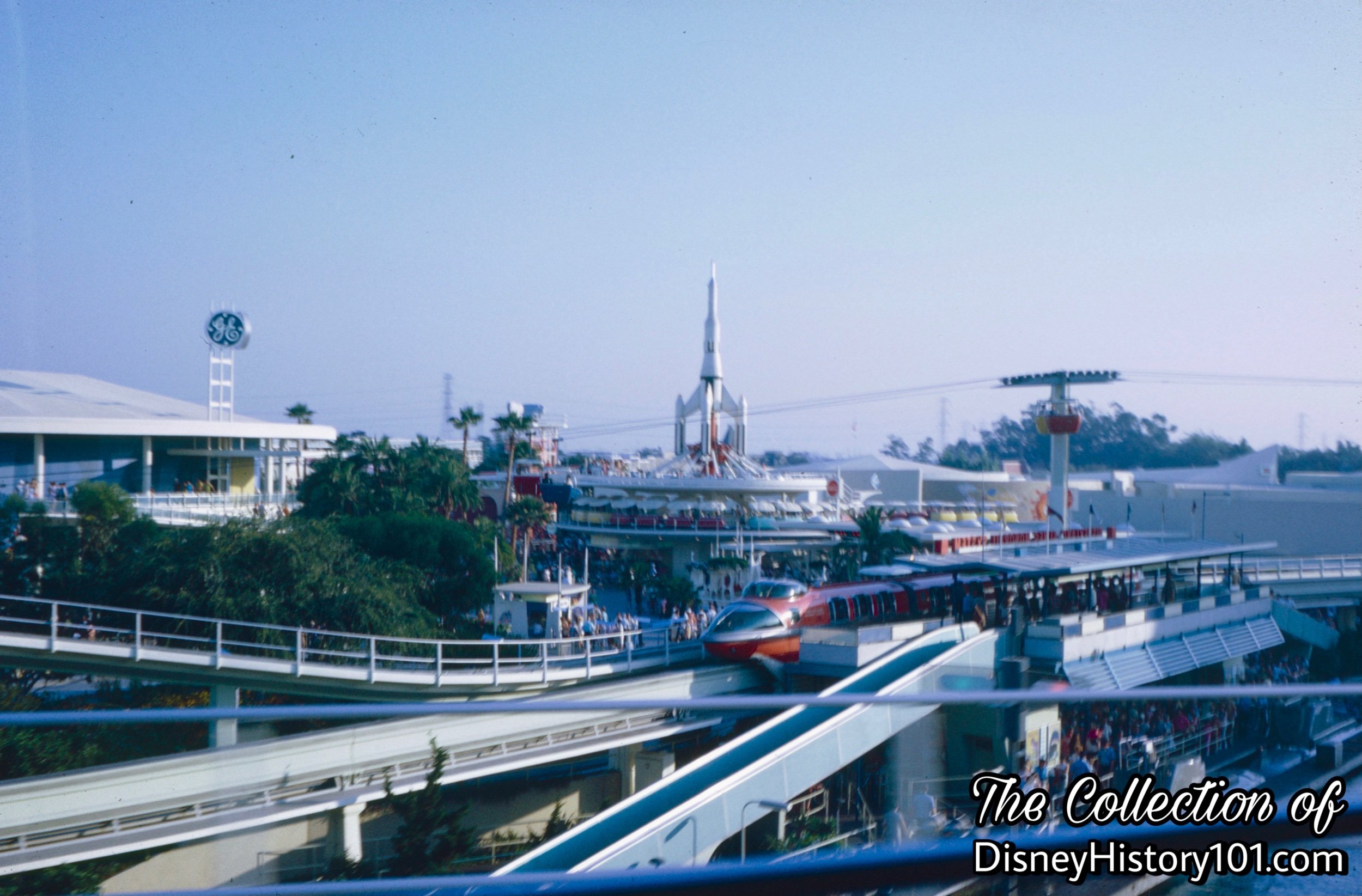
REENTERING THE PARK AND TOMORROWLAND SEGMENT - Monorail Mark III Red
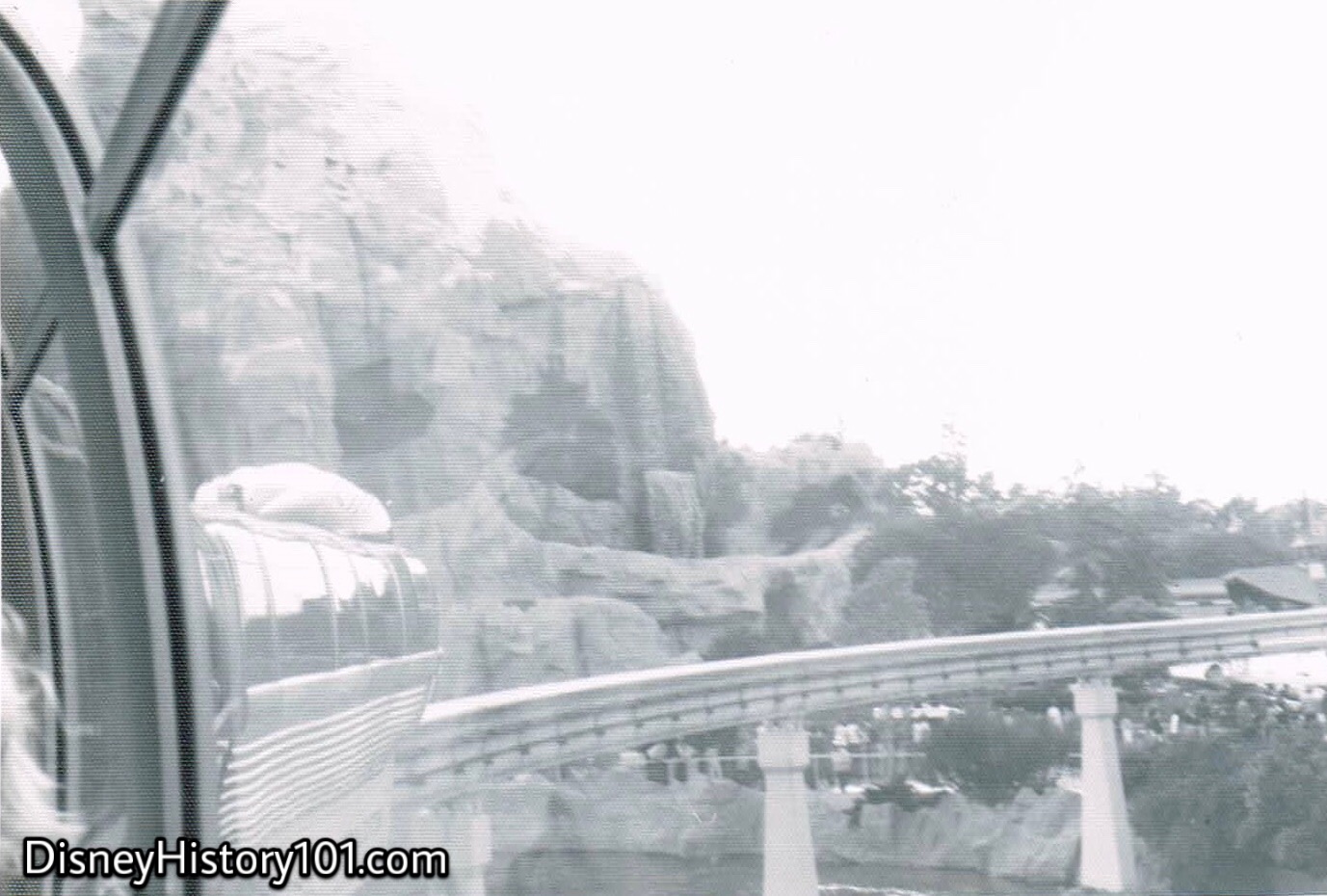
REENTERING THE PARK AND TOMORROWLAND SEGMENT - Monorail Mark III, 1975.
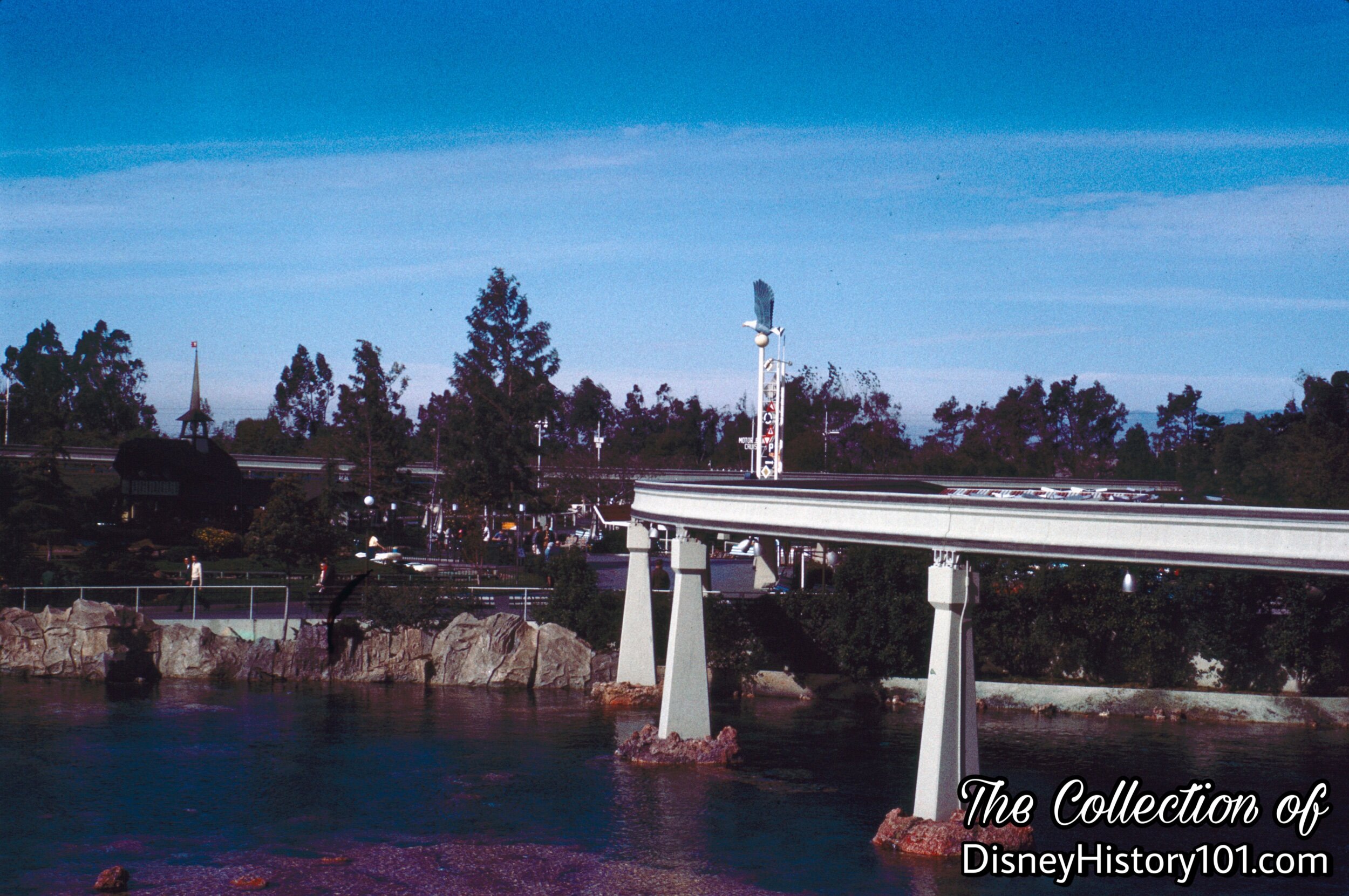
REENTERING THE PARK AND TOMORROWLAND SEGMENT
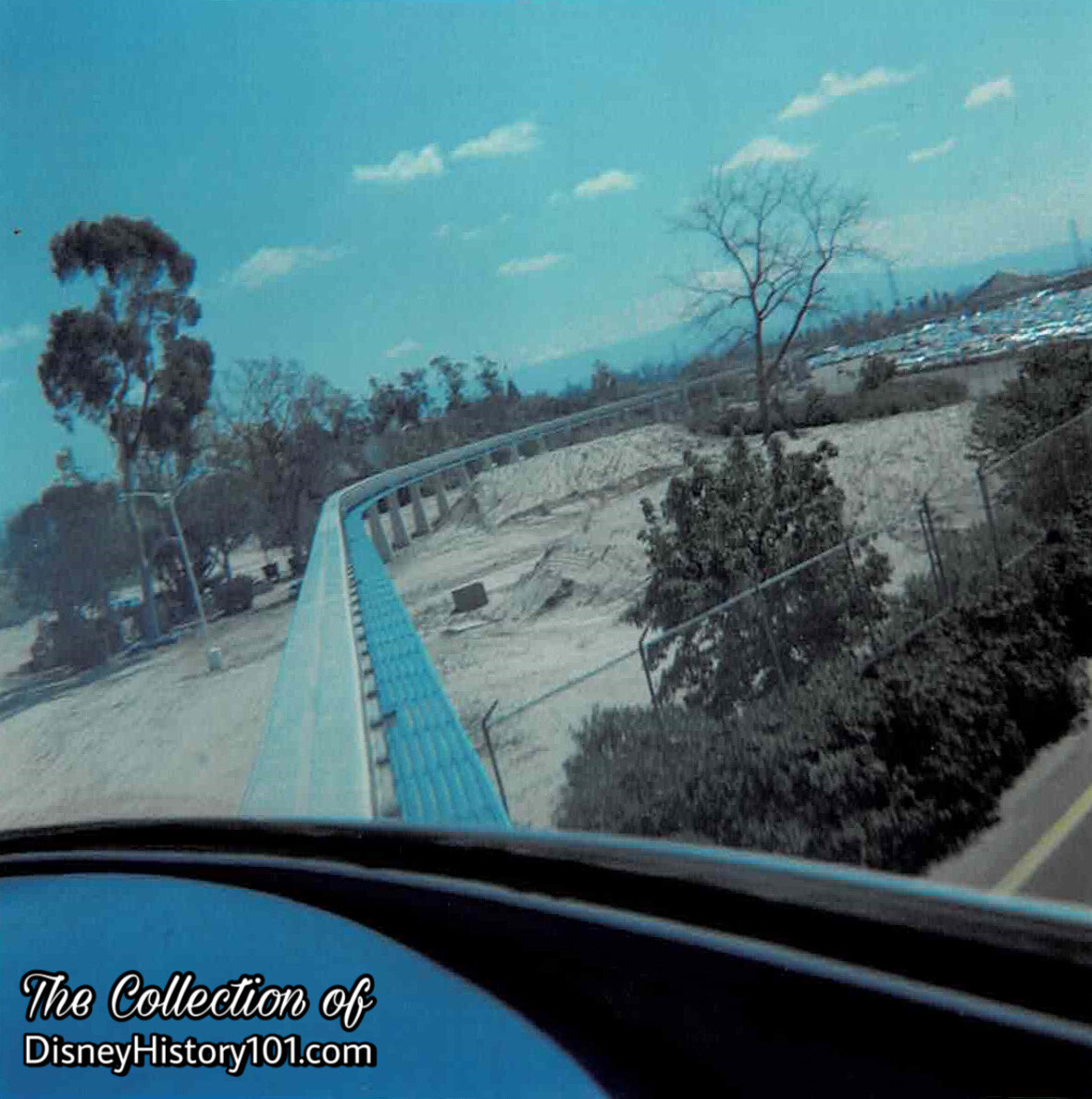

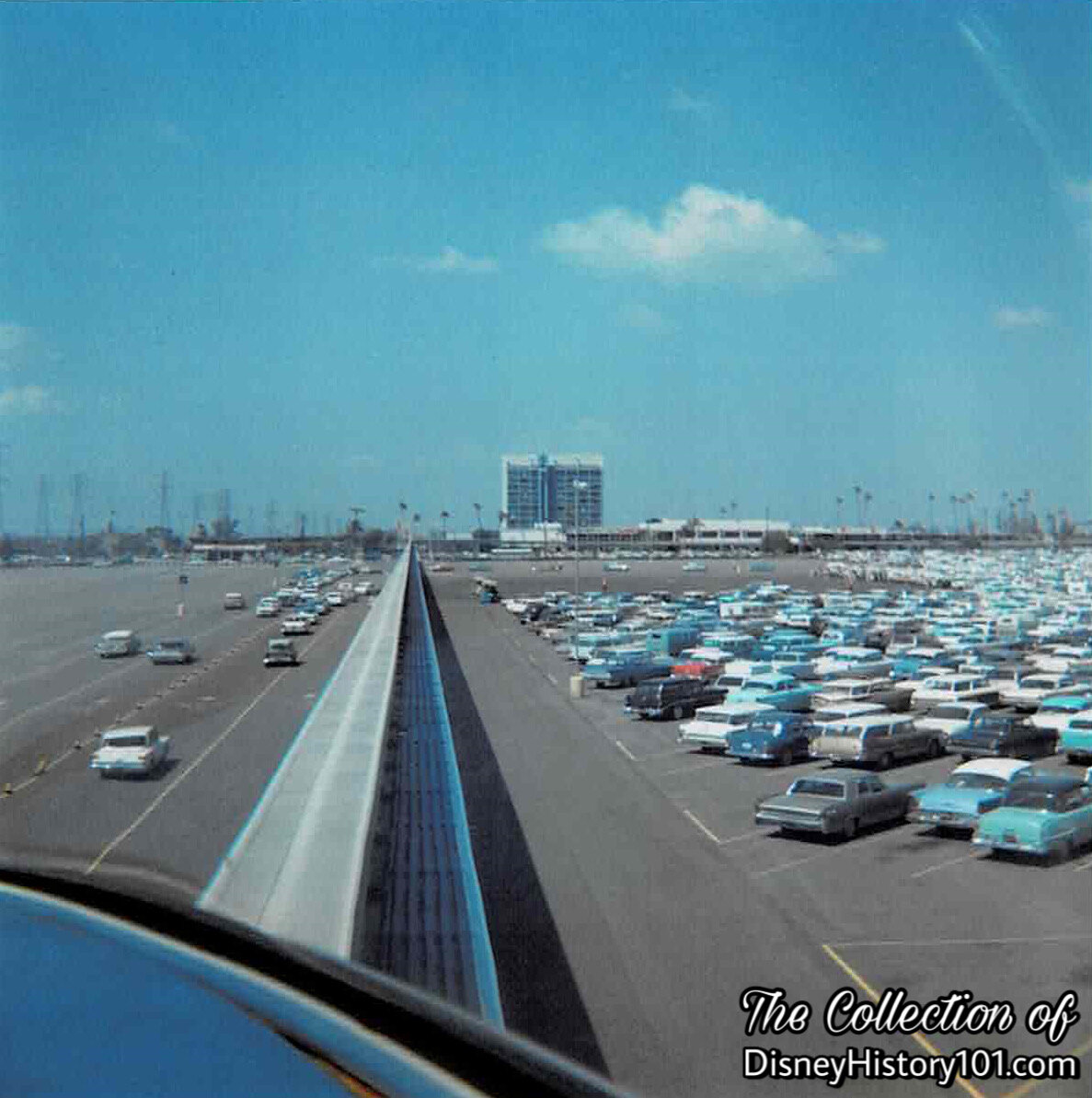
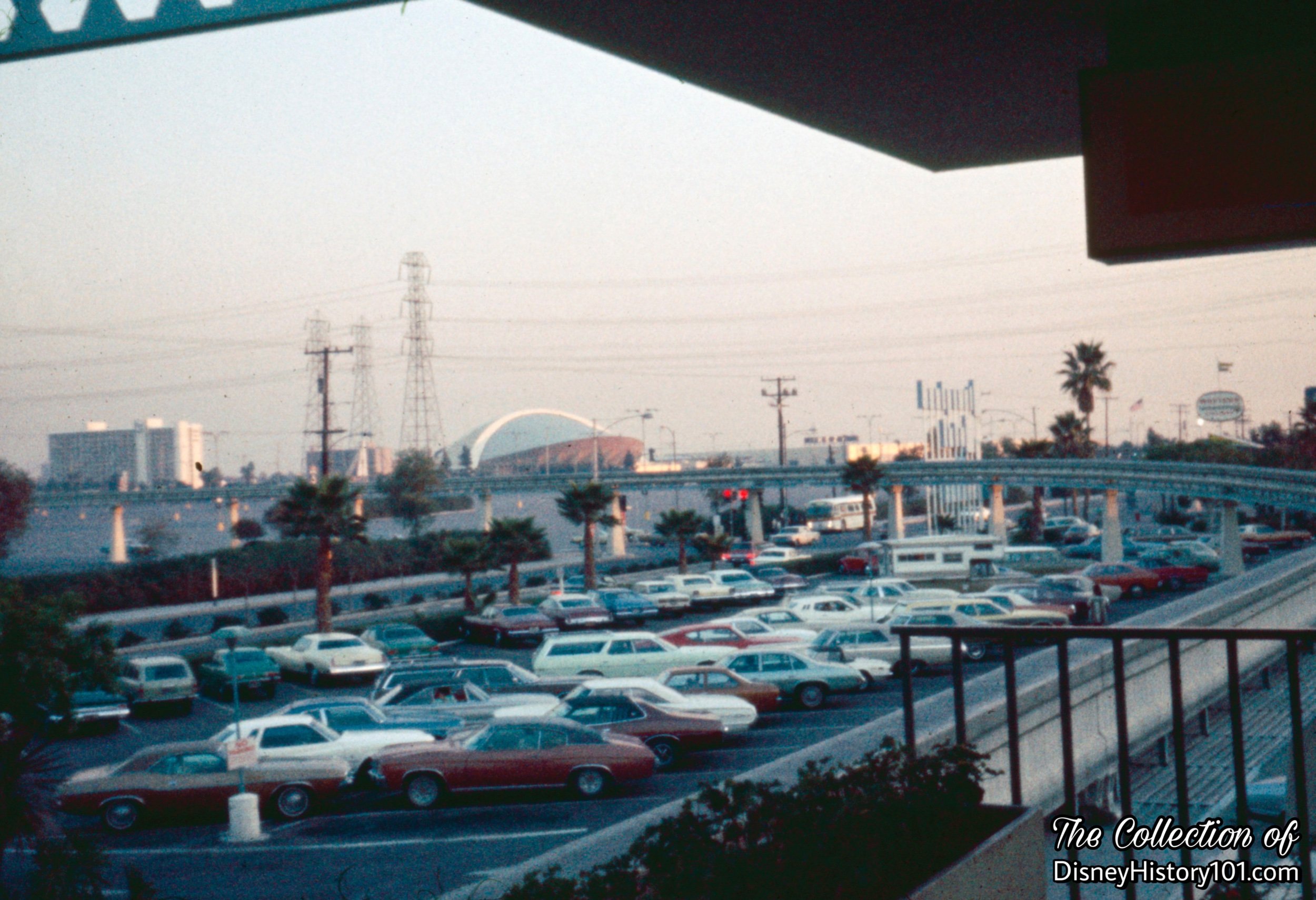
Monorail Mark III, 1974.
At the Main Entrance to Disneyland’s Parking Lot, the monorail veers westward over the 100 acre parking lot, crosses West Boulevard and turns northward to the Disneyland Hotel where a station has been constructed.
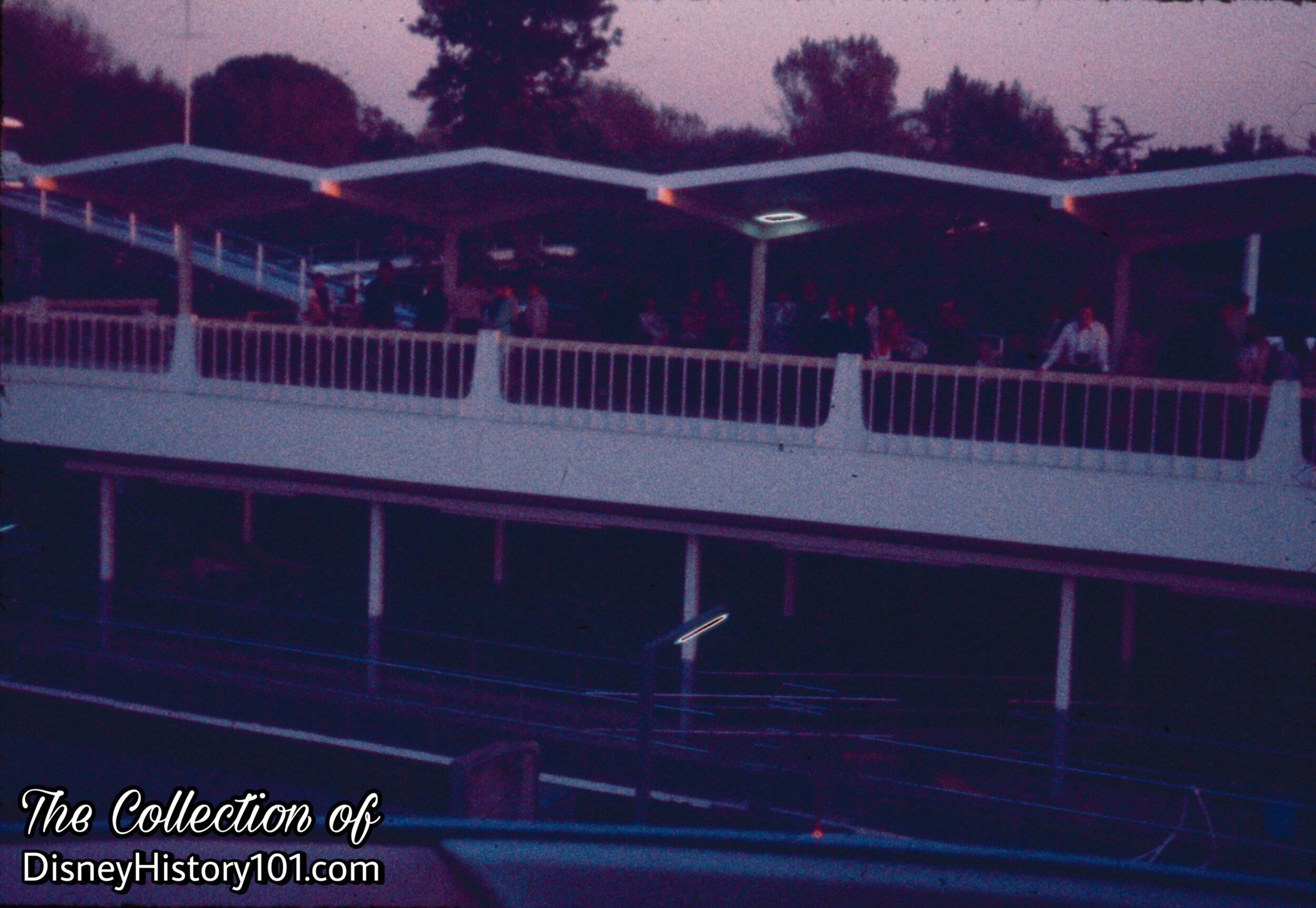
REENTERING THE PARK AND TOMORROWLAND SEGMENT - Monorail Mark III, (1974)
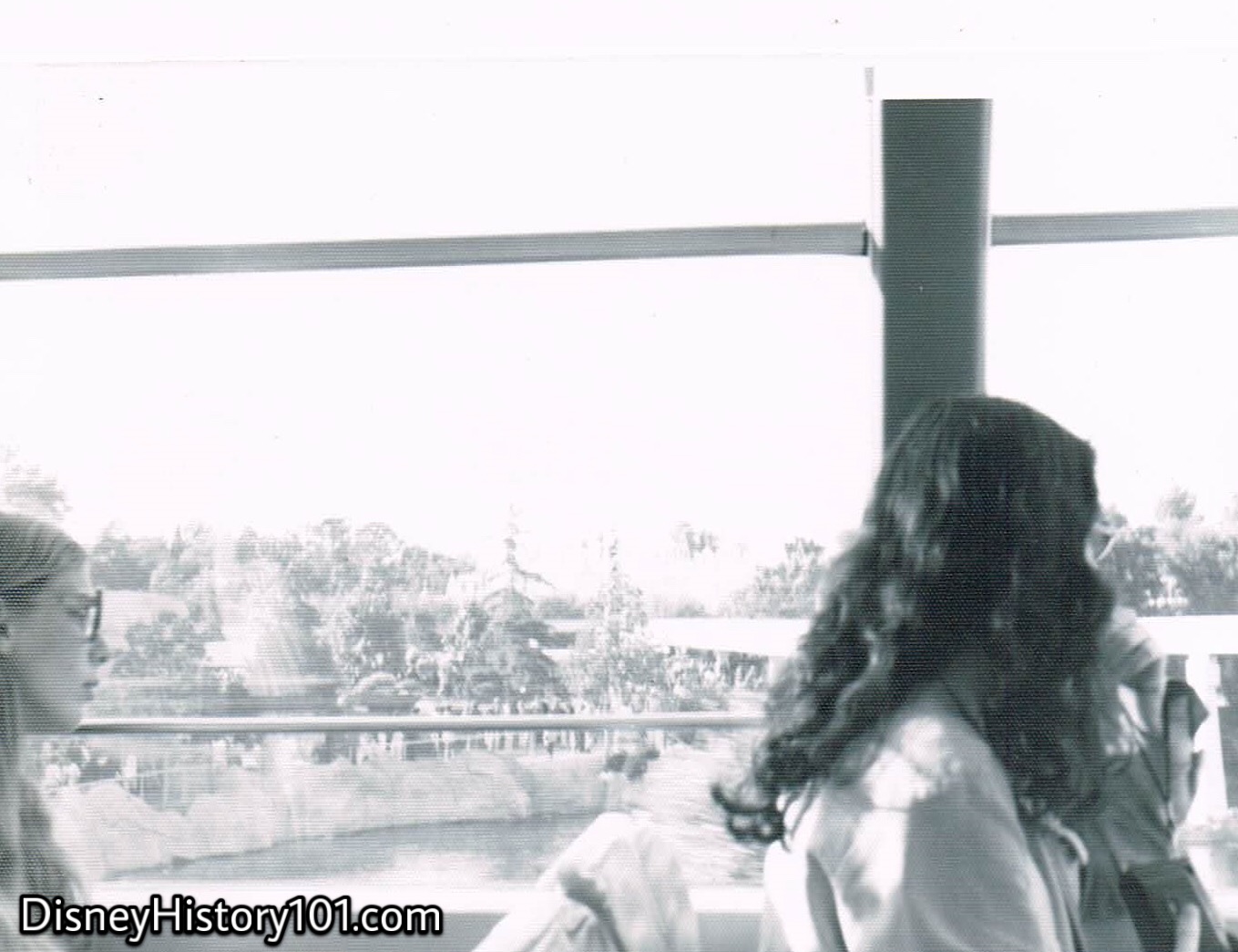
Monorail Mark III, 1975
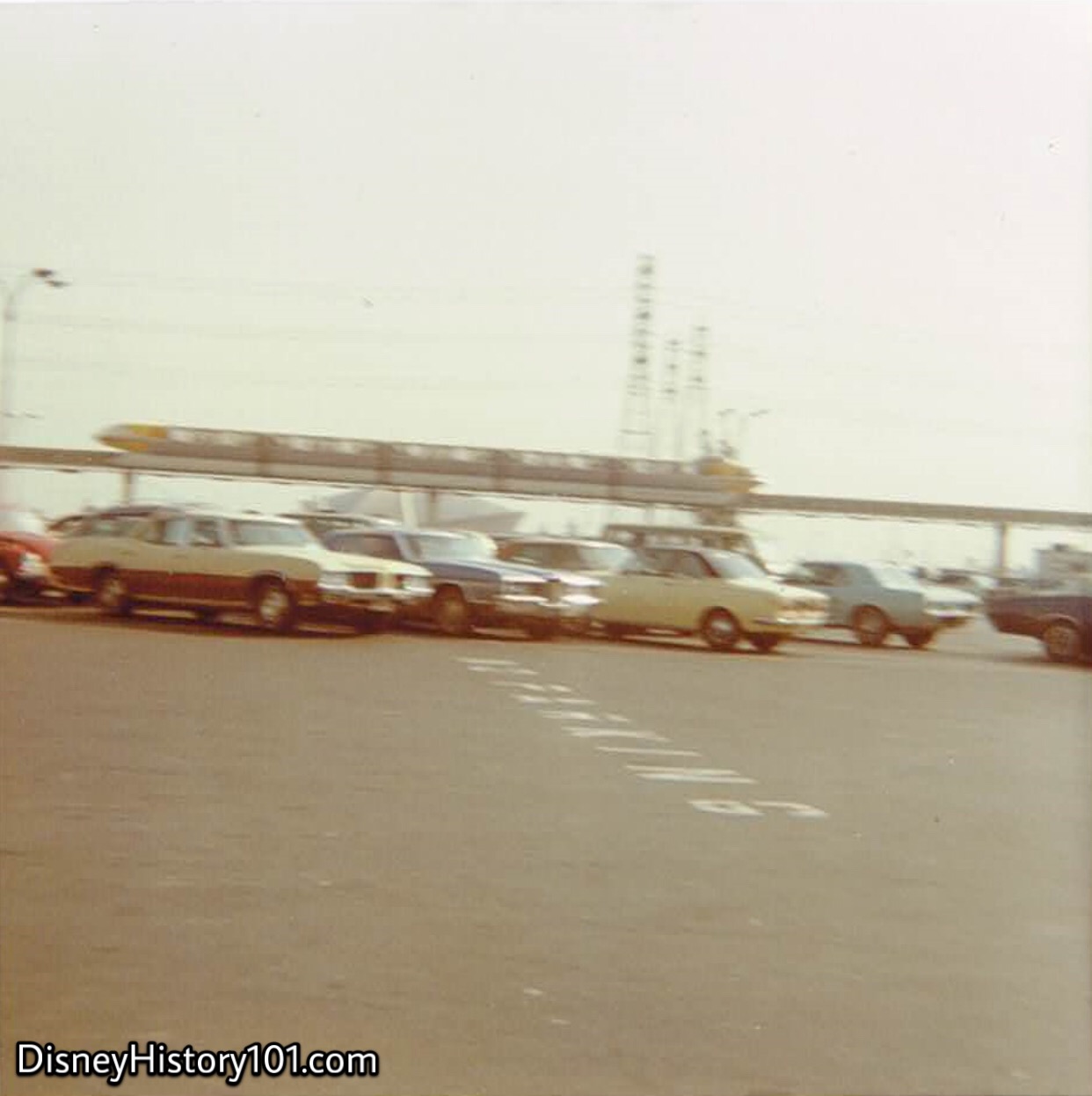
Monorail Mark III Yellow
Only while over the Disneyland Parking Lot, Monorail trains could reach a maximum operating speed of 35 miles per hour.
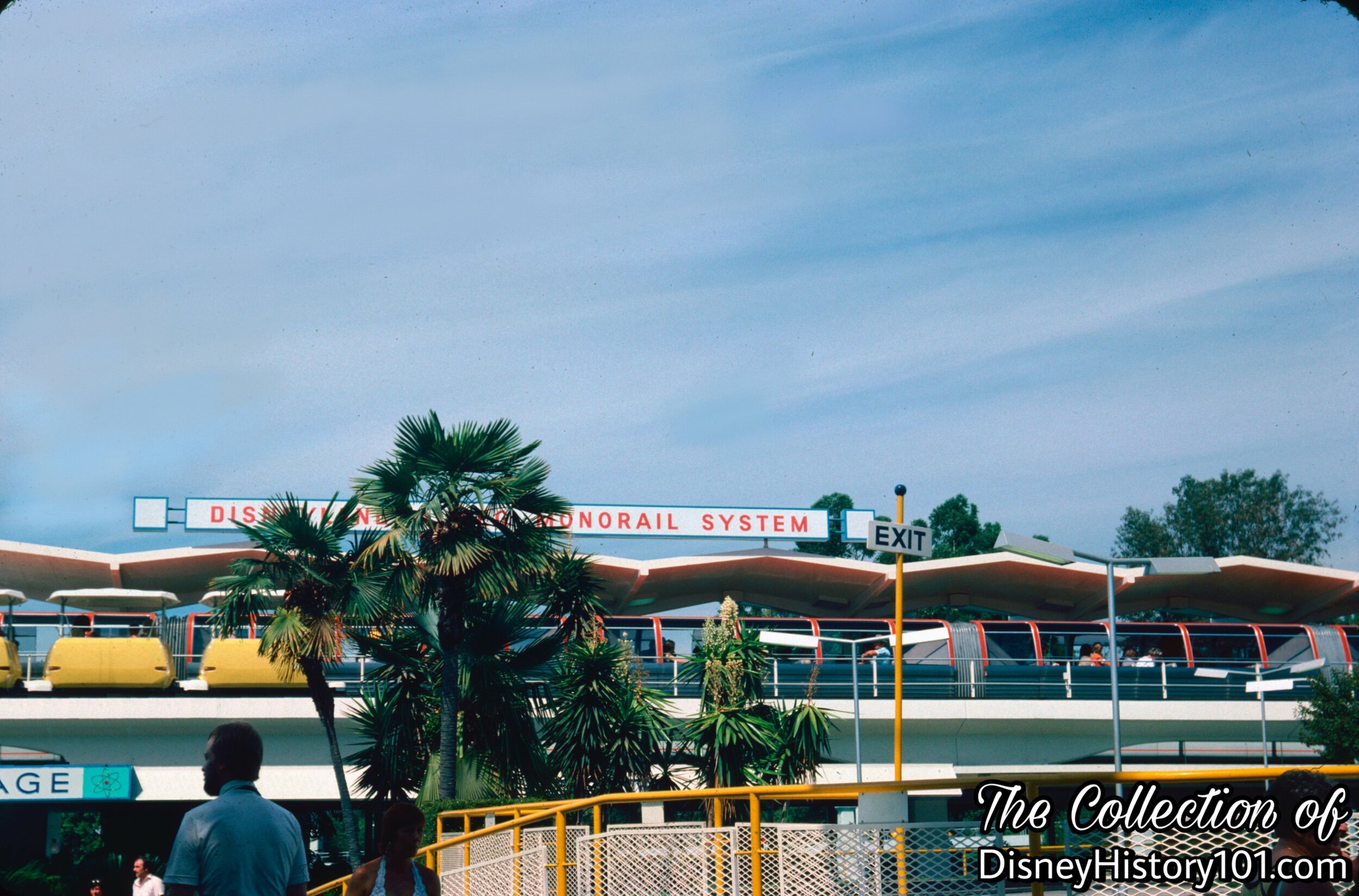
REENTERING THE PARK AND TOMORROWLAND SEGMENT - Monorail Mark III, (1979)
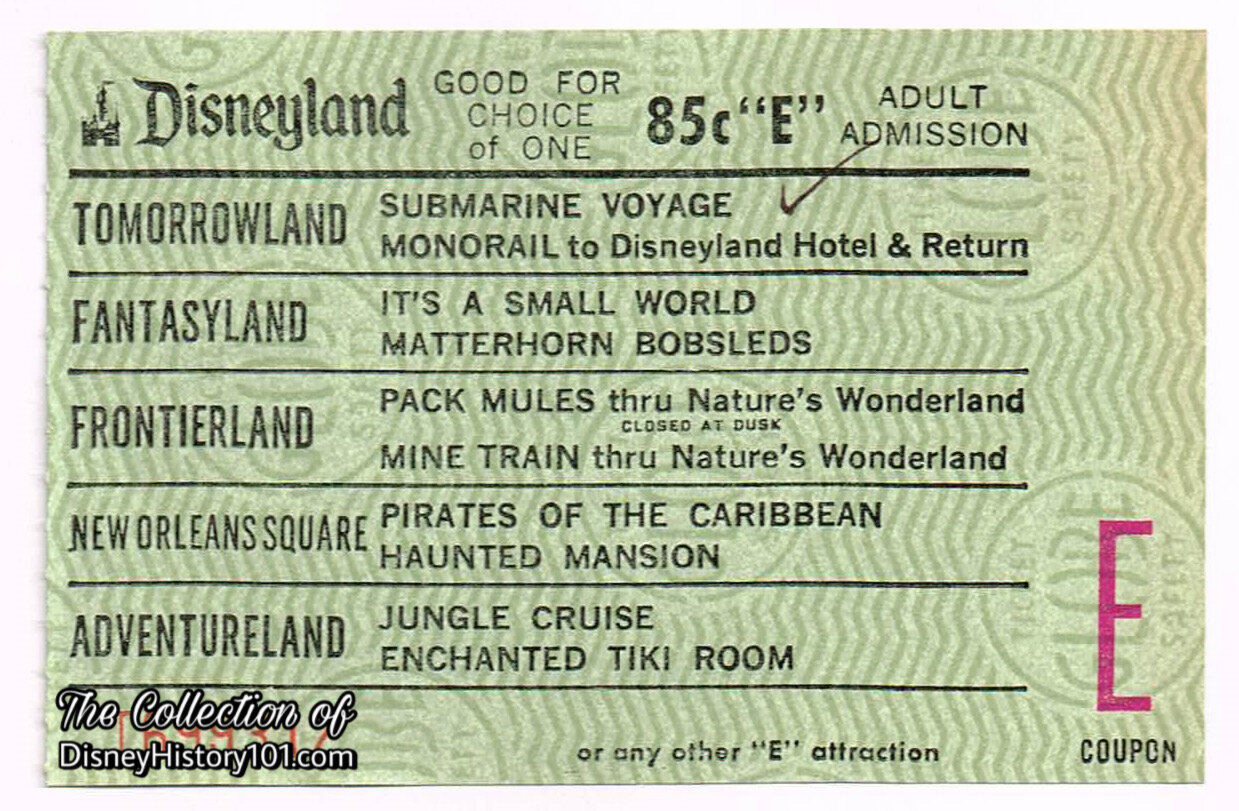
“Ownership and Sponsorship”
By 1972, RETLAW Enterprises, Inc. (the 230-employee, independent company originally founded by Walt Disney, and headquartered in the WED building), owned and operated the Santa Fe & Disneyland Railroad and the Disneyland-Alweg Monorail System. In 1974, when a new agreement could not be reached between Atchison, Topeka & Santa Fe Railway, the Santa Fe name disappeared from Monorail trains.
According to reports compiled by October 2, 1971, a total of 38,713,035 guests had stepped aboard Disneyland’s new Monorail trains! At the springtime of 1971, admission aboard the Monorail Mark IIIs was one “E” Coupon! By 1979 - 1980, admission for passage aboard the Retlaw Enterprises-owned Monorail (“to Disneyland Hotel & return”) was still one “E” coupon, the same as a flight through Space Mountain, stepping aboard Big Thunder Mountain Railroad, or admission to the Country Bear Jamboree! About that time (in April of 1980), Disneyland Monorail Tape Narration had been prepared by Les Perkins for communication with passengers.
“The Speedramp Liability”
Sometime between 1978 and 1981, a minor incident occurred and Disneyland had to pay about $22,000 on behalf of a 12-year-old girl who broke her leg when she tripped on a “Speedramp” leading to the Monorail.
“Monorail Mark III Legacies”
Ultimately (around 1985 and after about 19 years of service), Park Engineers cycled out and replaced the Mark IIIs with new Mark V Monorail trains. The trains were taken out of service and transferred to subcontractors Ride & Show Engineering, Inc. (in nearby San Dimas, California). The first Monorail Mark III to go into service (Monorail Green) was the first to be taken to Ride & Show Engineering, on May 6, 1985. There, each was photographed in detail for future reference, and then the bodies and components of all cars (except for the front car - No.1) were removed from the chassis, inspected, and many were discarded. Few parts were salvaged, like the load wheels (which were sent to the Disneyland Monorail Shop), or the air conditioning evaporator unit and public address system (which was shipped to MBB, in Munich, West Germany). The Side Guide Wheels were disassembled and defective bearings were identified. The Side Guide Spindles were cleaned and checked for cracks and other wear.
It seemed that the chassis and suspension components could also be salvaged for future Monorail Mark Vs (or at the very least, studied). So those parts were sandblasted, after which, checks were performed by Boothe Twining Laboratoriesto search for cracks (using a special process involving magnets, fluid, and ultra violet lights). The results of those tests were recorded and forwarded to MBB.
A torsion test was performed by a specially crafted test fixture created by Ride & Show Engineering, Inc. The company engineering firm also designed new Load Wheels and electrical boxes and studied the chassis frame for possible improvements.
“The Mouseorail”
After more than a year-and-a-half after retirement, one of the old c.1969, 40-foot-long, 5-ton Mark IIIs (Monorail Red) was saved from the scrapyard, and modified into a limousine - “Mickey’s Mouse-o-Rail” - just in time for Disneyland’s 35 Years of Magic celebration! Kraig Kavanagh’s Ultra Limousine (the same Brea company that manufactured the “LiMOUSEine” for the Walt Disney World Resort’s 20th anniversary) lifted the 12-foot-tall five-ton vehicle from where it was being stored (behind the Monorail Maintenance Building) and transported it to the city of Brea. They next modified Old Red with “a stretched chassis from a new 2 1/2-ton Chevy truck” and a V-8 engine. Aesthetic elements were also applied - like new Mickey tail lights and Mickey “ear view mirrors.” Inside the 16-passenger section, a mobile radio broadcast studio, a cellular phone, a TV monitor, VCR, and 200 watt stereo system were installed. The eight-foot-wide and 40-foot-long Mouse-o-Rail was street legal, complete with an automatic transmission and ran on unleaded fuel. After making an appearance in the 1976 Tournament of Roses Parade (in Pasadena, California), the “Mouse-o-Rail” (which had once circled Tomorrowland for 19 years) was equipped for remote radio broadcasts and now embarked on a 35-city tour of North America in January of 1990. The Mouseorail Tour ran from January 15 to July 17, 1990, utilized as a promotional vehicle for contest winners and market radio DJs.

If you’re wondering where the Disneyland Alweg Monorail Mark IV Vintage Views are, there aren’t any in this Gallery. That is because the Monorail Mark IV trains never operated in Disneyland. After the successful pioneering of urban transit (regarding Monorail trains), six five-car Disney World-ALWEG Monorail trains were planned. However, an initial four Monorail Mark IV trains were specifically manufactured for Walt Disney World (beginning in 1969, and late as c.1985-1986). While the Mark IIIs had a separate body attached to a chassis, the Mark IVs chassis were composed of major sub-assemblies bolted together. These new fourth generation Monorails were referred to as “FM,” fully air-conditioned with a 100% honeycomb paneled body (previous Monorail trains were comprised of a partial honeycomb panel design). They had larger and longer chassis and manually operated hinged doors.
While the ALWEG-Disneyalnd Monorail trains initially opened as an attraction, the Walt Disney World Monorail System opened as a practical bi-directional transportation system, utilized for service between the Magic Kingdom and EPCOT Center at Walt Disney World. These aluminum trains were constructed in Orlando, Florida by the Martin Marietta Corporation, with some electrical components manufactured by Disneyland Participant General Electric, at the price of $650,000 each.
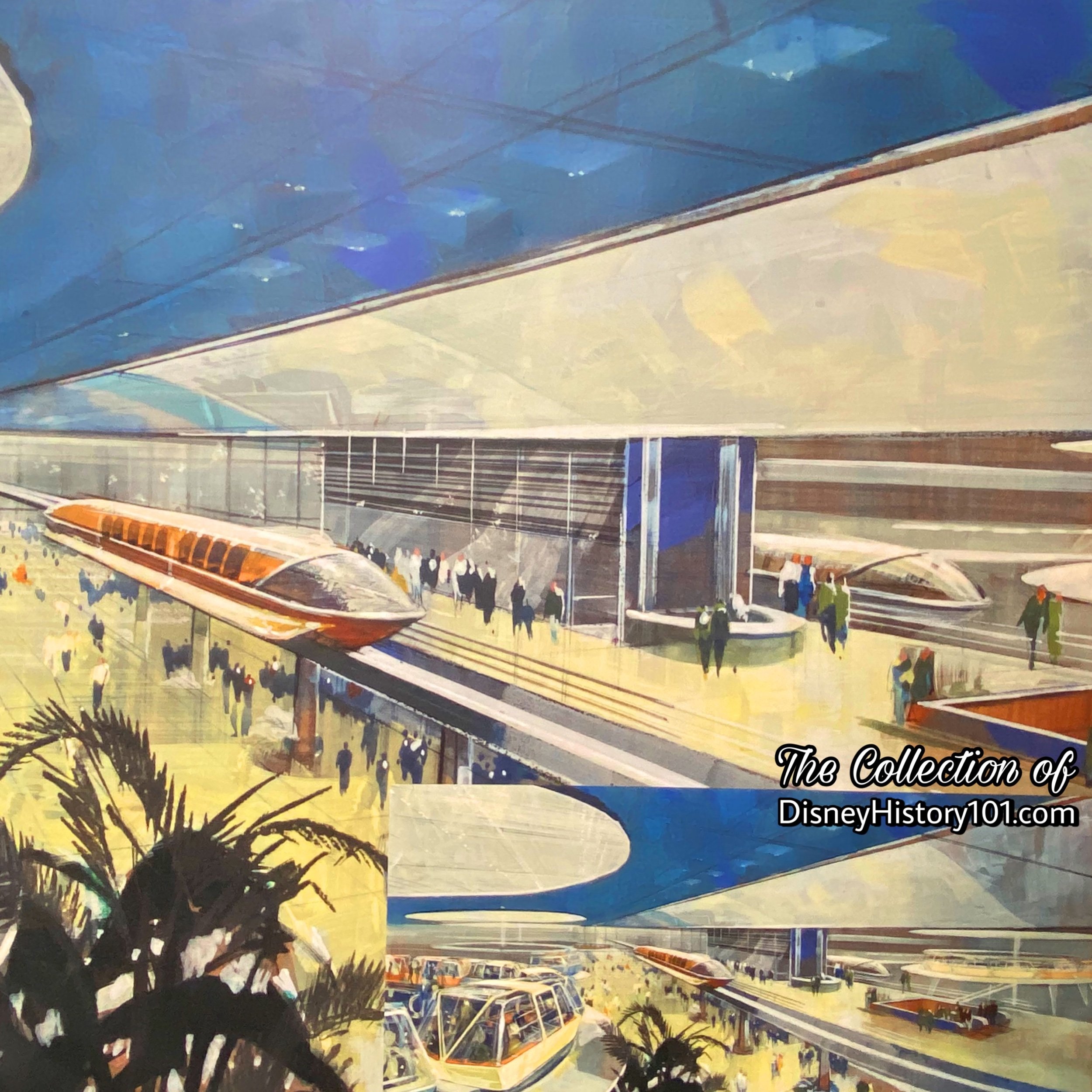
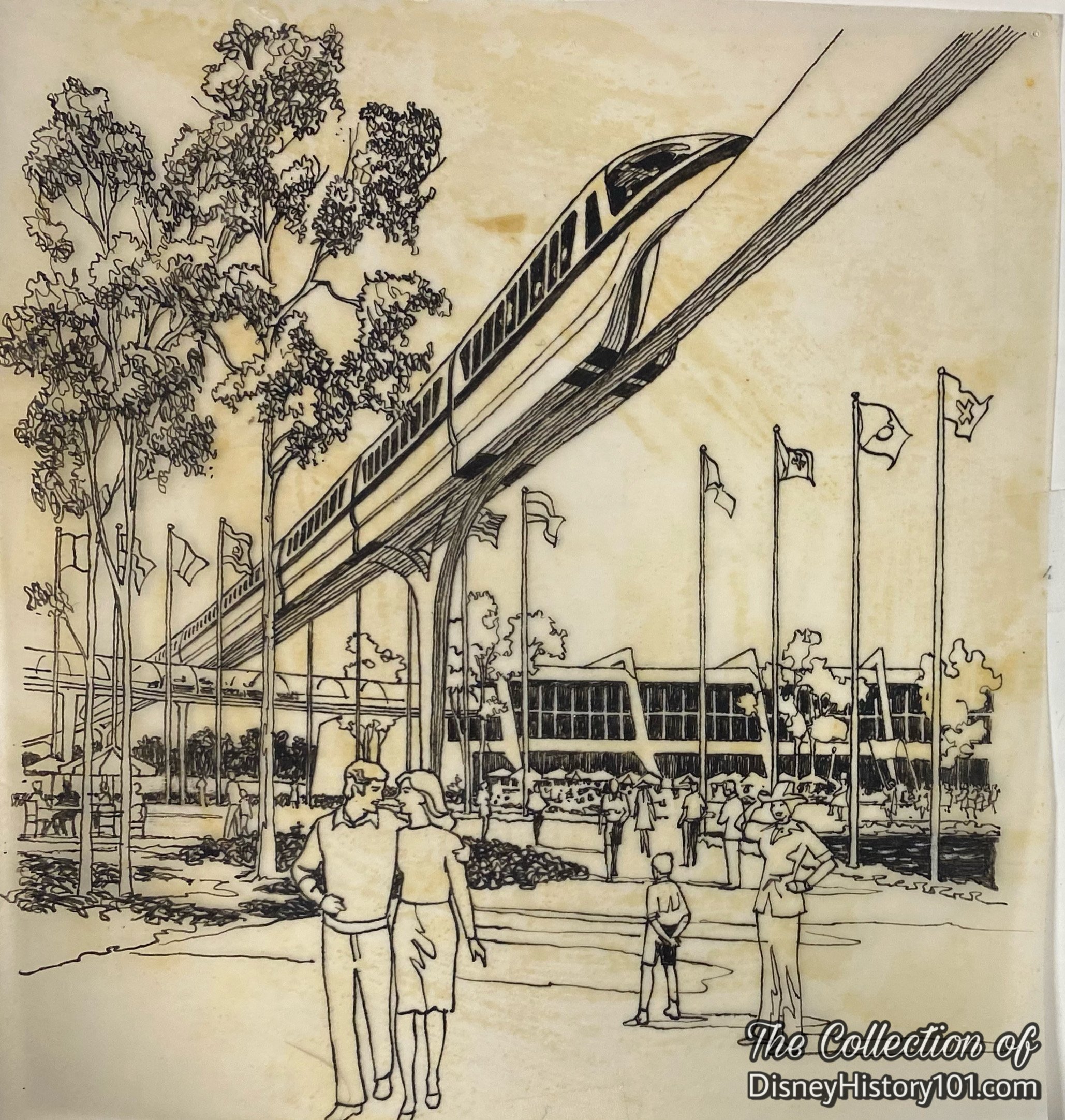
The aforementioned four Monorail Mark IVs began operation in 1971, ultimately growing to ten in number. Each 18,000 lb. train had a passenger capacity of 240 (at an average weight of 170 lbs. per guest; 5 guests per seat), meaning that the loaded train would weigh about 24,000 lbs. These were medium-speed trains (operating at an average of 35 mph-65 mph) for multi-stop service and are what could be described as “Disney 4/5ths scale.”
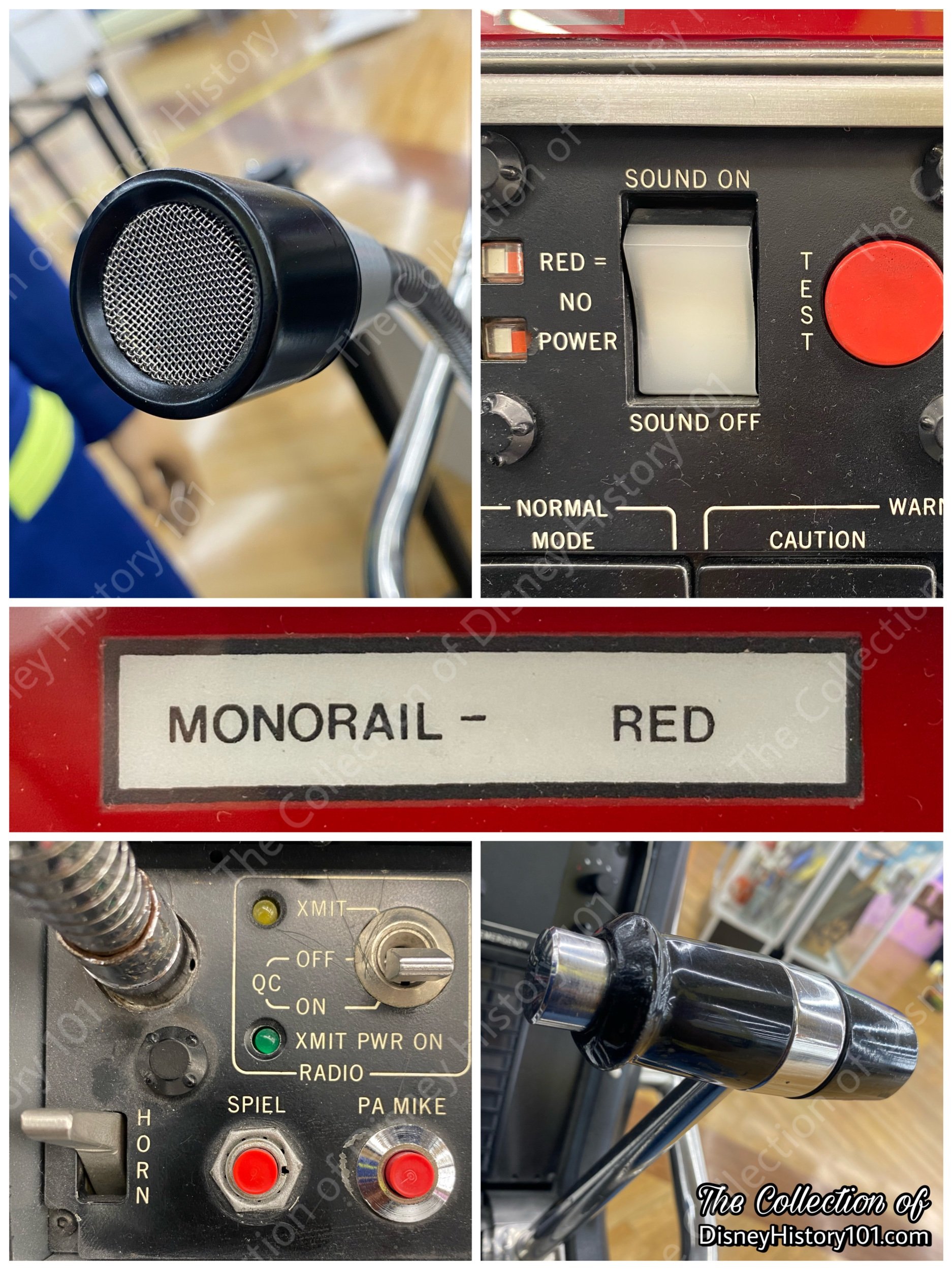
Monorail Mark V Red Controls.

(1985-July 3, 2008)
The first four Monorail designs had the same creator - Bob Gurr (of Walt Disney Imagineering). But soon (by April of 1987), five brand new five-car and two-cabin Monorail Vs had been initially designed by George McGinnis (also of Walt Disney Imagineering Creative Development). George would also go on to design the Mark VI Disney Monorails.
As vital as each wheel of a Monorail bogie were the individual people that contributed to the Monorail Mark V. As it was once said, there were no “spare tires.” Many others of the WED Enterprises Staff were involved, like Randy Prinz (Project Manager) who would oversee the development of the Monorail Vs, Bobn Develle (VP Engineering), Bud Stacy (Director of Engineering), Gene Leasure (Project Engineer), and Jerry Chavalis (Manager; Quality Control). Between 1983 and 1985 Mark Rhodes prepared the project scope, Dave Yanchar prepared the project schedule, Operational Standard Capacities were estimated by Dan Nishikawa, and Disneyland Monorail Design Data was prepared by George Windrum. These team members would prove true what Walt had once said: “I use the whole plant for ideas.”

There were also many exterior “moving parts” involved in the Monorail V project, and so Randy Prinz (WED Enterprises, Inc. Project Manager) would often serve as the mediator between WED Imagineering, and Horst Stoeckermann of Messerschmitt-Bolkow-Blohm GmbH (a transportation technology company, then based out of 8000 Munich 50 Munich, West Germany), and Ride & Show Engineering, Inc. (San Dimas-based subcontractors of MBB). Parts (body, chassis, and other components) were designed by MBB (drawn by Hammel, Geistmeier, and others) and these were then constructed by Ride & Show Engineering, Inc. Walt Disney Imagineering submitted a great deal of reminders (of agreements and understandings) and requirements regarding actions - from welder qualifications to parts and configuration recommendations. Disneyland Participant General Electric also submitted some electrical diagrams (early in the research and development phase) while Disneyland Participant Goodyear (of Luxembourg) provided a supply of two tire models for the Monorail train axles.
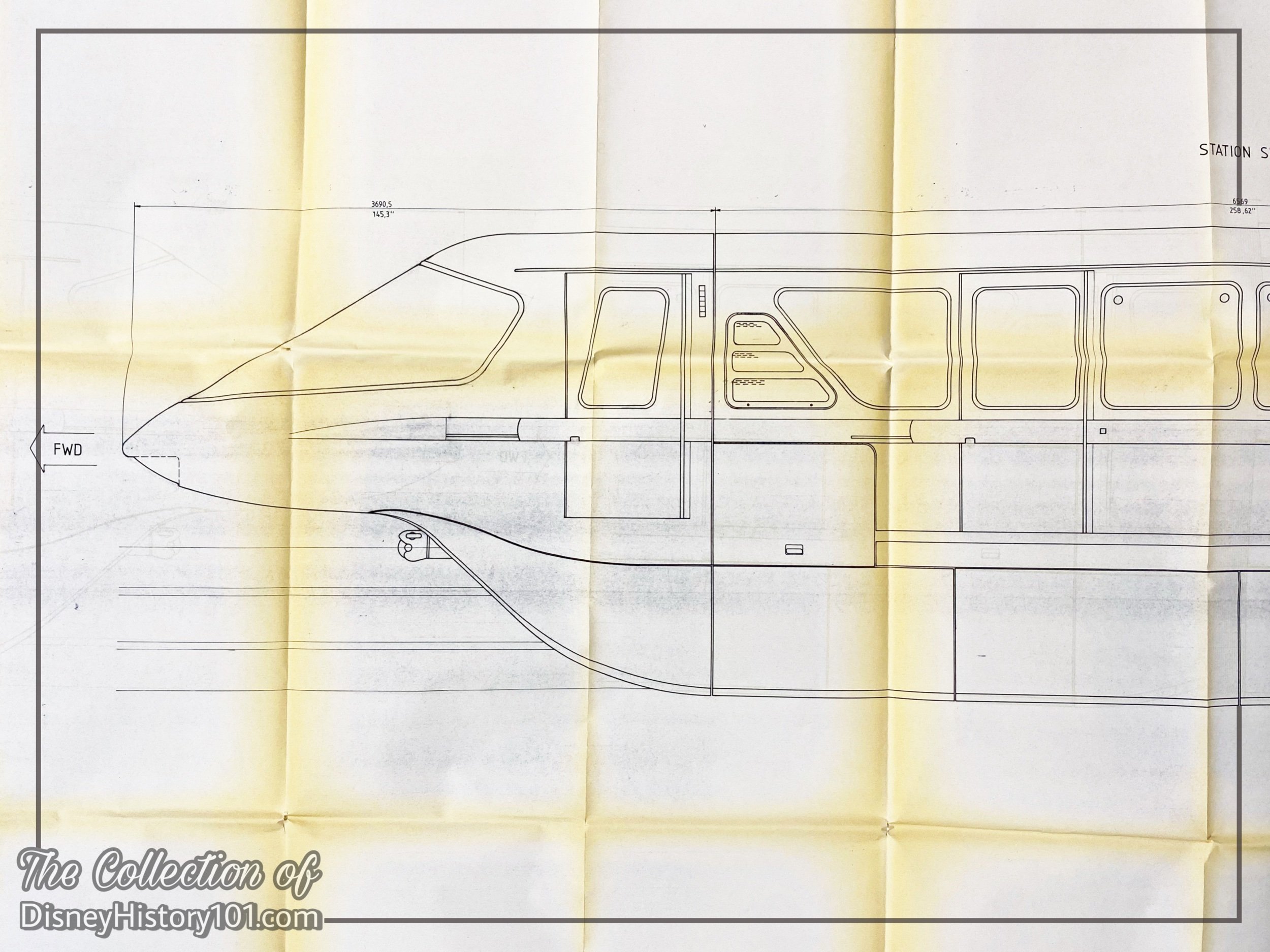
Mark V Monorail Cabin Drawing Excerpts produced c.1985 - the Monorail Train Station Side.
By 1985, Ride & Show Engineering representatives, MBB representatives, and Walt Disney Imagineers had met for discussions in addition to exchanging communications. Divisional Planners, and Project and Divisional Management Representatives had contributed to the “Monorail Upgrade,” with show model mock-ups and sketches produced, as well as much hard copy documentation.
July 30, 1985: Monthly reports (from MBB to WED Enterprises) on the chassis were common by this time.
August 7-9, 1985: WED Enterprises, Inc. held design reviews of Monorail train drawings created by Messerschmitt-Bolkow-Blohm (MBB).
August 12, 1985: Next, WED asked MBB to add an escape roof hatch, non-skid surfaces, and hand railings on the roof of each of the five coaches and tail section of car five. This delayed the project another three months and increased the cost by $350,000. But things were still progressing and after all the additional work - new drawings, parts produced, and structural tests of the roof performed by 22 people.
August 13, 1985: Disney directed MBB to move forward with a proposed design and implement for an escape hatch, non-skid surfaces, and handrails for the roofs of coaches 1-5 and the nose section of car 1 belonging to the Monorail MK5. The cost and production schedule were subsequently negotiated by Disney (mentioned in a letter dated August 14, 1985).
August 14, 1985: WED Enterprises, Inc. prepares comments on the design reviews of MBB’s research and development and forwards them to MBB. A great deal of commentary was made about components, as seen in the following excerpts.
The recessed Train Identification Light (a strobe light) was to be located at the junction of the nose section and adjoining coach section of Car 1 and Car 5. The headlights and taillights were to be selected by George McGinnis and added per his instructions to Herman Boehm. Disney would supply the radio system antenna, while MBB would supply the RGU58 cable that would connect the radio to the antenna. The wide-angled rearview mirror was to measure 6 inches vertically by 4 inches. Door control buttons in the nose section would run vertically and Car 3 would hold a single button and indicator light that would open all doors. MBB was to provide material safety data sheets on their selected silicone adhesive. It was agreed that a “double jam nut and safety wire” would be used on the nose frame and turnbuckle. It was agreed upon to use an alloy floor plate, though fire protection would be required.
The electrical supply to the radio equipment would be 12 volt. The air conditioning system would be circulated through the nose and tail sections.
September 18, 1985: WED Enterprises, Inc. suggested another type of seat material be used after a fire test was performed on MBB’s proposed seat material and an official test report was complied and reviewed.
The subsequent research, development, and production processes were eventful. Production slightly ran behind schedule due to a difference in opinion (between MBB and Ride & Show Engineering) over the electrical design. Flammability tests (conducted by the United States Testing Company, Inc.) of a suggested naugahyde and foam seat cover consumed the material, with “flaming dripping observed during the evaluation.” After some drawings had been completed, meetings (between Disneyland Inc. and WED Enterprises, Inc.) led to the unanimous decision to add emergency exits that allowed guests to evacuate the coaches without an operator.
October 16, 1985: Three aspects of the MK5 project were presented before Mr. Horst Stockermann.
Interior Material - An International Railway Association test procedure had been proposed by Messerschmitt-Bolkow-Blohm GmbH Transportation Technology, but WED Imagineering decided that it was not an acceptable standard for MK5 interior materials. WED still required that all interior materials successfully pass the tests established by FAR or ASTM for fire, smoke and toxicity. In addition to finding an acceptable seat material, WED still required test data on all other materials planned for the interior (in the form of tests reports from independent test laboratories or copies of manufacturers material data sheets documenting successful tests for fire, smoke and toxicity).
Roof Hatch Change Impact - Disney began evaluating this proposal. Joe McHugh of WED corresponded with Horst Stockermann regarding this issue very soon.
Electrical Design - WED was becoming concerned with the status of the electrical design on the MK5. It appeared that MBB and its subcontractors (Ride & Show and Design Works) could not agree upon a program for the electrical work to be done. Additionally, our MK4 experience shows that electrical work was the critical path in the assembly process. Joe McHugh kept MBB informed of steps on Disney's part to eliminate any impact to the chassis re-work schedule. Electrical work was critical to maintaining the construction schedule with the forthcoming 100% Design Review in December. MBB prepared an electrical plan - a consensus of Horst Stockermann and his subcontractors. A plan was reviewed with Disney as soon as possible by reviewing drawings and correspondence and meeting with Horst Stockermann and his representatives.
The electrically-driven trains were not completely brand new - the chassis of the Mark IIIs were upgraded and utilized for the Mark Vs. These Mark Vs (sans bubble cabs) were given all-fiberglas bodies (as opposed to the previous metallic bodies of the Monorail Mark Is - IIIs) and energy efficient units. An onboard computer system would “keep daily maintenance records and operate control functions,” according to “The Disney Monorail System” by ASME. As for aesthetics, the trains would be produced in red, blue, orange, and (for the first time at Disneyland) purple! The new fleet of four Monorail Mark V trains debuted, at the same time that the Disneyland-ALWEG Monorail was renamed the Disneyland Monorail! The all-new trains had a theoretical hourly capacity of 2,145 guests and an operational standard of 1,939.
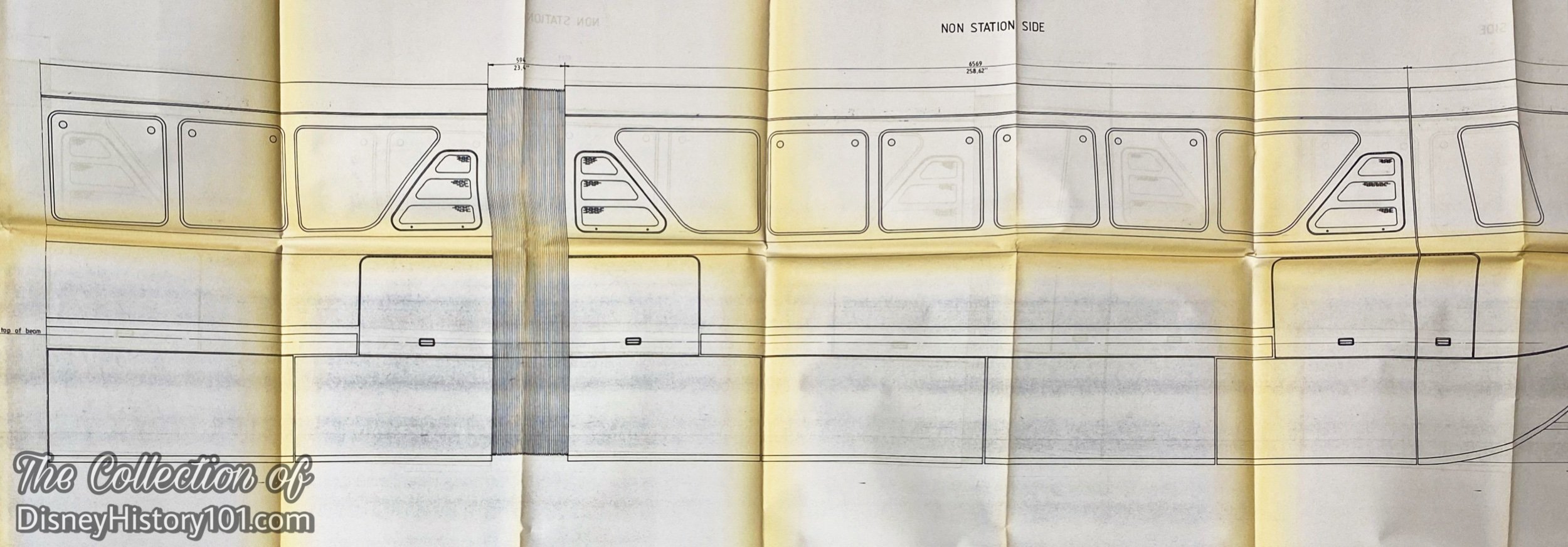
Mark V Monorail Car and Cabin Drawing Excerpts produced c.1985 - the Monorail Train Station Side.
According to a Maintenance Manual produced in 1988, the MK V Monorail train was an aerodynamic designed structure. It was 139.77ft (1677.25 inches) long with a total unladen weight of 74.900 lbs. It is designed to carry 132 passengers. The train had: a front cabin (drivers), passenger cars, a rear cabin, and bellows.
There were four trains - Train 1 (purple), Train 2 (orange), Train 3 (blue), and Train 4 (red).

Maintenance Manual Body Maintenance Manual by Aeromaritime Logistik GMBH, issued 1984.
The trains were subsequently refurbished by the VSL Corporation (in the United States) as late as the mid-1990’s (c.1994-1995). During the 1990s, Disneyland Monorail System passengers were officially welcomed (by the voice of Marc Denis, formerly of KEZY) : “Ladies and gentlemen, this is your captain and I’d like to welcome you aboard The Disneyland Monorail. For your safety during our travels, please keep your hands and arms inside the cabin and remain seated at all times. And, no smoking please. Thank you…KC7032 , Clear!”
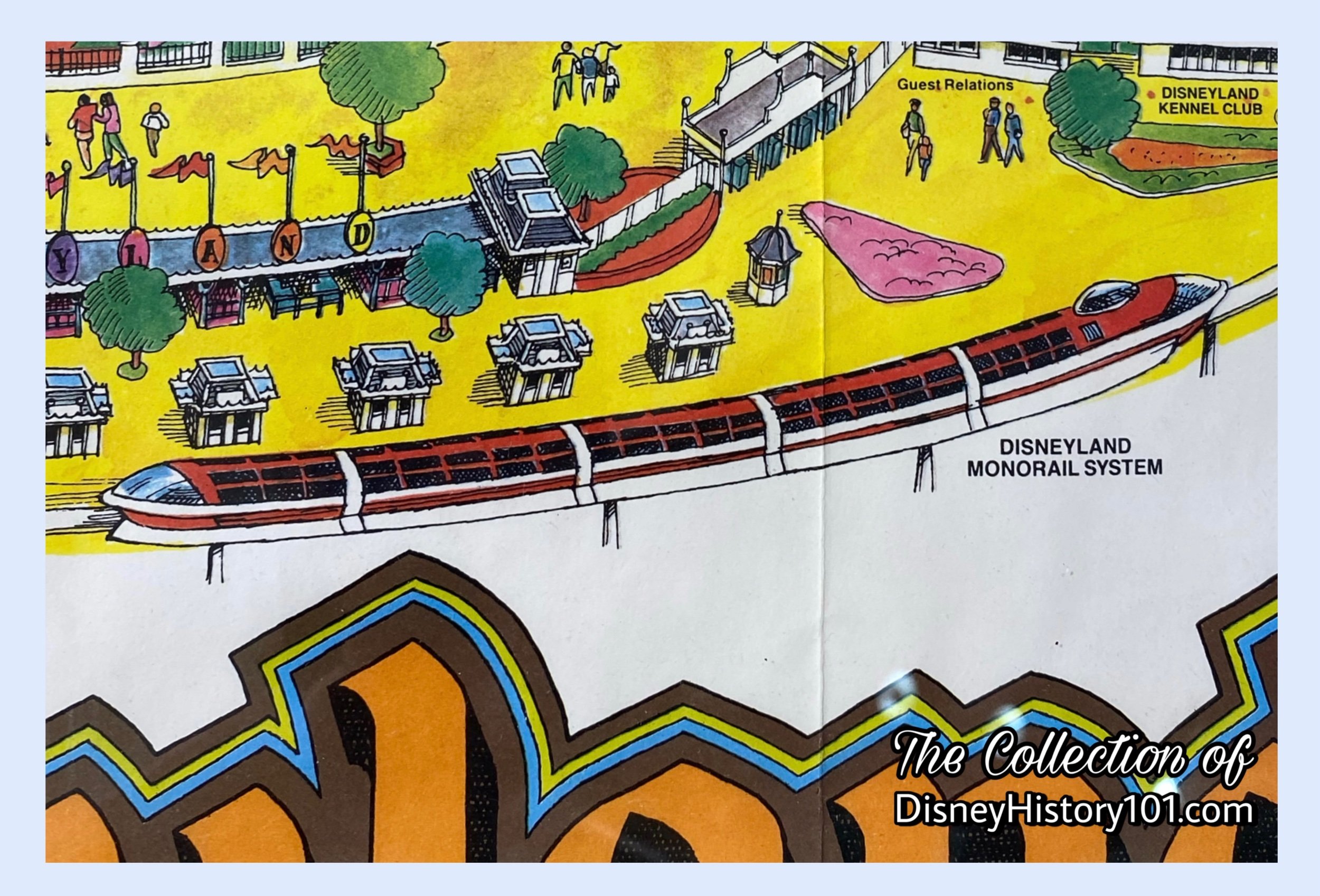
By 1998, daily monorail service continued to offer one-way and round-trip service to Disneyland Resort Hotels.
The Monorail Mark V operated on the 12,300 feet rail until it closed on August 21, 2006 for the remodeling of the Submarine Voyage Thru Liquid Space attraction. By this time, a new Monorail was not just on the “creative menu,” but actually in production. Two years later, brand new red, orange, and blue Mark VII Monorail trains (without the bubble-topped cabs on top) were introduced as a replacement for the Mark Vs on July 3, 2008.
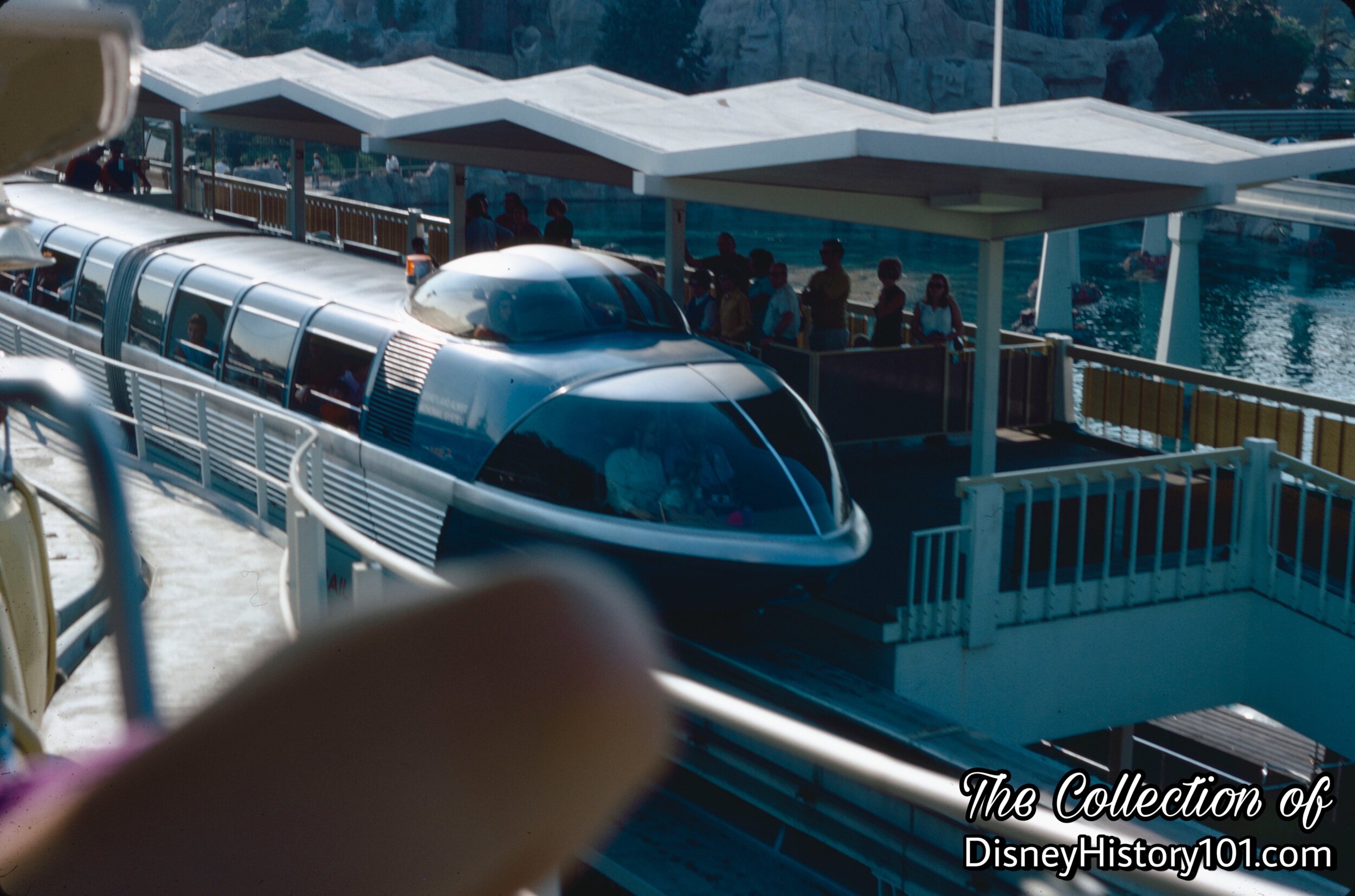
REENTERING THE PARK AND TOMORROWLAND SEGMENT - Monorail Mark
The nose cone of the Monorail train.
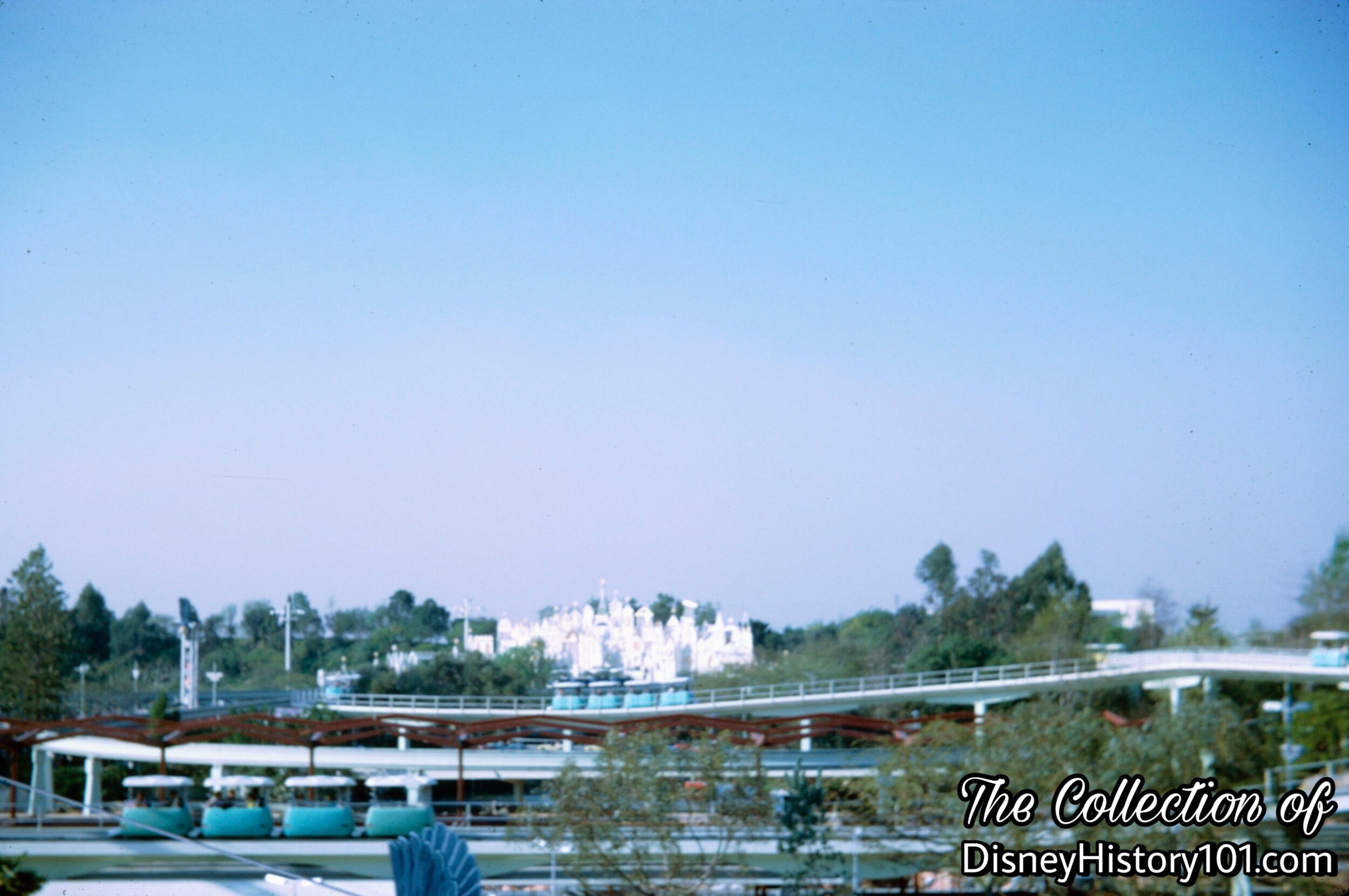
REENTERING THE PARK AND TOMORROWLAND SEGMENT - Monorail Mark Station.
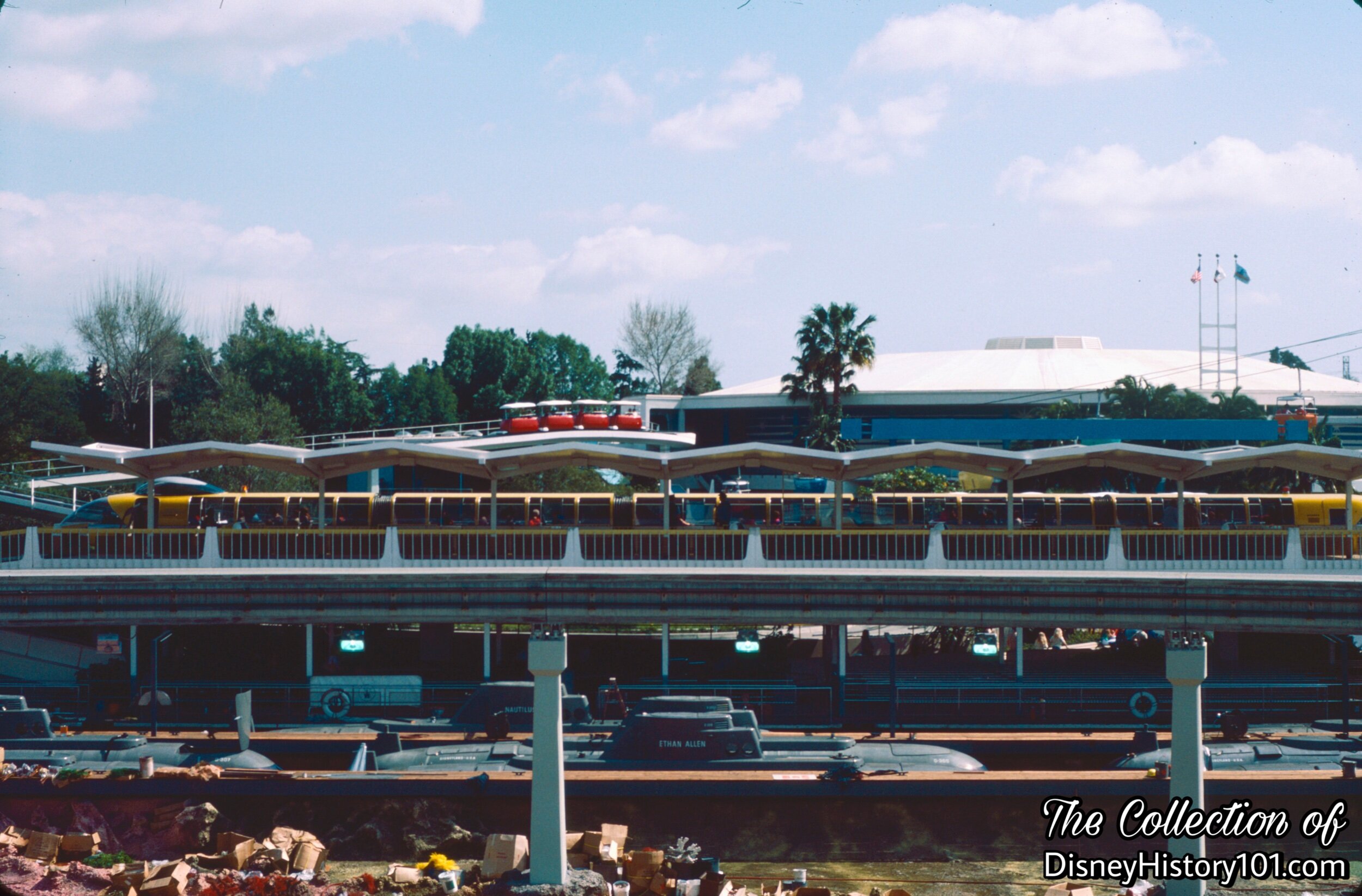
REENTERING THE PARK AND TOMORROWLAND SEGMENT - Monorail Mark V and Monorail Station over the drained Submarine Lagoon.
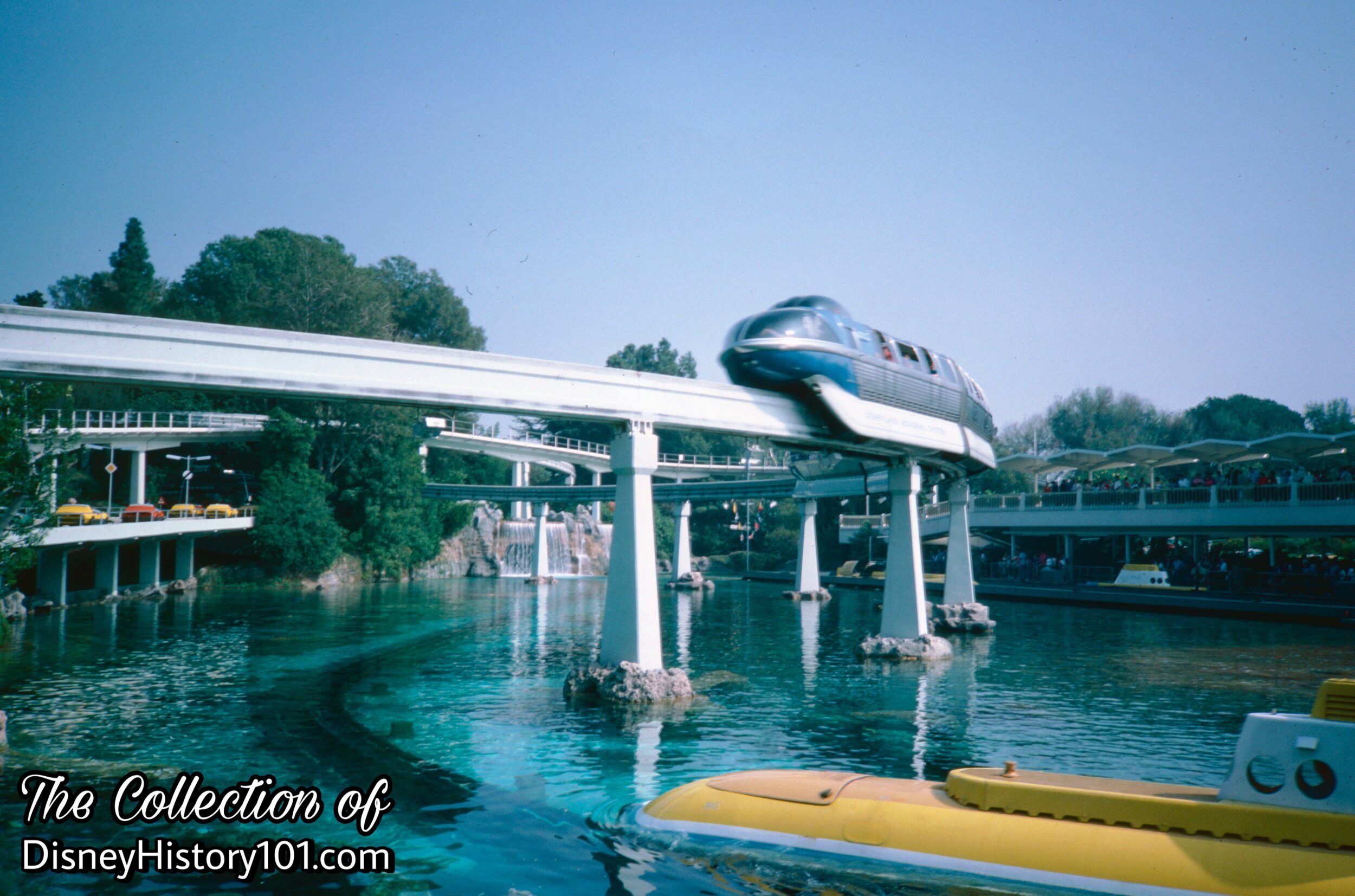
REENTERING THE PARK AND TOMORROWLAND SEGMENT - Monorail Mark V passing over the Submarine Lagoon, (1985)

Monorail Mark V near the Entry Sequence, (August, 1980)
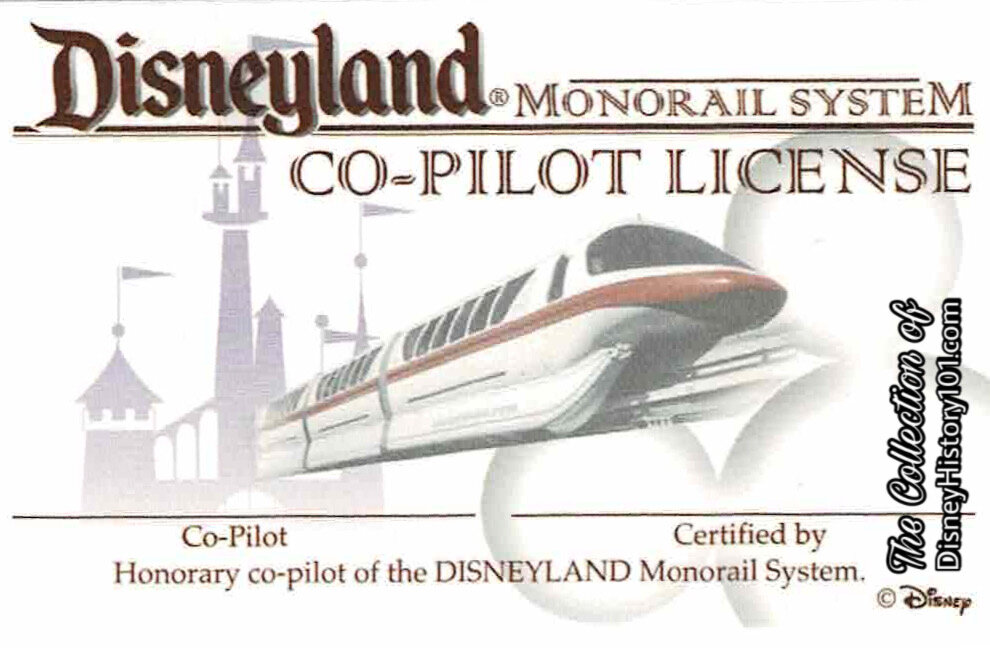
Disneyland Monorail System Co-Pilot License Souvenir
In an age and locale of “Mark Twain Pilot Certificates,” “Autopia Driver’s Licenses,” and “Moon Pilot certificates,” perhaps you had the distinguished honor of becoming a Disneyland Monorail System Co-Pilot.
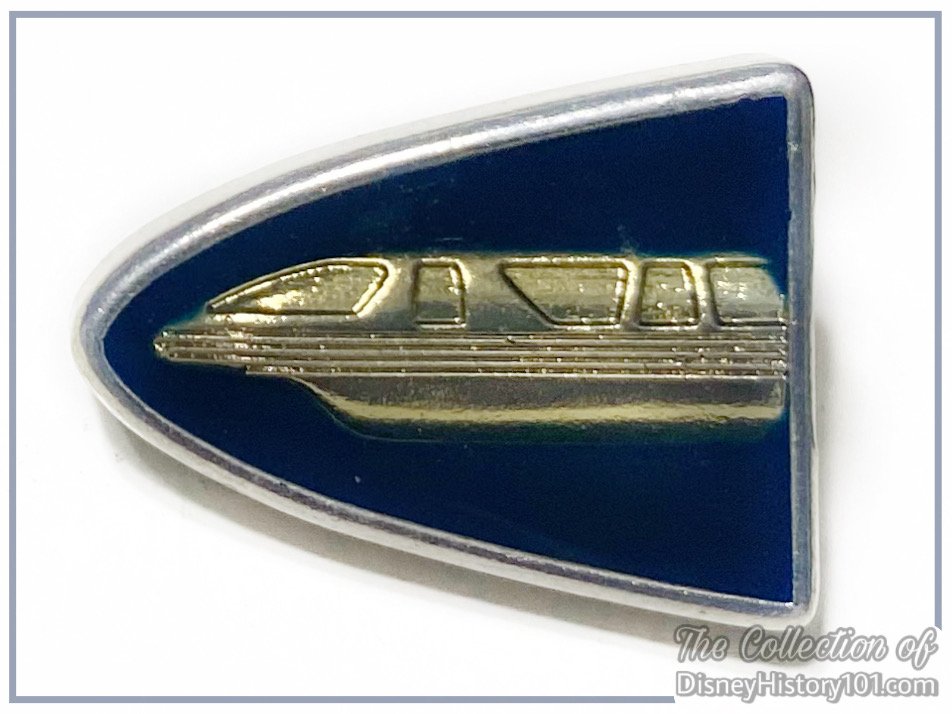
Disney Parks Cast Member Monorail Cabin wardrobe button.
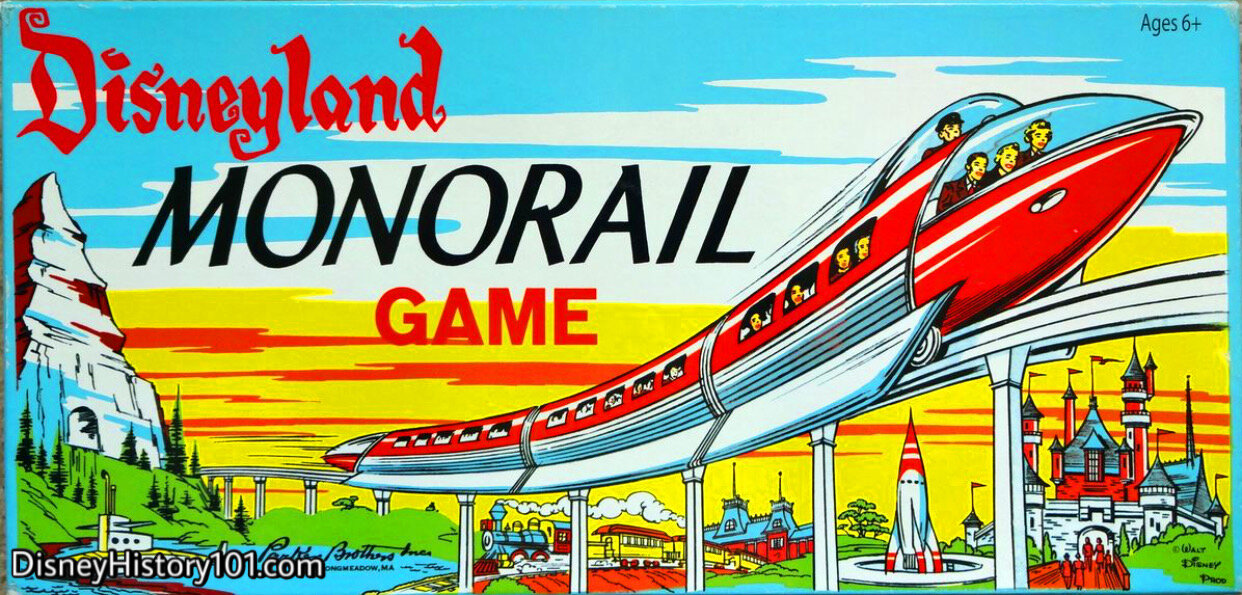
The Disneyland Monorail Game by Parker Brothers, 1960.
“Monorail Mania” was sweeping the nation! Guests who just couldn’t get enough of its fast-paced fun, could purchase some of the licensed products featuring the Disneyland-ALWEG Monorail, like the four-player Parker Bothers Disneyland Monorail Game (featuring the original Mk-1 three car model on the cover art)!
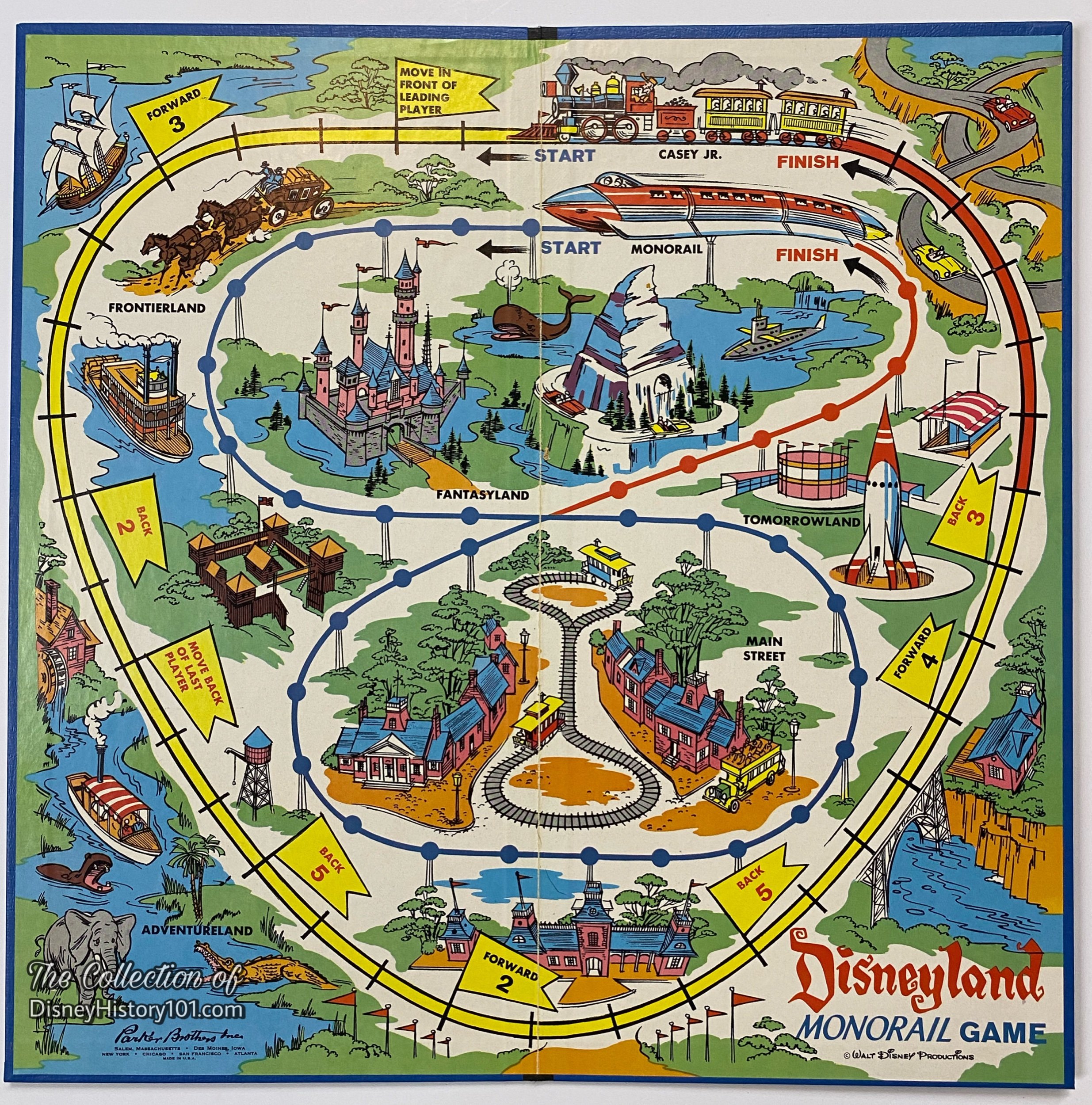
The Disneyland Monorail Game Board, 1960.
The Monorail route of the board game makes one wonder if it inspired the Monorail cameo on Main Street in “40 Pounds of Trouble” starring Tony Curtis.
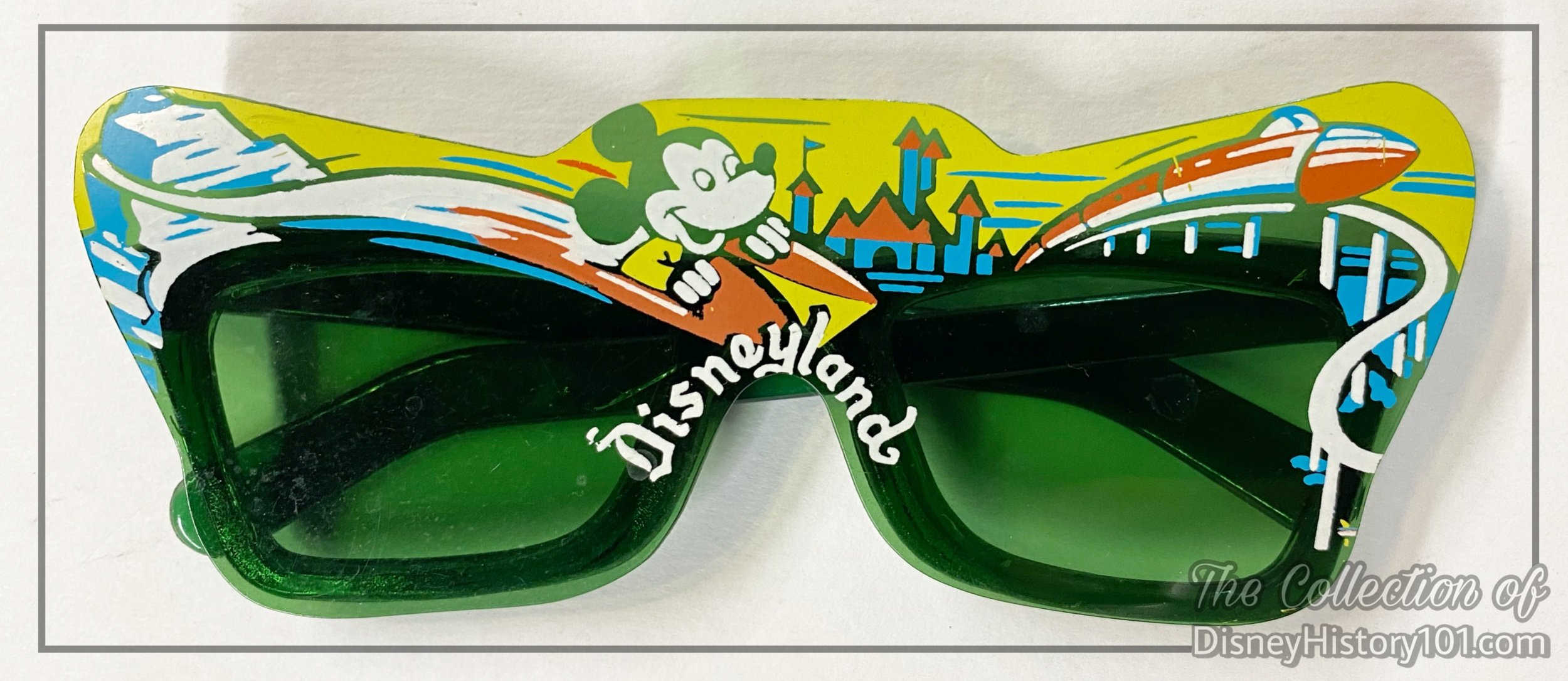
Disneyland Sun Glasses featuring two ‘59 attractions - the Matterhorn Bobsled and the Monorail Train.
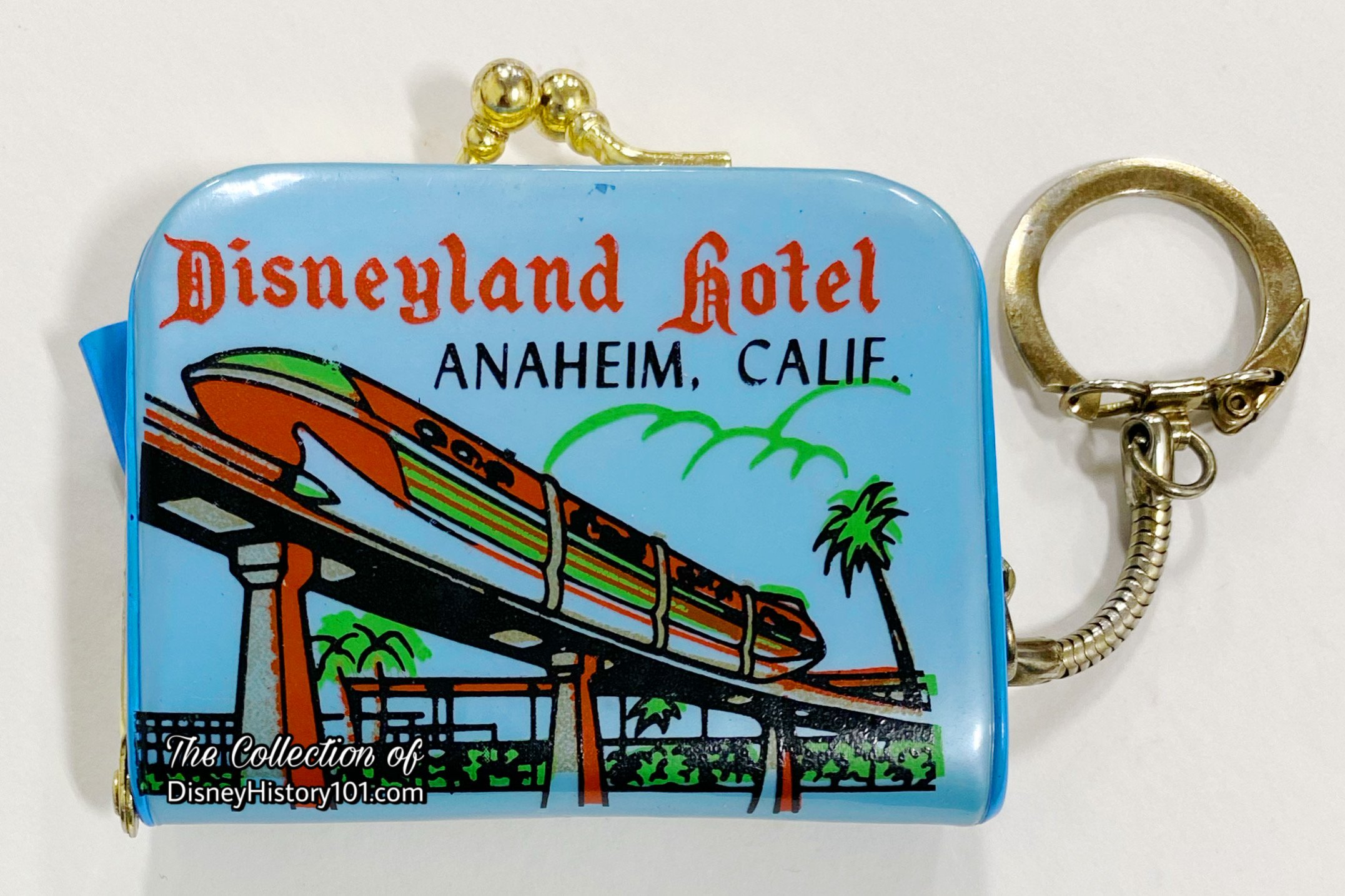
Disneyland Hotel and Monorail Coin Purse
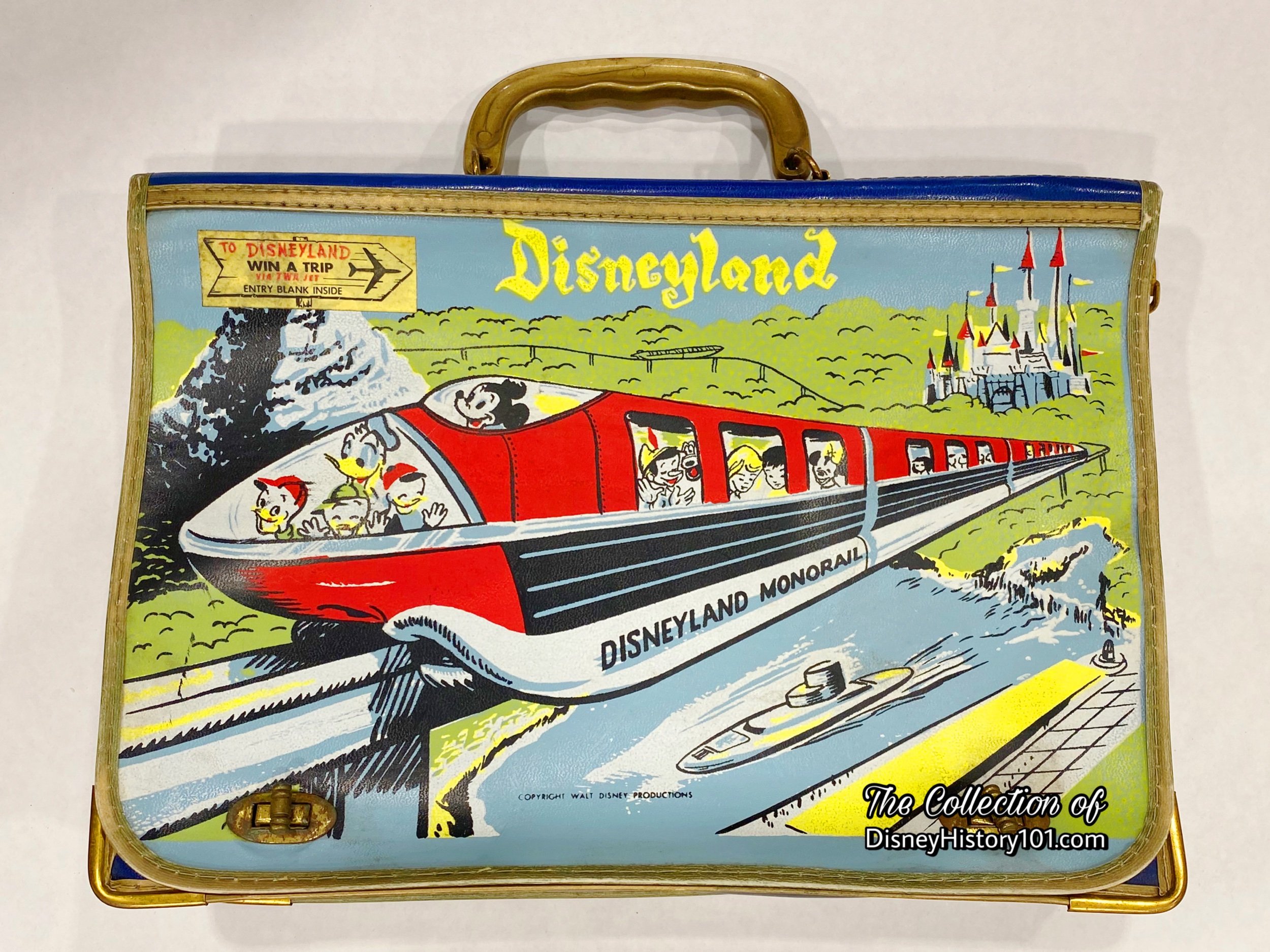
Disneyland Monorail Children's Flight Bag

The Disneyland Lunchbox features the Disneyland Monorail
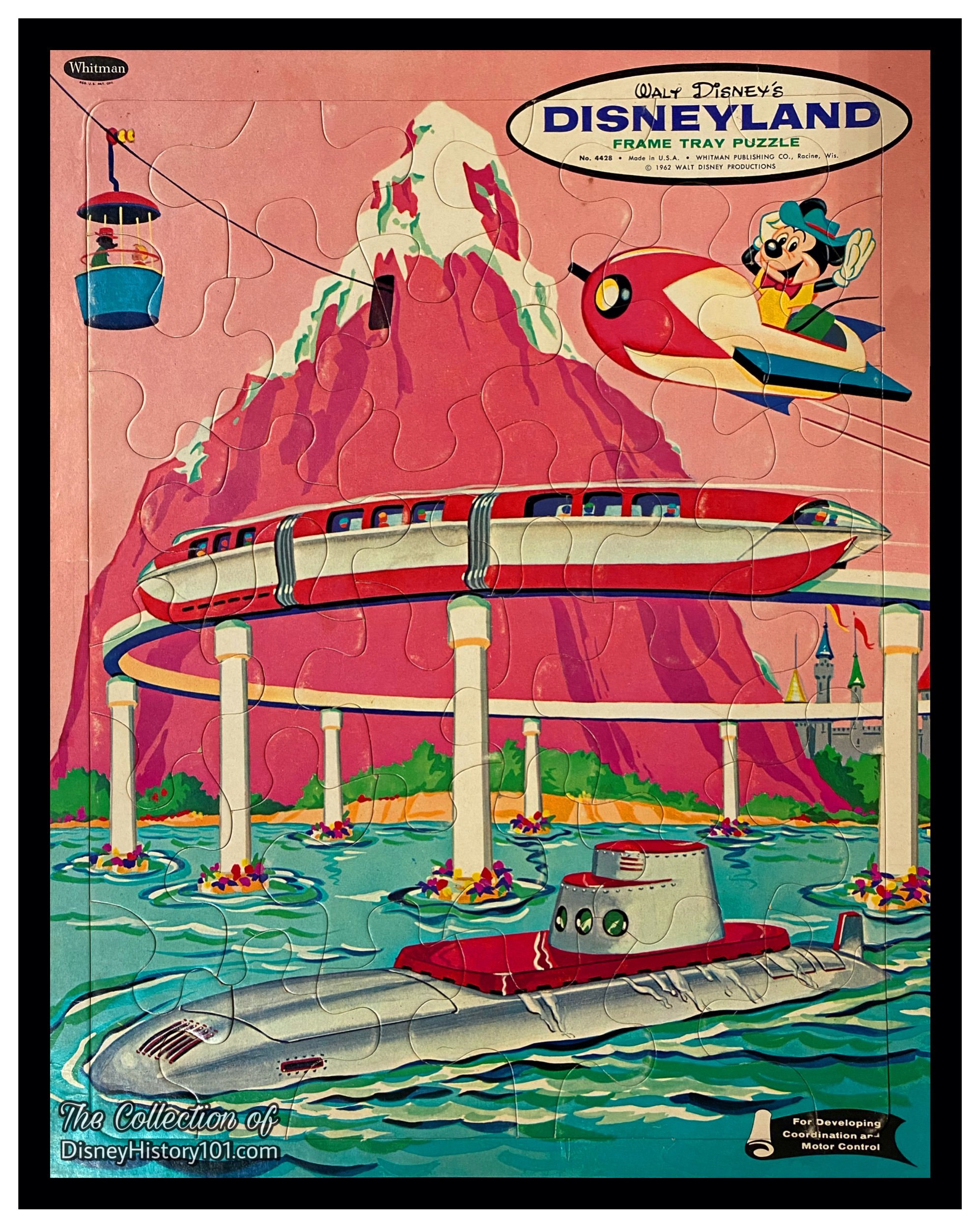
The three-car Monorail train is depicted on a frame tray puzzle by the Whitman Publishing, Co.

The Disneyland-Alweg Monorail attraction debuted on June 14, 1959, but it was not until 1961 (when the Monorail had a practical application of transportation between the Park and the Hotel) that these amazing souvenirs were first made available. Schuco (of Western Germany) manufactured two 1:90 scale Disneyland Alweg Monorail toys from approximately 1961 to 1968. During 1961, a Monorail Red and a Monorail Blue first appeared in Disneyland shops. Both high-quality sets originally sold for a whopping $39.95 in Disneyland More than eleven times the price of an admission ticket in 1961! Outside Disneyland, these trains were even available as far away as West Germany.
As the Disneyland-Alweg Monorail debuted and was updated, MK-I and MK-II, Schuco toy versions (that reflected these changes) were manufactured and sold.

"THE MINI-MONORAIL MK -1 by SCHUCO"
Some of you may be fortunate enough to remember seeing (or purchasing) a Schuco Disneyland Alweg Monorail (carrying an approx. $30.00 - $40.00 price tag in the 1960s). Enjoy a blast from the past with a few photos of the three-car 6333/G set, and a four-car 6333/S set on display at a Disneyana convention. This rare sight comes courtesy of the most definitive Operator and Collector of Schuco Disneyland-Alweg Monorails Doug Burwell!
I would like to add that Doug runs the most extensive site dedicated to these little monorails, and it’s worth checking out HERE !
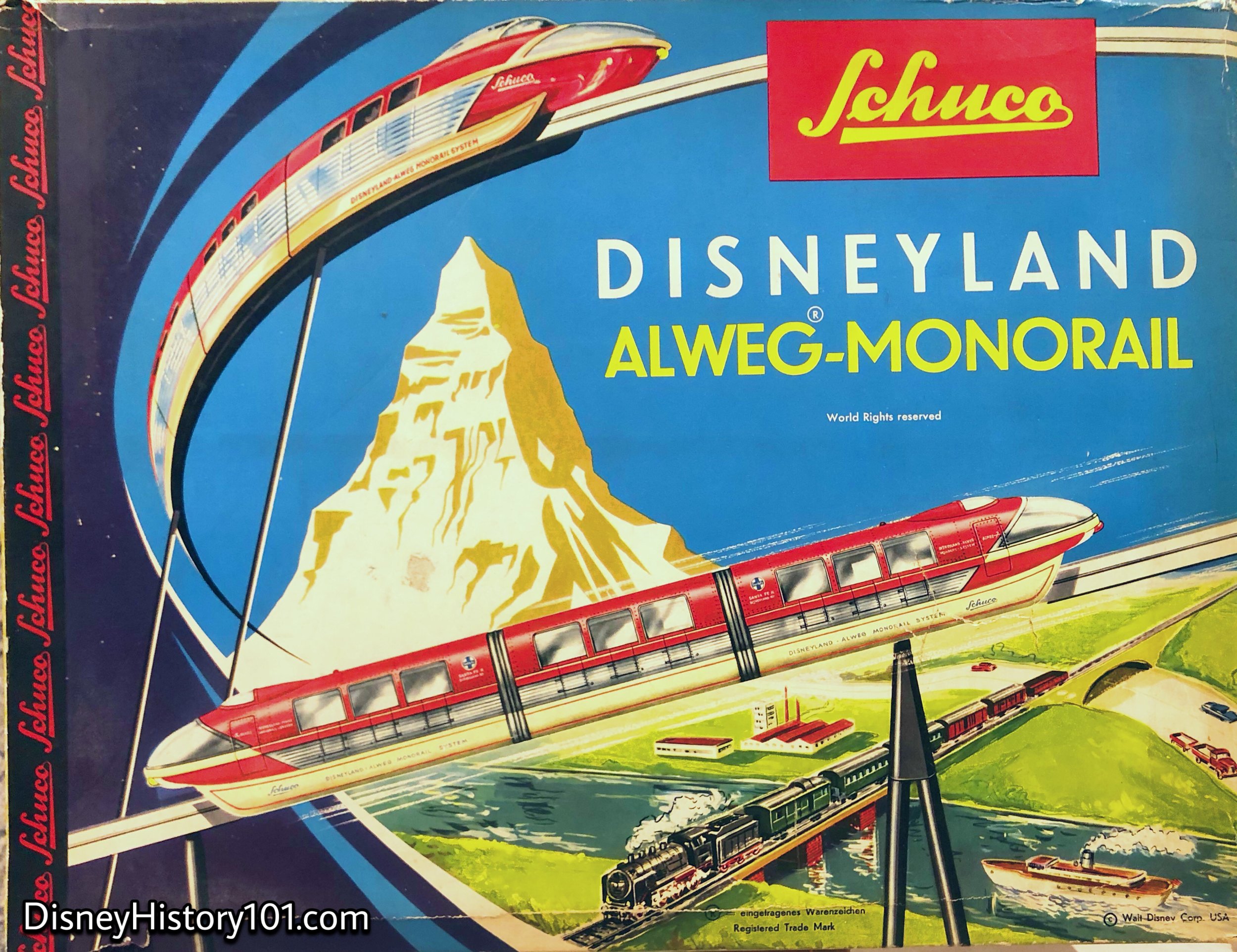
"THE MINI-MONORAIL MK -1 by SCHUCO"
The original three-car Disneyland-Alweg-Monorail MK-1 graces the front of the Schuco-Disneyland-Alweg-Monorail box top!
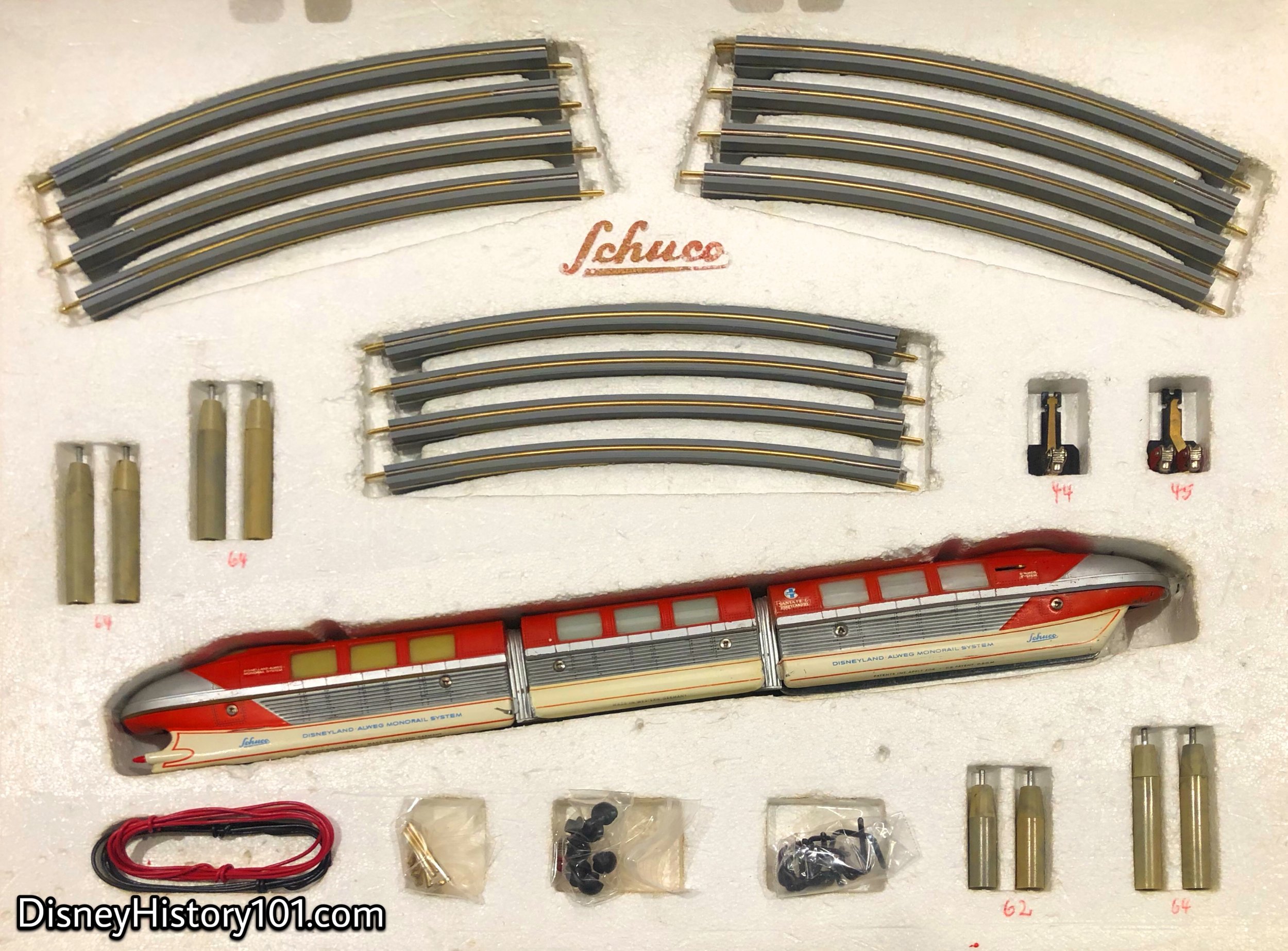
"THE MINI-MONORAIL MK -1 by SCHUCO"
This set also came in blue (Model 63335).
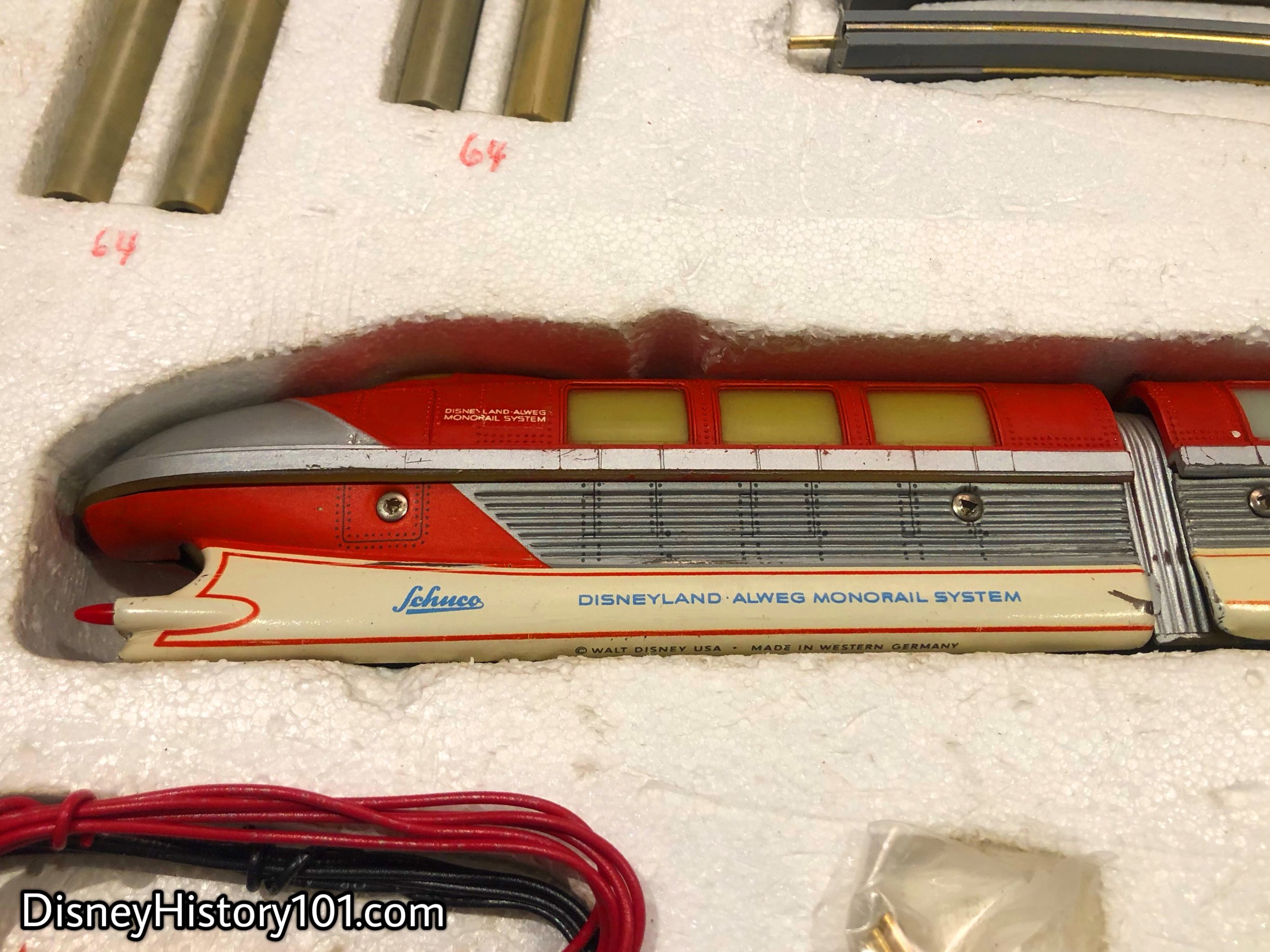
"THE MINI-MONORAIL MK -1 by SCHUCO"
The rarer edition with tail lights.
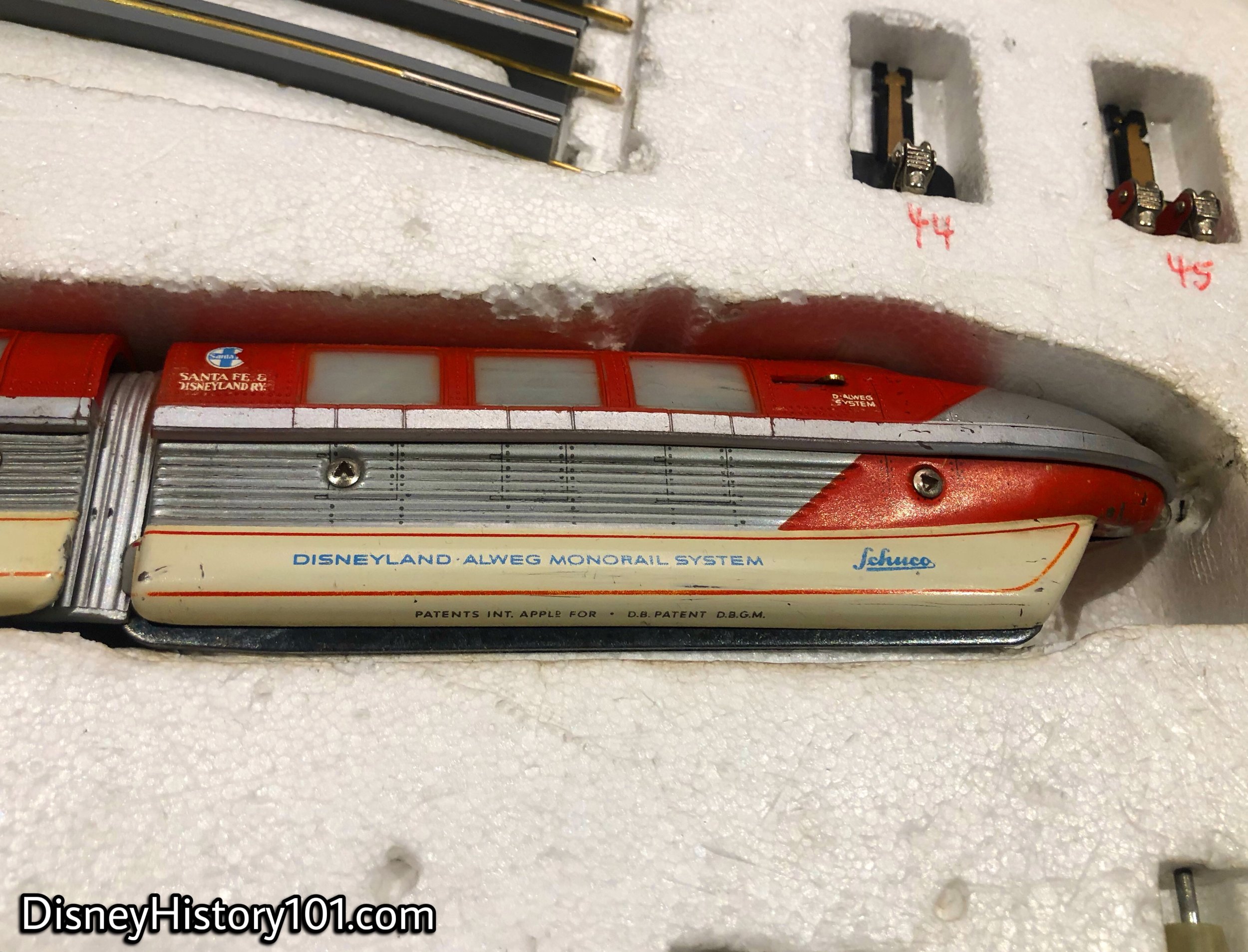
"THE MINI-MONORAIL MK -1 by SCHUCO"
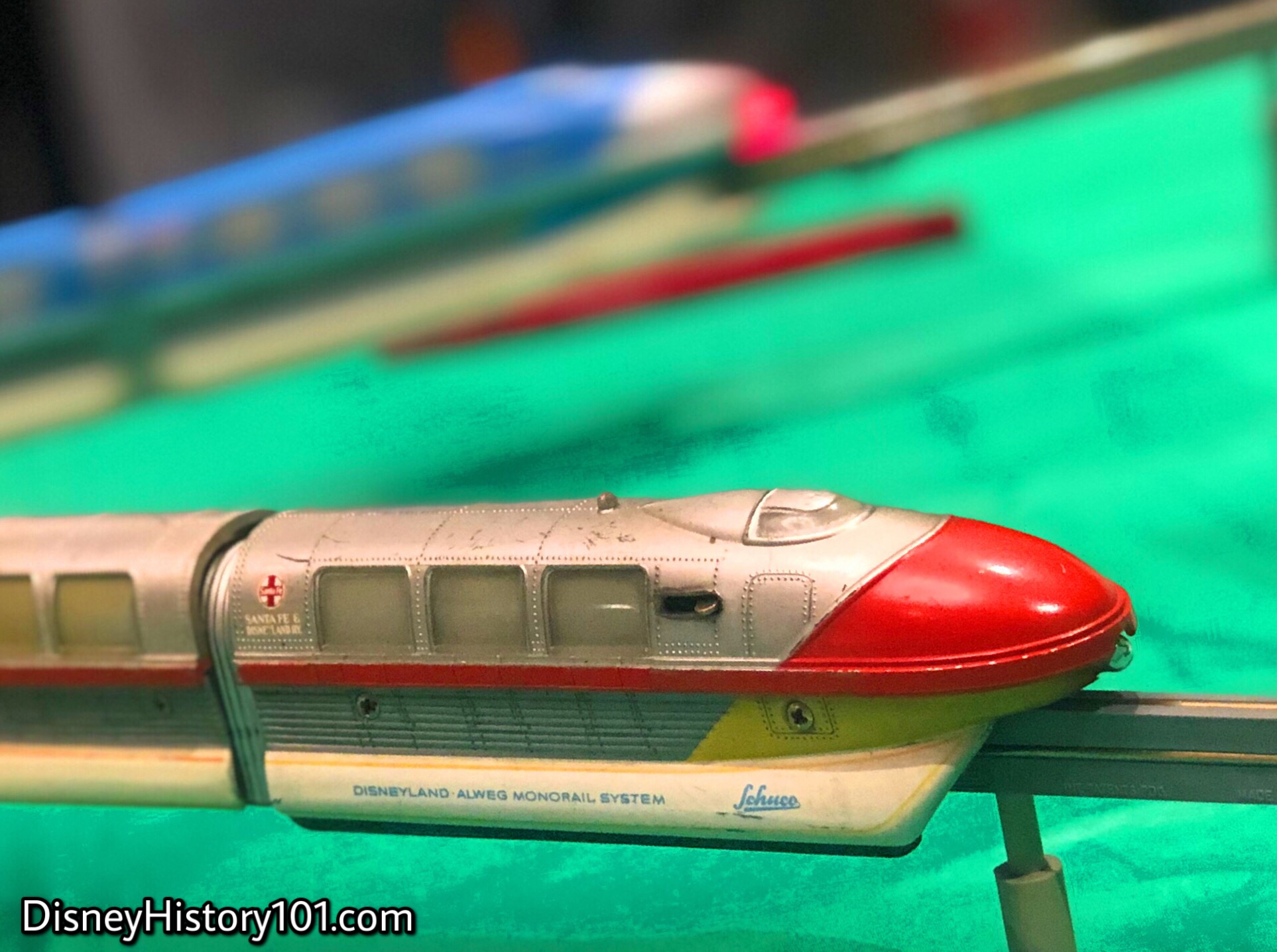
"THE MINI-MONORAIL SILVER by SCHUCO"
Schuco manufactured a red Monorail, blue Monorail, and a silver Monorail (though there was never one of that color that operated in Disneyland). It is believed that the color of this version was inspired by WED artwork that was utilized by Schuco to create a representation that was accurate as possible to the park attraction.
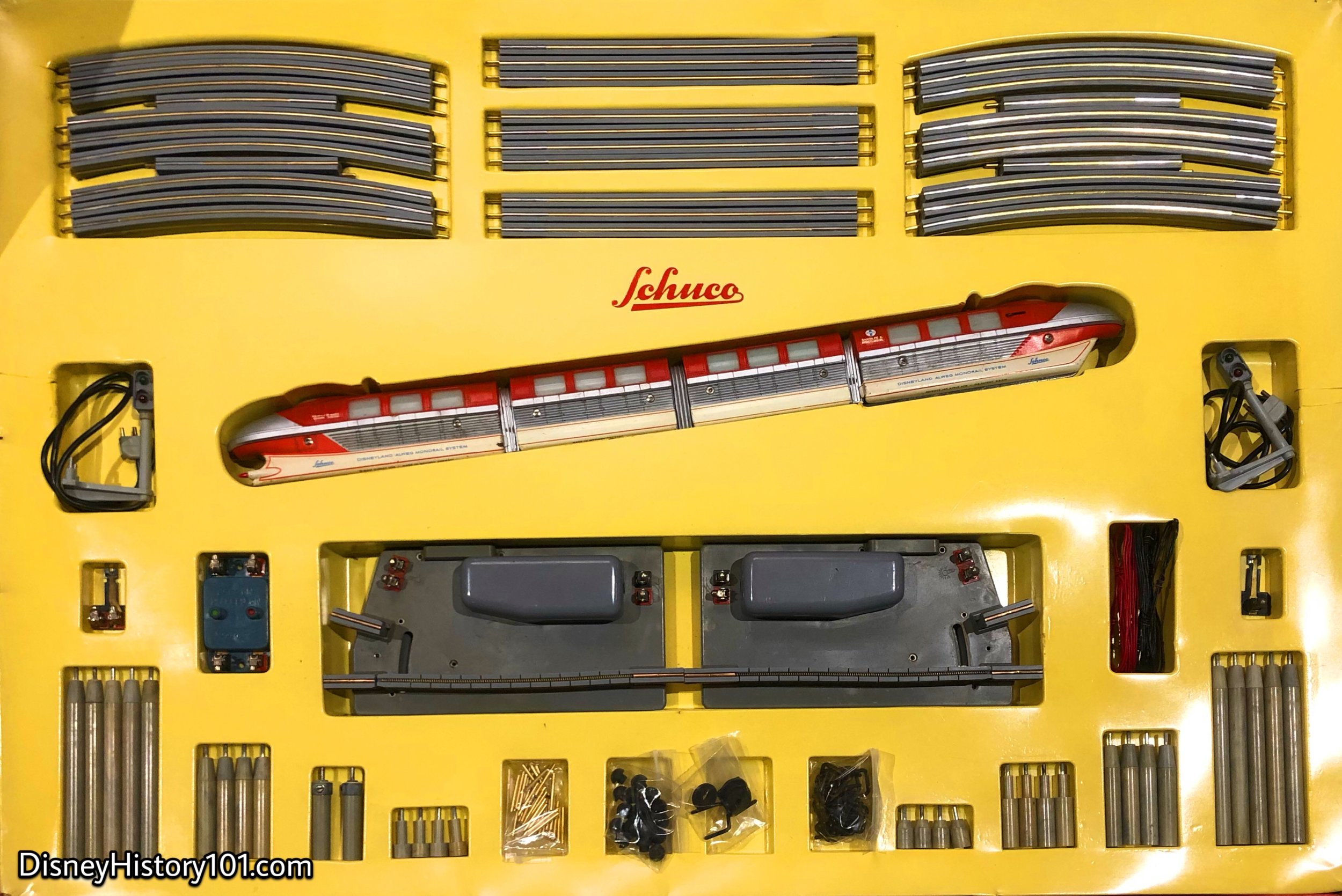
Later versions had extra features to match the changes made on the true-life Disneyland-Alweg Monorail. In addition to a fourth car, additional lengths of Beamway, Pylons, and Switches were now included!
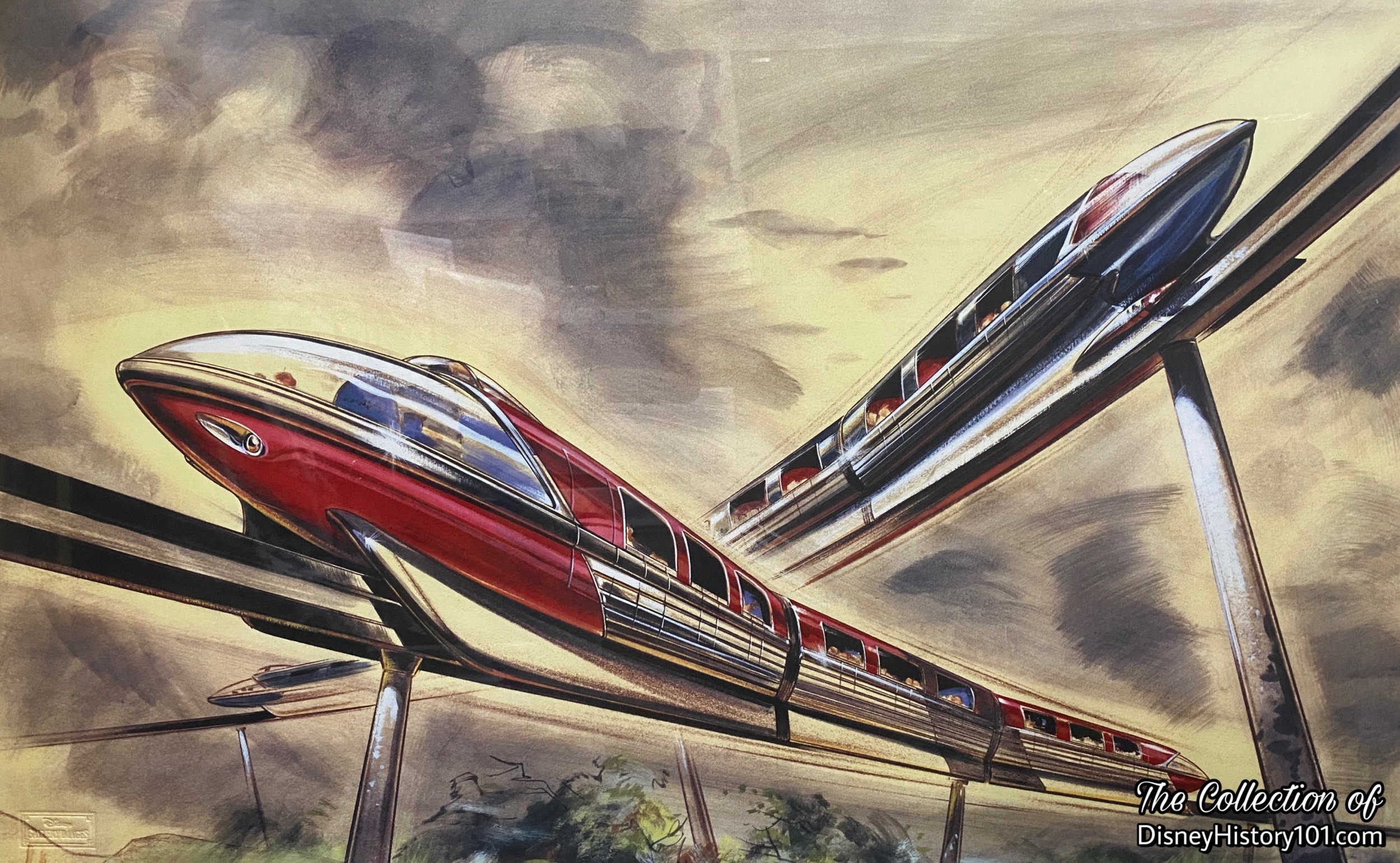
“Crossing Monorails”, watercolor, by John Hench, c. 1963; Printed in a limited edition of 350 by The Disney Gallery in 1994.
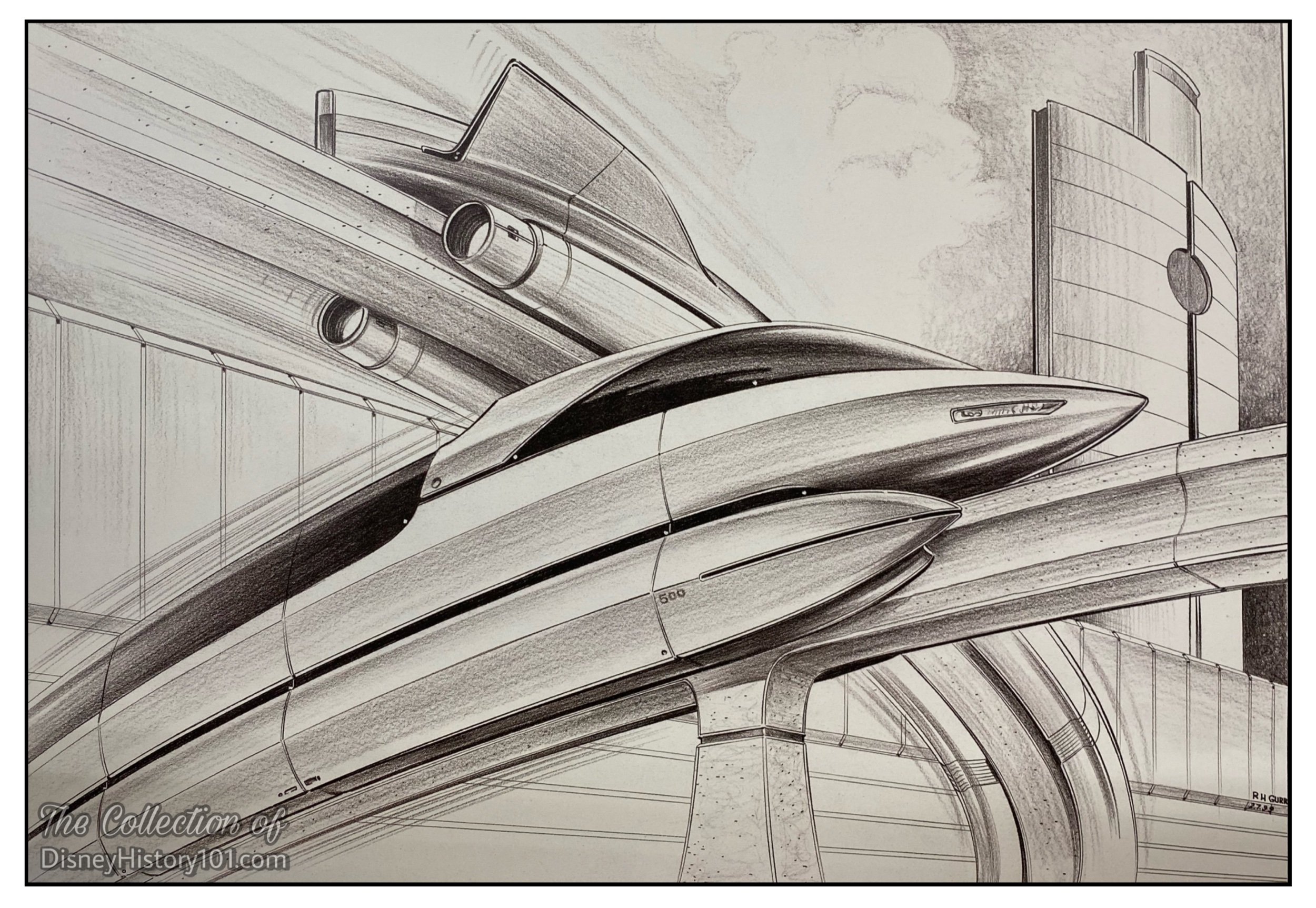
“Monorail of the Future” by Bob Gurr, pencil on paper; Produced for The Disney Gallery in 1999.
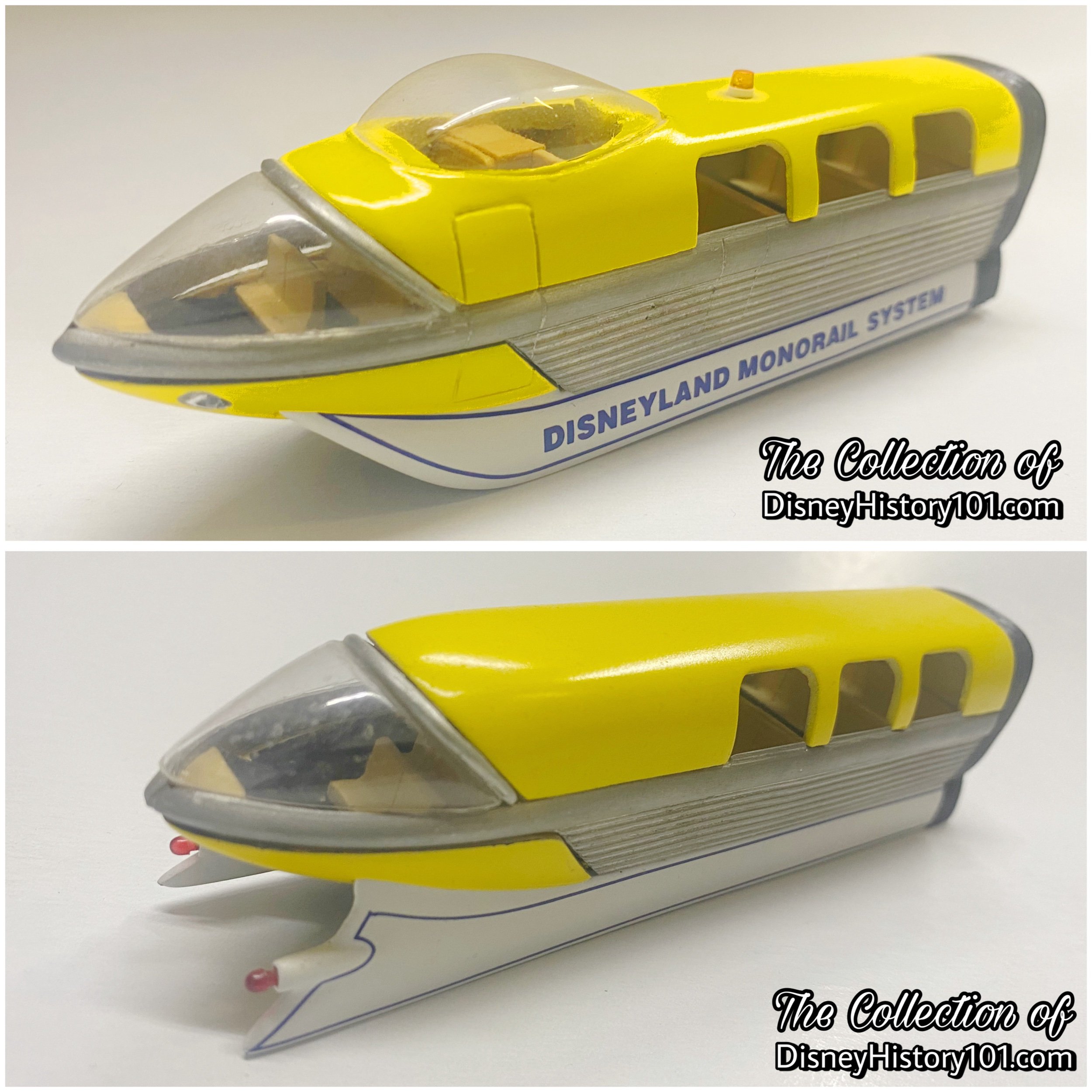
These Monorail Yellow Cabins were part of the Walt Disney Imagineering Series Limited Edition Monorail Replica by Richard A. Coyle; 1998.
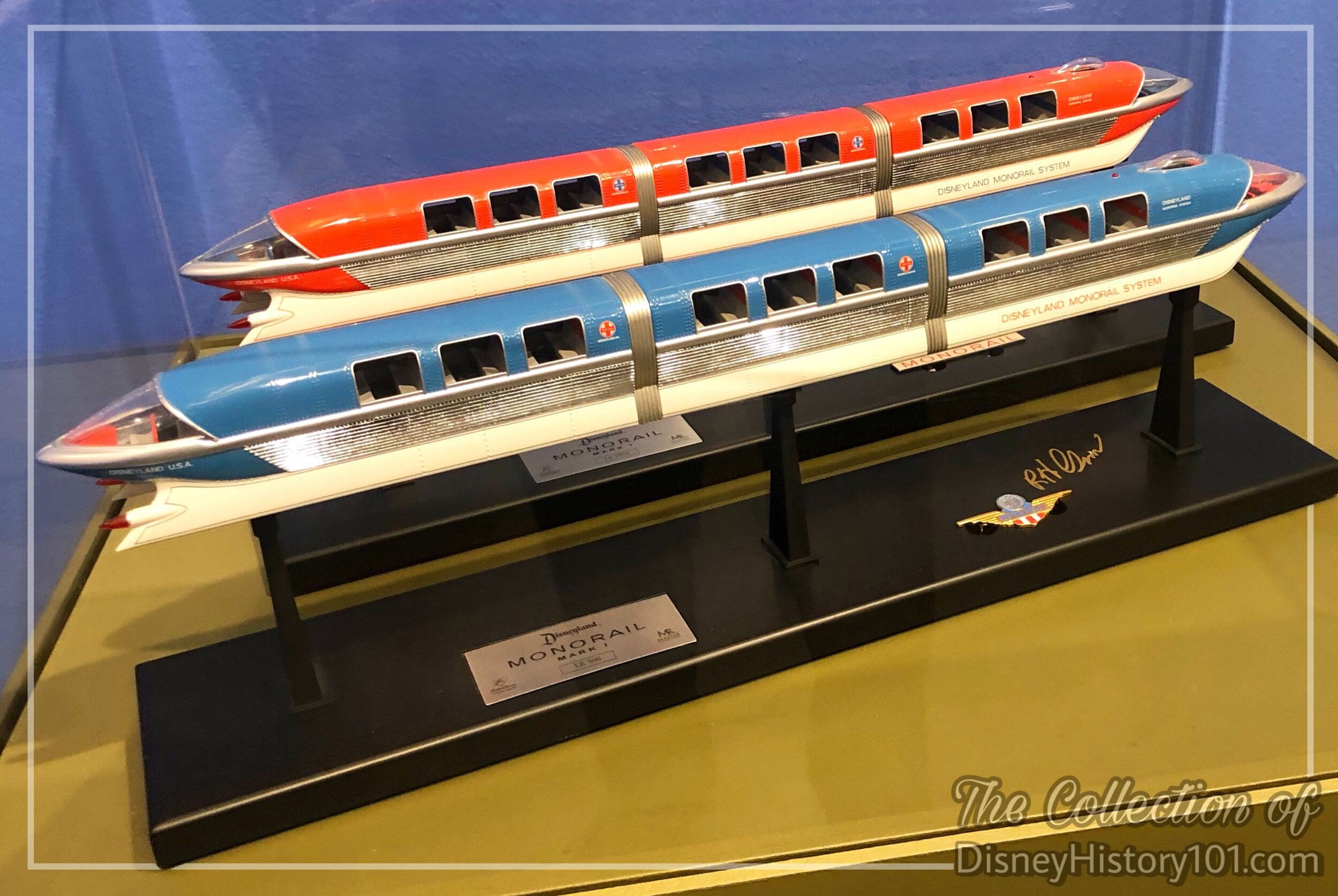
Walt Disney Collectibles Master Replicas Monoral Mark I Red & Monorail Mark I Blue, (2005)
Looking very much like Bob Gurr’s initial designs, are the Walt Disney Collectibles Master Replicas. Above are the Monorail Red and Monorail Blue Mark I Models produced by Master Replicas in 2005, to coincide with the 50th Anniversary of Disneyland!
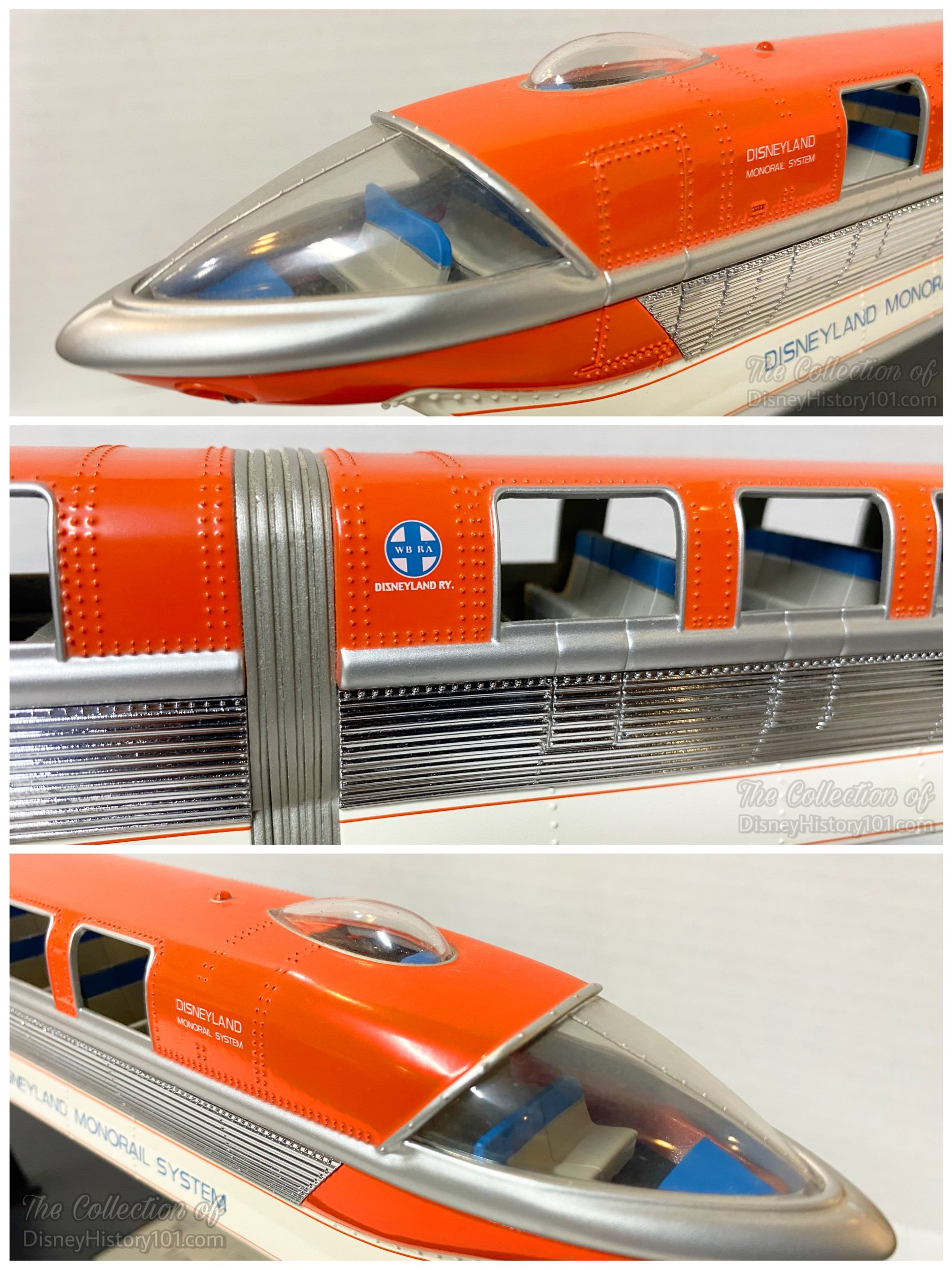
Walt Disney Collectibles Master Replicas Monoral Mark I Red, (2005)
This is one of the most amazing Monorail miniatures I have ever seen, right down to the bellows (those accordian-like coverings between the cars used to cover the bogie units), and tires in the undercarriage.
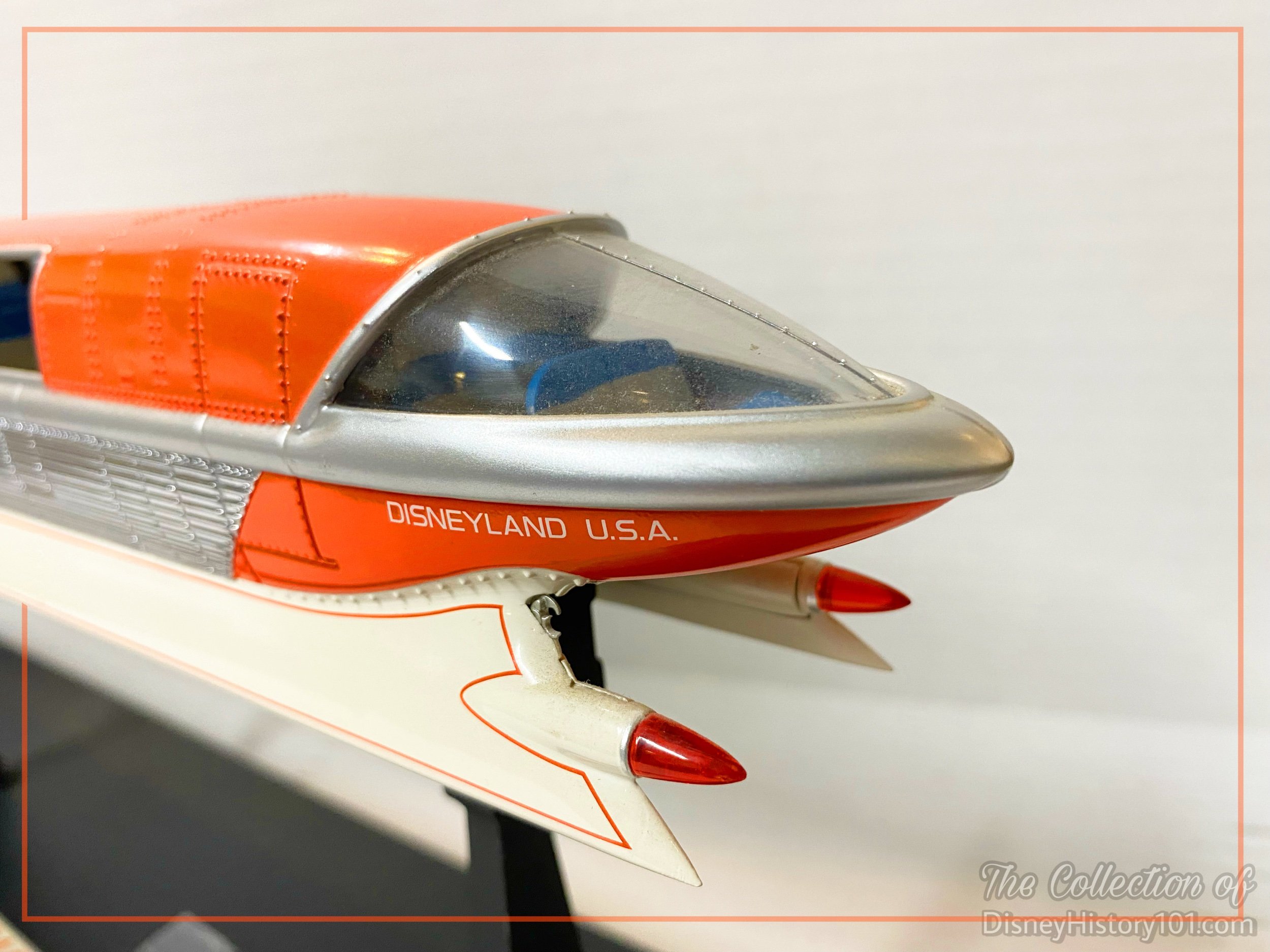
Walt Disney Collectibles Master Replicas Monoral Mark I Red Cabin, (2005)
I love those vintage 1960s tail cones and fins typical of Monorail Mark Is and Monorail Mark IIs.

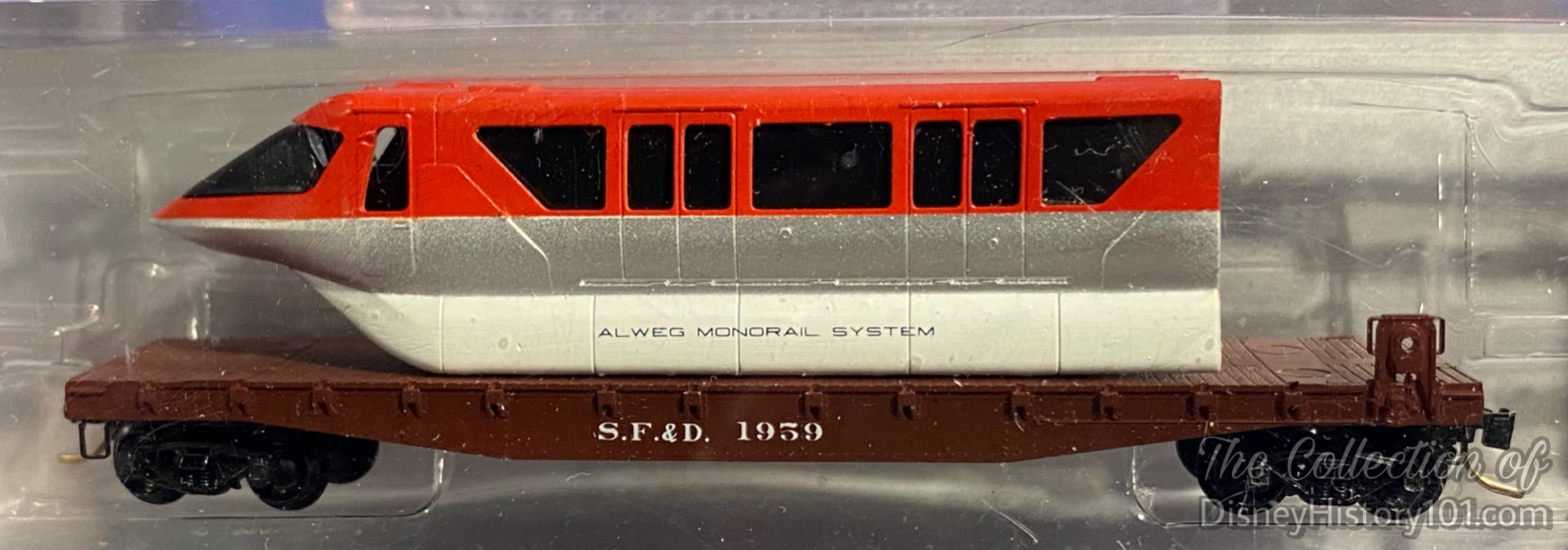
An Olszewski miniature E Ticket N-scale car released at Disney D23 Expo in 2022.
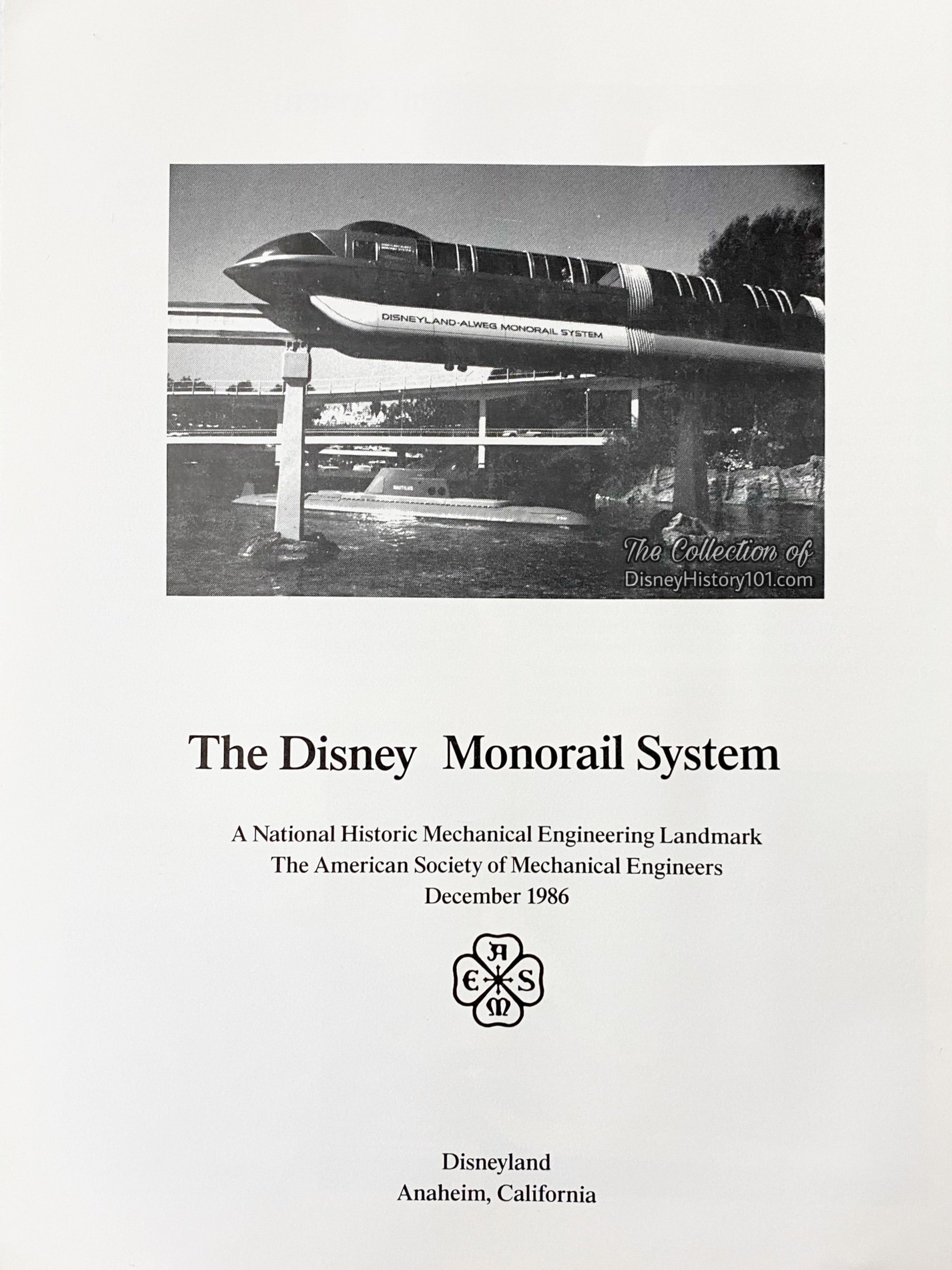
"A HISTORIC MECHANICAL ENGINEERING LANDMARK"
The ALWEG-Disneyland Monorail sparked a legacy of Resort Monorails in Florida, and even triggered a proposal for a Monorail between Disneyland and Anaheim Stadium (around 1983). Three years later (and by the far-off future year of 1986), The American Society of Mechanical Engineers present Disneyland with an award constituting the Monorail a Historic Mechanical Engineering Landmark. Now, the ALWEG-Disneyland monorail was not the first monorail ever created, nor was it the first monorail system in the United States (as other kinds had already been built for both industrial and entertainment purposes). While many of those had come and gone, in major cities and amusement parks across the United States of America, by 1986, the ALWEG-Disneyland Monorail was the longest running (and daily-operational) monorail systems in the entire Western Hemisphere! The Disneyland ALWEG-Disneyland Monorail system would soon inspire a direct legacy - when a network of monorails were built in Walt Disney World, Florida. Even more, the Disneyland Monorail System would deeply impact the field of mechanical engineering.
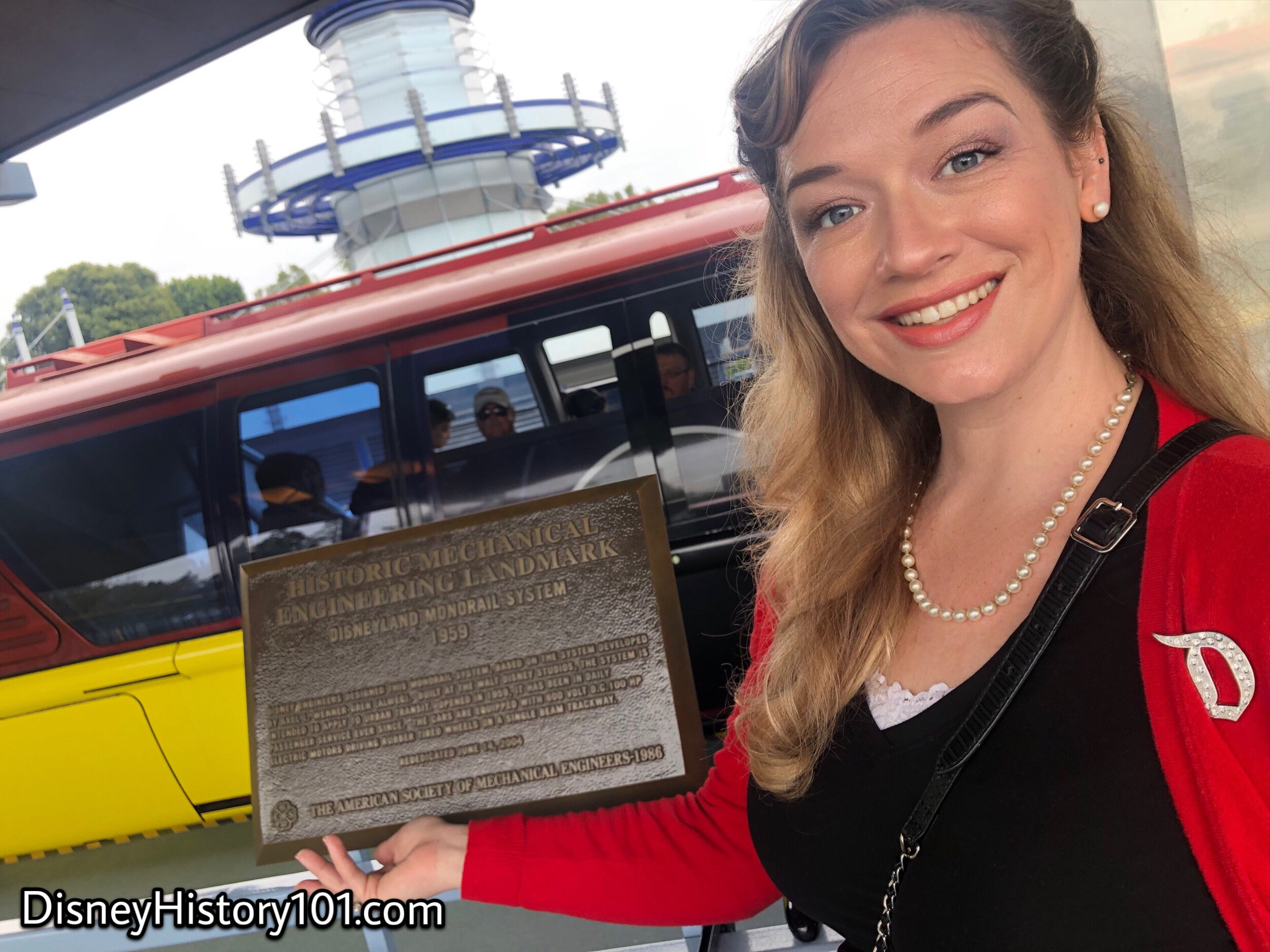
The American Society of Mechanical Engineers' 84th National Historic Mechanical Engineering Landmark posted in the Guest Control queue area.
So, it was decided by the American Society of Mechanical Engineers, the ASME National History & Heritage Committee and the ASME Orange County Section, to recognize the Disneyland Monorail System with a historic plaque.
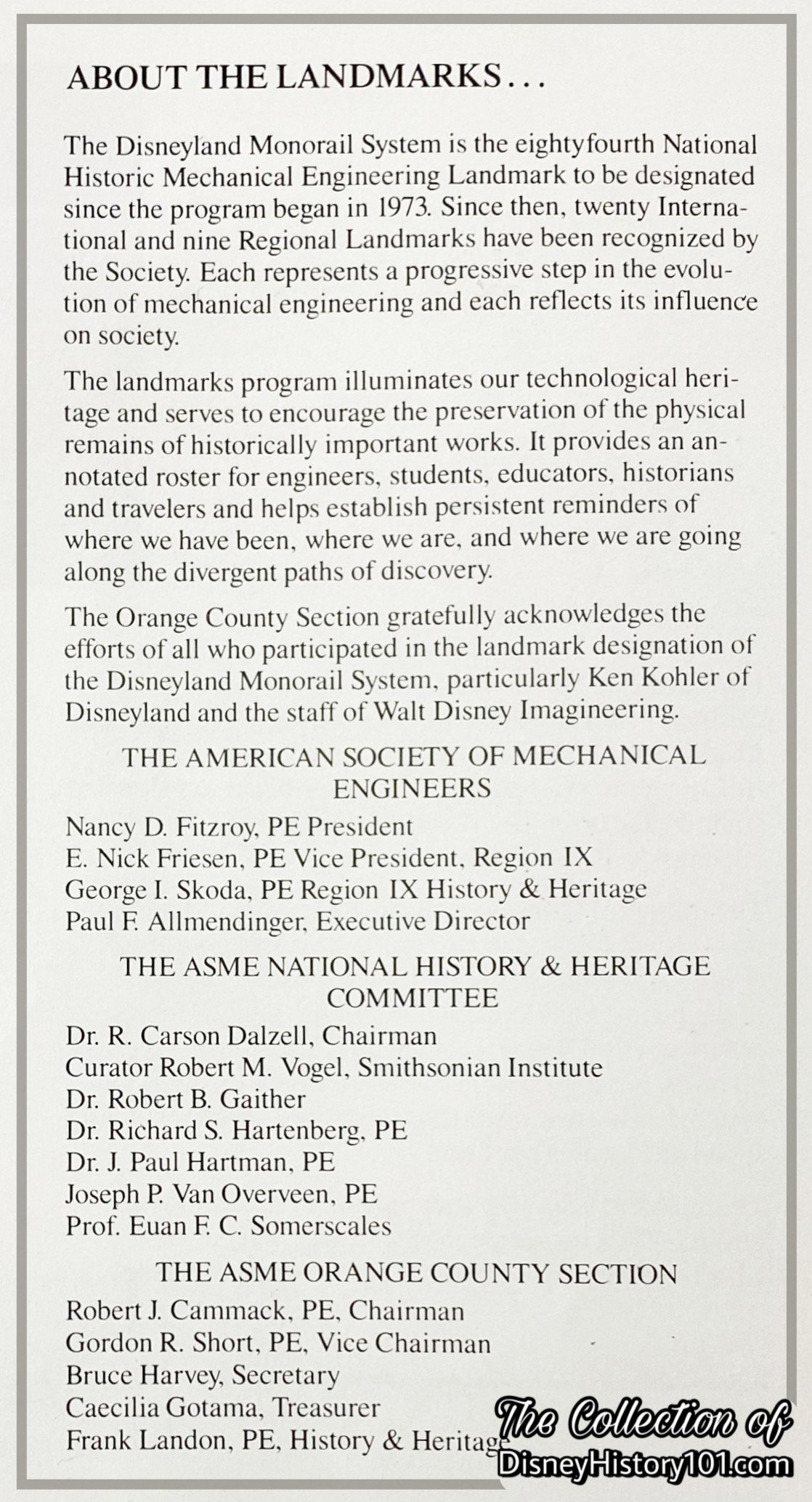
The Disney Monorail System National Historic Mechanical Engineering Landmark Souvenir excerpt, December of 1986.
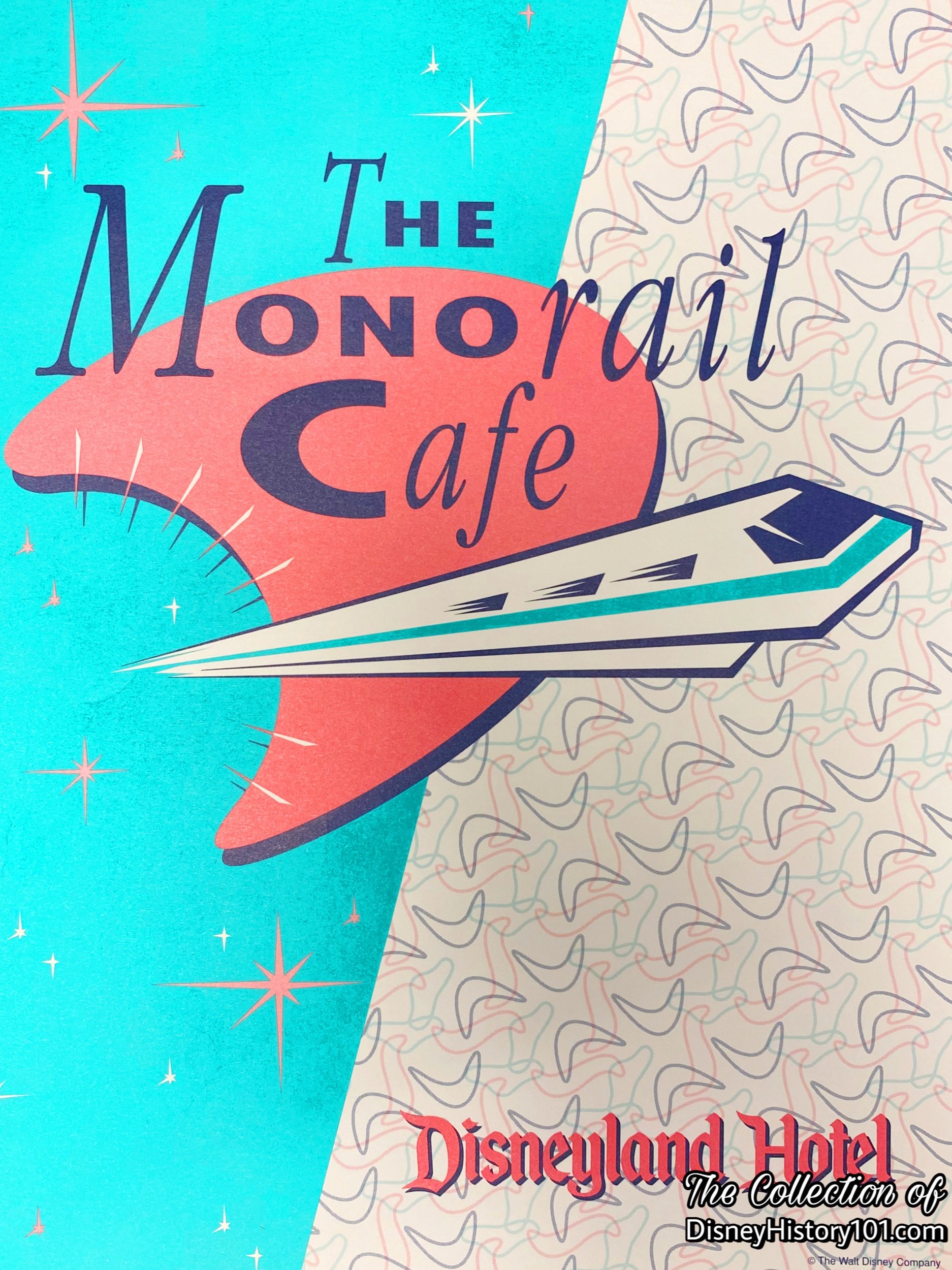
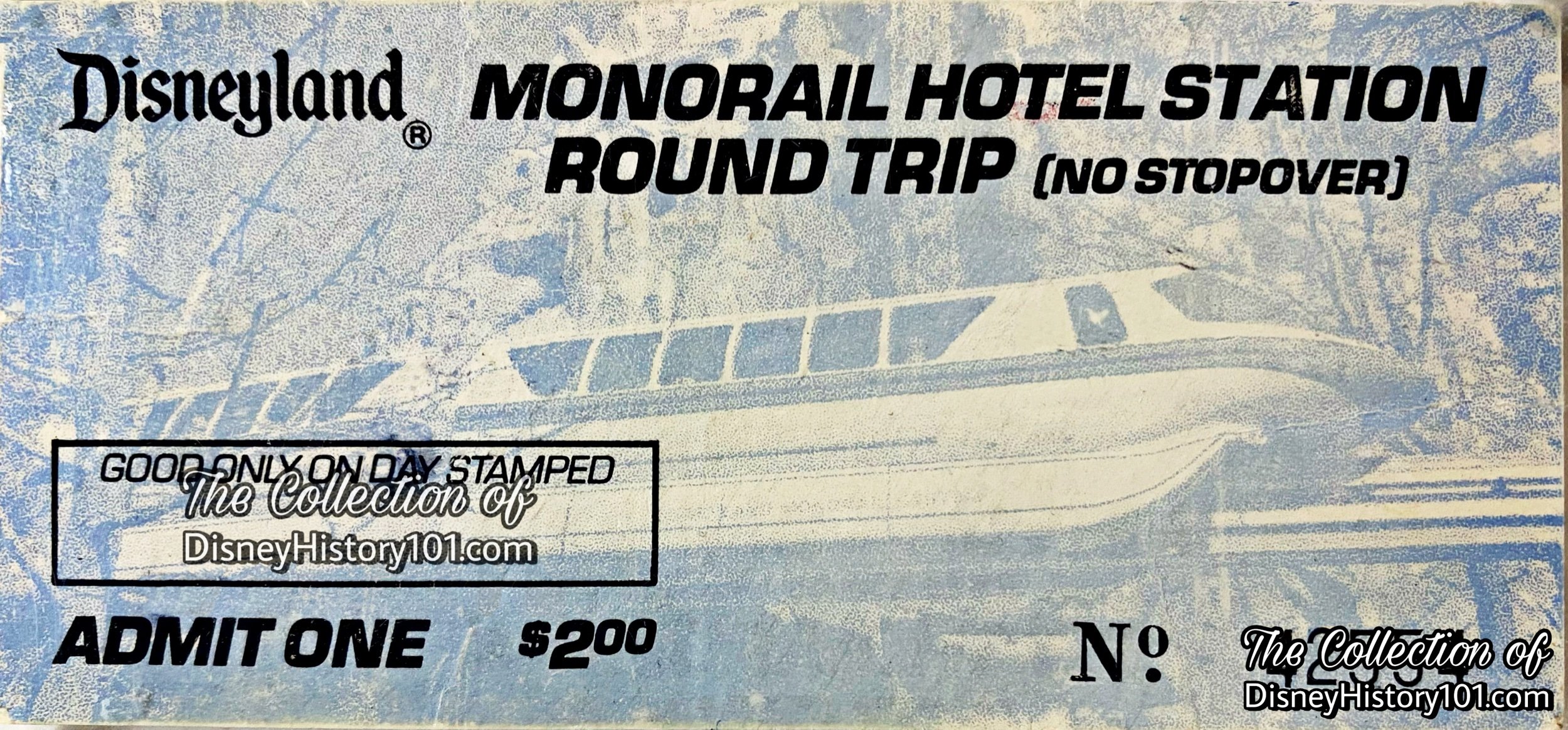
Disneyland Monorail Round Trip Admission Media, c.1987.
The following year (April of 1987), the ALWEG-Disneyland Monorail’s name was changed to Disneyland Monorail. The Disneyland Hotel was still linked to the Magic Kingdom via the “Disneyland Monorail System” which looped the Park and the Hotel. However, new Mark V Monorail models began to replace the Mark IIIs (Monorail Mark III Red, the last to be removed, during the Spring of 1988). During this time the price of monorail admission was approximately $2.00.
On May 22, 1998, the newly renovated Tomorrowland showcased the theme of “Imagination and Beyond.” According to the Disneyland® Press and Publicity document “DISNEYLAND'S UPDATED TOMORROWLAND TAKES GUESTS ON A JOURNEY TO ‘IMAGINATION AND BEYOND’”:
“The Tomorrowland Monorail Station is also receiving a look in keeping with the look of the redesigned land. By converting the metal canopy into colorful bronzes, blues, and teals, the renovated area will take on an abstract, outer-space feel. The main marquee has been designed in such a way that it will represent the sun during the day and the moon at night, depending on the way it is lit. Around the top of the station, ‘flow neon,’ a new technology that makes the light look as if it is chasing itself, will travel through a tube in 16-foot segments. This neon red-and-blue moving light represents the monorail vapor trail on its journey and is the first large-scale application of flow neon in any facility to date. An etched glass panel, edge-lit in neon entitled ‘The Passing Monorails,’ has been designed by renowned Disney artist John Hench to be displayed in the station.”
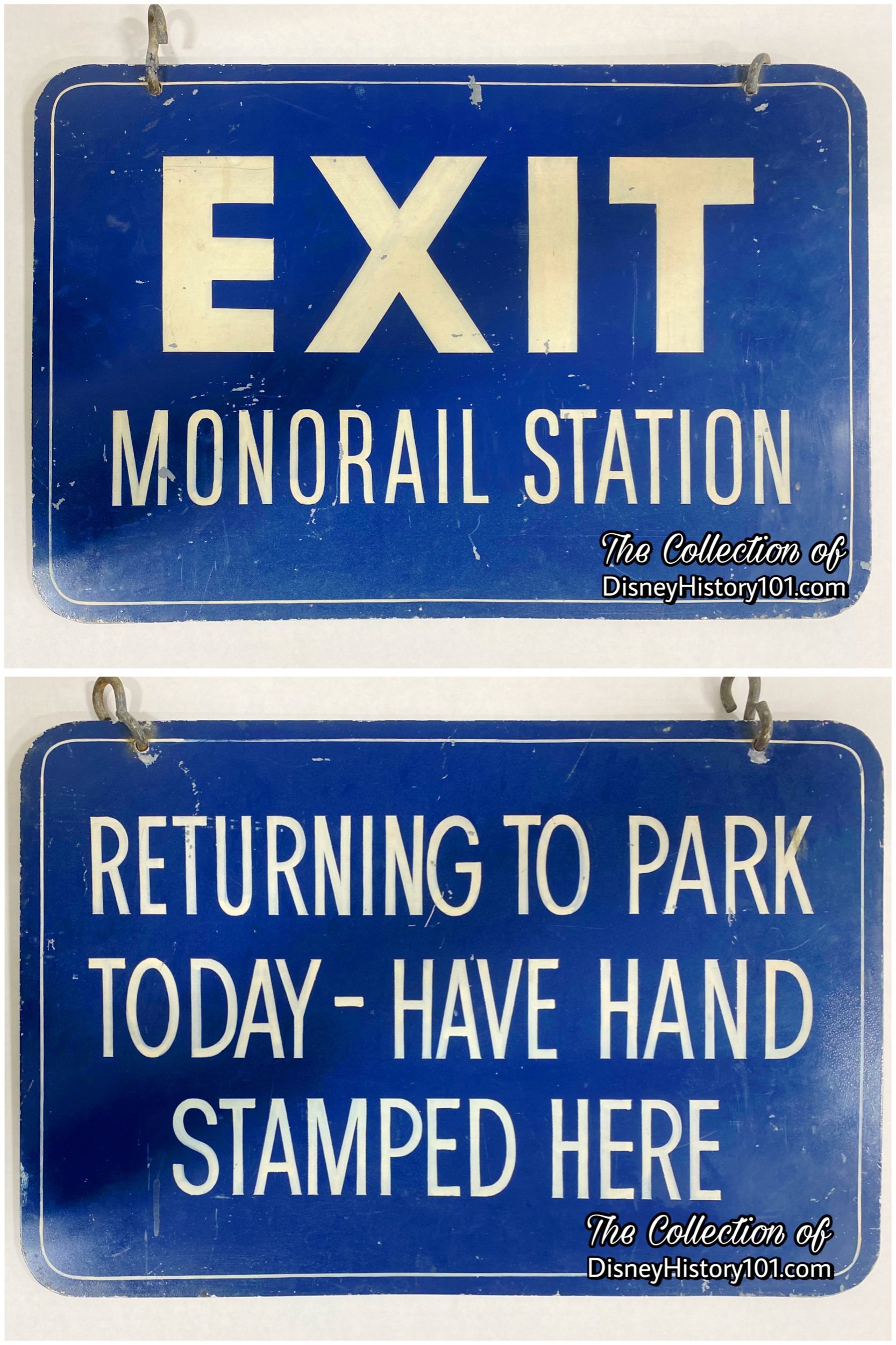
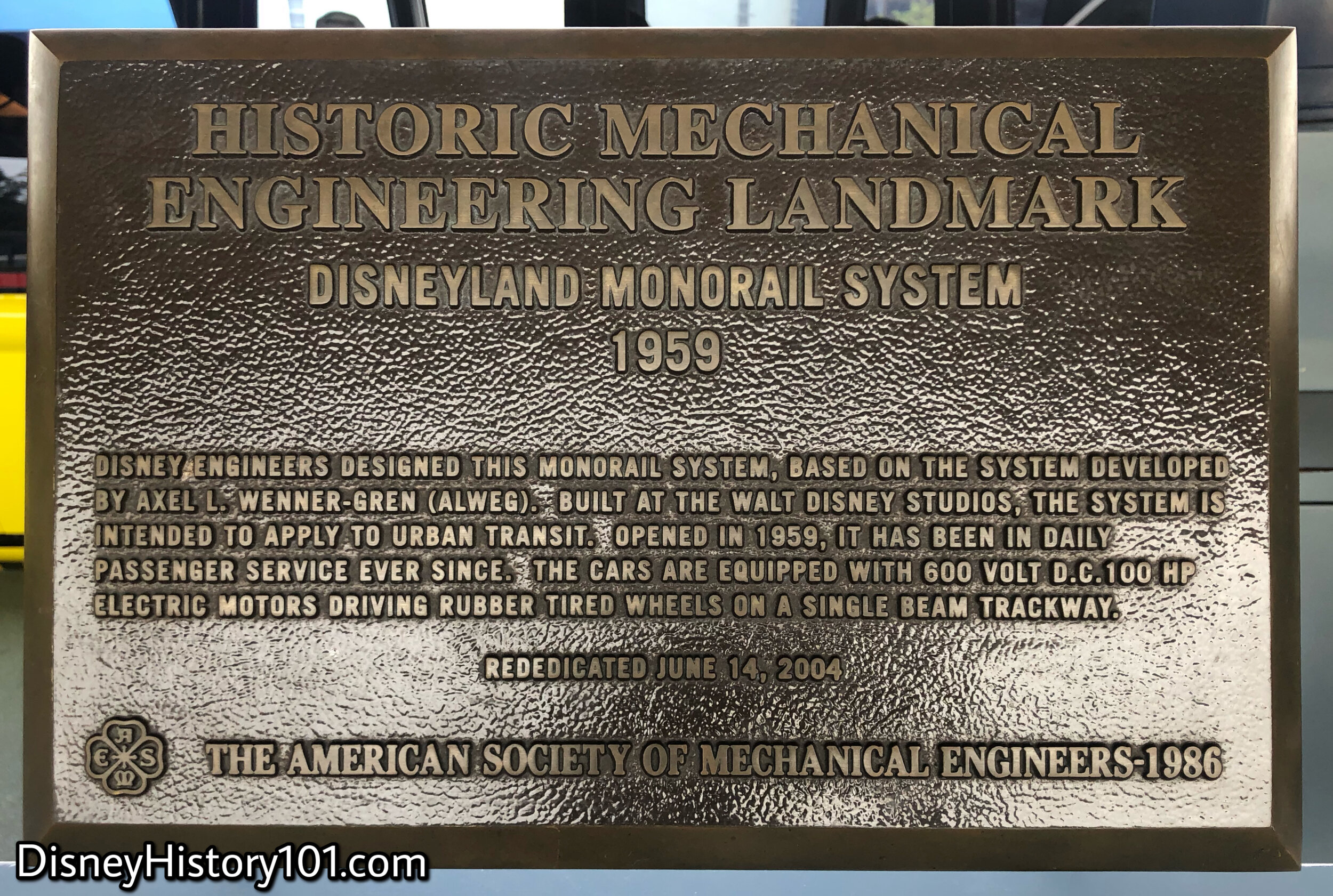
The American Society of Mechanical Engineers' 84th National Historic Mechanical Engineering Landmark.
By the early 2000s, Guests could board the Monorail at the Monorail Station Building located east of the Rainforest Cafe Building at Down Town Disney.
During a 2004 “refurbishment,” the Monorail Mark III “Orange” (previously constructed by Ride & Show Engineering, Inc., with some parts manufactured by Messerschmitt-Bolkow-Blohm) was removed from the Disneyland Monorail system, and taken to Walt Disney Imagineering, where it would be reverse engineered. Despite the removal of a train, something new was added. During 2004, this facsimile (of the 1986 plaque) was unveiled during a small ceremony that predated the Mark VIIs!
The last Monorail Mark V (Blue) was still in service at Disneyland. It would be removed from the Park two years later (in 2006). In 2008 (during the “Disney Princesses” theme and experience initiative), WDI master plans involved the production of a monorail vehicle replacement and a Show update.
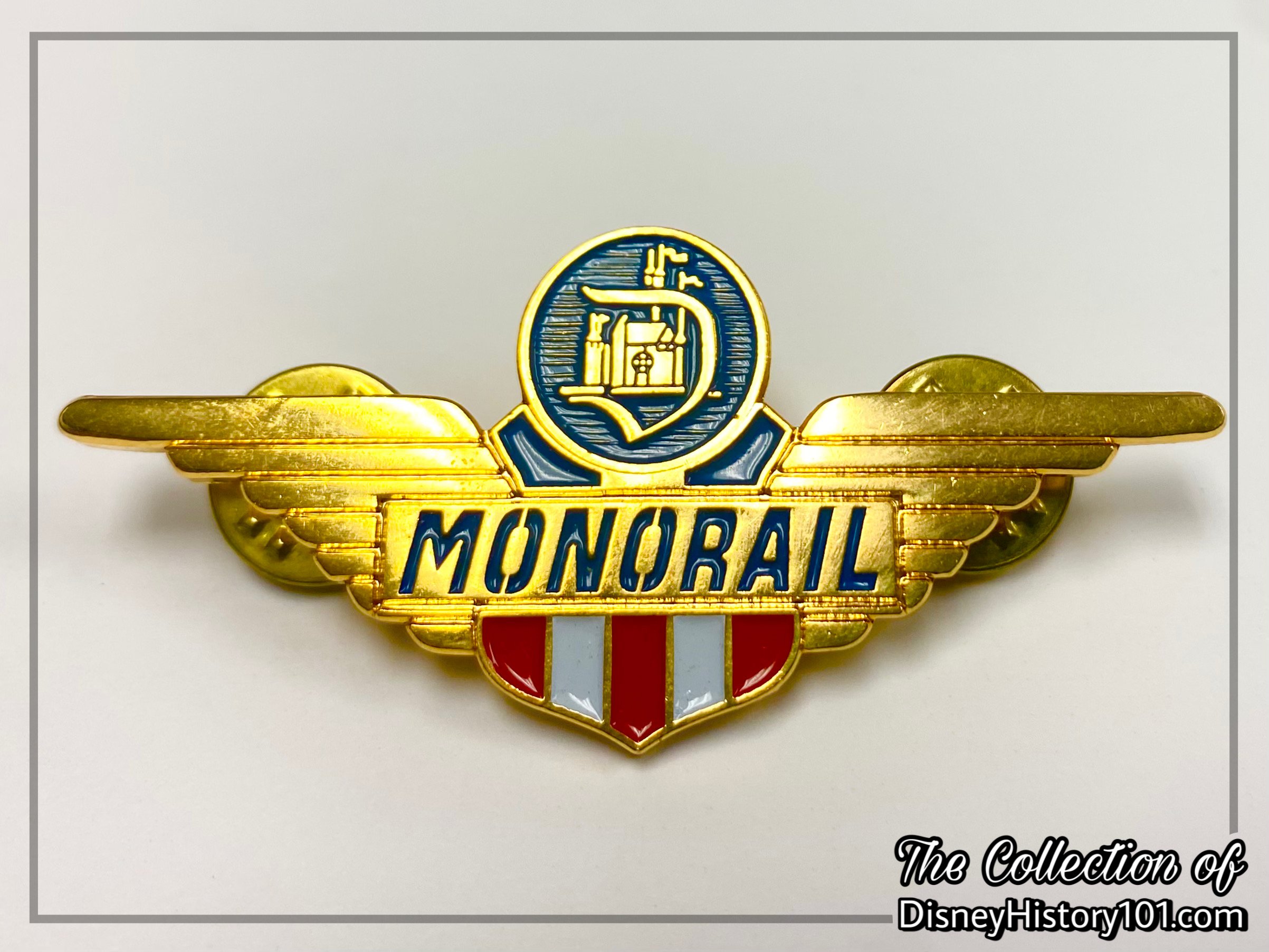
Monorail Pilot Badge Pin Replica.
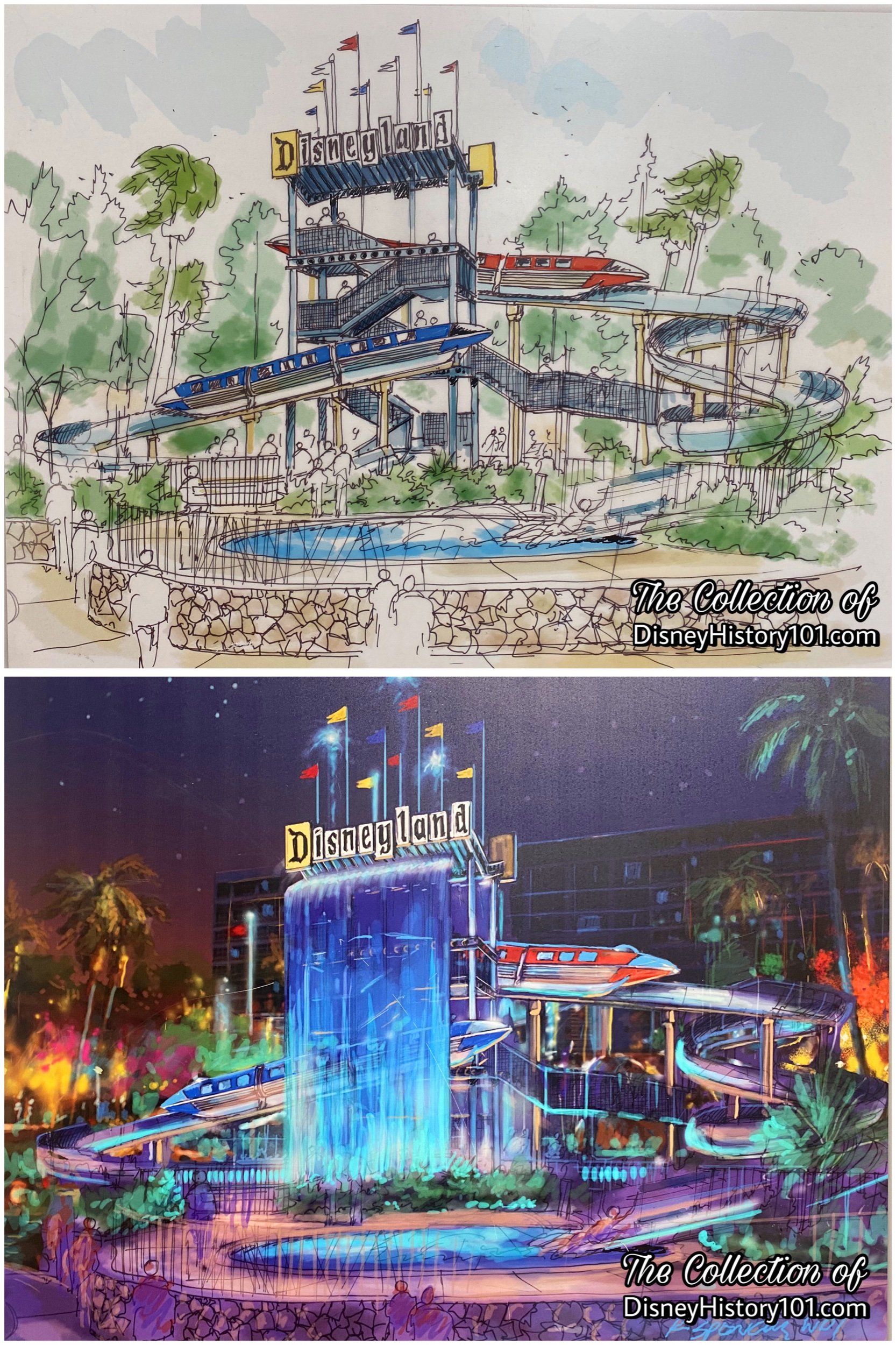
Crossing Monorails arrived at the Disneyland Hotel when two monorail-themed waterslides (designed by Walt Disney Imagineer John Stone) debuted over the Neverland Pool in 2011.
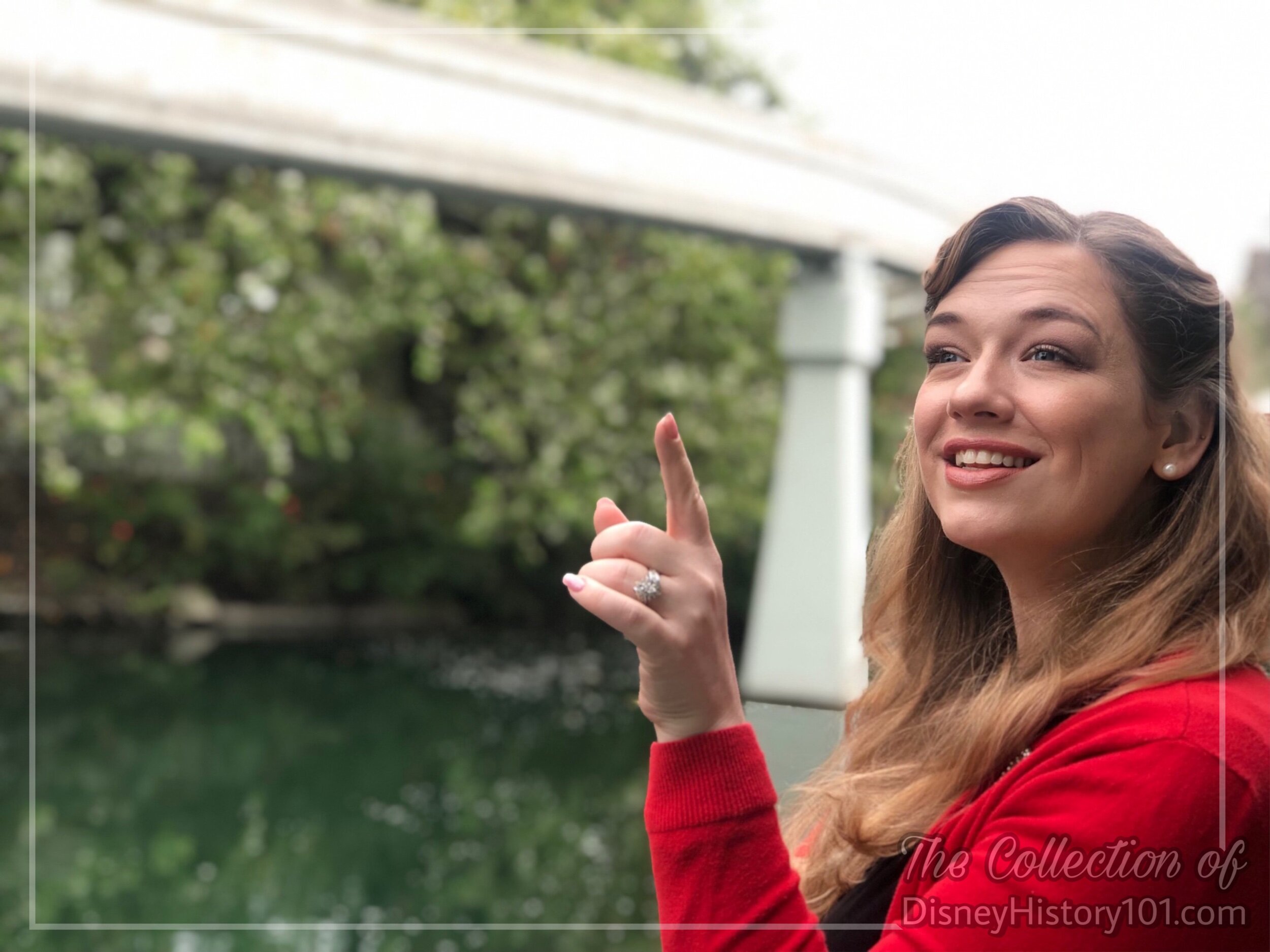
Though Participant Santa Fe has come and gone (and the Park was introduced to the Disneyland Monorail Mark VII), Disneyland Park is still a place to “monorail gaze,” in the present! Today, Guests continue to board the Disneyland Monorail System and travel high above Disneyland to The Disneyland Hotel and back on this efficient transportation system of the future.


